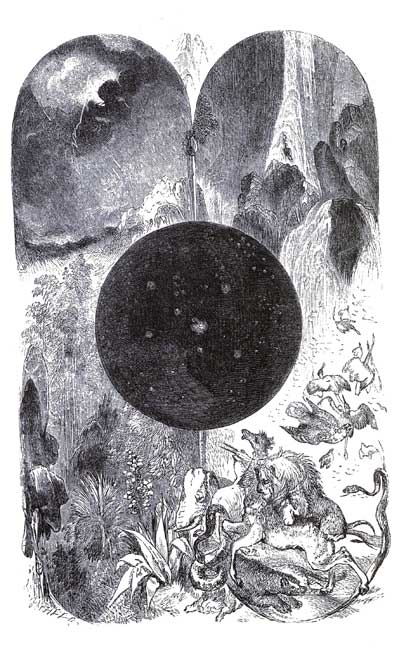


BY
ELISHA NOYCE.
AUTHOR OF
"THE BOY'S BOOK OF INDUSTRIAL INFORMATION."
ILLUSTRATED WITH
FOUR HUNDRED ENGRAVINGS,
BY
THE BROTHERS DALZIEL.
LONDON:
WARD & LOCK, 158, FLEET STREET.
1858.
(The right of Translation is reserved.)
Dalziel, Brothers, Camden Press, London.
THE SKY.
THE AIR.
THE EARTH.
THE WATERS.
THE VEGETABLE KINGDOM.
THE ANIMAL KINGDOM.
The object of this work is to bring before the reader a simple and intelligible description of the whole Creation, without attempting to enter into minute particulars on any of the subjects more than is sufficient to present them in a form clear enough to be both comprehended, and recollected; thus aiming at the production of a taste for such knowledge, and a desire to enter more minutely into any or all of the subjects this work embraces, which desire can easily be gratified by a study of some of the many excellent works devoted exclusively to the individual parts, which in this work are treated of collectively. The want of a general knowledge of those works of the Great Creator which are constantly spread out before us, in these days of easy acquirement, amounts almost to a sin, for it is by the study of Nature in all her varied forms and associations, that we learn to "look from Nature up to Nature's God;" for who can look upon the works of God without a feeling of awe and admiration? who can look upwards at "the spacious firmament on high," without a sense of his own insignificance? who can gaze around upon the beauty and variety the earth displays, without a strong desire to know more of such a Great Creator's works?—and he who knows the most, be sure it is he who will worship Him with the truest and most heartfelt gratitude and admiration. The works of God (next to the Divine revelation of His will) are the highest studies to which Man can apply his intellect; it has required the greatest study of the greatest minds to find out and record but a few facts to add to the general store, and surely no one should consider his time misspent who can read over such records, and trace their truth by comparison with Nature, the more especially as it is by these means a love of inquiry is engendered, and that[Pg xii] ultimately he may be enabled by diligent perusal of the great Book of Nature, to add his quota to the store of knowledge already formed and recorded.
It is true that infidels have often brought forward some branch of Science in confutation of Scripture, but it is also a fact that in nearly every such case, the very arguments that have been used by these men, have at last become the strongest arguments on the other side. Geology was at first adduced as a proof that the world had existed from all eternity, instead of having been created by an Omnipotent God, and the question had often been asked, "Can you produce one proof of the creation of anything?" Now this was a difficult question to answer, until Geology made manifest the fact that Man was created, by producing a clear and unimpeachable proof that up to a certain time, he did not exist on the earth, and that at a period of time, a little later, he did exist; the space between these epochs is not known, but it has nothing to do with the argument, for within that period (whatever it may have been) Man was created, and created as perfect in his physical organisation as he is at present—no long series of developments from the higher animals by fortuitous circumstances, as some pretend—no gradual addition of parts to suit the physical changes of the earth's surface. There is undoubted proof from the oldest records, in the form of Sculptures, that Man's appearance has always been the same, and the records of the Bible (the antiquity of which, at all events, cannot be disputed) show that the constitution of his mind was at that time just as it is now—every passion, every desire the same—the only advance he has made, is in the knowledge of God's works; the application of that knowledge to his own benefit, and the glorification of his Maker.
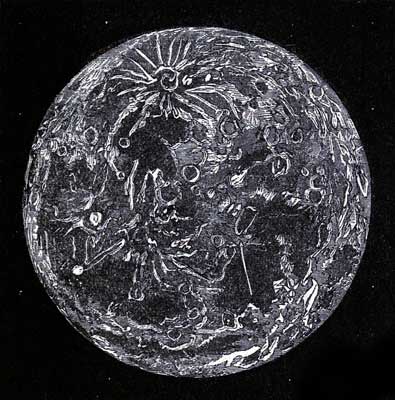
The Sky is the familiar name used to express that wonderful and vast expanse of space which extends on all sides far beyond our knowledge or conception, and in which the earth and millions of other orbs move round suns as their centres. Countless millions of these suns exist at immense distances apart and of the most prodigious magnitudes (many thousand times larger than this earth), these are the stars which on clear nights we see twinkling so brightly in the sky; our sun is one of them, but being very much nearer to us than the others it appears proportionately larger and [Pg 2] brighter, and is our centre of attraction and circulation. There is but little doubt that every star has its circulating worlds or "planets," but these are too small to be seen even with the best telescopes; this may be understood when it is considered that the stars themselves, by the most powerful aids, appear but as bright points or specks, and they are thousands of times larger than the worlds which would circulate round them. But though their planets cannot be perceived by the naked eye, yet analogy teaches us that they in all probability exist, for very many of the heavenly bodies have satellites revolving round them, of such are our moon and the moons of Jupiter, and in this sense the planets themselves may be considered as the satellites of the sun, and as the sun has its satellites revolving round it, it is fair to conclude that it is not the only one of all the stars which has. All these thousands of suns and planets, millions of miles apart, and occupying space, the extent of which we have no terms to express, form but one system of stars out of many, for by comparison with infinite space they occupy but a point, telescopes of the greatest power having revealed that beyond all these stars, there is an immense space in which are seen other systems of stars, as great and numerous as our own, to which the name "Nebulæ" has been given. The mind fails to reach to such magnitude, and it is certain that the study of these great things, brings us to regard size and space (like time) as nothing; for it appears that God has expanded or contracted His works at will to suit His plan of creation without regard to limit; whether we look at the most minute shell or the greatest orb, still His marks of design are equally evident. If we consider it wonderful that God should take up hundreds of millions of miles for one system, and that He should scatter through space millions of such systems, then let us lay aside the telescope and, after an exclamation of adoration, take up the microscope, by which we shall learn that God has also placed millions of systems equally wonderful within the compass of an inch! We shall at once acknowledge that he is "Lord of all," and that size, space, quantity, and time, are mere fictions of our own imperfect minds, [Pg 3] and that to an Infinite God there is no difficulty from such sources.
This is the name given to that collection of worlds which, with the sun as a centre, circulate at different distances from and around it. There have at present been discovered eight large planets and thirty-four smaller ones called "asteroids" or "planetoids," the larger planets revolving in the following order from the sun or centre:—
| 1. | Mercury. | 5. | Jupiter. | |
| 2. | Venus. | 6. | Saturn. | |
| 3. | The Earth. | 7. | Uranus. | |
| 4. | Mars. | 8. | Neptune. |
The Sun, the centre of the solar system, is the great source of light and heat to our planet and all others which revolve around it, as well as of another agent not so well understood, namely "actinism," or that power which produces the chemical changes in many substances exposed to the sun's rays, and which has been of late turned to such useful and wonderful account in the art of photography.
The sun is an immense sphere, many thousand times larger than our earth, or indeed all the planets put together. It turns upon its axis in twenty-five days, and, like all spheres which rotate, has a slightly flattened form; it is supposed that the sun itself, carrying its planets with it, performs a journey round some other centre very far away, but for all the purposes of explaining the solar system it may be supposed to be stationary. The diameter of the sun is about 890,000 miles, or nearly 112 times the diameter of our earth, and as the bulk of spheres is as the cubes of their diameters, it follows that the sun is about 1,400,000 times the bulk of the earth. Fig. 1 shows the relative size of the sun and the planets which rotate round it; the specific gravity of the sun is about a quarter that of our earth or one-and-a-half times that of water. On its surface irregularities are seen (by the aid of the telescope) which give it a wavy appearance, and beside these, black spots or tracts (maculæ) [Pg 4] which appear to traverse from west to east, across its face; these however do not travel on, but are carried round by the sun in its rotation, for by observing any one of them, it is seen to go across and make its appearance again at the other side, and the time it takes to arrive at the place where it was first seen, determines the time of the sun's rotation, which (as before stated) is twenty-five days or nearly; these spots alter in size, form, and number from time to time, some of them remaining permanent for months, others closing in and disappearing in a few hours.
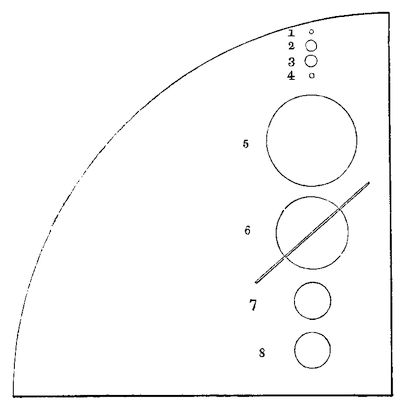
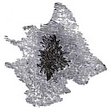

These black spots have a sort of shadowy fringe (penumbra) which gives them the appearance of being openings through a luminous surface, discovering a surface less luminous, with openings in it through which some still darker surface is seen; that this really is the case, and that these are not [Pg 5] merely dark spots or surfaces, is shown by the fore-shortening of the nearest edge as they arrive at the verge of the sun's disc, and are consequently presented edgewise to the eye, so that a spot may have the appearance of fig. 2 when seen in front-view near the centre, and of fig. 3 when seen fore-shortened near the edge of the sun's disc. These spots (although but specks in comparison with the vast surface of the sun) are yet of prodigious magnitude, some having been calculated to measure 18,000 miles across—large enough for two such worlds as ours to pass through side by side! From the rapid motion of the "penumbra" or edges of these spots, which alter, open, and close up very rapidly, and from some of them being semi-dark, others quite dark, &c., it has been concluded that the sun has at least two surrounding atmospheres, that the body of the sun is not luminous, nor the first atmosphere or that nearest to it, but that the outer one is, and that the dusky appearance of the inner, as seen through openings of the luminous outer atmosphere, results from its being very strongly illuminated by the outer one; this luminosity may be (and probably is) only comparative, for the spots which appear black may be yet very bright, appearing black only in comparison with the extreme brilliancy of the outer atmosphere, just as a bar of red-hot iron appears black when held up to the sun. The course which the planets take round the sun is not exactly circular, but deviating from it more or less, never being quite a circle. The orbit of each planet, if accurately computed and laid down on paper, proves to be that form of curved line called an "ellipse," or that form which instead of having one centre, as in the circle, from which all lines radiating to the circumference are equal in length, has a longer and [Pg 6] shorter diameter, two centres called "foci," and the circumference or boundary so placed that the sum of any two lines, drawn one from each centre, and meeting at any part of the circumference, shall be equal to any two other lines so drawn and meeting at any other point of the circumference, and to the major axis or long diameter of the ellipse. In fig. 4, each pair of lines drawn from A A and meeting repectively at B are each equal. An ellipse may be very much elongated, or almost circular, but still have these properties which are essential to it, and in the case of the orbits of the planets, they are so nearly circular, that if drawn a few inches wide, would hardly be detected to differ from the circle. The orbit of the earth is about one thirtieth part longer than broad.
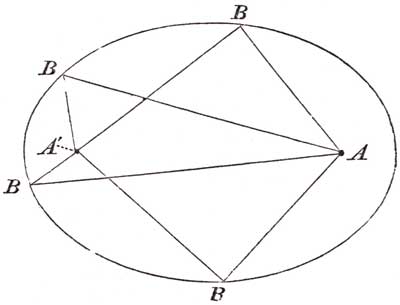
The rate at which the planets revolve round the sun is not equable, that is, their progress is not through equal distances at equal times, but a line drawn from the planet to the sun would always pass over equal spaces or "areas" in equal times, for example, in fig. 5, if the area of the angle included in A B C be equal to that included in A D E, then a planet would pass from B to C and from D to E in equal times.
Mercury is the smallest of the greater planets, and the nearest to the sun. Its diameter is about 3000 miles, and it is about one-fifteenth part the volume of the earth; its [Pg 7] distance from the sun is 36,770,000 miles, and it performs its revolution in eighty-eight days.
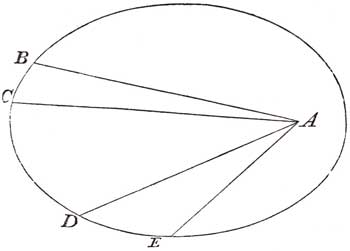
This planet is but seldom seen with the naked eye; for, being so (comparatively) near to the sun, it sets before dark, and does not rise till the grey of morning makes it scarcely visible. Nothing notable has been discovered on its surface.
Venus is the second in rotation from the sun, and revolves round it, at a distance of 68,750,000 miles, in 224½ days. The diameter of Venus is about 7760 miles, it is therefore nearly the volume of the earth. This is the brightest planet seen in the heavens, for although much smaller than many others, its comparative nearness to the sun and earth causes it to appear larger and brighter to the eye. Venus is the evening and morning star; for when to the west of the sun, it rises before it, and is then called "the morning star" (or, formerly, "Lucifer"), but when it is to the east of the sun, it sets after twilight is gone, and is called "the evening star," or "Hesperus."
These two planets, Mercury and Venus, have "phases" (like the moon), or certain positions in which the whole of the side illuminated by the sun is seen from the earth, and other positions in which it is seen sideways; the planet is then said to be in "quadrature," as may be seen at Q Q, fig. 6. Mercury and Venus, being between the sun and the earth, are called "inferior" planets, while those whose [Pg 8] orbits are outside that of the earth are called "superior" planets. When either of the inferior planets are between the earth and the sun, they are said to be in "inferior conjunction" (I C, fig. 6), and when on the opposite side, or behind the sun, so that a straight line from it to the earth would have to pass through the sun, then it is called being in "superior conjunction" (S C); at mid-distance, either east or west, it is said to be in "eastern" or "western quadrature."
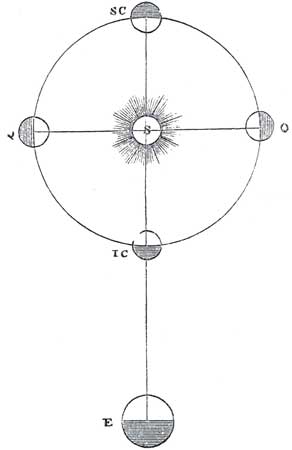
The third planet from the sun is the Earth, distant about 95,000,000 miles, with a diameter of 7925 miles, so that the most lofty mountains (five miles high) bear about the same proportion to it as would an elevation one-fourteenth of an [Pg 9] inch in height to a ball of ten feet in diameter; therefore, with all its valleys and high hills, the surface of the earth is smoother in proportion to its bulk than the rind of an orange. The earth is not a perfect sphere, but has a slightly flattened form, as though it had been compressed at the poles. The diameter at the poles is the smallest, and is 7899 miles, while that at the equator (its greatest) is 7925 miles, being a difference of twenty-six miles; but this is so small, when compared with the size of the earth, that if an exact model of it were made, four inches in diameter, it would require the most accurate measurement to determine that it was not a perfect sphere.
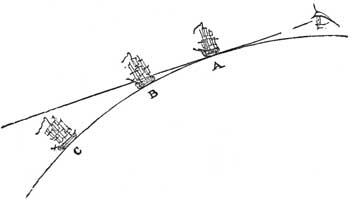
The form of the earth has been demonstrated by accurate experiments and calculations, but there are many things we may observe, convincing us of its rotundity; one of the most evident of these is the fact that as a ship at sea goes from the land, the hull first disappears, then the lower sails, and lastly the tops, while a ship approaching the shore shows first the topsails, and lastly the hull; see fig. 7, where A shows a ship on the horizon, B hull-down, C out of sight. In the same way, the tops of distant mountains are seen at sea long before the lower lands. Another proof is drawn from the fact, that ships have been sailed quite round the earth; by steering as nearly as possible in one direction, they have arrived at the place from which they [Pg 10] started. A third proof of the earth's rotundity is found in the form of its shadow, when the moon is eclipsed by it; this shadow, as thrown by the earth upon the moon, is circular, in whatever position the earth may be, and a sphere is the only solid form which can in all positions cast a circular shadow.
The earth turns upon its axis every 23 hours, 56 minutes, and 4 seconds, which constitutes a day, and makes one revolution round the sun in every 365¼ days, which make up a year; but the earth's axis is not at a right angle to an imaginary line drawn from the earth to the sun, but at an angle of 23 deg. 28 min. to it, as shown at fig. 8, where the line from n to s is the earth's axis of rotation, the dotted line leading to s is the sun's direction, and e q is the equator.

The earth travels through space at a rate of more than a million-and-a-half miles per day, besides the distance which each object upon it is carried in its diurnal rotation (24,000 miles). At first thought it would seem impossible that such a rapid motion should not be felt; but as the air and clouds, and every object belonging to the earth, moves with it, and this motion is perfectly smooth, it can only be perceived by looking at objects independent of the earth. If sailing on the water, when it is quite smooth and the land not very near, the ship seems to be stationary and the objects on [Pg 11] shore appear to pass along in an opposite direction to that in which the ship is going. It is the same with the earth; the sun, which appears to move, is stationary, while the earth is going round it; and the result is, while the earth turns round on its axis the whole firmament appears to move, we lose sight of those stars which are to the westward, which are then said to "set," while those to the eastward, constantly coming into sight, are said to "rise," the whole appearing to pass from east to west, while in reality the earth's surface is passing from west to east. At the equator, or that part of the earth which lies midway between the poles, the sun and stars appear to rise and set perpendicularly to the horizon and at equal times above and below it, it is therefore 12 hours day and 12 hours night; in places not situated on the equator, they do not rise and set perpendicularly to the horizon, but form portions of circles at greater or less altitudes in the heavens, and the nearer the observer is to either of the poles, the smaller the circle, and the more of it is seen; so that, at the poles, any star situated exactly overhead does not appear to move at all. This place is called the north pole of the heavens, and the nearest star to it is called the "polestar," which neither rises nor sets, and, as it always keeps the same position, serves as a guide to mariners. All this is the effect of the diurnal motion of the earth, its annual motion not affecting the position of the stars, they being at such an immense distance that the circle which the earth forms in passing round the sun—although nearly 200,000,000 miles across—is as a mere point in proportion. But not so with the sun: as before stated, at the equator it is twelve hours above the horizon and the same time below it; now, as we approach towards the poles, it forms at each rotation an arc above the horizon, lower and lower, until at the poles its daily rising and setting is lost altogether, and there would never be daylight there, provided that the earth was only subject to the diurnal motion (fig. 9); but as the earth turns upon an oblique axis, the north and south poles share the blessing of daylight between them, so that through one-half of the earth's orbit the north pole is towards the sun, as shown in the figure, and [Pg 12] the south pole during the other half. There is therefore at the poles but one day and one night in the year—the day being summer and the night winter. In less northern climates, as England, this exists to a much smaller extent; for half the year the sun is longer above than below the horizon, constituting our summer, the other half of the year the sun is longer below the horizon than above it, and this is winter. Hence, in each case, midway between, the sun is twelve hours above and twelve below the horizon, which occurs in spring and autumn, being called the "equinoxes" (equal nights); the vernal or spring equinox takes place on the 21st of March, the autumnal on the 21st of September. The times just between these, when the sun is the longest and shortest time below the horizon, are called the summer and winter solstices, and occur on the 21st of December and the 21st of June.

The earth has a smaller sphere or "satellite," circulating round it, this is the Moon; it is placed at a distance of about 238,000 miles from the earth, is about one-fiftieth of its bulk or volume, and revolves round it every 27½ days, keeping always the same side towards it, so that the other side has never been seen. This is effected by rotation on its axis, which takes place once for every circuit round the earth; if it did not rotate, or kept the same side always to the same point of the heavens, then, when it had half-way revolved, the other side would be turned towards the earth. There are good reasons for believing that the moon has no atmosphere or air around it, for the concave edge (when only a small portion of the half illuminated by the sun is [Pg 13] seen) instead of being gradually shaded off into darkness, as would be the case if there were an atmosphere, is well defined and uneven, showing the tops of some of the mountains and their shadows (fig. 10). Nor does there appear to be any clouds, and as a consequence no water; neither has anything been observed by the aid of the best telescopes which could be considered sea, on the contrary, the whole surface seems torn up and rent into chasms and immense jagged mountains, enclosing circular portions like gigantic walls. The darkened parts which are always seen on the surface of the moon were formerly supposed to be seas, but of late, by the use of improved instruments, they have been seen to be rough like the other parts, and cannot therefore be water (fig. 11). As there appears to be no water, it may be confidently inferred that there are no inhabitants.
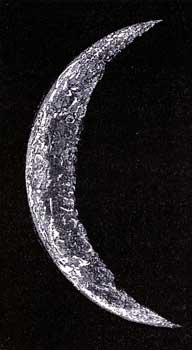
The moon having always one half illuminated by the sun, while the other half is dark, presents different "phases" to [Pg 14] us on the earth, according to the position in which we view it; thus, in fig. 12, e represents the central position of the earth, and S the direction from which the light of the sun comes, the outer circle of moons represents the various real positions of that luminary with respect to the earth and sun, and the inner circle shows its appearance when in these various positions. When the moon is between the earth and sun, as at a, it is said to be in "conjunction," and as the darkened side is towards the earth, of course it is not visible, this is "new moon" (a corruption of "no moon"); when at b b, but a small part of the illuminated half is seen, and it is then said to be "crescentic" (first and last quarter); at c c, half of the bright side is seen, the moon is said to be at "quadrature," and the appearance is that of a "half-moon;" at d d, the greater part of the bright side is seen, and it is called "gibbous" and appears as a "three-quarter-moon," and at e the whole of the illuminated side is seen; it is then "full-moon," and is said to be in "opposition."
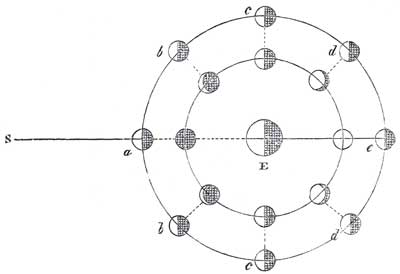
Beyond the earth the planet Mars (fig. 13) moves in its orbit round the sun; it is the smallest, but one, of the larger [Pg 15] planets, having a diameter of but 4085 miles, and being only about one-seventh the magnitude of the earth; it makes its revolution in 687 days, at a distance of 144,780,000 miles from the sun.
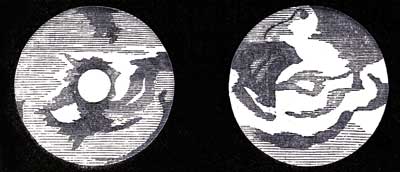
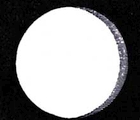
Owing to the brilliancy and proximity to the sun of Venus and Mercury, together with other causes, no rotation has been observed in them, but as this exists in all the other planets there is no doubt they also rotate, but the nearness of Mars to the earth when in opposition (that is, when the earth is between it and the sun), has caused its rotation to be distinctly visible; the observation of this has been from time to time greatly favoured by certain dark spots which have remained stationary a sufficient time to determine the question very accurately. Mars takes 24 hours and 37 minutes to turn on its axis, or pretty nearly the time the earth does. Its resemblance is still more increased by the axis of rotation being oblique, from all which it is inferred that there is a day and night, winter and summer, and variation of climate very nearly resembling that of our own world, and there are round bright parts situated at the poles of Mars, which enlarge when it is winter there and diminish when summer, just as would the snows of arctic regions, and these are therefore supposed to be portions of the surface of Mars which are actually covered with snow (fig. 13). As to the question of the planets [Pg 16] being inhabited, of course it can never be answered with certainty, but it is a great deal more likely that they are than that the moon is, which, having neither water nor atmosphere, can hardly be supposed to give habitation to any beings similar or analogous to those on earth, while Mars possesses a climate not greatly differing from that of the earth, and has both air and water. Mars has, at certain positions of the earth with respect to it, a partially "gibbous" form, that is, a small portion of the non-illuminated part comes within the lines of our vision it is then of the form seen in (fig. 14), but this can only occur when the earth and planet occupy positions somewhat near to that represented in fig. 15, in which s is the sun, e e opposite positions of the earth, and m Mars.
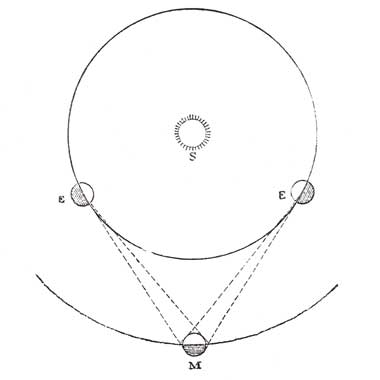
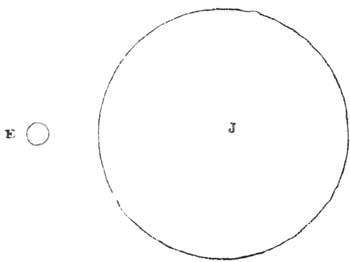

Jupiter is by far the largest of the planets, it is 87,030 [Pg 17] miles in diameter, and placed at the enormous distance of 494,000,000 miles from the sun. This great planet takes 12 years and 52 days to perform its circuit; it turns upon its axis in 9 hours 55 minutes, a surprisingly short time considering the immensity of its bulk. As a result of this rapid motion Jupiter is very far removed from the form of a true sphere, for the oblate form of heavenly bodies is caused by their rotatory motion, and the centrifugal force set up by it. In fig. 16 is an outline of the earth and Jupiter, showing their relative size. It has no phases, like those planets which are nearer to the sun than the earth, its great distance preventing this, as may be seen in fig. 17, in which the earth (e e) is placed at the two widest lateral positions of its orbit, but the earth is too near the sun, in proportion to the great distance of Jupiter, to allow any part of the latter to come within the range of vision, except that which is illuminated by the sun. This planet is high up in the heavens the greater number of nights in the year, and is therefore a very conspicuous object. It also presents a [Pg 18] most beautiful appearance through a good telescope, its vast size causing it to look larger than those which are much nearer; it has several shadowy belts across it, which are supposed to be openings in the strata of clouds which surround it, drawn into ring-like forms by the rotation of the planet, these are shown in fig. 18. It being probable that this great planet is surrounded by strata of the densest clouds which only open in the tropical region, its inhabitants therefore, (if there be any) get but a glimpse of the firmanent and its stars through them, in those situations at or near to the planet's equator. These dense clouds serve a very useful purpose in regions so very far removed from the source of heat, for if radiation were permitted to go on freely from the surface of the planet the sun's rays would be too feeble to compensate for it, and the cold would be intense; but the clouds reflect back the heat radiated from the surface and keep in what little heat is received at that great distance. Jupiter has four satellites or moons, which revolve round it as our moon does round this earth.
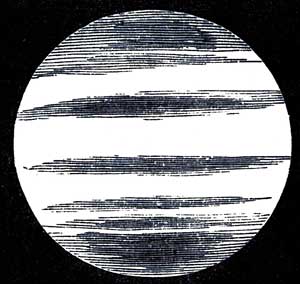

Far beyond Jupiter rolls another stupendous orb called Saturn, not so large as Jupiter, but still immense, being 847 times the bulk of the earth. It is placed at the distance of 906 millions of miles from the sun. An idea of this may be formed from the fact that light, which travels [Pg 19] at the rate of nearly 200,000 miles a second or 12,000,000 a minute, takes about an hour and a quarter to pass from the sun to Saturn. It performs its journey round the sun only in 29½ years, which are therefore but as one year, yet all this time it is moving at the rate of nearly 22,000 miles an hour, so immense is the orbit it has to traverse, but it revolves on its axis in about 10½ hours, so that the nights and days are extremely short while the years are prodigiously long. There is every reason to believe that it has changes of seasons and variation of climate similar to those in our world, but, being so far from the sun, they must be altogether more severe than ours. The most extraordinary part of this great globe is its possession of three (perhaps more) great flattened rings, which surround it, one within the other; these rings are of immense size and width, but very thin, the great breadth through all from the inner to the outer edges being about 30,000 miles, while their thickness cannot exceed 250. These rings are placed at a right angle to the planet's axis of rotation and revolve with it, so that when the planet is at the equinox, the edge of these rings is turned towards the sun, they can then be seen only by the most powerful telescopes, forming a faint streak on each side of the orb of the planet (fig. 19), but as they become inclined they appear as a very long ellipse, the ends of which project in loop-like forms on either side, giving rise to the notion of the planet having two handles (fig. 20). This ellipse becomes broader and broader as the plane of the rings forms a [Pg 20] greater angle with the line of vision. For a short time before and after the equinoxes of Saturn, the rings become invisible, owing to the earth and sun being on opposite sides of them, as may be seen in fig. 21, so that the darkened side is turned towards the earth and the edge, which is the only part illuminated, is towards the sun.


The inner ring of Saturn is supposed to be composed of watery vapour,
as it is somewhat transparent, but the outer ones are solid, which
is shown by the shadow they cast upon the planet, and the shadow it
casts upon them in different positions (figs. 22 and 23). Besides
these rings Saturn has eight satellites or moons, which revolve in a
plane nearly parallel to that of the rings and exterior to them. It
has been calculated that Saturn weighs only 100 times more than the
earth, although it is somewhere about 900 times larger, from which it
is concluded that the substance of which Saturn is made must be about
one-ninth the density of this earth, half the density of water, or
about the same as cork. Saturn is very much flattened at the poles, so
much so that the equatorial diameter is a tenth more than the axial
diameter, which difference is distinctly visible through good glasses.
Still further into space, at double the distance of Saturn, [Pg 21] or nearly 1822 millions of miles from the sun, another great world or planet revolves round it, it is called Uranus. This planet is not so large as either Jupiter or Saturn, but is of considerable magnitude, being eighty times that of this world, it takes eighty-four of our years to complete its vast circle round the sun, which are therefore equivalent to but one year of Uranus.
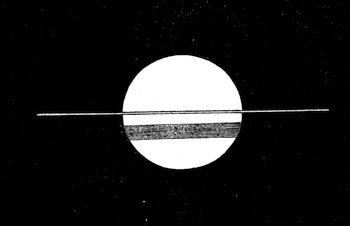
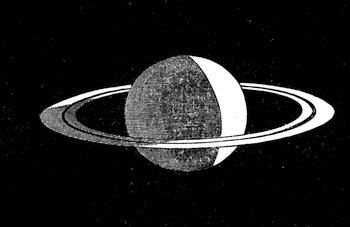
It has several satellites, four of which have been discerned perfectly, but it is doubtful whether there have not been two more seen. This orb was first recognised as a planet [Pg 22] by Sir Wm. Herschell, after whom it was for some time named.
Another, and the most remote planet in our system, is Neptune, revolving at the immense distance of 2850 millions of miles from the sun, and taking more than 164 years to perform the journey. This planet is only to be seen by the most powerful glasses, and was discovered under very peculiar circumstances, not (like other planets) by chance; its existence was recognised as necessary to account for certain "perturbations" or deviations in the orbit of Uranus, which was found to take a course differing from what it should, according to computation, and which were only to be accounted for by supposing that another planet existed far out in space, which affected the course of Uranus by its attraction. The idea of finding out where this orb should be, occurred to M. Le Verrier and Mr. Adams, independent of each other; they both arrived at nearly similar conclusions, for the positions assigned to the supposed planet so nearly agreed with each other and with its real position, that their calculations have been looked on as the greatest feat of astronomical research. It was discovered by Dr. Galle of Berlin, upon his hearing from Le Verrier the position in which at that time it should be sought for.
Upon observing the relative distances of the planets from each other in passing outwards from Mercury, it will be found that each one is placed about double the distance of the one next before it (not exactly, but sufficiently near to form a coincidence almost amounting to a law), they are as follows:—
| Mercury | 36,700,000 | |
| Venus | 68,770,000 | |
| The Earth | 95,000,000 | |
| Mars | 144,780,000 | |
| Jupiter | 494,000,000 | |
| Saturn | 906,000,000 | |
| Uranus | 1822,000,000 | |
| Neptune | 2850,000,000 |
It will be seen, however, that in this table of distances there is one great exception to the rule, namely the distance between Mars and Jupiter, which is nearly double what it should be according to this rule, giving rise to the idea that a planet ought to be placed between them. Professor Bode was so convinced that something of the kind was necessary to complete the harmony of the series, that he caused to be instituted a search for the supposed planet, and according to his conjecture one was discovered as nearly as possible in the situation indicated, but upon more accurate information being obtained, this planet was found to be so small (scarcely 150 miles diameter) that it could hardly be considered as a planet ranging with the others, and having so large a space of the heavens to itself; shortly afterwards another small planet was discovered, having nearly the same orbit. From time to time others have been discovered, to the number of forty-two, up to the present date. Dr. Olbers upon discovering the second of these small bodies, where one great one was anticipated, put forth the curious hypothesis, that one large planet had really existed there at some former time, that it had been shattered into pieces by some accident, such as an internal explosion, and that more of these pieces would be found; it is curious how accurately this prediction has been verified.
If we suppose the original planet to have been liquid when shattered to pieces, it would fully account for the fragments being spherical, just as globules of mercury assume this form from their own attraction of gravitation, and that the planets, our own earth amongst them, are liquid, is very nearly proved by their forms, which are exactly such as fluid masses rotating on an axis would assume, moreover the specific gravity of some of the planets is but little more than that of water, and with respect to our earth, the evidence of internal heat, increasing as we descend below the surface, &c., show almost beyond doubt that at the present time it is in a liquid state (molten) covered over by a few miles' thickness of hardened crust, which bears such a small proportion to the bulk of the globe, that the whole may be considered as liquid.
The thousands of stars which spangle the heavens are all part of one "system;" but it has been found by the aid of the telescope that this system is but one out of many. Our system of stars occupies a space somewhat in the form of a thick lens or much-flattened sphere, but others are of very different forms, and some have but little regularity of form at all; our sun is one of the stars of this system. It is not known whether there are planets revolving round the other stars, the distance being far too great for any telescope to render them visible. Our sun occupies a somewhat central position in the system. The stars are classed into sizes, as first magnitude, second magnitude, &c., on to the thirteenth or fourteenth magnitude, but all beyond the fifth magnitude (by far the greater number) are only visible by the aid of the telescope. There are about 5000 stars visible to the naked eye. But fourteen stars of the first magnitude are in our hemisphere of the heavens, and about fifty of the second, but the number of stars of each magnitude increases prodigiously in the higher numbers, so that those stars capable only of being seen by the aid of powerful telescopes, amount to many millions; these are chiefly situated in a great belt which encircles the heavens, called the "Milky Way," which is caused by the line of vision passing through the breadth of our starry system, and consequently meeting with a greater number of stars than in other directions, where it only crosses its thickness.
The other systems of stars, called "nebulæ," from their resemblance to little clouds, were supposed to consist of luminous matter of but little density, and which might at some future period be condensed into stars; but the improved power and construction of telescopes have enabled astronomers to resolve many of these nebulæ into clusters of stars, and there is but little doubt that all could be thus resolved, were the telescope of sufficient power; and thus it appears that in the infinity of space collections of systems are placed, each one too distant from the others to [Pg 25] be calculated or written in numbers, but each consisting of thousands of suns many hundred times greater than this earth, and many millions of miles from each other. What an idea of space does this afford, and how soon do all our narrow notions of possibility and impossibility vanish before such facts accomplished by the hands of God!

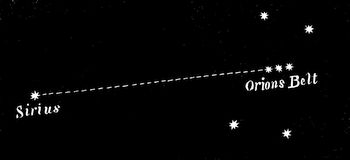
Amongst the stars composing our system there are certain conspicuous groups or constellations, which were named by the earliest astronomers, and compose a list of the most ridiculous imaginary figures, as useless to the casual observer of the stars as to the astronomer, and have not the most distant resemblance to the figures after which they are named, as for instance the "Great Bear" (Ursa Major) fig. 24. The grouping of stars into constellations serves, however, to find any one required (provided the groups on the chart can be identified with those in the heavens), as for instance the three conspicuous stars forming "Orion's belt" (fig. 25), from which a line produced eastward will point to Sirius, the brightest star in the heavens, and another line produced westward will serve to point out "Aldebaran," also a star of the first magnitude, &c.; also a line drawn from a to b in the Great Bear will nearly point to the pole-star—the star situated nearly (although not exactly) at the pole, or that part of the heavens which would be indicated by a line drawn through the earth at its axis of rotation. Amongst [Pg 26] the stars scattered over the vault of heaven there are many which to the naked eye appear single, but which when seen through the telescope prove to be two stars closely approaching each other. These "double stars" are of two kinds, "optical" and "physical;" optical double stars are those which appear to be near each other merely from the accident of one being placed behind the other, nearly in a straight line, although in reality at an immense distance and in no way connected. Physical double stars (usually called "binary systems") consist of two suns comparatively near each other and revolving about their common centre of gravity. Sir William Herschell first discovered their physical connection, and thereby proved that the great law of gravitation was not confined to our system, but was the ruling power which controlled and regulated other systems. Astronomers have calculated the orbits of only fourteen such "binary systems" at present with any degree of certainty; about a thousand double stars are known, but only about one hundred "binary systems." In some "binary systems" the two suns are of different colours; white and purple, red and green, or yellow and blue. If any planets revolve about such suns, when situated between the two, what strange phenomena must occur! Imagine a day during which a red sun had tinted everything crimson, being succeeded at sunset (not, as with us, by darkness) by the rising of a green sun, changing the colour of every object from red to green, and how curious and beautiful must be [Pg 27] the shades of light and colour during the transition from one day to the other. Can anything be conceived more gorgeous?—no shadow, but every object tinted with a combination of colours of the most brilliant hues! Triple, quadruple, and multiple stars are known in abundance, but all probably optically so, and not in any way connected with each other by attraction. Others of the stars are called "variable," they are those whose light gradually diminishes and after a time regains its former brightness; some of them not only vary in brilliancy but in colour; the cause of these phenomena is totally unknown, and fortunate will he be who discovers it; it will be a great stride in the science of astronomy, for at present everything proposed has been quite inadequate to account for such phenomena. About 60 of these variable stars are at present known, but others are constantly being added to the list. Hind has discovered twenty-one, Pogson seven, and other astronomers have taken their share in discerning them.
But, of all the heavenly bodies, none have excited so much wonder, and in former times so much fear, as the Comets. The orbits of these are for the most part in very eccentric ellipses, some of them comprised within the limits of our solar system, while those of others extend millions of miles beyond it, so that they only reappear to us after hundreds of years. The matter of which these bodies is composed is certainly not solid, as the smallest telescopic stars may be seen through the very middle of it, although many thousand miles in thickness. When comets approach the sun, their substance appears to become more condensed, and therefore to possess a greater power of reflecting light. The cause of the "tails" which appear appended to comets when they approach the sun is not known, but this tail extends always in a direction from the sun, and passes over many degrees of the heavens' space. As comets obey strictly the law of gravitation, they must possess some amount of weight or mass, however small it may be, and that it is inconceivably small is proved by the fact of comets having passed close to Jupiter, right amongst his four moons, without in any way affecting or disturbing their well-known motions; the [Pg 28] comets have, however, been terribly tossed about on such occasions, one having been totally lost to us by such an occurrence.
Thus it is seen how the same laws of gravity exist throughout all the infinity of space. The comets traverse our system of suns, and passing onwards with incredible rapidity, for years upon years, through that great space beyond it, at last visit some other system—perhaps to be as much an object of regard and wonderment there as they were here. The same ray of light which emanated from one of the distant stars of some one of the clusters situated far out in space, and which has travelled for thousands of years at the rate of 200,000 miles for every second of time, serves us here on this globe to distinguish it—it enters the tube of our telescope and affects our optic nerve; and the Creator who caused it there to be given off, has here made our senses capable of perceiving it. Is not this a clear demonstration of the fact, that one hand has designed the whole; and one Creator provided for all?
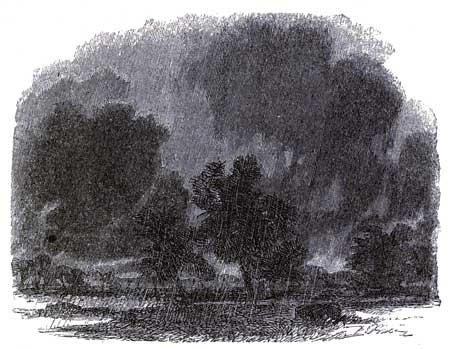
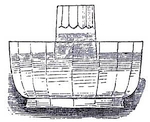
The earth is surrounded in all directions by a covering of air about forty miles in thickness, which bears about the proportion to the earth itself that a coating one inch thick would to a ball seventeen feet through, being about 1/200th of its diameter. This air, though invisible, may at all times be felt while in motion (such is the wind), and by rapidly passing the hand backwards and forwards it may be perceived to press against and slightly obstruct it; this air is composed of about twenty parts oxygen and eighty parts nitrogen, [Pg 30] together with about one part in every thousand of carbonic acid (consisting of carbon and oxygen in union) and a small proportion of vapour of carbonate of ammonia (ammonia in union with carbonic acid). It is the oxygen which enables animals to live in the air, as it is taken into their systems at every breath, it is thus constantly being consumed and would ultimately be so far diminished, that they could live no longer for want of it; but Providence has so arranged, that the necessary quantity is always being supplied by vegetables (which give out oxygen) to meet the deficiency. The air, although a gas, is yet capable of being weighed, of great compressibility, and of expansion to an unlimited extent, this causes the lower part (near the surface of the earth) to be much more dense than the upper regions, and those who have ascended to the tops of high mountains, have described the difficulty of respiration as being very great, owing to the rarefaction or lightness of the air. At the surface of the earth it presses with a weight of about fifteen pounds upon every square inch, but as this pressure is equal in every direction, it is not felt by us, nor does it crush the most fragile flower or insect; but, remove the pressure from one side of anything, and it will be found to press with violence upon the other. If the air were removed from the inside of a drum, the weight of the surrounding air would burst in the parchment and fill it. By way of experiment, fill a large basin with water, take a tumbler in the left hand and a piece of lighted paper in the right, hold the lighted paper for a moment under the inverted tumbler and immediately apply its open mouth to the surface of the water, letting it dip in about half an inch, the heat expands and consequently gets rid of some of the air in the tumbler, and as this cools again it resumes its original bulk; the pressure of the air on the surface of the water in the basin will force it up into the tumbler and nearly fill it (fig. 1). This is the principle of the barometer, which is a tube entirely exhausted of air and the weight of the atmosphere forces a [Pg 31] column of mercury (which is many times heavier than water) up to the height of about twenty-nine inches, according to the weight of the air at any particular time; this weight varies according to the state of the weather, whether wet or dry; but the average weight of air is found to be perfectly stationary, and during the twenty years from 1816 to 1836, it was found at Paris not to have varied 1/1200th of an inch. Winds or currents of air proceed from several causes; when the sun shines on a large surface of the earth, it becomes heated and a column of hot air is pressed upwards, for hot air is lighter than cold, and the cold air all around, by its weight, forces it up and rushes in to fill the space; this space may perhaps be many hundred square miles in extent, so that a current of wind is caused to blow towards this spot from all the regions round. This is the general state of things at the equatorial parts of the earth and causes the "trade winds," which uniformly blow (the greater part of the year) from both north and south towards the equator. Another cause of local winds, is the condensation of vapours into water; when the air over a large region is saturated with moisture it is greatly expanded by it, and when the vapour is condensed and falls as rain, the air from the surrounding parts forces itself in to fill the space occupied by the rain while in a state of vapour, which is nearly one hundred thousand times greater than it occupies when in the form of water. There are many causes to determine the condensation of the vapour, which the atmosphere always holds in larger or smaller quantities, but cold is the chief agent, for when a current of air passes over seas or rivers, or the damp surface of the earth, it becomes loaded with moisture, and being capable of holding only a certain quantity (less when cold than hot), it follows that warm air when saturated with moisture must let some of it fall when it becomes cooled. This may occur from entering a colder region, or uniting with another current of air colder than itself. In tropical regions the air is so warm that it takes up a very large quantity of watery vapour and upon the coming of colder weather, the rainy season begins and the air empties itself of its superfluous moisture, causing the most tremen [Pg 32]dous falls of rain in consequence (fig. 2). When the clouds are overcharged with moisture in cold climates or in cold weather, the vapour freezes as it condenses and forms snow, which under the microscope presents a series of the most beautiful star-like crystals (fig. 3); the same result is produced by the freezing of the vapour or fog near to the earth's surface, this is called "hoar-frost," which is (like dew) deposited on those parts of the surface most cooled by radiation. Hail is caused in all probability by the drops of rain passing through a cold stratum of air and becoming frozen as they fall. There are many wonderful accounts on record of great masses of ice falling from the clouds, some of them several feet thick; the cause of these phenomena (if they ever did occur) is not known. The curious occurrence of red or green snow, which has sometimes been known to fall, is owing to the snow being mixed with myriads of minute cellular plants called the Protococcus pluvialis, which in one state of its existence is green and in another red, and they colour the snow accordingly. The cause of their sudden accumulation in such vast quantities is not known, but may be sought for in some peculiar state of the atmosphere favourable to their growth, which in many places is prodigiously rapid.

The temperature of the air differs very greatly in different situations at the surface of the earth, the extreme difference being about 180 degrees; thus in winter, at the poles, the thermometer frequently stands at 60 degrees below zero, and at the equator, in summer, 120 degrees above, but, in the higher regions of the air, it is even colder than at the poles, for the sun shining on the earth heats it, and the air is heated by contact with it; this is its only source of heat, [Pg 33] of which it receives less and less the further it is from the earth, so that at a distance (depending upon the situation and climate) ranging from 3,500 to 17,000 feet from the surface, the air is so cold that it is called "the region of perpetual snow," and all mountains whose tops reach above this altitude are covered with snow (formed by the freezing of the rain and vapour) from this point to their summits (fig. 4), and the sun (although it nearly always shines there, these regions being above most of the clouds) is not able to melt it, for the radiation of heat from its surface is greater than its absorption from the sun's rays, white substances absorbing but very slowly, and rough surfaces (as the snow) radiating very rapidly.
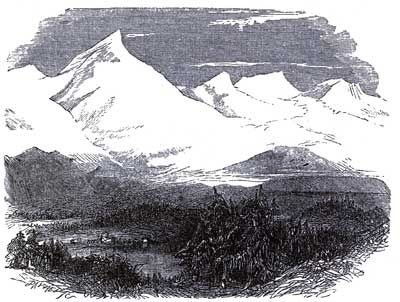
Dew is caused by condensation of the watery vapour held in the air; when the sun goes down the radiation continues from the surface of the earth, and those surfaces which radiate most rapidly, such as fields of grass, get cooled down below the temperature of the surrounding air, and [Pg 34] therefore cause a condensation of its watery vapour. This may be imitated by filling a large glass goblet with very cold water, and bringing it into a very warm room, the outside of the glass vessel will become covered with dew, although previously quite dry; the same may be shown by filling a similar glass with water at the ordinary temperature, taking care that the outside is dry, then stirring in an ounce or so of nitre or Rochelle salt, which will cause the water to become cold, and the outside of the glass to be covered, as before, with dew. Dew falls fastest when there are no clouds in the sky, as radiation then takes place from the earth into space, and is not compensated for by a return of radiation from the clouds to the earth.
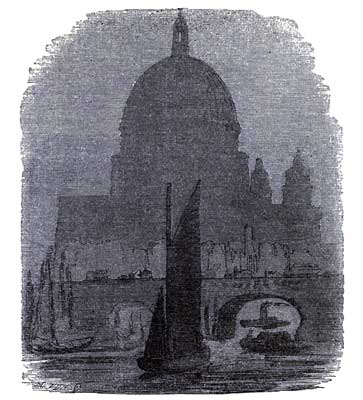
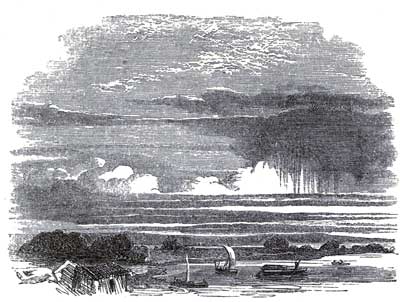
Clouds are formed by the partial condensation of vapour, and are borne along by the wind, instead of falling as rain; [Pg 35] the reason of their not falling is this, when the air below the clouds is saturated with moisture it will absorb no more and the rain falls, but when it is warm and dry, and passed in a constantly renewed current, then the vapour is absorbed before it reaches the earth, and is carried off by the wind. Clouds, therefore, although they often appear stationary, are constantly altering their form and size, portions being absorbed while others are being formed. Fogs are the same as clouds, the vapour arising from wet grass, rivers, &c., being condensed as it ascends, by a current of cold air passing over them. The fogs in London have a brown colour, from admixture of smoke, dust, &c., with which the air is contaminated (fig. 5). Clouds are of various forms and sizes, and indeed of almost every variety, but certain kinds which are frequently seen, have received different names. The "cirrhus" comprises all the feathery white clouds which float high up in the air in fine weather; the "cumulus" consists of the large mountain-like clouds which are generally seen in summer; the "stratus," those [Pg 36] horizontal layers of clouds low down in the horizon, so often seen at sunset; and the "nimbus" is the rain-cloud, of a dark grey or leaden hue, with sharp well-marked edges (fig. 6).
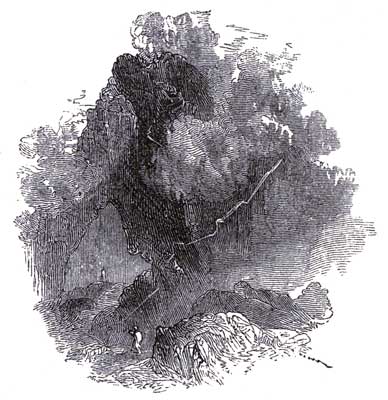
Clouds are amongst the most beautiful as well as useful things in nature, and it is one of the greatest proofs of the active benevolence of God, that all those things which serve man the most, are the most beautiful to contemplate. Without clouds there would be no rain, and without this no vegetation. In many parts of the tropical regions there is little or no rain, and in such parts desert places abound. Clouds are often of different states of electricity, and when they come near enough to each other, a transfer of the fluid takes place, accompanied with a flash of lightning (fig. 7) and a report, although this is not always heard at the same time that the lightning is seen, as sound does not travel nearly so fast as light; there is no danger from this kind of lightning. But it sometimes happens that a cloud in an opposite state of electricity to the surface of the earth is near enough to produce a flash of lightning between them, in this case [Pg 37] it is extremely dangerous to be near; but when the thunder is not heard till some time after the flash is seen, there can be no danger, as it is then far away. Sound travels at about eleven hundred feet per second, therefore (in round numbers) it may be known that the lightning is one mile distant for every five seconds that elapse between the flash and the thunder. The notion which prevails that iron and steel attract lightning is entirely erroneous, they do not even conduct it so well as copper and many other metals.
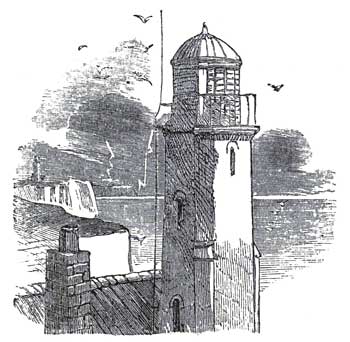
Lightning conductors (fig. 8) are wires of iron or copper, made to project above the highest parts of buildings and carried down to the earth; they have the power of conducting the lightning down without injury to the building, for electricity (which lightning is) travels through metallic wires for any distance without disturbance or noise (as in the electric telegraph), but bad conductors are apt to be burst and rent by it if it be strong enough, creating flashes of light and reports. Lightning strikes most readily any projecting substance or point, the highest point is therefore selected for the protrusion of the upper part of conductors. In a plain or open space, trees and animals are often struck, as [Pg 38] they form conductors (although very bad ones) to the lightning; being bad conductors, instead of allowing it to pass quietly to the earth as do the wires, they are generally destroyed by it. It has been often stated that we should select an open space in a thunder-storm, but this would render one liable to be struck, especially if there were no object near of larger dimensions, the best plan is to stand near to any trees or houses without touching them, the danger would not then be so great, the trees or buildings being taller, would be most liable to conduct the lightning to the earth. The danger of touching or leaning against a tree in a thunder-storm, arises from the person thus making himself (as it were) part of it and incurring the same risk.
Thunder-storms, which would at first thought appear to be of no utility to man, are indeed of great service; it is a common saying that thunder clears the air, this is the result of feeling and experience, but chemists have demonstrated the fact that a substance called "ozone" (a peculiar state of the element oxygen) is produced by thunder-storms; this ozone possesses the wonderful power of correcting (decomposing) putrid and unwholesome gases and exhalations which might otherwise produce fever, cholera, &c., it moreover destroys the ova or germs of many animals and vegetables which might otherwise be injurious to vegetation of more importance, the slight injury which these storms inflict here and there should weigh as nothing in the balance of utility with such universal good. Thus it is that the works of God have all the stamps of goodness, and this ought to inspire us with so much thankfulness as to overcome every fear for personal safety. Were these grand phenomena of nature, (as materialists would make us believe) the result of laws depending solely upon the physical co-operation of mere matter, good would be the exception instead of the rule, and most of them would produce effects, if not injurious at least not beneficial, but such is not the case, and throughout all the wonderful operations of nature there is not one but tends to good, for God often inflicts a small injury that a great good may result; we say a small injury, but it is questionable if the [Pg 39] injury is not often a benefit, which appears to us injurious only because we do not understand it fully, every disturbing cause tends to produce some apparent disorder, such as storms, hurricanes, &c., some indeed so terrific as to destroy ships and houses, but what would be the result if the atmosphere were never disturbed from any cause? Why the lower stratum would become so loaded with impurities that it would be unfit to breathe, miasms and noxious gases would for ever remain a curse to the races of men and animals who might be doomed to inhabit such regions, but the very regions where these miasms are most likely to form are those about the tropics, and here it is that the greatest storms occur to remove them. Even the great deserts, which appear so useless to man, and which are uninhabitable to a great extent, have their office, and an important one too; they are to the earth what ventilators are to buildings, drawing the cold air from the poles to cool the regions that are too hot, and sending a current of heated air through the upper regions of the atmosphere (where it can do no injury to anything) to warm the colder parts of the earth, another instance of the wonderful care and goodness on the part of the Creator. The various and beautiful colours of the clouds, particularly at the rising and setting of the sun, are caused by refraction separating the white light into its primitive constituents, blue, red, and yellow light and their combinations, purple, orange, green, &c., and the more obliquely the rays impinge upon the earth the greater will be this refraction, this accounts for colours seldom appearing in the clouds at midday. But of all the beautiful effects of the refraction of light, the Rainbow (fig. 9) is the most glorious, it has been celebrated in all ages for its transient beauty. It is only seen when rain is falling in front of a brightly illuminated cloud, the sun being behind the spectator; it is a reflection of the sun by the cloud transmitted through millions of drops of rain, each of which acts as a prism, and produces rings of colour; for each of the rays of light (red, blue, and yellow) are refracted in unequal degrees, and therefore take separate places, forming the rings of colour seen in the rainbow.
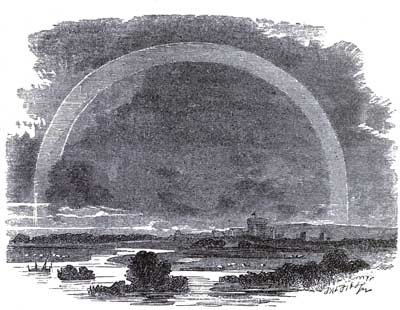
The air is the great source from which all the nourishment of the organic creation, whether vegetable or animal, is derived; its carbonic acid is decomposed by the vegetables, which appropriate the carbon, turning over the oxygen to their companions, the animals; the ammonia of the air furnishes all the nitrogen of seeds and other nutritious parts of vegetables, which are eaten by animals; and water, the chief source of all nutriment, passes first from the air before it enters the soil, bringing both carbonic acid and ammonia to fertilise it. That all this nourishment is derived from the air is evidently shown by the formation and increase of mould in forests which have grown for centuries; this black mould is nearly all decayed vegetable matter, formed by the continuous fall and decay of leaves and trees, but which, instead of diminishing, increases. Now, where does all this come from? certainly not out of the earth, for it does not contain the necessary elements. Expose the surface of the bare earth for several centuries, and first small plants, then larger ones, will grow upon it, until the state of things described above takes place, the earth being [Pg 41] just as rich in organic matter now as at the beginning, and much richer on the surface, where a thick stratum of black mould forms from the repeated fall and decay of leaves and wood; all the substance which the forest shall have drawn from the earth (with the exception of certain salts and earthy matters) must therefore have been derived from the air, which contains every ingredient necessary for its formation, while in the earth itself no kind of organic matter is ever found.
There was formerly a time when the carbonic acid of the air was in much greater abundance, and favoured the growth of those plants which thrive where there is plenty of water, as in swamps and marshes. They grew and decayed for a vast period of time, till a thick stratum of carbonaceous matter was deposited, which, after being buried (by some convulsion of nature) at a great depth, and pressed by the enormous weight of the superincumbent earth into a hard solid substance, is now being dug up by man, and forms that most valuable of all products of the mine, coal (fig. 10).
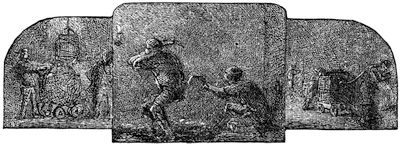
That coal is derived from decayed and altered vegetable matters, is pretty well proved; for many pieces of coal, if ground thin and subjected to the microscope, present a texture exactly such as can be seen in wood of the present date, and not only the ordinary structure, but in very many cases certain "dotted fibres," indicating that the wood belonged to the order of cone-bearing trees (Coniferæ), and there is but little doubt that the constant deposit of such wood and its slow and gradual decay was the real source of [Pg 42] all our coal. How wonderful, and how good, is the foreknowledge of God! Just at a time when the great forests of the earth are fast disappearing, and with them the only other source of fuel for fires, this reserve of the old forests, which was then useless, serves man as a most excellent friend—more useful than gold or silver, more precious than diamonds or rubies! But this world is one of perpetual change, and the coal thus brought forth from the depths of the earth, is by man being rapidly restored to the air from whence—thousands of years ago—it was derived; and it is not coal alone which is thus being restored, but every organic being in the whole creation, for at their decay they all enter this vast mausoleum of the dead!
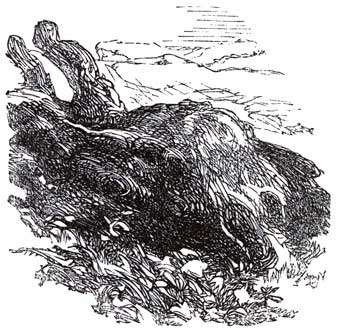
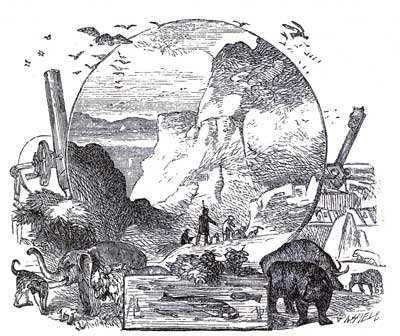
The Earth, considered as one of those spheres which circulate round the sun amidst the wide expanse of the firmanent, holds but an insignificant position among them, especially when compared with those great and magnificent orbs, Jupiter and Saturn; but, in another point of view, as the dwelling-place of all the animated beings, vegetables, and minerals, with which we have any practical knowledge, it holds to us a position in creation far above all the others.
It is upon the surface of this our earth that we behold in detail those wonders of the Great Creator's hands, [Pg 44] which must fill all who contemplate and study them with enlarged ideas of His wisdom, goodness, and power. We see the millions of stars sparkling in the abyss of space, and our minds are so formed that we can measure and gauge their distances and rates of travelling, their orbits and their sizes, their weights, and the powers with which they attract and influence each other; but we only contemplate a star as one bright and beautiful object worthy to be one of the gems which the Almighty has set in His crown of glory, or a lamp to light the halls of His infinite habitation, but we still contemplate it as a single object; while on the surface of the earth our Maker has permitted us to roam and search out by what benevolent contrivances He has suited all things to the comfort and welfare of His creatures. How His mercy and goodness are extended amply to the most minute animalcule as well as to man, and how His powers of construction are to be found in the most minute objects which the microscope can display, as perfect as in the largest creature we behold. It is here upon our earth that we perceive how the structure and functions of all creatures are regulated and controlled by the unerring laws which He has created, over which laws the creatures have no control, and which if duly regarded and used according to the faculties each has been gifted with, will return the greatest joy and happiness their several natures are capable of, and secure all that perfection of operation which their mechanical frames are suited to perform; but before any description of the organised beings which dwell on the earth can be given, it will be proper to enter into a description of the earth itself, to see what sort of place God has provided for them, and how through succeeding cycles of time He has gradually perfected and prepared it for the reception of His last great work, Man.
It is only a few miles below the surface of the earth that man has been able to penetrate and examine, but reason comes to assist him where examination fails, and it would have been but a few hundred yards only that his labours could have extended had it not been that parts, which are generally situated miles below the surface, are occasionally found [Pg 45] at or even raised above it, by some disturbing cause which operated in times far back; so that man is able to examine on the surface parts which he could scarcely dig down to.
The whole of the earth, its inhabitants, the air which surrounds it, the waters upon its surface, and its vegetable products, are composed of certain substances called elements, combined and united in certain numbers and proportions. The following is a list of all known:—
| METALLIC ELEMENTS. | |||
|---|---|---|---|
| Aluminium | 13.7 | Nickel | 29.6 |
| Antimony | 12.9 | Niobium | * |
| Arsenic | 75 | Norium | * |
| Barium | 68.5 | Osmium | 99.6 |
| Bismuth | 21.3 | Palladium | 53.3 |
| Cadmium | 56 | Pelopium | * |
| Calcium | 20 | Platinum | 98.7 |
| Cerium | 47 | Potassium | 39.2 |
| Chromium | 26.7 | Rhodium | 52.2 |
| Cobalt | 29.5 | Ruthenium | 52.2 |
| Copper | 31.7 | Silicon | 21.3 |
| Didymium | * | Silver | 108.1 |
| Donarium | * | Sodium | 23 |
| Erbium | * | Strontium | 43.8 |
| Glucinium | * | Tantalium | 184 |
| Gold | 197 | Tellurium | 64.2 |
| Ilmenium | * | Terbinum | * |
| Iridium | 99 | Thorium | 59.6 |
| Iron | 28 | Tin | 59 |
| Lanthanium | * | Titanium | 25 |
| Lead | 103.7 | Tungsten | 95 |
| Lithium | 6.5 | Uranium | 60 |
| Magnesium | 12.2 | Vanadium | 68.6 |
| Manganese | 27.6 | Yttrium | 32.2 |
| Mercury | 100 | Zinc | 32.6 |
| Molybdenum | 46 | Zirconium | 22.4 |
| NON-METALLIC ELEMENTS. | |||
|---|---|---|---|
| Boron | 10.9 | Iodine | 127.1 |
| Bromine | 80 | Nitrogen | 14 |
| Carbon | 6 | Oxygen | 8 |
| Chlorine | 35 | Phosphorus | 32 |
| Fluorine | 18.9 | Sulphur | 16 |
| Hydrogen | 1 | Selenium | 39.5 |
By this list it will be perceived that the greatest number of the elements are metals, but most of these are very rare and met with but in certain localities, making up but a very insignificant part of the earth's surface, while others (never found in nature, as metals) in combination with oxygen forming "earths" compose the greater part of its bulk. But of all the elements, oxygen (a gas) is the most widely diffused, and constitutes rather more than one half of the whole earth, thus it forms 1/5th of the air, 9/10ths of the water, of the various earths and rocks about 1/2, and in all organised beings about 3/4.
Of the metallic elements, those which form the greater bulk of the earth are—
Silicon.
Aluminium.
Calcium.
Magnesium.
Potassium.
Sodium.
These never exist in nature as metals, but combined with oxygen forming the following earths and alkalies:—
Silica }
Alumina } Earths.
Lime }
Magnesia }
Potassa } Alkalies.
Soda }
These four "earths" form about eighty-five per cent. of the whole bulk of this globe, the remainder being made up of water (composed of eight parts oxygen and one part hydrogen), of "salt," both as rock or crystal-salt, and dissolved in the water of the sea, of the ores of different metals (metals in union with oxygen, sulphur, &c.), and of the remains of former vegetation, existing as coal.
Silica is composed of 21.3 parts of silicon with 24 of oxygen, it is that earth which constitutes a great part of almost every soil, and forms sand, sandstone, and flint, it enters largely also into the formation of granite and the other primitive rocks; when pure it is called "quartz" or "rock-crystal" and is often found in large and beautiful masses. Silica, in different forms, contaminated and coloured by different metallic oxides, &c., forms that class of stones [Pg 47] known as "agate," "Scotch pebble," "carnelian," &c., and in the form of flint is found nearly pure, forming "nodules" or rounded masses lying in layers in the chalk cliffs on our coasts, the origin of these nodules of flint is very obscure, but they are by many attributed to the petrifaction of sponges, &c., the general form of which they often retain as well as their internal structure, which may be seen when viewed in thin slices by means of the microscope. Pure silica is a white insoluble powder, and is much used by the makers of porcelain to mix with their other ingredients.
Alumina consists of 41.1 parts of aluminium in combination with 24 parts of oxygen, it is the earth which forms the basis of all clays, loams, and slates, it is in its pure state perfectly white but in most clays is coloured brown or blueish by oxide of iron, many of our most beautiful gems, as the ruby, sapphire, and emerald, consist chiefly of crystallised alumina coloured by oxide of iron, chromium, &c., this earth like silica enters largely into the composition of the primitive rocks.
Lime is another of the earths which form a great part of all soils; it consists of 20 parts calcium with 8 of oxygen. Unlike the two preceding earths, it exists only in union with some acid. When united to carbonic acid it forms limestone, chalk, marble, &c., and when in a crystallised state "Iceland spar." The various kinds of limestone are largely used as building-stones, and any of them when burnt yields lime or "quick-lime" as it is generally called, which is capable of uniting with a certain portion of water, giving out a considerable amount of heat during the combination. Lime is often found in union with sulphuric acid, forming gypsum or Plaster of Paris, in combination with phosphoric acid it forms the basis or earthy part of the bones of animals, and is found in some of the tissues of plants.
Potassa consists of 39.2 parts potassium in union with 8 oxygen, it constitutes about 12 per cent. of the granites and basalts (primitive rocks) in union with silica and alumina, it is also found in the fluids of many vegetables in union with carbonic, oxalic, and other acids.
Soda consists of twenty-three parts sodium with eight oxygen, it however does not exist in this form in nature, but in union with chlorine instead of oxygen, constituting chloride of sodium or common salt, this substance forms strata of considerable extent in some localities and being soluble has no doubt been washed out by the rains from many other places and has thus communicated saltness to the waters of the ocean. The other metallic elements exist chiefly in those forms of earth called "ores" being metals in union with oxygen, sulphur, &c., or are found in the metallic state, as gold, platinum, &c., it is from these ores that most of our useful metals are procured by the process called smelting, as in the case of iron, copper, lead, tin, &c. All the substances known result from the combinations of the elements, but these elements do not chemically combine in all proportions, but in certain definite quantities only; these quantities or proportions are signified by the numbers attached to each element in the list given,1 and the union of these substances must be in the proportion of these numbers (or multiples of them) only, all superfluity of the substances combined remaining in a state of mere mechanical mixture. For example, if six parts of carbon (charcoal) made red-hot be plunged into a jar containing twenty parts of oxygen, it will unite with sixteen parts only of the oxygen (a multiple of eight), and form twenty-two parts of carbonic acid, the extra four parts of oxygen still remaining as oxygen mixed with the carbonic acid; and if into this carbonic acid twenty parts of lime be put, it will unite with the twenty-two of carbonic acid, forming forty-two of carbonate of lime, still leaving the four parts of oxygen untouched. Had forty parts of lime been put into the mixture, instead of twenty, still only forty-two of carbonate of lime would have been formed, and the other twenty parts (like the four of oxygen) being superfluous, would still have remained as lime, mixed with the carbonate of lime. These combining quantities are called the "equivalents" of the substances.
1 See the list of the elements at page 45; those which are distinguished by an asterisk, are elements of which the "equivalents" are not known.
Upon examining various portions of the earth's surface, they will be found to differ in character from each other; in one place perhaps sandy soil will be found, in another, hard rock, in a third, clay, in a fourth, chalk, and so on. Now, if this examination were carried no further, it might well be presumed that each of these kinds of soil were continued downwards into the earth for an indefinite distance, but upon digging (as in sinking a shaft or well) it is found that the stratum of soil upon the surface is soon passed through, that others in succession present themselves and that this succession of strata is not a matter of chance, but (with certain restrictions) follows in invariable order. It is true some strata are occasionally not present, and that others replace them; but yet (taken altogether) there is the same order of succession everywhere found. The following diagram (fig. 1) gives the section of these strata from the earth's surface to the granite which is the lowest of all formations and through which no one has ever penetrated. The figures give an approximation to their average thickness in feet. These strata do not all run in a direction parallel to the surface of the earth, or else it would result that the surface would everywhere be made up of the highest, but they have been contorted and heaved up into mounds or depressed; and the granite has often been pushed upwards, carrying with it all the upper strata to a certain extent, at last thrusting quite through them all and presenting itself above the surface, forming in this way the tops of many very high mountains, Mont Blanc for instance. Such a mountain if cleft from the summit to the base would present a section similar to that shown in fig. 2, and thus it occurs (contrary to what would at first thought be supposed) that the highest ground is generally formed of the lowest strata, while the valleys are nearly always covered with the latest formations, which is partly owing to the elevating process before alluded to, and partly to the winds, rains, &c., tending to carry away and wash down every kind of soil from the upper ground and deposit it in the lower.
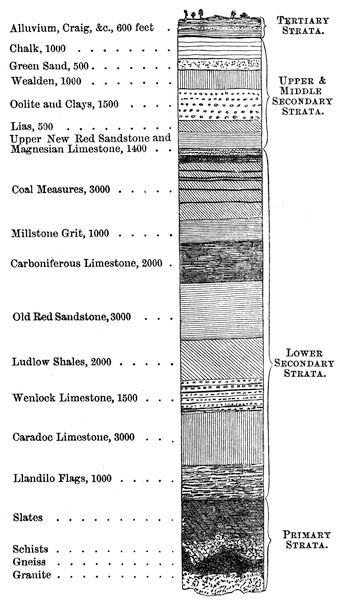




Fig. 3 represents strata in a state called by geologists "conformable," which name is applied when the strata follow their natural or regular succession, whether this retains its horizontal position, or, as in fig. 4, assumes a position more or less vertical, which frequently happens from the subsidence of one part or the elevation of another; but they are sometimes found in the state represented in fig. 5, and in which they are said to be "unconformable." Such strata after having been tilted out of the horizontal have [Pg 52] had other strata deposited upon them, which again may be more or less contorted from the same causes. The regularity of strata is often interrupted by what are called "faults" or "dykes," which have arisen from some part of the earth sinking down or another part being raised up, producing a fracture through all the strata and causing those on either side of this fault or fracture to occupy a situation not corresponding to those on the opposite, as in fig. 6, but yet to be found at a higher or lower elevation, and it is nearly always found that these strata are raised on that side to which the line of fracture inclines, as in the figure. These faults are often sources of great annoyance to the miner, who finds a sudden termination to the seam of coal or ore that he is working. The cracks are generally filled with some primitive rock, as basalt, rising from beneath while in a liquid state and filling up the interstices; it will often happen that the faults thus filled will have veins of the same rock branching out and not only filling up cracks but forcing its way between the various strata, thus interposing a stratum of basalt quite out of its proper position and altering, by the effects of the heat communicated, the character of the strata in juxtaposition; this is shown in fig. 7.

Upon a close examination of the various strata which form the crust of the earth, it is found that each has its own peculiar character; some have resulted from the accumulation of matters deposited at the bottom of ancient seas, others in the beds of rivers or fresh-water lakes, or again others (as the coal formation) from the accumulation of vegetable matters; further, these strata do not only differ in structure and composition, but also in the remains of [Pg 53] animals and plants found in them; for there is scarcely any kind of soil (above the primary rocks) in which abundant remains of these have not been found. It will now be proper to give a description of them in succession, beginning at the lowest or primary, granite.
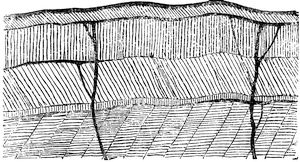
This appears to be the result of the cooling and crystallisation of that molten mass which many circumstances (hereafter to be mentioned) point out as making up the great body of the earth. Granite differs, in various places, in colour and quality (the varieties are known as "sienite," "porphyry," "greenstone," &c.), but still retains its own distinctive characters; it is a hard, crystalline rock, consisting of "felspar," "mica," and "quartz," in separate crystals, but mechanically blended; its chemical composition as a whole is silica, alumina, and potassa, with small quantities of lime and oxide of iron. This granite is met with everywhere, if the outer crust of the earth be penetrated to a sufficient depth; it however frequently exists on the surface, having no strata below it, and in some places overlies other strata—this, and the fact that cracks and crevices of some of the lower strata are filled up with granite, which could only have taken place while it was in a liquid state, as in fig. 8, together with evidences of the effects of calcination, and other changes producible only by extreme heat, all around those parts and in the strata immediately overlaying the granite, point out that it was once in a state of fusion.
Above the granite formation, in many places, especially in Norway and Sweden, there is a stratum of rock called [Pg 54] gneiss, which consists of the same ingredients as granite in a slightly altered form. Granite will often pass into gneiss gradually, and this again into those slaty formations which rest upon it and come next in the series. These consist of mica-slate, hornblend-slate, and chlorite-slate or schist, a name given to all those rocks of a slaty structure which have a cleavage or capability of being cleft into thin laminæ or slices (hence their applicability to the purposes of building, forming excellent roofing materials, &c.).
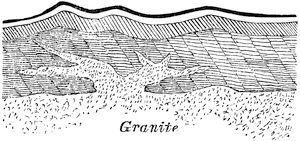
All these rocks have received the name of "primary," they have no appearance of being stratified or deposited in layers, which appearance seems to be in all cases the result of having at some time been suspended in water and thence deposited gradually as mud, sand, &c., time, pressure, and heat having afterwards altered their consistence. All these consist of the earths described as composing granite, but combined in different proportions. Above these rocks there is a formation of a totally different composition, namely crystalline limestone, commonly known as marble; this consists wholly of carbonate of lime or lime in union with carbonic acid, and its crystalline state appears to have been produced by long-continued heat and pressure. This limestone is by many ranked amongst the primary rocks, although it differs so entirely in its composition which exactly resembles a formation presently to be described (the chalk); however, if this be classed with the primary rocks, then it may be fairly said that all above have resulted from their disintegration and reunion in different forms, by the action of water and vital forces of different kinds. The state of [Pg 55] the earth at the close of this the "primary period" may now be considered.
The early history of our globe forms one of the great problems of geology, but there is evidence enough upon which to form conclusions and show that the earth had undergone some great and varied changes embracing immense periods of time, and if the sciences of astronomy, chemistry, mathematics, &c., be brought in to assist the inquiry, some plain facts become evident. Astronomy shows us orbs circulating round the sun (the planets), strictly analogous to our earth, and furnishes us with their densities; these are found to be various, ranging from about six times the density of water to half its density. The planets appear to be at different stages of condensation, and it is not unreasonable to suppose that our earth was once of no greater density than the lightest of them. The inner ring of Saturn is probably in a liquid state, for it is transparent. The substance of which comets are composed is a vapour, so rare and thin that it cannot be compared in density to our atmosphere even, and yet these comets preserve their identity, circulating through immense realms of space with prodigious rapidity. Thus astronomy presents analogies in favour of the supposition that the earth was once gaseous, or at all events of much less density than at present; but mathematical inquiries go much further, and furnish almost proof that the earth was once (if not now) in a liquid state, for the exact form which a liquid ball would assume upon rotating at the rate which the earth does, is exactly that which the globe is found by measurement to possess.
Chemistry has ascertained that the heat of the earth is far greater than any tract of the heavens through which it passes; that this heat could not have been communicated by the sun's rays, for had it been so the surface would be hotter than the interior, the very reverse of which is found to be the fact, and the deeper we go down the higher the temperature is. Chemistry shows further that this heat can be completely accounted for by the condensation and solidification of the earth itself; for the condensation of all [Pg 56] gases into liquids, and of liquids into solids, causes a very large portion of latent caloric to become sensible, for example, any quantity of a gas at 60 deg. suddenly reduced to a smaller bulk, would have a temperature higher than 60 deg. A little contrivance has long been in use for obtaining fire by this process, consisting of a cylinder and piston, the rod of which if struck down sets fire to a piece of German-tinder. It is probable that all fire, and every alteration of temperature, are due to this one cause alone.
Now assuming it as a fact that the earth was once in a gaseous state, and that the atoms of this gas or vapour exerted (as they must have done) an attraction towards each other, the result would be that they would press immensely upon those parts towards the centre and cause them to solidify. This act of solidification would produce such an intense heat that the solid would be expanded and fused into a liquid, this continuing until all the more condensible matters had become liquid, the earth would assume its spheroidal form from its rotation, be surrounded by an atmosphere of the least easily condensible substance, nitrogen, together with all the oxygen not wanted to combine with the metallic vapour and form earth. This globe with its atmosphere continuing to roll through the cold regions of space, would gradually lose the heat from its outer part by radiation. A film of cooled and condensed earthy matter would begin to form on the surface by crystallisation, and then would commence all those grand phenomena which it is the province of the geologist to study and explain. This crust consisted of the first-formed granite which (from inequality of contraction in the bulk of the earth) was broken up into fragments and perhaps partly re-dissolved again and again in some places, as it chanced that these contractions were more or less irregular. The result of this crushing and crumbling-up is seen in the coarser parts of the gneiss, called "Grauwacke," which consist of angular fragments of granite more or less imbedded in a cement of the same substance. This could not have been produced by water, as the surface must have been too hot for it to have existed on the earth in any other form than the most highly [Pg 57] rarefied steam combined with the atmosphere, and in all probability partly condensed in the upper regions, forming a continuous strata of clouds, or rather water, through which the sun could hardly be seen or its light penetrate, and such a state of things exists at this present time in the planet Jupiter. How beautifully does this coincide with the Mosaic account, "The earth was without form and void, and darkness was upon the face of the earth."
The surface of the earth at this time can be well understood by any one who will take the pains to evaporate any saline solution in a capsule till it is about to crystallise, and observe attentively the pellicle of salt as it forms on the surface; first a partial film will show itself in a few places, floating about and joining with others, then when nearly the whole surface is coated, it will break up in some places and sink into the liquid beneath, another pellicle will form and join with the remains of the first, and as this thickens it will push up ridges and inequalities of the surface from openings and fissures in which little jets of steam and fluid will escape; these little ridges are chains of mountains, the little jets of steam those volcanic eruptions which were at that period so frequent; the surface of the capsule is the surface of the earth, and the five minutes which the observer has contemplated it, a million years.
The next effect of the cooling of the earth would be the gradual condensation of the vapour of water with which it was surrounded; this falling upon the earth formed seas and oceans, leaving only the higher portions exposed above its level. The clearing-up of the dense dark clouds for the first time let in to the earth's surface the glorious and vivifying rays of the sun, and this great effect possibly accords with the earliest record in the Bible of the acts of creation—"And God said, let there be light, and there was light."
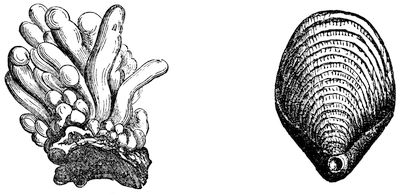
The earth being chiefly covered with water, and the air partly freed from watery vapour, then commenced the great creation of organised beings. The air, although to a certain extent, free from vapour, must yet have contained an enormous amount of carbonic acid; this, being less easily condensed than any of the matters which had gone through [Pg 58] that process, would still remain there as a gas, and the effect of this superabundance would be to saturate all the water covering the earth with it; this solution of carbonic acid, being capable of dissolving lime, would (as it percolated and rushed in currents through the rocks and inequalities of the surface) become converted into a solution of percarbonate of lime, taking up a large quantity of this earth from the broken-up granite, &c., then this carbonate of lime would be deposited at the bottom of the water in one of two ways—either from pressure, diminution of carbonic acid in the air, and heat of the surface, it crystallised at the bottom in the form of marble (that the water does thus become saturated with carbonic acid and take up lime, is constantly shown by the stalagmites which form on the floors of caverns, where the water thus loaded with percarbonate of lime, evaporating, deposits gradually the carbonate in all sorts of fantastic shapes, as in fig. 9), or the myriads of crinoidians and brachiopodous molluscs (fig. 10) which were about this time created, absorbed it into their systems and at their death deposited their shells, which are made of this earth, at the bottom of the sea; these shells, accumulating through ages into strata, became hardened and partly crystallised by heat, thus forming the limestones, which were the first containing carbonate of lime. That such a collection, from such causes, is [Pg 59] quite possible, will be presently shown in describing the chalk formation.
Ages of comparative quiet now appear to have succeeded the first great contraction of the earth's crust, probably millions of years, during which time the tides and currents of the ocean had to wash and wear down all the thousands of projecting rocks or inequalities and dissolve (as before described) all the lime, depositing the sand and clay in those immense strata which form the "transition series;" this appears to have taken place over nearly the whole world at that time, and ages upon ages must have elapsed to form such deposits as the sandstone, claystone, and limestone, in alternation, forming the "Llandilo," "Caradoc," and "Wenlock" strata, more than a mile in thickness; these are by some geologists reckoned among the primary series (by some called the "transition rocks"), and in England form the "Cambrian" and "Silurian" systems.
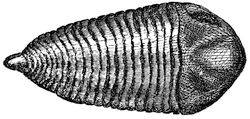
In these strata the remains of organised beings are first found, consisting of zoophytes, crustacea (chiefly Trilobites, fig. 11), nautili, crinoidii (stone lilies), and a few ganoid (plate-covered) fishes; these lower forms of animal life in some parts abound in the most prodigious numbers. There must, of course, have been vegetables of some kind previously formed to constitute nourishment for these animals, but scarcely any remains of such exist, except in a few localities.
The Trilobites were amongst the first creatures inhabiting our globe, and it is a curious fact to contemplate, that their eyes (fig. 12) should have been preserved perfect; they [Pg 60] present one of those wonderful objects which carry one's thoughts backwards to the early ages of the world, probably many millions of years, and yet it is found by the peculiar structure of the eyes of these Trilobites that they were placed at the bottom of the sea with perfect power to look upwards at the light of the sun through the transparent waters. The same hand and the same power had then Divine care and solicitude for the well-being of His creatures, as great as He has for those of later ages, and these first-formed beings exactly correspond with the account of the creation of animals given in the book of Genesis, "And God said, let the waters bring forth abundantly the moving creature that hath life."
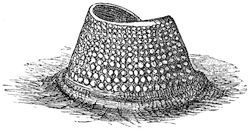
At the end of the "transition period"—after ages of long-continued disintegration of the rough surface of the earth, and its deposition in strata—after thousands of generations of crustaceans, molluscs, and zoophytes had lived and died, depositing their shells at the bottom of the seas, so as to form strata of the carbonate of lime—a great and terrific convulsion of nature put a stop to all this quiet and systematic order of things; for through these long reaches of time, the physical laws of nature had continued to exert their influence, the bulk of the world had gone on radiating its heat into space, and, as a necessary result, had gradually contracted in size. Now, this radiation had doubtless been much retarded by the badly-conducting surface of solid matter which had everywhere covered it, but, although retarded, it could not be prevented, and although the crust [Pg 61] of solid matter may already have been several miles in thickness, yet this in relation to the bulk of the earth would hold but the proportion of the paper on the surface of a twelve-inch globe. As the fluid mass of the earth continued to contract, there would of course be a great stress or crushing-power exerted on the crust, both by its own gravity and that of the air which surrounded it, and about this period it appears to have given way over the greatest portion of the globe, producing enormous rents and fractures, seen in every country in the faults and dislocations of these primitive and transition strata, some of which were driven up by the downward force of others, and left in a perpendicular position, some overlapping each other, &c.; but the greatest effect of this convulsion appears to have been produced by the rocking or rolling surface of the sub-existing fluid world, forming gigantic waves, which, by meeting in opposite directions and thrusting upwards the strata to a great height, formed the mighty mountain-chains of the now-existing earth, which raise their lofty pinnacles above the clouds. Now, these mountains may at first thought appear too ponderous and extensive to be thrown up in this way; but by inspecting the engraved section of a part of the globe (fig. 13), it will be seen how very insignificant a mountain is when compared with the whole world. This section is through Asia from the Persian Gulf to the Yellow Sea, and embraces the highest land on the whole face of the earth, and is drawn on a scale in which the earth is represented by a globe sixteen inches diameter. The rugged and peaked tops of these mountains would be formed by the great fractured masses of the broken strata being thrust upwards and there resting against each other; but who can describe the chasms and hollows which must have resulted when the great wave of melted earth had subsided to its level under one of these huge mountain masses? or the dreadful abyss into which at some future time it and the surrounding country may fall, if they have not already been filled up by the sinking of the surrounding strata. Some of these great waves, when thrust upwards, forced their way right through the point of the mountain and [Pg 62] came pouring down in torrents of liquid earth (lava), deluging the surrounding country and filling up the beds of the adjacent seas, casting out cinders and ores of metals—as iron, which appears to have first made its appearance at that time, mingling with the deposits and tinging them of a red colour. These great volcanoes, upon the subsidence of the rock-waves, still (more or less) retained their communication with the interior fiery earth, and are now the greatest safeguards against such a general crushing-up of the strata, for they act as safety-valves against any unequal expansion of the interior (fig. 14). The greatest eruptions of volcanoes or the most terrific earthquakes of modern times, are as the most insignificant [Pg 63] trifles compared with what must have taken place to form the inequalities of surface found to exist.

FIG. 13—SECTION OF 40 DEG. OF THE EARTH'S SURFACE, BEING THE SOUTHERN PART OF ASIA, AND INCLUDING THE HIGHEST LAND IN THE WORLD.
The outer uneven line represents the mountains and table-lands from the sea's level, and the lower line shows the depth to which the crust of the earth's surface has been examined—about five miles.
A to B.—Level of sea.
B to second C.—Hindustan.
C to D.—Thibet.
D to E.—Great Desert of Gobi.
F.—500 miles of Earth's radius.
C to C.—The Himalayas, in which occurs the highest mountain in the
world, Dhawalagiri, which is 28,174 feet high.
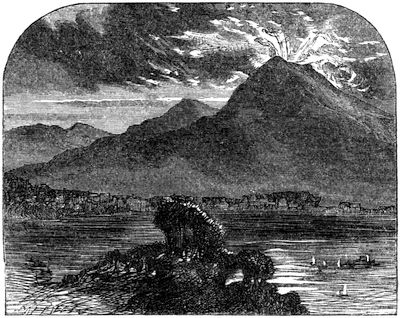
But the contraction of the interior mass of the earth still continues, and the cavities left by the expulsion of volcanic matters, and the pushing-up of the mountains, may not all have been compensated for by the sinking-in of the strata, so it remains a matter of doubt whether the crust of the earth is sufficiently strong to bear the pressure of its own and the air's gravity, or whether at some future day another contraction will break it up and destroy the whole existing order of things. The shocks of earthquakes are strictly analogous to such catastrophes, but on an immensely inferior scale.
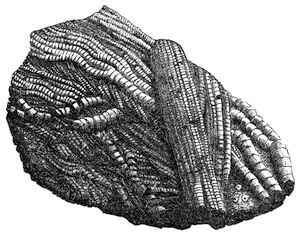
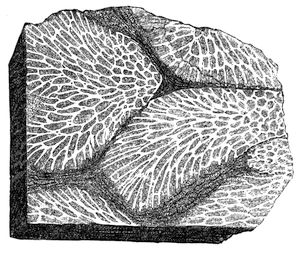
The effects of the last great contraction having subsided the surface of the earth assumed a new arrangement of its matter, and the order of things which caused the deposition of the secondary strata commenced. Sedimentary sandstones were deposited from the washings of the surface by the waters which had not yet absorbed all the superfluous [Pg 64] carbonic acid of the air, but continued to do so, and as fast as it became absorbed and saturated with the calcareous matter of the soil, swarms of coral-polypi, which were then formed, began to build their habitations in the warm waters of the ocean and rob them of the carbonate of lime which they contained, leaving them capable of absorbing more from [Pg 65] the atmosphere. These little creatures formed immense masses of coral, and together with the "Encrinites" (having stony frameworks, figs. 15 and 16), were the chief artificers of that age, and well did they show what perseverance was able to accomplish, for through the thousands of years of quiet which now succeeded, they must have filled up nearly all the existing oceans with their structures, causing the water gradually to flow from its former beds into other situations, and thus from time to time was changed the position of both sea and land. The strata of mountain limestone which now exist are the remains of what these little polypi then produced, for there is scarcely a portion of this kind of rock, but shows evidences of having been, once, coral, madrapore, or some analogous structure (fig. 17). This mountain limestone sometimes occurs thousands of feet thick, and extends over vast districts both in Europe and America.
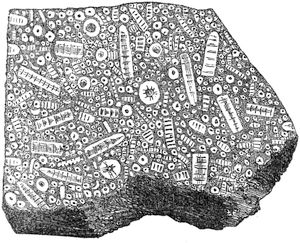
During this period, although there were no great disturbances, capable of displacing the strata, yet there appears to have been frequent small eruptions of volcanic matter through the crevices of the lower strata, filling up all their cracks and vacuities, and in many cases rising to the surface, overflowing with basalt, toadstone, and other [Pg 66] volcanic formations; in other cases rising in enormous quantities through openings at the bottom of the seas, partly filling these up, driving off the waters, and thus covering many of the coral formations with coatings of sand to a great thickness, raising up others into considerable elevations, and forming hills and fresh tracts of earth.
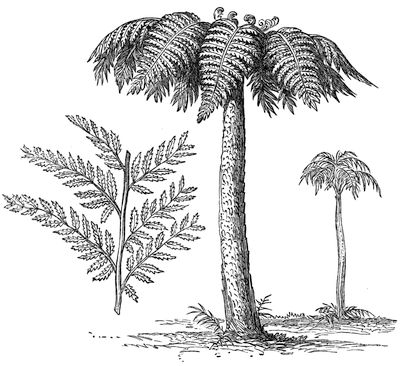
During this long period of comparative quiet most of the irregularities on the surface of the earth became worn down, and extensive swamps were produced by partial evaporation of the inland lakes. These swamps were subject to occasional inroads of the sea, and at times formed shallow lakes or lagoons; in these grew the most luxuriant vegetation, gigantic pines, tree-ferns (fig. 18), equisetacæ, &c. These plants, nurtured by a hot and moist climate, acquired a great luxuriance of growth, and must have formed forests of such [Pg 67] great density, that there is nothing existing at the present time worthy to be compared with them, even in the hottest climates. Such fertility appears to have been dependent upon the conditions of the air and earth, the former containing more carbonic acid (the food of vegetables) and the latter a greater amount of warmth, than at present; these two circumstances, so favourable to the growth of plants, were equally unfavourable to the existence of air-breathing animals, to whom the carbonic acid would be fatal poison.
Thus, in the mighty hands of God, the air was undergoing a gradual purification, to fit it for the animals He intended to create; the polypi were extracting from the water all the carbonate of lime it was absorbing from the air and earth, and fixing it in the soil, to be of use in a hundred ways at some future time, while the vegetation growing in abundance extracted it from the air, and fixed its carbon in their leaves and substance generally; these vegetables, decaying and falling upon the surface of the earth, accumulated there for ages, and formed a carbonaceous matter which was afterwards changed by time and pressure into coal. The same thing (on a very much smaller scale) is taking place in the tropical forests of the present age; there the surface-soil is quite black, and consists of nothing but decayed leaves and wood for several feet in depth, but in the present time there are hosts of insects, every one of which feeds upon this vegetable matter, preventing to a great extent its accumulation, while in the former age there was nothing to destroy it when once deposited on the ground; so that the carbon of these forests of the secondary period, existing through perhaps tens of thousands of years, extracted from the air a sufficient quantity of vegetable carbonaceous matter to produce thick seams of coal, even when compressed by the superincumbent strata. These forests were subject from time to time to inroads of the sea produced by the before-mentioned causes, and thus it is found that the seams of coal are often buried by several hundred feet of sand, clay, shale, &c., above which the same growth recommenced to form a second strata of coal, and ages must have elapsed whilst each of the numerous seams which interstratify the [Pg 68] "coal measures" were forming. This coal, preserved in the depths of the earth, now forms the greatest treasure of the mine, and ironstone (from which iron is procured) would be almost useless but for the occurrence of these two minerals together with limestone (used as a flux) in the same locality, and it is this fortunate circumstance which enables England to produce such vast quantities of iron at such a cheap rate. The quantity of coal consumed in the iron-smelting works and for fuel generally, is beyond what could have been imagined a generation or two back, being somewhere about 50,000,000 tons annually, the coal brought to London alone in 1856 being 1,271,800 tons, yet there is such a plentiful supply of this valuable fuel in Great Britain alone that, supposing the annual consumption to rise to 70,000,000, it would serve (according to computation) a thousand years. Who shall say from whence fuel will then be obtained? probably from some other source provided by the foreknowledge of God, as was shown in the formation of the coal itself; for who could have imagined, a thousand years ago, when England possessed such immense forests, and wood was the universal fuel, that this very wood would become too scarce and valuable to be used, and that a substitute would be dug out of the earth!
The coal-shales (thin layers of claystone found in the coal seams) furnish beautiful specimens of ferns and other plants turned into coal (fig. 19), or leaving their perfect impressions in the clay. The coal formation occurred during the latter part of one of those long eras of tranquillity which supervened upon the contraction and breaking-up of the older strata; but the laws of nature are immutable, and these days of comparative quiet again came to a close. The same phenomena before described again occurred, and there is hardly a square mile of these strata but shows evidences of the terrible convulsion which desolated the earth. Some of the strata were raised, others depressed, and some lost altogether, the cracks and flaws being filled with liquid lava or basalt, which in many cases rose upwards through them and overflowed the surface. Many of the cracks of this, the "carboniferous system," are filled with sulphuret of lead [Pg 69] called "galena," the ore from which all the lead of commerce is obtained; it is not well known how the veins of this and similar substances got into these crevices, but it is probable they were injected in a fluid state by some unequal pressure on the liquid beneath, or deposited by electrical action.
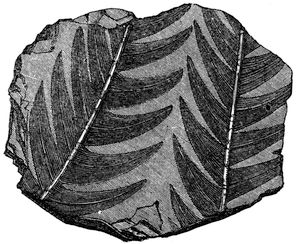
The great world of vegetation was thus destroyed, giving place to new forms of animal and vegetable life. The temperature, all this while sinking, had reached a degree somewhat resembling the hottest regions of the earth at the present day. The waters had changed their localities, new mountains and new continents had made their appearance, and again did the ever-active waters begin to demolish and wear down the asperities of the surface and deposit the results upon the strata below in the form of the new red sandstone and magnesian limestone, the former containing iron in great abundance, and the latter magnesia (an earth not met with before), both of which substances were probably ejected as volcanic products and afterwards combined with the carbonic acid of the air.
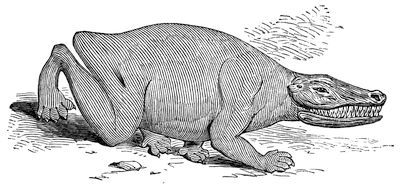
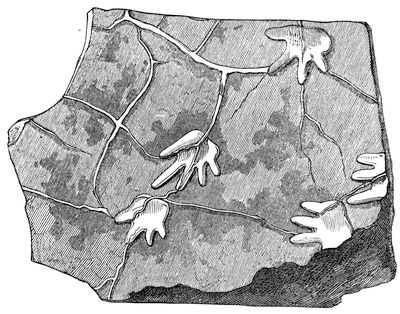
During the formation of these strata there appears to have been both birds and quadrupeds of many kinds, together with a reptile much resembling a frog, but of great size, being [Pg 70] five or six feet long, called the "Labyrinthodon" (fig. 20). The oxide of iron, or some other agent appears to have prevented the fossilisation of the inhabitants of these strata, for but few of their organic remains have been preserved; but very curious evidences of their existence nevertheless remain, [Pg 71] in the impressions of their feet upon the ground they trod (fig. 21), which appears to have been a moist clay or mud peculiarly adapted to receive impressions, and which having been in many places covered over with a stratum of fine sand, and then abandoned by the sea, the whole have hardened into stone, and being now separated, the one contains their footprints and the other perfect casts of them! Nor are these foot-marks all that these sandstones have to tell us of their day; for the ripples of the waves, and even the little pits made by drops of rain as they fell, are in this most marvellous manner preserved, forming objects of wonder and admiration for us mortals to contemplate, and themes whereon the devout mind may pour out its tribute of praise to their Great Author. How evident it is that the Creator designed beforehand that we should search for these hidden evidences of His handiwork, or for what purpose were they thus stored up and preserved? "Seek, and ye shall find, knock, and it shall be opened unto you," are the words of God, and they apply as fully to the material wonders of His works as to the mysteries of His revealed Word.
As the strata below the new sandstone formation was called the "Carboniferous" system, from its containing much carbon in the form both of coal and carbonic acid, so this has been called the "Saliferous" system, from the occurrence in many places of strata of "rock-salt" or crystallised chloride of sodium, and (where the rain finds its way down and dissolves it) of brine springs; these (in England) exist chiefly in Cheshire and Warwickshire, but in Poland and Hungary they exist on a much larger scale, the rock-salt being nearly a thousand feet thick. It has been said that these strata of salt were formed by the evaporation of salt lakes, but it is much more probable that salt is one of the natural materials of the earth, and that both salt lakes and oceans have become salt from dissolving out these strata wherever they have come into contact. The next sediment deposited over the new red sandstone is called the "Lias," a sort of limestone mixed with clay of a blueish-grey colour, and upon this lias is again deposited the various strata known as the "Oolite" (Roe-stone) system, from its appearance resembling [Pg 72] the roe of a fish, it consists of small rounded particles of limestone set in a cement of the same substance worn down fine.
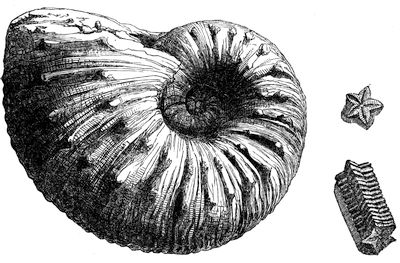
These strata furnish a great many organic remains, especially the shells of the conchiferous mollusca and cephalopods, as Ammonites (fig. 22), Belemnites, Nautili, and Pentacrinites (fig. 23), of which a great many varieties are found, also the remains of gigantic reptiles, as the Ichthyosaurus (fig. 24), Plesiosaurus (fig. 25), and others. New forms of animal existence seem to have been created in this period in great abundance, and the waters of the earth once again became the theatre of deposition for the shells and polypidomes of zoophytes and molluscs, which swarmed them in myriads, and another great group of rocks began to be formed, namely, the chalk or "Cretaceous" system, which form the cliffs and downs of our south coasts, and strata of great extent in nearly every part of the world; it differs from limestone only in not being so hard, which is supposed to arise from its not having undergone the changes caused by heat and pressure.
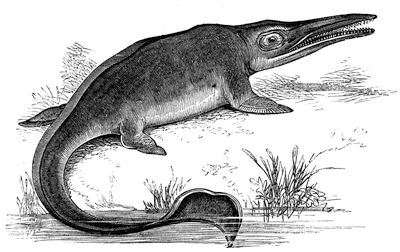
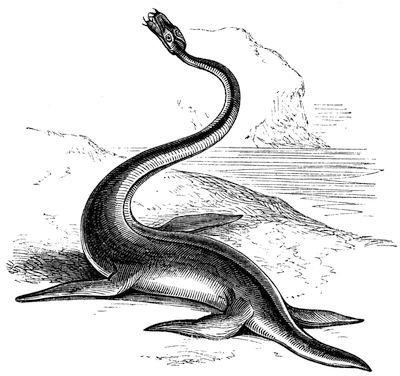

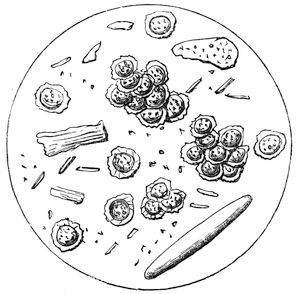
The chalk is interstratifìed with lines of sand, and the lower part is almost entirely sandy, forming the gault and greensand deposits; these each contain organic remains, [Pg 74] and must have been the original sand of the sea-bottom before the chalk was deposited on it. These seas must have been the residence of a vast number of reptiles, for the gault contains an enormous number of nodules of what appears to be stone, but which upon closer examination, prove to be coprolites, or portions of the excrement of those creatures partly fossilised, but still retaining phosphate of lime enough to render them valuable manure, and these—like the coal—after being buried in the earth for thousands of years, are [Pg 75] now being brought into use. In these coprolites may be constantly seen the teeth and bones of fishes, together with portions of echini and crustaceans, which had passed through the intestines of these saurian reptiles. Fig. 26 is the shell of a small nautilus (Nautilus inequalis) thus found.
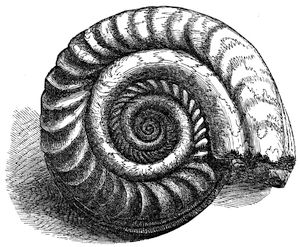
This chalk is of a white colour, very light and porous; under the higher powers of the microscope, it appears to be made up of organic forms, as "Foraminifera," and portions of various kinds of shells, crushed and broken into minute fragments (fig. 27). Dr. Carpenter, in his work on the microscope, says: "Many parts of it (the chalk) consist in a great measure of the minuter parts of the smaller kinds of Foraminifera, whose shells are imbedded in a mass of apparently amorphous particles, many of which nevertheless present indications of being the worn fragments of similar shells, or of larger calcareous organisms. In the chalk of some localities, Foraminifera constitute the principal part of the minute organisms which can be recognised with the microscope; in other instances the disintegrated prisms of Pinnæ, or other large shells of the like structure (as Inoceramus), constitute the great bulk." The [Pg 76] fossil remains in the chalk are very numerous and are all of a marine character, the ammonites (fig. 28), belemnites, and other cephalopods, were very prevalent, as were the various Echinodermata, as the Hemicidarus intermedia (fig. 29), together with numerous univalve and bivalve mollusca, various crustacea, fish and reptiles. There was some considerable wonderment a few years ago expressed at the skeletons of men being found in the chalk at Guadaloupe; but it has been ascertained that this chalk is a modern formation, being produced by the sea washing and disintegrating the adjacent coral reefs, and depositing a fine white sediment of broken coral on the shore which can hardly be distinguished from ancient chalk; the same process is taking place at the Bermudas and other islands of the West Indies.
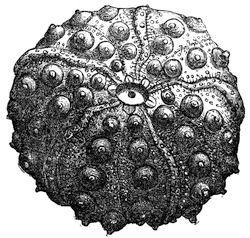
In many places the chalk strata contain single lines of flints, running for miles parallel to the layers of chalk; these flints consist of almost pure silica, and it has been a matter of wonder how they got there, but on considering how slowly the deposition of chalk must have taken place, from the formation and death of millions of minute creatures, and that it was once the bottom of a deep sea, the disposition of [Pg 77] the flints in lines would be accounted for, supposing them to have been formed on that sea-bottom, and the source from which they have been derived is doubtless the petrifaction of sponges, madrapores, &c., there formed. Dr. Carpenter (in the work before referred to) says: "It may be stated, as a fact beyond all question, that nodular flint and other analogous concretions (such as agates) may generally be considered as fossilised sponges or alcyonian zoophytes, since not only are their external forms and their superficial markings often highly characteristic of those organisms, but when sections of them are made sufficiently thin to be transparent, a spongy texture may be most distinctly recognised in their interior."

During the deposition of these secondary strata in the hollows of the surface, but little alteration of the relative situations of sea and land could have taken place, as the deposits for the most part lie conformably to the same hollows or "basins" (fig. 30 will illustrate this); but after the deposition of these strata, there appears to have been a very great disturbance, many chains of mountains were cast up (as the Apennines), carrying upwards with them these deposits; some of the strata were so displaced that they were left in a perpendicular position, as may be seen in several places at the south side of the Isle of Wight. These disturbances, however, did not amount to so general a convulsion as those before described, nor is it known whether all the effects produced on these strata took place at or near the same period of time; they nevertheless appear to have produced an almost total change in the situation of the land and sea, for the "downs" of chalk (on the southern coast of England, for example) were, before these changes, the beds [Pg 78] of seas. This is the last of the great convulsions which the earth has undergone, for the tertiary strata which afterwards began to be deposited rest in the hollows or basins (chiefly in the chalk) then left; the alterations in and since these deposits appear to consist chiefly of the upheaval of certain localities, the depression of others, the evaporation of inland lakes, and the wear and tear of the land from these causes, which are still in continuous action (as from the washing down of cliffs by the sea, and the formation of mud deposits at the mouths of rivers), or the volcanic agencies which in some places (as in Ireland) have cast up basalt over the chalk.
The tertiary strata contain remains of most of the classes of animals now in existence, but yet differing greatly in species, and as the strata approach the surface those species become more and more general; the plants also approach more nearly to those of the present time, but still most parts of Europe possessed a climate almost tropical. The tertiary strata consist chiefly of marine and fresh water deposits in the form of sands and clays, as the "London clay," which extends under London, resting upon a basin of chalk. The last deposits, forming the superficial layer of earth, and the formation last deposited before the creation of man, are called the Diluvium and Alluvium, and contain numerous remains of mammalia, birds, reptiles, and fishes. One of the most extraordinary animals of this period was the Dinotherium, a sort of walrus, which is supposed to have been the largest of quadrupeds, if indeed it was one (fig. 31). The quadrupeds of this, the "Pliocene" formation, are thus described by Professor Owen in his "History of British Fossil Mammals."
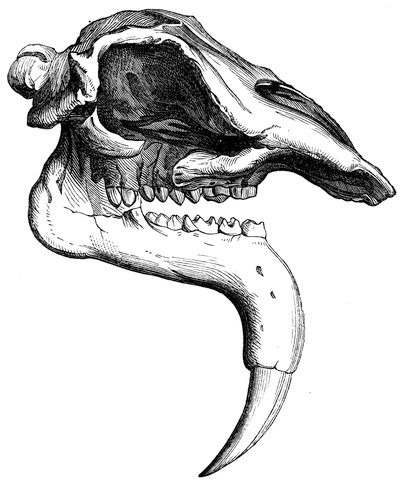
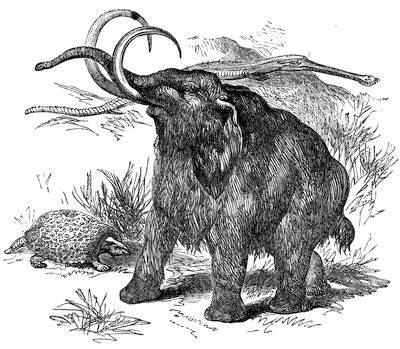
"At the period indicated by these superficial stratified and unstratified deposits the Mastodon had probably disappeared from England, but gigantic elephants (fig. 32), nearly twice the bulk of the largest individuals that now exist in Ceylon and Africa, roamed here in herds, if one may judge from the abundance of their remains. Two horned rhinoceros, of at least two species, forced their way through the ancient forests or wallowed in the swamps. The lakes and rivers were tenanted by hippopotami, as bulky and with as for [Pg 79]midable tusks as those of Africa. Three kinds of wild oxen, two of which were of colossal size and strength, and one of them maned and villous like the bonassus, found subsistence on the plains. Deer as gigantic, in proportion to existing species, were the contemporaries of the old Uri and Bisontes, and may have disputed with them the pasturage of that ancient land. One of these extinct deer is well known as the Irish elk, by the enormous expanse of its broad-palmed antlers (fig. 33). Another herd proves more like those of the wapiti, but surpassed that great Canadian deer in bulk. A third extinct species more resembled the Indian Hippelaphus, and with these were associated the red-deer, [Pg 80] the rein-deer, the roebuck, and the goat. A wild horse, a wild ass or quagga, and the wild boar, entered also into the series of British pliocene hoofed animals. The carnivora, organised to enjoy a life of rapine at the expense of the vegetable feeders, to restrain their undue increase and abridge the pangs of the maimed and sickly, were duly adjusted in size and ferocity to the fell task assigned them in the organic economy of the pre-adamite world. Besides a British tiger, of larger size and with proportionately longer paws than that of Bengal, there existed a stronger feline animal (Machairodus) of equal size, which from the great length and sharpness of its sabre-shaped canines, was probably the most ferocious and destructive of its peculiarly carnivorous family. Of the smaller felines, we recognise the remains of a leopard, a large lynx, and of a wild cat. Troops of hyenas, [Pg 81] larger than the Crocuta of South Africa, which they most resembled, craunched the bones of the carcases relinquished by the nobler beasts of prey, and doubtless often themselves waged the war of destruction on the feebler quadrupeds.
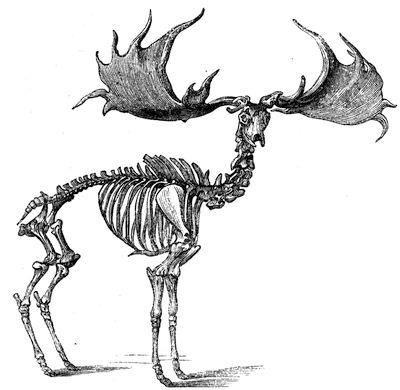
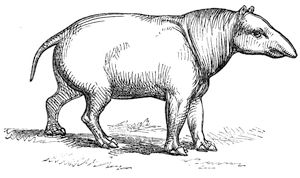
"A savage bear, surpassing the Ursus ferox of the Rocky Mountains, found its hiding-place, like the hyæna, in many of the existing limestone caverns of England. With the Ursus spœlus was associated another bear, more like the common European species, but larger than the present individuals of the Ursus Arctas. Wolves and foxes, the badger, the otter, the foumart, and the stoat, complete the category of known pliocene carnivora of Britain."
In the time of these the last of the tertiary strata, there appear evidences of a degree of cold much greater than at present exists; this seems to be pretty well proved by the "boulder formation," or prevalence of erratic blocks of stone, the progress of which have been traced from their sources of origin to hundreds of miles distant, and there is no conceivable power which could have carried them but the floating fields of ice or glaciers; both of these sources are capable of this removal, for it is not uncommon to find large pieces of rock and layers of gravel floating on masses of ice. Glaciers are formed by the snow on the sides of mountains becoming hardened by being partially melted and again frozen, and at every melting the fluid tends to descend, when it again becomes frozen, always adding to the lower part and carrying away from the upper. In this way whole glaciers of many miles extent become unfixed, and as fresh snows are added to their upper parts, they descend slowly, entangling with them and tearing away the rocks in their vicinity. When they arrive at the sea and float forth, these rocks are borne with them.
But there are as yet no traces of man, not one small fragment of his skeleton, not one minute relic of his constructive powers, although the bones of man are as capable of preservation as those of any other animal, being the same in structure and composition; the remains of hundreds of fragile insects, seeds, leaves, and all sorts of organic structures, are found perfectly preserved (fig. 34). The only way, therefore, of accounting for the absence of any organic remains of man, is the assumption that he was not then created; and this is confirmed by the fact that in the very uppermost layers of the earth's surface his bones and the [Pg 83] works of his hands are found in great abundance; it is therefore with good reason that we come to the conclusion, that he was the last creature formed by his Maker. That the creation of man was pre-intended by God, seems also almost proved by the numerous objects before created, capable of ministering to his use and happiness—capable of exercising his constructive and inquiring capabilities—suitable to his imagination and tastes, and his only, and which would serve no purpose of utility to the mere brutes. Of what use, to any creature but man, is coal—of what use the metals? Of what avail is it to any of the lower animals, that God has caused glass and other transparent substances to have the power of refracting the rays of light? but without which not one-half of our knowledge of His wondrous works would ever have been obtained, for it is upon this property alone that the powers of the telescope and microscope depend. Of what use to any but man are fire, artificial light, and galvanism? and yet all these were created long before man was.
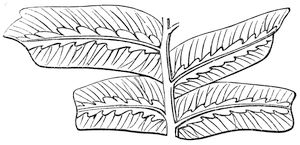
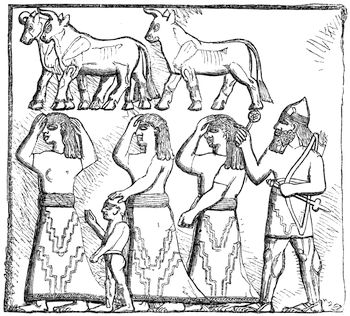
It has often been asked, What does man gain by the study of the sciences? Besides the enlarged views which they give him of his Creator's goodness and power, they at this time are fast reaching towards the demonstration of many obscure passages of His Holy Word as revealed to us in the Scriptures. The study of truth can moreover never lead one into error, and a habit of drawing correct conclusions from the facts presented is useful to every one. Geology has confirmed one great truth in Scripture, and overthrown the greatest [Pg 84] groundwork of Deism, for it had been asserted by many that man (and indeed all other creatures) had risen to his present state by slow developments, and no proof to the contrary had ever been given. But geology has shown that at a certain era man was created, that (as is stated in Scripture) he was the last of God's works, and that neither before that time had he existed in an undeveloped form, nor since has he altered one jot from his original configuration; and the same may be said of all other creatures, whatever may be pretended to the contrary, for from the sculptures brought from the ruins of Nineveh (at least 3000 years old), there appears the same external form (fig. 35), both of man and what animals are there depicted, and his and their habits were described by the very earliest writers to be then as now. But with respect to the form of the earth's surface it is otherwise, there being a slow but continuous change. Those parts of the land exposed to the tides and action of the waves, are washed away, and the rivers are constantly bringing down soil to deposit it at their mouths, forming [Pg 85] those tracts of land known as "deltas;" every wind that blows takes away some dust from the higher and deposits it on the lower parts of the earth's surface, so that, to use the words of the Prophet Isaiah, "every valley shall be exalted and every mountain and hill shall be made low." But this alteration is so slow that it takes hundreds of years to make but a small difference, yet a difference there undoubtedly is, and a time must come when the alteration will be such as has been shown to have taken place in far-back times and recorded in the strata in evident language, for though the changes are slow the result is inevitable. It has been ascertained that the northern part of Sweden has been steadily rising and the southern part sinking to a corresponding degree for many centuries past, and that the west coast of Italy has been elevated for ages past, at the rate of not quite an inch yearly. Volcanic actions are raising some lands and depressing others (in the earthquakes of 1822 and 1835, the whole of Chili from the Andes to the sea, and probably the bed of the sea to an unknown extent, was elevated considerably), rain and the rivers carry away land into the sea, the beds of many seas are being filled up by coral polypes and protophytes, so that the beds of these seas must ultimately be the land whilst the lower parts of the land will become sea.
After these various changes upon the surface of the earth, from a climate hot beyond anything now existing, from a surface rocky and full of fissures and inequalities, studded with islands and continents, abounding in marshes and swamps—from a state of atmosphere in which the higher animals could not live—to the present division and separation of land and water, of oceans and seas, of islands and continents, well supplied with rivers to drain off the superfluous fluid and supply highways easy to traverse in boat or canoe, the world remains, a fitting habitation for the creatures God has placed upon it on every hand. Forests to shelter the wild animals from the rains and heat of the sun; waters for those who dwell or delight in them; metals, stone, earth, and wood for man to exercise his ingenuity upon, and other innumerable things contributing [Pg 86] to his comfort or luxury—all freely given by the hand of his Heavenly Father for his well-being and delight, that he may lack no excuse to worship and adore Him, and this delightful earth, as Milton says:—
After all these various elevations and depressions, the land remains at this present time in the form of large tracts occupying about a third of the superficial area of our globe. The largest tract is made up of Europe, Asia, and Africa, which constitute one continuous area, Africa being almost severed from the others, but still united by the Isthmus of Suez; the tract next in size to this is made up of North and South America, these again are nearly severed, but still united by the Isthmus of Panama or Darien; next come Australia and Greenland, but these, although very large, are yet not to be compared in size with the former two; there are numerous other large islands, as Borneo, New Guinea, New Zealand, Madagascar, Iceland, England, Ireland, &c., and scores of smaller ones.
The temperature of the earth (as a general rule) is greatest on the equator and diminishes gradually towards each pole, but this is by no means invariable, for two places of the same latitude may be very different in climate, and a system of lines passing round the earth from east to west, [Pg 87] would each pass through regions of various temperatures, or what is the same thing, lines made to follow the same temperature would have to make various curves and contortions; such lines have been constructed and are called "isothermal" lines. The causes of this are to be found in the various currents of the ocean, the tides and winds, and in the proximity to the ocean of snow-clad mountains and arid plains. The variation of latitude in these lines sometimes reaches as much as seven degrees.
Europe contains about 3,900,000 square miles of surface, and is separated from Asia by the Caucasus, Caspian Sea, River Ural, and Uralian Mountains. It is about 3000 miles long and 2400 broad, about two-thirds being plain and table-land and one-third mountain land. The chief mountain ranges are those which run through Norway and Sweden in a north-westerly direction, and the mountain system along the south part from Portugal to Turkey. This last includes the Pyrenees, which runs from the Bay of Biscay to the Mediterranean, the highest peak of which is Mont Maladeta (11,500 feet); the Alps, the highest point of which is Mont Blanc (15,748 feet); the Apennines, the highest point of which is Mont Viso (12,586 feet); the Carpathian Mountains, extending from Presburg in Hungary towards the sources of the Waag and March, the highest point being Mont Lemnitz (7962 feet); and the Balkan range, which may be considered a continuation of the Alps eastward, runs as far as the Black Sea, together with many inferior ranges and branches.
The climate of Europe embraces a range from the temperate to extreme cold. It is bounded by the Arctic Ocean on the north, Asia eastward, the Mediterranean Sea southward, and the Atlantic Ocean to the westward; it contains two great inland seas, the Black Sea and the Caspian Sea. There are three great volcanoes in Europe, Hecla, Vesuvius, and Etna, but the plains of Auvergne contain many which are extinct.
Asia contains the highest mountains and the most extensive table-lands in the world. It is somewhat square, being bounded northwards by the Arctic Ocean, westward by [Pg 88] Europe, southward by the Indian Ocean, and eastward by the North Pacific, and contains about 17,500,000 square miles; the greater part is made up of two extensive tracts of elevated land called table-lands, although these are often varied by valleys and mountain chains of great extent, yet as a whole, they are from 5000 to 10,000 feet above the level of the sea. The eastern table-land is that of Thibet and the Great Desert Gobi, and the western that of Persia.
Asia contains many great mountain chains, the chief of which are the Himalaya Mountains, which run along the centre of its southern part and contain some of the highest peaks in the world; the Dhawalagiri is 28,072 feet high, but there are some others supposed to be as high.
The Altai or Gold Mountains, forming a boundary to the lowlands of Siberia, the highest peak of which is called the Katunia Pillars, and is 11,000 feet high.
The Thain-schan or Celestial Mountains, the Kuen Lun, and the Hindoo Coosh, all of which run pretty nearly east and west, while the ranges called Uralian, Bolor, Khingan, and Chinese chains run nearly north and south.
Africa is somewhat triangular, with its base towards Asia and its apex pointing southward. It is bounded northwards by the Mediterranean Sea, and at its east side by the Red Sea and Indian Ocean, while the Atlantic flows on its south-west side. In Africa is the largest desert in the world, the Great Desert of Sahara; it occupies nearly all the northern part, the southern has but few mountains of great extent, but from their elevation and the amount of waters brought down by rivers, it is supposed that the centre has very high table lands. At the north-western part is an extensive mountain system (the Atlas) covering with its branches nearly 500,000 square miles, and sending its slopes to bound the great Desert northwards.
The great tract of land comprising North and South America extends in a longitudinal direction pretty nearly north and south through 130 degrees of latitude, or nearly 8000 miles. This great tract is divided by a narrow neck of land (the Isthmus of Panama) into two pretty equal portions; the northern part is peculiar, from containing [Pg 89] a number of lakes of immense extent, deserving well the name of inland seas, and both northern and southern divisions for the great number and extent of their water-courses. The whole of this great tract of land is traversed from end to end by an extensive chain of mountains, the longest in the world; at its southern part it forms the Andes, from which a range is continued through the Isthmus, and onwards to form the Rocky Mountains. In the southern division this immense chain passes on the west side of the land close to the sea, is of great elevation in some parts, has some of the highest mountain peaks in the world, and volcanoes also, the highest being in the Andes (Popocatapetl is about 16,000 feet high); but from the western side of the continent the land descends gradually to the eastern. In South America are some of the highest table-lands known, great elevated tracts in connection with the mountain ranges.
Australia in its interior is but little known, but the whole aspect of the island appears to be flat, and to have but little elevation, while Greenland and the great tracts of the northern regions beyond, deserve more the name of glaciers, being almost entirely a mass of barren rocks and snow.
The water-courses of these various great tracts of land are all determined by the formation of the surface, but the amount of water which is carried into the oceans by the rivers of any district is always in proportion to the amount of vegetation in that district; thus in Europe, Asia, and America, the number and extent of these correspond with the great fertility of the soil, while the northern and western part of Africa—the Great Desert—give off scarcely any of adequate extent, the Nile appearing to receive its supply from the central parts further south. The reason of it is this: wherever there is vegetation, either in the form of grassy prairies or forests, there is also a great reduction of temperature from the radiation and evaporation, and the consequent formation of rain, dew, or snow, which falling on the ground produces streams, &c.
Excepting the great tracts of land named, and islands too numerous to be mentioned, the whole surface of the earth is [Pg 90] covered with water, the great divisions of which (called Oceans) are, the Arctic Ocean, to the north of Europe, the Atlantic, between America, Europe, and Africa, the Pacific between Asia and America, and the Indian Ocean between Africa and Australia.
The foregoing is a very bare outline of the land and water covering the surface; it may suffice, however, to call to mind the main features of the earth as it is now disposed. There can be little doubt that the great variety of climate, whether hot or cold, moist or dry, is one of the greatest sources of happiness that can be well imagined; it stimulates to research, travel, and inquiry into the works of God; every change experienced tends to make man search for further change, every new scene makes him compare it with others; and the acquirement of a knowledge of places, and a general idea of the whole world, expands his mind, enables him to appreciate the good gifts he has received, and affords a source of satisfaction beyond almost any other kind of enjoyment.
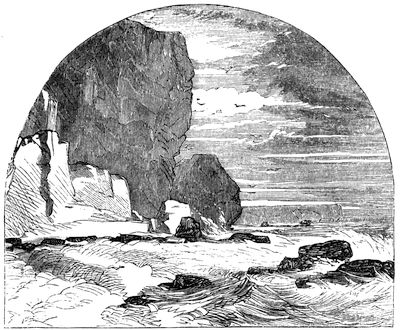
How grand is the ever-moving ocean! how majestic its voice, how terrible its anger! how beautiful every colour that is reflected from its dancing spray, and how balmy the air which is wafted from its bosom to refresh the heated earth, which, under the glare of a summer's sun, seems parched with thirst. How refreshing to the senses is the change from the dry heated grass on a midsummer day—from the dusty roads—from the smoke begrimed town, smelling of dirt, and heated by the reflection of the sun's rays from bricks and stones till it becomes a furnace—from the [Pg 92] close dark habitations of the city—from the rattle, excitement, and continual noise of vehicles and human voices—from the corroding cares and depressing influences attending the fierce "battle of life"—to the cool and gentle breeze, "the wide o'er-arching canopy of heaven," the murmur and ripple of the sea, to the clear and exhilarating air, free from soot and laden with the odour of the ocean.—Oh what a desirable change! all human nature seems to own it, and hasten to the shores of the great watery world, that they may contemplate one of the greatest and grandest of God's works with admiration and thankfulness, and be re-animated by its health-giving powers.
It is a wonderful sight, and one which fills our minds with reflection; here we see many of the laws of nature exemplified on a great scale. The laws of gravity keep the surface of the ocean perfectly spherical as a whole, while those of equilibrium keep it in constant and ever-varying motion, the laws of attraction produce the tides, and those of reflection and refraction cause its surface to assume all sorts of colours and tints.
The ocean is full of life, both vegetative and animal; myriads of both classes have their natural habitation in the sea, and the shore is often, after a gale, strewed with curiosities well worth the contemplation of those who devote their minds to thought. How many varieties of sea-weed have you gathered? perhaps twenty; not three of them are sea-weed at all! they are living animals, either zoophytes or molluscs, every branch of that "flustra" contains a thousand living beings, every spray of "sertularia" as many more, that other piece is the "bugula neretina" and also owns a colony of animals: the next is indeed a member of the vegetable kingdom, its beautiful crimson colour makes it a conspicuous object, and there are many specimens of the same plant, but of all shades of red, crimson, and purple, it [Pg 93] is the "plocamium coccineum." And thus it is with every object we view, a knowledge of it brings us to respect and admire it more and more as that knowledge increases, and none more so than some of the productions of the sea. It is here we find specimens of the star-fish, the sea-urchin, and other radiata. Shells of all kinds—both living and dead—belonging to the various tribes of mollusca; crabs, shrimps, and other crustaceans, besides the endless varieties of pebbles and other specimens of worn-down rock, the effects of constant attrition.
If we turn from the shore and gaze upon the horizon, what a marvellous object it is—ever receding as we recede, ever rising as we rise, and never nearer nor farther away. This rising of the horizon, so as to be always opposite to our eyes, is because the higher we are up the more we see. On looking at the horizon we do not look on a perfect level, (if we did, being above it, of course we could not see it at all) but the depression of the line of vision is so slight as to be quite unable to be appreciated; yet, small as it is, it enables us to see a considerable space of the ocean, and the higher we rise—at the same angle—the more we see. The edge of the horizon also appears curved, being higher in front of us than on either side. This is only so in appearance, for if any one were to place a piece of string (stretched tightly between the hands) before his eyes, and bring it up till it is on a level with the horizon, he would soon see that the string and the horizon were both perfectly straight and exactly corresponding with each other.
From the horizon we turn round and look at the chalk cliffs, those white walls from which our native isle has received the name of "Albion." How were they produced? by the constant lashing of the restless waters, which are constantly wearing them away; but they are beautiful objects, full of marvels and records of bygone ages, when their tops were at the bottom of the deep seas.
The sea is a general name given to all the greater collections of water throughout the world, although, in a restricted sense, it is applied to those tracts of water of a secondary size, as the Black Sea, the Baltic, and the Mediterranean, [Pg 94] the term "ocean" being applied to the larger tracts of water, as the Atlantic Ocean, the Pacific Ocean, &c. All the great oceans and seas unite, and, in reality, form one great world of waters, spread out and covering all the lower parts of the earth, the term "lake" being applied to collections of water surrounded by land, although the Caspian Sea retains the name of sea, and some of the great lakes of America may well deserve such a name.
The waters of the sea fill up all the lower parts of the earth, so that, almost without exception, the land is higher than the water, and as the land in some places rises but a few feet, and in others as many thousands, so, beneath the sea, the land sinks in many places but a few feet, and in others perhaps as many thousands as it is known to rise above it. The sea always maintains the same general level, although in past ages the land has risen and fallen, sometimes in one place and sometimes in another; indeed, the same process is taking place every day, but in so slow a manner that centuries are required to make any great alteration; while some tracts of land are being encroached on by the action of the waves, others are being added to and elevated by accumulations of mud and sand, or raised by the action of earthquakes and volcanoes, which throw up under the sea, as well as on the land, vast quantities of melted earth or lava, forming strata known to geologists as basalt, tufa, &c., or eject showers of ashes and dust in such prodigious quantities as to cover many hundred square miles of the earth's surface. It was by one of these showers of ashes from Vesuvius that the cities of Herculaneum and Pompeii were buried. So that, as a whole, although the sea is continually altering slowly its position, yet it pretty equally maintains the same elevation. At first thought it may be supposed that the rivers constantly flowing into the sea would alter its level, for some are so large that millions of tons of water are brought by them into the sea every hour, and there are thousands of rivers and rills which, night and day, pour in their tribute of waters; but God has wisely and kindly arranged these things (like all others) so that they shall afford us innumerable [Pg 95] comforts, and yet not raise up the sea so that it shall cover the land, for it requires but a moment's consideration to be convinced that all this water which flows into the sea must first have been abstracted from it, and it is in this way—when the winds blow over the sea, they absorb or take up a certain quantity of the vapour which continually rises from it; for air absorbs a certain quantity, and a certain quantity only, of the vapour of water; but this quantity is determined by certain circumstances, for instance, the warmer the air, the more it will absorb, the less the pressure on the air, the more it will absorb, and the drier the air, the more it will absorb, that is, the less moisture it has already got, the more will be required to make up that quantity which the other circumstances permit it to contain. Now, what takes place if a warm, dry, light current of wind blows over the sea, landward? Why, all the vapour given off by the sea, to the amount of millions of gallons, is absorbed and carried inland by the wind or current of the air, and this continues onward, laden with moisture, until it meets with one of the several circumstances which shall cause it to be incapable of holding the quantity of moisture which it has already got; for instance, it meets with another current of air colder than itself, these mingle, the vapour of water is condensed by the cold, and a cloud is formed. This consists of minute particles of water suspended in—not absorbed by—air; these particles gradually collect, and down falls the rain on to the earth. This drains off from the surface, forming rills, which collect as they descend, by their own weight, into the lowest channels of the ground, and form into streams and rivers, and back into the sea comes the water which the air had taken away, with this difference, that it is free from salt and fit for the many uses to which fresh water alone can be applied; when the vapour rises from the sea, none of the saline matters rise with it, for, although the water is volatile, yet they are not, and this is the whole source of fresh water. It is distilled in the great laboratory of Nature, and gives nourishment to all the living beings who dwell on the land and in the rivers and lakes; or the rain may sink into the earth and be carried [Pg 96] for miles and miles under ground, running through some porous stratum, such as gravel, until it flows out in the form of a spring, bubbling up amongst flowers and weeds, and forming the source of some river, which receiving the rain and all the springs in the country through which it flows, finds its way back into the ocean at last.
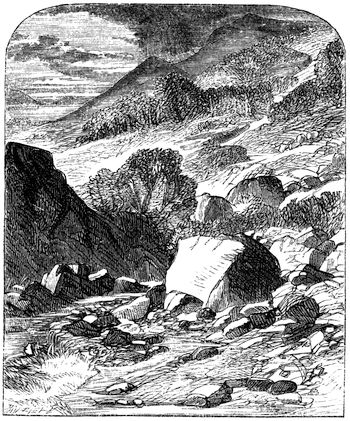
This is the way in which all rivers and streams are formed. An enormous extent of land thus drained gives rise to thousands of rills, which collect into streams of goodly size, meandering through valleys and pouring their tribute of waters into a main stream, which at last accumulates by additions to its course, and becomes one of those great water-courses which form the highway through a continent. The Amazon, Hoang-Ho, Ganges, Nile, Danube, and Volga, may be cited as some of the greatest water- [Pg 97]courses and highways of civilisation. These great rivers are navigable for large ships, even for many hundreds of miles, and it is most fortunate that this navigation is so seldom impeded by falls; for these, although among the grandest and most beautiful objects of nature, yet put a stop to the navigation of a river which would otherwise be passable for hundreds of miles further. Rivers which run through districts subject to periodical rains, or those whose sources lead from mountain slopes where vast quantities of snow are deposited in winter which melts on the approach of summer, are at such seasons of the year suddenly augmented, and generally overflow the banks and inundate the country for miles. This is in many cases a very great misfortune, as it spoils the land, reducing it to a swamp, but not in every case; the overflowing of the Nile brings down with it a great quantity of fertilising vegetable matter, and serves to manure the whole district, for the soil being extremely porous and the heat great, the moisture is soon got rid of, and hence it was a custom of the Egyptians to celebrate the rising of the Nile by feasts and ceremonies.
Lakes are formed in the same way as rivers, but, being surrounded by high land, have no outlet for the waters so that they may flow back into the sea. If a lake were about to be formed it would be in this way—the rain descending on the surrounding high lands would run in rills to the lowest part, and there collect, forming a pool which would gradually increase in size as the water flowed into it, this increase continuing until the surface became so large that the evaporation from it exactly equalled the supply, it would then extend no further, but remain a permanent lake or inland sea, giving off vapour to refresh the surrounding country, and again receiving it back by streams and rivers, as does the ocean.
There is scarcely a spot known on the surface of the earth, which does not show strong evidence of having, at some former period, been the bed or bottom of some sea or lake. Some of these evidences may be seen in the strata or layers of earth forming the sides of the cliffs which abut on the sea-shore, and which could not have been produced by [Pg 98] any other agency; these strata contain so many marine shells and other matters peculiar to the sea, that the fact does not admit of doubt that they were there produced. These same strata are met with throughout the land; in sinking wells and mines, the same strata are cut through, and have a known and uniform succession, with but few exceptions; the cliffs, however, are the most convenient places to see these strata. That the same process of alteration in the position of the water and land is still going forward, is shown by many evidences, such as towns which were once on the sea-shore, being now some distance from it, as the City of Norwich, and in other cases the reverse. The chalk cliffs at Dover, Ramsgate, &c., show the action of the sea in the corroded state they present, and slips or falls of great masses which have been undermined by the sea, are frequently occurring.
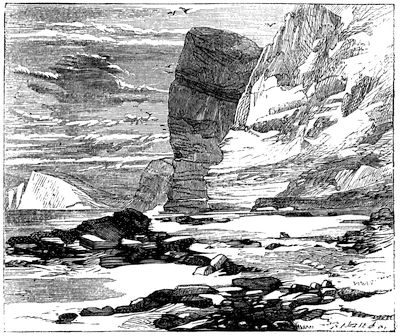
The ancient town of Ravenspurn, at which Henry IV. landed, has entirely disappeared, and others, recorded to have [Pg 99] been situated on the shore, have now only their names left. The parts of the shore most rapidly corroded by the sea, are those composed of sand, chalk, and clay, while those composed of the harder kinds of sandstone or of granite, have been but little wasted away, so that they project and form the headlands, while in many cases deposits of mud have extended them. There are many other causes which determine the elevation or depression of the land, besides the action of the sea and earthquakes, such as winds, frosts, &c.
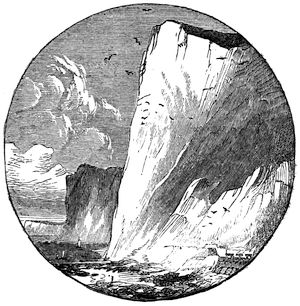
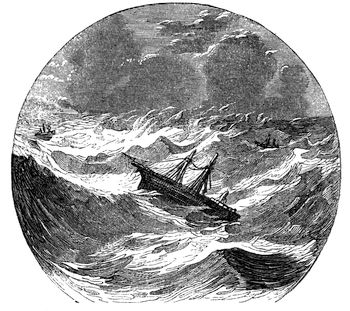
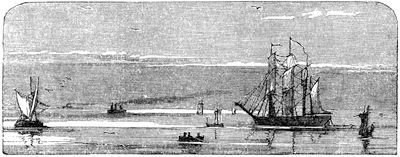
The slightest movement of the air communicates motion to the surface of such a great sheet of water as the sea, and this motion is gradually increased till one ripple meets another, and the power of both goes to form the next, so that they acquire a very considerable size; when a gale of wind blows, the rolling of the waves far out at sea becomes terrific, and they rise like mountains, chasing one another over the wide ocean. But sailors rather like a smart breeze, and more especially did they a few years ago, when the wind [Pg 100] was all they had to depend upon for onward progress. In those days a calm which would sometimes last for weeks together was to them most fearful, for it was often a source of great distress and privation, especially if short of provisions; the sea would then look like a great pool of stagnant water covered on the surface with sea-weed and animalculæ, and fearful it must have been when food was failing, and no hope of progressing but the springing-up of a wind. But, in [Pg 101] these days, with the assistance of steam, a calm is the very time in which most progress is made, and there is no doubt but a time will come when it will be matter of wonder that men could ever have trusted to so uncertain an element as the wind; yet, if it were not for the winds, currents, and tides, the sea could not maintain its state of purity, for its saltness is not sufficient to prevent the growth of fungi and all sorts of animalculæ, which, from their decay, would produce noxious gases and be most injurious to animal life. Its constant motion alone prevents this, and the spores and germs are tossed about until destroyed and eaten up by the inhabitants of the deep who devour every kind of organic matter which is deposited in the sea, and thus it is that the waters of the ocean are so bright and clear that an object can be seen at a considerable depth.
That the constant currents of the sea prevent the formation and growth of sea-weed, is clearly shown by the great "Sargasso Sea," or tract of weed (Fucus natans), called the Gulf-weed. This great tract embraces thousands of square miles, and is situated in the very middle of the Atlantic Ocean, where there are but few currents; but surrounding it is the Gulf-Stream, an enormous current of water running at a regular rate of four or five miles an hour. This Gulf-Stream is supposed to be caused by the same laws and influences which determine the trade-winds, namely, a constant rarefaction of the water at the tropical parts of the earth, and a corresponding condensation at the Arctic portions, for warm water is much lighter than cold, and when the waters of the tropical regions become lighter the heavier waters of the cold regions pressing down more forcibly tend to raise them above their proper level; they therefore flow towards those very parts which have sunk down by their contraction, and a constant current takes place—this current is the Gulf-Stream. It runs from the Gulf of Mexico northwards towards Newfoundland, turning by Iceland towards the British Isles, by France and Spain, onwards to the coasts of Africa and South America, the West Indies, and again to [Pg 102] the Gulf of Mexico, although the return current does not go by the name of Gulf-Stream. This great stream of water warmed by the tropical sun serves the same two purposes described under the section "Air" as being fulfilled by the trade-winds, namely, a circulation and distribution of the superfluous heat of the equatorial regions, warming the northern countries and cooling by the return of under-currents those in the tropics. The fogs of Newfoundland are caused by the great current of warm water entering the cold region and carrying with them surface-currents of moist air, which the cold condenses into fog, just as the breath is visible in a cold atmosphere. England owes its moist and mild climate to the same cause.
The sand which lies upon the sea-shore is produced by the action of the waves constantly dashing against the earth and rocks of the coast, and is mostly composed of what chemists call "silex," or silica, which is a chief constituent of most rocks and earths; these, being worn down by the action of the waters, form sand. The fragments of these rocks (especially granite) and those which contain silica in the form of minute crystals, are soon rolled and rubbed together until they are ground to powder, but it is doubtful whether any sand exists at the bottom of the deep seas far from shore, as the waters there lie—and must have laid—perfectly quiet ever since they were seas, for the greatest storm that ever rages does not affect the tranquility of the sea more than a few fathoms beneath its surface, so that a stone dropped in the middle of the Atlantic Ocean, could be picked up after a hundred years exactly where it fell, were it possible for any to find out the spot and descend; but the bottom of some deep seas, as in the antarctic regions and the north Atlantic Ocean (as the soundings between Ireland and America have lately shown), is covered to an unknown depth with what had been supposed to be sand, but which is not sand at all, but a wonderful collection of minute shells and coralines, which to the unassisted eye have the appearance of sand. They are the silicious shells and coverings of minute vegetables and animals, these creatures, being coated with silica (a substance indestructible by age and the [Pg 103] action of water), fall to the bottom of the sea and there accumulate in such countless myriads that they form this fine substance, long mistaken for sand, but between which, in reality, there is a marked distinction, the one being formed by the disintegration and grinding-up of rocks, the other the product of organic life; this, when it has accumulated for ages, will, in all probability, form some island or part of a continent, and be the site perhaps of some magnificent city, reared upon a foundation of these minute wonders of the deep, whose skeletons will have become consolidated into a hard and compact stone, of which its houses and churches will, in all probability, be built.
This is not imagination, as such occurrences have really taken place—all our chalk cliffs and downs constitute part of an immense stratum. Now, every grain of this chalk contains and is made up of thousands of minute shells and corals. These chalk downs were once the bed of some ocean which, in all probability, was filled up by their remains.
What are the railroads and works of men's hands compared with this? Of this chalk (hardened by pressure into limestone) most of our public buildings are constructed, or (changed by pressure and heat into marble) our statues of great men have been carved. What a mockery to choose marble as the medium of rendering our heroes immortal—itself the very type of mortality, being formed by the death of millions of creatures.
In Dr. Carpenter's work on the microscope occurs the following:—
"Thus, when we meet with an extensive stratum of fossilised Diatomaceæ, in what is now dry land, we can entertain no doubt that this silicious deposit originally accumulated either at the bottom of a fresh-water lake or beneath the waters of the ocean, just as some deposits are formed at the present time, by the production and death of successive generations of these bodies, whose indestructible casings accumulate in the lapse of ages, so as to form layers, whose thickness is only limited by the time during which this process has been in action.
"In like manner, when we meet with a limestone rock entirely composed of the calcareous shells of Foraminifera—some of them entire, others broken up into minute particles—we interpret the phenomenon by the fact that the dredgings obtained from certain parts of the ocean-bottom, consist almost entirely of remains of existing Foraminifera, in which entire shells—the animals of which may be yet alive—are mingled with the debris of others that have been reduced by the action of the waves to a fragmentary state.
"Now, in the fine white mud which is brought up from almost every part of the sea-bottom of the Levant, where it forms a stratum that is continually undergoing a slow but steady increase in thickness, the microscopic researches of Professor Williamson have shown that not only are there multitudes of minute remains of living organisms, both animal and vegetable, but that it is entirely or almost wholly composed of such remains."
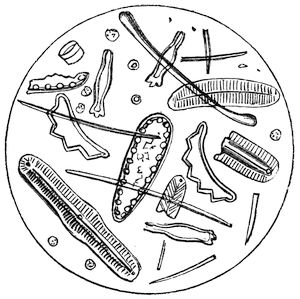
The water of the sea is everywhere salt, except at the mouths of great rivers, where the quantity of fresh water displaces that which properly belongs to the sea. The cause of its saltness is the solution of a natural mineral (chloride [Pg 105] of sodium) which exists in the earth in great abundance in layers of a crystalline structure, and as this chloride of sodium (common salt) is soluble in water, of course it is all dissolved by the water in whatever situation they may come into contact with each other. The composition of sea-water differs slightly in different parts of the earth, the southern seas being slightly more salt than the northern. As a general rule, about five per cent. of solid matter is contained in sea-water, of this rather more than half (5.7) is chloride of sodium; the greater part of the other half consists of different salts of magnesia, and this is the whole source of the medicines known as Epsom salts and magnesia, the former being the sulphate and the latter the carbonate of magnesia. Iodine, another article used in medicine and photography, is also extracted from sea-water, which however contains but a very minute portion, too small to be detected as a general rule, but extracted by burning certain sea-weeds, in the ashes of which it is found in sufficient quantity to be separated.
Although the sea as a whole keeps its level, yet in various parts it is constantly rising and sinking, sometimes at one place and sometimes at another; these risings and fallings are called tides, and are caused by the joint action of the sun and moon, that is, by their attraction, acting at different distances. First it must be observed (as is well known) attraction varies inversely as the square of the distance, that is, if the moon were twice as far off, her attraction of the earth would be one-fourth of what it now is, if three times as far off, one-ninth, and so on.
The moon's average distance from the centre of the earth (A to C, in the diagram) is about 240,000 miles, or about 60 times the earth's radius (B C), which is a little under 4000 miles, consequently if the distance from the moon to the centre of the earth (A C) be expressed by 60, the distance to the nearest surface (A B) will be 59, and the farthest surface (A D) 61. The moon will attract the point B with a force of 1/592 or 1/3481, the point C with the force of 1/602 or 1/3600, and the point D with the force of 1/612 or 1/3721. Now as the force at C is greater than at D, the earth itself will be pulled [Pg 106] away from the water at D, and leaving it a little behind, will produce a high tide there, this tide is known as the "inferior tide" (2). Again as the force at B is greater than at C, the water at B will be pulled away from the earth and produce a still higher tide, called the "superior tide" (1), or that which takes place when the moon is due south. This heaping-up of the waters by the moon, to the height of 4½ feet (on an average) causes corresponding depressions to the same depth in those parts of the earth which are situated between the raised parts, making a difference between high and low-water of nine feet due to the moon; precisely the same effects are produced by the sun, but though his attractive power is so much greater than the moon's, his distance is also so much greater, that the heap of water he can raise is somewhat less than 2 feet, and makes therefore less than 4 feet difference between high and low-water, due to the sun. When the sun and moon are both on the same side, or on opposite sides of the earth (as at new or full moon), then the attraction of both act together and produce "spring tides," with a difference of 13 feet; at first and last quarter the sun and moon oppose each other, acting in cross directions, and the difference is then only 5 feet. But these effects could only take place in the wide open space of an ocean, and when other forces do not interfere, such as obstruction to the tide-waves by land, &c.
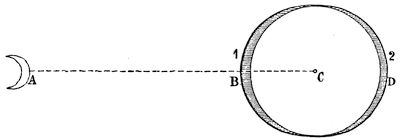
Inland seas (as large as the Mediterranean even) have but very little tide, while pinched-up rivers may have a great rush of tide, as at Bristol, where it rises to 45 feet [Pg 107] sometimes, and at Anapolis in Nova Scotia, to so much as 120 feet! Wind will also accelerate or retard both the speed and height of the tides. London receives a much greater tide than its due, for the tidal-wave being interrupted by Ireland and England, rolls up the western coast (taking a northerly direction) with such force as to swing round the Shetlands and all down the eastern coast of Great Britain. The direct Atlantic wave also, when split by our island, rolls along the south coast from Land's-End to Dover, rushes through the "Straits," and meets the backward wave which has been travelling round by Scotland (as before mentioned), the two then pour into the Thames and give an otherwise quiet river a high and useful tide; so that London receives two tides, the southern one nearly 10 hours after Cornwall, and the roundabout one not till nearly 23 hours after it first reaches England.
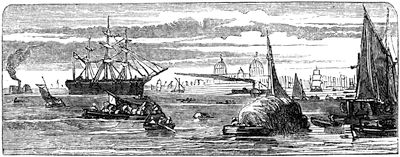
The waters are the great highway throughout the whole world, and what an easy transit it has formed to those nations sufficiently civilised to require a further knowledge of the world, and thence procure for themselves luxuries not obtainable at home—at the same time, spreading civilisation wherever they go!
If the oceans, instead of forming one great concourse of waters, had existed in the form of inland seas or great lakes, the great chains of mountains, deserts, and uninhabited tracts of earth, would, in some cases, have formed impassable barriers, whilst in other parts civilisation would have been [Pg 108] impeded from the easy access of the more savage tribes, who would have despoiled the more fortunate by inroads amongst them, mingling with or exterminating them, and checking the onward progress of civilisation. And this has always existed where great tracts of land are, which are the last parts of the world to be civilised, and in many parts remain as rude as they were thousands of years ago. All this is owing to the good and wise arrangement of water and land, and is an instance of the care and foreknowledge of God, who has provided for the onward progress of that creature to whom alone such a progress has been allotted; but as they now exist the oceans form impenetrable barriers to the savage, so as to restrict his brute force and uncultivated habits spreading, while they form easily-traversed highways to the more civilised nations, enabling them to spread their civilisation without contamination to themselves, but to the advancement of others.
The oceans are now navigated by thousands of vessels engaged in mercantile objects, and it is perfectly astonishing with what rapidity and safety these great tracts of water are crossed.
In one of Chambers's "Papers for the People," called "Ocean Routes," is the following, speaking of the perfecting of the steam-vessel:—
"The regularity, speed, and safety with which the voyages of these vessels were made, soon pointed them out as the best conveyance both for passengers and the mails.
"In 1821 they were employed on the latter service between Dublin and Holyhead, and between Calais and Dover; and now, with few exceptions, all the channel and ocean-work of the Post-Office is done by steamers, and all the passengers and much of the goods' traffic between the parts of Great Britain and Ireland, have been within the last quarter of a century transferred to them.
"After the steamboat had thus passed through the various stages of infancy and childhood—had tried its strength on English rivers, in the Irish Sea, and in the British Channel—men began to ask, was it not strong enough and old enough to do more? Could it not cross an [Pg 109] ocean as well as a channel—take letters and men, and merchandise to America, India, and Australia, as well as to Ireland and France? In this question were involved considerations of the highest importance to all the world, but particularly to this country, for no other country has such extensive foreign possessions as Great Britain, or carries on such an extensive trade.
"With the exception of the United States, all the colonies planted by the British remain parts of the empire, while Spain and Portugal have lost nearly all those rich territories, extending over the fairest portion of the American continent, that at one time acknowledged the sway of the houses of Bourbon and Braganza. The foreign possessions of France are insignificant, and, of the other nations of Europe, the Dutch alone possess a territory abroad greater than they have at home.... The proud position of Britain among the nations, the necessities of her foreign trade, and the wants of her colonies and dependencies, apart from all other considerations, rendered it fitting and natural that she should lead the way in maritime enterprise, and teach the nations how to navigate the ocean by steam.
"Nor has she failed in this high task; for, within thirteen or fourteen years, since the question was first proposed, she has established lines of gigantic steam-vessels that are now traversing with regularity and safety every ocean, steaming altogether more than a million and a quarter miles every year, and distributing letters and newspapers all over the world, at a cost to the country of about £650,000 per annum."
The rapidity and ease with which thousands of troops were lately conveyed to the Crimea and India, together with all their stores, horses, &c., form one of the most wonderful feats of ocean navigation ever performed, and point out the beauty of those arrangements which enable man to traverse the whole earth, whether by land or by water, so that it may fairly be said that the civilisation of the world depended and still depends upon the waters.
The foregoing descriptions refer to the great works of God as seen in those creations which possess not that most wonderful attribute—life. There is no limit in extent, in quality, or in number, to these works; their extension appears to be infinite; their magnitudes are large or small, just as we compare them one with the other. This earth is an enormous mass, contemplated in comparison with ourselves, but an insignificant speck when compared with the sun, and there are certain laws, chemical and mechanical, which govern them all—heat, light, and electricity permeate all the infinity of space—attraction exists everywhere. There are no individual existences among them; all are made up of matter combined according to certain definite chemical laws, and always obedient to them under the same conditions—moving according to certain mechanical laws, and always obedient to them. The Creator who made these lifeless masses made also the laws to regulate them; but, besides these, it has pleased Him to form certain other creatures not for an instant to be compared in size or quantity with the former, and made up also of certain chemical compounds obedient to the mechanical and chemical laws, with one more addition, that unknown, inexplicable attribute—life. This wonderful quality exists in all organic beings; they obtain by it individual identity; they are whole creatures—imperfect with any part taken away, also imperfect with any addition. Clay is clay, in any quality or form; iron is iron, whether a grain or a ton; but a tree is only a tree when it is complete. We cannot say "some tree," as we would "some clay," it must be a tree, or several trees, each a separate and complete existence— [Pg 111]perfect in itself—made up of solids and fluids, and possessing certain attributes, namely, a constant circulation of its fluid parts, a constant appropriation of food and rejection of waste matters—growth thereby to a certain definite form, and in many a definite size, together with the production of germs, capable, under certain conditions, of producing beings exactly similar to themselves. This constitutes organic life, and is possessed by all vegetables. Animal life is exactly the same, with the super-addition of will or mind in its most perfect state, of instinct or some analogous function in its lower states, or in quite the lowest—a chemical and mechanical difference only, such as shall determine the choice of food and mode of assimilating it. This difference consists in the vegetable feeding upon inorganic food, and the animal on food which has received the stamp of organisation. Creatures possessing life, whether vegetable or animal, are called organisms. It is found that these organisms are made up of certain atoms united in larger multiples than in inorganic substances, which are either simple or compounded of but few atoms; thus water is composed (every atom of it) of one atom oxygen, united to two of hydrogen. Common salt (every atom of it) is composed of one atom of the metal sodium with one atom of chlorine. Chalk is compounded of one atom of calcium in union with one of oxygen, and this united to one atom of carbonic acid, itself composed of one atom of carbon with two of oxygen. But organic compounds are often made up of four or six elements, united in multiples of their usual combining quantities. Thus, grape-sugar is made up (every atom of it) of 24 atoms of carbon, 28 of hydrogen and 28 of oxygen; these 78 atoms unite and form one compound atom, of which the sugar is wholly compounded, and thus, from such a complex nature, it happens that most organic compounds are decomposed by even a moderate degree of heat—all by a heat equal to red-hot iron. From these facts, it may be therefore stated, that all organisms are complete in themselves, have definite lives or existences, appropriate certain matters to themselves, grow thereby, and are compounded of organic atoms.
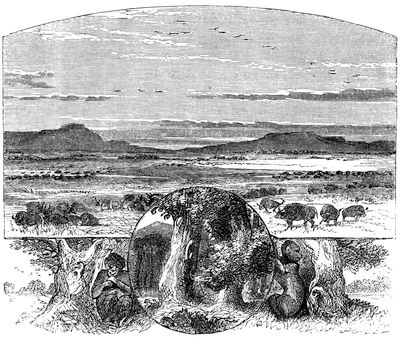
In contemplating nature there are few things which give more delight than the beauty and variety of the vegetation which clothes the surface of the earth, whether it be that we contemplate the grassy covering of the plains of the Old World, or the immense "prairies" of the New, spreading out as it were into seas of grass, and giving food and shelter to thousands of wild animals; or gaze upon the rocky height of some vast mountain range, and see the gigantic oak or pine, forming by their wide-spread shades the solemn forest which extends for miles beneath us, and [Pg 113] which forms a shelter for the various tribes of birds, monkeys, and other animals, to whom it is a home of happiness and plenty—under every aspect the contemplation of nature's clothing fills the mind with awe and admiration.
There is hardly anything more refreshing to the mind than the contemplation of trees and shrubs congregated into a wood, the floor of which is carpeted with mosses and flowers, where the gigantic and gnarled trunks of the forest trees covered with many-coloured lichens starting up all round, circumscribe the view, while the wide-spreading boughs and the leafy canopy overhead exclude the sun's rays. It is here that one views nature in her purest forms and colours, untouched by the destroying hand of artificial arrangement.
The immense preponderance of the vegetable over the animal world in quantity compensates somewhat for the superior organisation and the intelligence of the latter, which must be studied in the individual, while the vegetable world, which can be contemplated in the mass, almost overwhelms the imagination with its vastness. It is indeed impossible to compute the amount of vegetation in the great forests of America and Russia (in which latter country are the largest in the world), covering hundreds, nay thousands, of square miles with one continuous growth of timber. That forest in Russia through which the river Pechora flows, extends over a space of 150,000 square miles! The whole mass of animated existence sinks into insignificance when compared in quantity with this; and when to these forest-tracts are added the thousands of square miles of grass and heaths which grow in some climates with wonderful luxuriance, the amount of the vegetable kingdom is at once placed beyond all comparison with the animal kingdom in point of quantity. Cooper, in his American novels, describes the prairies as great seas of grass extending as far as the eye can reach, and rising to a height of 8 or 10 feet; and Humboldt describes some of the grasses on the plains of the Oronoco, as being so gigantic that they measure 18 feet from knot to knot, and says the Indians use them for blow-pipes to shoot their poisoned arrows from. And—as though [Pg 114] it were not sufficient that the earth should bring forth everywhere all kinds of trees, shrubs, and grasses—the waters of the ocean itself are often filled with vegetable life; in some tracks the tangled sea-weed (Fucus Natans) is so dense as to impede the onward progress of ships for hundreds of miles together.
Humboldt, in his "Views of Nature," describing the two great banks of sea-weed, says: "The two banks of sea-weed, together with the transverse band uniting them, constitute the Sargasso Sea of the older writers, and collectively occupy an area equal to six or seven times that of Germany."
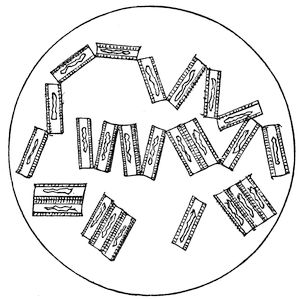
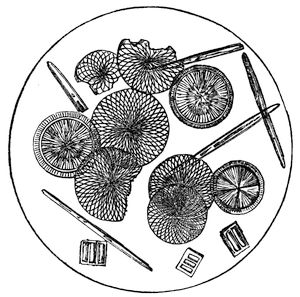
Nor is this the only vegetation which the great world of waters contains, for if we descend from the contemplation of its larger members we find them even surpassed in quantity by others of such extreme smallness, that they can only be seen individually by means of the microscope, but which exist in such prodigious quantities that the mind can hardly realise the fact. These vegetable atoms have been so increasing and depositing their minute coverings at the bottom of most parts of the ocean, that for hundreds of miles their beds are composed of nothing else, and it has been found that most of the great changes on the surface of the earth have been effected by these minute creatures and their companions of the animal world; for as we find chalk-downs and coral-reefs formed by the remains of microscopic animals, so productions of equal extent have been formed by the smallest members of the vegetable kingdom, chiefly the "Diatomaceæ," a race of minute vegetable productions which propagate by sub-division and have the power of withdrawing earthy matters from the waters in which they live, which forms a sort of shell or covering; this shell at their death remains indestructible and gradually accumulates in the bed of the sea (fig. 1). Examination of the various strata of the earth shows that chains of hills, beds of marl, and almost every kind of soil, whether superficial or raised from a depth, consist in a great proportion of the earthy remains of these minute plants. These tracts of land were once the beds of oceans which were thus gradually [Pg 115] filled up. The waters of the Antarctic Ocean are often opaque and quite brown from the multiplicity of these creatures, the lead used on shipboard for sounding coming up from the bottom covered with what appears to be mud, but which on a microscopic examination proves to be nothing else than the shells of these and allied species (fig. 2). Thus we [Pg 116] find the land and the waters are everywhere full of vegetable life; the air itself moreover is so filled with the germs of vegetable and animal creations, that it is quite impossible to exclude a portion so small that it shall not contain any; in proof of which, any organic substance set by for a few days in a vessel ever so carefully closed, is shortly covered with a growth of mould consisting of fungi, which under the microscope present most beautiful forms and colours (fig. 3). The cause of this is a deposit from the air of the spores or germs of these creatures, and the nature of the decomposing substance into which they fall often determines the race or tribe which shall come to life and inhabit it, showing plainly that but a few of these only among many come to maturity, just as when a variety of seeds are thrown on any particular kind of soil, only those to which the soil may be suitable come to perfection.
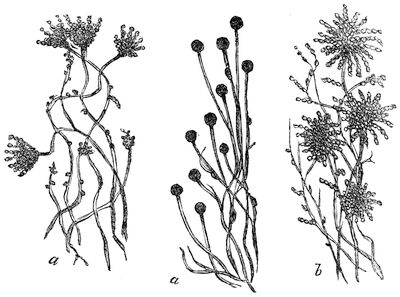
Dr. Carpenter in his work on the microscope says:—"There are scarcely any microscopic objects more beautiful than some of those forms of mould or mildew which are so commonly found growing upon the surface of jams and [Pg 117] preserves, especially when they are viewed with a low magnifying power and by reflected light; for they present themselves as a forest of stems and branches of extremely varied and elegant forms, loaded with fruit of singular delicacy of conformation, all glistening brightly on a dark ground.
"The universality of the appearance of these simple forms of fungi upon all spots favourable to their development, has given rise to the belief that they are spontaneously produced by decaying substances, but there is no occasion for this mode of accounting for it, since the extraordinary means adopted by nature for the production and diffusion of the germs of these plants adequately suffices to explain the facts of the case.
"The number of sporules which any one fungus may develope is almost incalculable; a single individual of the "puff-ball" tribe, has been computed to send forth no fewer than ten millions. And their minuteness is such that they are scattered through the air in the finest possible dust, so that it is difficult to conceive of a place from which they should be excluded."
Pure water exposed to the air does not afford nourishment to the germs which fall into it till a sufficient number of them shall have been deposited to form a food for those which come after them; but if we mix with the water any soluble vegetable or animal matter, in a short time the microscope will detect the growth of the germs that are being deposited, for where nourishment is, there only can they be developed. These germs are capable of existing for an indefinite period, either floating in the water, or blown about by the air, and have been detected hundreds of miles from land, the rigging and sails of ships far away from shore are often covered with what sailors suppose to be sand blown from the land, but which are organic substances, either vegetable or animal. According to Humboldt, the Red Sea has derived its name from the fact that at certain seasons the surface of the water has a reddish appearance, and this (as he says) he was fortunate enough to observe, which colour he found to be due to myriads of red fungi [Pg 118] which had formed on the surface. The seeds of some plants are furnished with minute wings or plumes which cause them to be borne on the air or floated on the water (fig. 4), to fertilise some barren spot, perhaps a coral reef which has at length reached the surface of the water and which ascends no higher, for the little creatures which built it are aquatic and cannot live exposed to the air; this coral reef now becomes a receptacle for sea-weed and fungi, which float on the surface of the ocean, are washed on to the reef, die, decay, and leave behind a thin layer of mould, which process being repeated again and again, forms an elevated edge to the reef, enclosing a lake or "lagoon" as it is called, the waters of which evaporate and the space is filled up in the same way as the edge was formed, together with the excrements of birds, &c., forming layer after layer of mould, and the surface becomes fit for the growth of larger seeds, as the cocoa-nut, banana, &c., which are drifted on to it by the waves; in this way a coral reef becomes an island fit to be inhabited by man and other animals.

The vegetable kingdom forms a mysterious link between the mineral and animal kingdoms, and binds all creation into one grand and unspeakably beautiful whole. There are certain substances from which the vegetable derives its nourishment, namely water, carbonic acid, and ammonia, which, though strictly inorganic, are yet not simple or elementary substances, but consist of pairs of elements combined. Thus water consists of oxygen and hydrogen, carbonic acid of oxygen and carbon, and ammonia of hydrogen and nitrogen. All these aliments of the vegetable kingdom exist in the air, and in sufficient quantities to supply all the requirements of vegetation; so that the air, together with a few metallic oxides (salts) derived from the earth, furnishes food for the whole vegetable tribe, from the highest to the lowest, and these vegetables in their turn supply all the food which the animal tribes consume, for [Pg 119] although one animal feeds upon others, yet these must previously have derived their nourishment from vegetable matter. Vegetables not only supply food properly so called, but likewise that which is essential to respiration, for besides separating all noxious excess of carbonic acid from the air, they are an inexhaustible source of oxygen, the element essential to respiration, and consequently animal life. This supply of oxygen by vegetables compensates for that which is consumed in respiration by animals, and thereby maintains the atmosphere in a state proper to be breathed. That plants do thus absorb carbonic acid and give out oxygen, can be proved in the most certain manner, if the green parts of a plant be placed in water holding carbonic acid in solution, and exposed to sunshine; the carbonic acid will shortly be found to have disappeared from the water, while oxygen gas is evolved and can be collected, its quantity being exactly equal to the carbonic acid which the water contained.
Besides furnishing food and oxygen for the nourishment of animals, vegetables afford a shelter from the burning rays of the sun in hot climates, not only to man, but to those hundreds of wild animals whose proper home is in the forest. Humboldt says he found in South America forests composed of such close growth, that it was quite impossible even for the wild animals to penetrate into them, except at a few places, and that the jaguar often lives for weeks in the trees without descending to the ground, preying upon the monkey tribes and other animals, which are found in almost incredible numbers there; and Dr. Livingstone thus describes the forests of Africa:—"The forests became more dense as we went north. We travelled much more in the deep gloom of the forest than in open sunlight. No passage existed on either side of the narrow path made by the axe. Large climbing plants entwined themselves round the trunks and branches of gigantic trees, like boa-constrictors, and they often do constrict the trees by which they rise, and, killing them, stand erect themselves."
These woods, as well as the grass and herbage of the plains, afford an enormously extended evaporating surface, [Pg 120] and act, in the heart of hot countries, as inland seas, giving out clouds of vapour, which ascend and are condensed in the form of rain; in this way the surface of the earth is cooled, the fluid (far away from its proper source, the ocean) is economised and fertilises a greater space of surface. Vegetation also acts in preserving the surface of the earth from those ravages which both wind and rain would otherwise effect; the great deserts have been levelled by these causes, the earth not being of a quality to support vegetation. Cattlin says, that in North America he frequently met with great conical-shaped mounds of earth devoid of vegetation, and which were fast being levelled by the rains, at every fall of which gullies were formed on their sides, down which the mud poured in streams; now, had these been of a quality to support a covering of grass, their size and form would have remained unchanged for centuries. Railway embankments are often sown with grass seeds, to prevent injury to them, especially where this covering is not likely to come soon, as in the vicinity of large towns.
Thus it is seen that the vegetable kingdom far exceeds the animal in quantity, that it is everywhere distributed, that it affords nourishment and shelter to animals, preserves the air fit for respiration, keeps down the excess of heat, and preserves the form of the surface of the earth.
The green colour of plants is due to the formation and deposition in their cells of a peculiar compound called "chlorophyll," and it is ascertained that this compound is produced in the plant in consequence of its exposure to light, for no plant grown in the dark is green, but will become so when light is admitted. This is shown in many cultivated vegetables, as celery, lettuces, &c., in which by banking up the celery, or tying together the lettuce, the light is excluded, and the stalks of the one and the heart-leaves of the other become mild and white, whereas the same grown in a state of nature are so green and rank as to be almost poisonous.
The effects of light and heat in favouring vegetation being nearly always found in union, causes that which is really due to light often to be attributed to heat, as in the growth of tropical plants; where both are combined, there will be the greatest powers of vegetative growth. The absence of light and air often causes the upward growth of a plant to seek them; a curious instance of this, altering the habits of a tree, is mentioned by Dr. Livingstone, who says:—
"As we traverse a succession of lawns and open forests, it is interesting to observe something like instinct developed even in trees. One, which when cut emits a milky juice, and if met with on the open lawns grows as an ordinary umbrageous tree, and shows no disposition to be a climber, when growing in a forest still takes the same form, then sends out a climbing branch which twines round another tree until it rises 30 or 40 feet, or to the level of the other trees, and there it spreads out a second crown, where it can enjoy a fair share of the sun's rays. In parts of the forest still more dense than this, it assumes the form of a climber only, and at once avails itself of the assistance of a tall neighbour, by winding vigorously round it, without attempting to form a lower head. It does not succeed so well as parasites proper, but when forced to struggle for space, it may be mistaken for one which is invariably a climber."
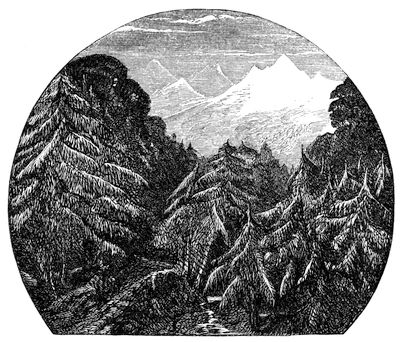

The absence of heat with plenty of light is shown in the vegetation of mountainous districts, where there is great size, but the absence of leafy expansion, as in the pine tribe (fig. 5). Where both light and heat are deficient, nothing but fungi, mosses, and lichens of the most stunted nature will grow. Experiments in hothouses prove that although tropical plants be supplied with their proper amount of heat, yet without the very greatest supply of light that can be obtained, they do not come to any degree of perfection. The influence of light is chiefly upon the leaves, that of heat upon the earth and root, which becomes more fully developed. When a seed is placed in the earth, moisture is absorbed by it from the earth, and a development of the cells of the cellular tissue of which the seed is composed takes place, and from the peculiar nature of these cells they [Pg 122] divide into two sets, one of which passes upwards towards the light, the other passes downwards into the earth; these last (which pass downwards) form a fibre called the "radicle" (fig. 6), those which pass upwards form also a stalk or fibre called the "plumule," which carries up with it a part of the seed called the "cotyledon," which (like a leaf) has the power of decomposing the carbonic acid of the air and fixing its carbon in the form of wood. This begins as soon as the cotyledon has reached the light, and thus the formation of fibres of woody matter takes place, which fibres descend from the cotyledon to the radicle. Meanwhile the formation of other cells of the plumule takes place, until the first leaf is formed, when other fibres of wood are sent down, and so on for every leaf, so that the number of woody [Pg 123] fibres which form the trunk of a tree is in proportion to the number of leaves which that tree has borne, from which we come to the conclusion that the size of the trunk of a tree is the sum of all its branches. While all this is going on, the cellular tissue of the downward part or radicle also becomes developed and divides out into roots, on the surface and at the extremities of which are minute cellular bodies called "spongioles" (from their power of absorbing moisture), which take up the fluid of the earth which surrounds them; this moisture ascends through the vessels of the plant till it arrives at the surface of the leaves, where it is exposed to the action of light and sunshine. The ascent of the moisture of the earth was first correctly explained by Du Trochet, and is owing to a peculiar power which he discovered, and which is called "Endosmose;" this consists in the tendency which a fluid has to penetrate a membrane on the other side of which is a fluid of greater density than itself. This may be seen by the following experiment: obtain a piece of glass tubing about a foot long, having the end blown out into the form of a bell, as in fig. 7, tie a piece of bladder over the expanded end and fill it partly with syrup or gum-water, so that this shall rise in the stalk about an inch; place this in a glass of water with the bladder downwards, and the fluid will be seen slowly to rise in the stalk, so that in perhaps an hour it will rise to the top. This apparatus resembles one of the spongioles at the extremity of the fibre of a root.

The rain falling through the air carries with it a certain [Pg 124] amount of carbonic acid and ammonia, which the air always contains, and this is the whole source of the nitrogen which forms a very important part of the bodies of plants and animals. When the rain arrives at the surface of the earth, it sinks down into it and carries with it all soluble vegetable or animal matter which it meets with, together with any soluble earthy matter which may exist in the soil; this forms the sap of the tree. When it arrives at the surface of the leaf, the watery part of it combines with the carbonic acid of the air (through the influence of light) and appropriating its carbon, gives out the oxygen; this is the true respiration of plants, and is exactly the reverse of what takes place during the respiration of animals, in which case oxygen is absorbed and carbonic acid given off. The carbon thus retained by the plant combines with the elements of the water to form the solid green substance called chlorophyll, which is the basis of all the tissues of the plant, the ammonia is also decomposed, and its nitrogen combining with the oxygen and hydrogen of the water, and the carbon of the carbonic acid forms those compounds which constitute the most nourishing parts of vegetables, such as albumen, gluten, &c., and of which all the animal tissues are built up, for the production of these organic substances takes place in the vegetable only, animals simply appropriating them from their food. The sap which reaches the leaf is not all converted into chlorophyll, but also into those peculiar juices which are found in plants, some of which contain sugar, some gum, others (as the pine tribe) turpentine, and in the laurel tribe camphor, all of which are substances containing much carbon; moreover the solid wood and bark are deposited from these juices as they descend from the leaf after having been acted on by light (or the actinic power associated with it). Now, as the water, ammonia, and carbonic acid which descend with the rain are from the air, and as the vegetable is formed wholly by their absorption, it may be fairly said that the vegetable kingdom (and therefore the animal) feeds upon the air, and that the trees do not grow out of the earth but into it.
With respect to the position which the vegetable kingdom [Pg 125] occupies in creation, there can be no doubt that it is subordinate to the animal kingdom, and takes a place between it and the mineral world, inasmuch as it prepares food from the one kingdom and transfers it to the higher. It has been supposed that the vegetable and animal kingdoms aid and support each other equally and mutually; this is true with respect to respiration, but not as regards nutrition, for although in the decomposition of animal matters, food is given off for the vegetable, yet they are quite independent of this source of nourishment. A forest of trees would be quite as well nourished if there were no animals, but on the other hand the animal kingdom would shortly cease to exist if there were no vegetables.
It was formerly supposed that the lowest grades of the animal kingdom were higher than the highest of the vegetable kingdom; this is not strictly true, the best way of viewing the connection between the two kingdoms is to approximate the lowest of each, when it will be found that our most acute physiologists are only just beginning to determine their distinctive characters.
Dr. Carpenter says:—"In the present state of science it would be very difficult, and is perhaps impossible, to lay down any definite line of demarcation between the two kingdoms, since there is no single character by which the animal or vegetable nature of any organism can be tested.
"Probably the one which is most generally applicable, among those lowest organisms which most closely approximate to one another, is not, as formerly supposed, the presence or absence of spontaneous motion, but the dependence of the being for nourishment upon organic compounds already formed, which it takes (in some way or other) into the interior of its body, or its possession of the power of obtaining its own alimentary matter by absorption from the inorganic elements on its exterior. The former is the characteristic of the animal kingdom as a whole, the latter is the attribute of the vegetable."
Both vegetables and animals begin with a simple nucleated cell, having certain vital properties, a double chain ascends from this simple type, one branch of which is developed [Pg 126] more and more till it arrives at a perfect vegetable, and the other branch is developed till it arrives at a perfect animal. Thus, by the addition of distinctive and characteristic appendages, one being acquires properties regarded as vegetable, while by the addition of other appendages equally characteristic, the other being obtains those properties which cause it to rank as an animal; but it must not be inferred from this that all organic forms have been a simple cell at some former period, but that there are two classes of organic beings, the vegetable and the animal, and that each embraces forms, ranging from a simple cell to the highest, and that each of these forms (from the lowest to the highest) is and always was, from their first creation, the same as they now are, in individual shape and size. Some of the lower members of the animal kingdom resemble the higher members of the vegetable kingdom, both in outward appearance and in intimate structure; Dr. Darwin, who wrote scarce half-a-century ago, says that a tree should no more be considered as one plant than a branch of coral as one animal, for as it is found that in the coral hundreds of separate beings exist associated in one habitation, so (he says) should every bud on a tree be considered as a separate being. Even Dr. Carpenter, one of our most eminent physiologists, seems in a great measure to favour this idea. He says: "The radiata possess many points of affinity with the vegetable kingdom, and of these the circular arrangement of their parts is one of the most evident. Many species of sea-anemones, for instance, present an appearance so much resembling that of various composite flowers, as to have been commonly termed animal-flowers, a designation to which they seem further entitled from the small amount of sensibility they manifest, and the evident influence of light upon their opening and closing.
"But it is in the tendency to the production of compound fabrics, each containing a number of individuals, which have the power of existing independently, but which are to a certain degree connected with one another, that we recognise the greatest affinity in structure between this group and the vegetable kingdom. Every tree is made up of [Pg 127] a large number of buds composed of leaves arranged round a common axis; each bud has the power of preserving its own life and reproducing the original structure when removed from the parent stem, if placed in circumstances favourable to its growth, and yet all are connected in the growing tree by a system of vessels which form a communication between them. This is precisely the nature of those structures which are formed by the animals of the class that may be regarded as the most characteristic of the group. Every mass of coral is the skeleton of a compound animal, consisting of a number of polypes, connected together by a soft flesh in which vessels are channelled out; the polypes are capable of existing separately, since each one, when removed from the rest, can in time produce a massive compound fabric like that of its parent, but they all contribute to the maintenance of the composite structure so long as they are in connection with it. In some instances the skeleton is stony, and is formed by the deposition of calcareous matter either in the centre of each fleshy column, so as to form a solid stem, or on its exterior so as to form a tube. In other cases it is horny, and then it may be a flexible axis in a delicate tube. Both the stony and horny corals often possess the form of plants or trees, and as their skeletons are often found with no obvious traces of the animals to which they belong, they have been accounted vegetable growths."
As has been said before, it is extremely difficult to make any distinction between the lower tribes of the vegetable and animal kingdoms, and physiologists are not yet agreed, with respect to some members, as to which kingdom they belong. Their whole substance is made up of cellular tissue, and there are but few distinctions of parts, forming generally a broad foliaceous expansion called the "thallus," as in lichens and sea-weeds, or a sort of root composed of fibres and called the "mycelium," as in the fungi. But, a very few steps higher, the distinctive characters become so evident that they are impossible to be mistaken, [Pg 128] the following description will therefore apply to vegetables of the more elevated character, such as trees or flowering plants.
Plants are fixed to the earth, and receive nourishment from it by imbibing its liquids, which circulating upwards through the porous structure of the plant itself, and becoming exposed to the air in the leaves, attract to themselves nourishment from that source also. The part of a plant which grows into the earth is called the root; this has a variety of forms, in some it is branched like the upper part, and these branches divide into rootlets or fibres penetrating deep into the ground, and absorbing nourishment in all directions, but this absorption does not take place from the whole surface of the root but from spots covering it, and from the slightly expanded ends of the fibres, these portions are formed of new and porous cellular tissue, and are called "spongioles." The part of plants which springs upwards from the earth is called the stem, if large the trunk, this divides into branches and twigs; stems in some cases continue for a distance more or less underground. The part of a potato plant, usually called the root, and from which the tubers or potatoes grow, is in reality an underground stem, and the fibres which spring from it are the roots; the underground suckers of mint are also portions of stem, and in some cases these are greatly expanded, they then obtain the names of "tubers" (as the potato), or "corm," as in the crocus and meadow saffron; when the stem is thin and runs along the ground, sending in roots at intervals (as in the strawberry), it is called a "runner," when thicker and running horizontally under the ground, it is called a "rhizome."
The stem consists of a central portion, either made up of long bundles of woody fibre running side by side, as in the endogenæ, or deposited in rings and having a central cylinder of pith, as in the exogenæ. In these the wood at the central part (or the oldest) is called "duramen," or "heart-wood," while that at the outer part or nearest to the bark (the newest), is called "alburnum" or "sap-wood." The former is the harder and the latter the softer portion. [Pg 129] From the pith in the centre, through the woody part, rays or laminæ of cellular tissue similar to that which constitutes the pith itself, are sent outwards through the woody rings to the inner part of the bark, which they form; these are called medullary rays, and may be seen in wood which has been cut across the grain, they are often called the "silver grain," and are very evident in oak, beech, and elm, the inner part of the bark is called the "liber." The bark itself is made of cellular tissue dried and hardened by age; the outer portion (called the "epidermis") is in many cases shed, and may be constantly seen hanging loosely from the bark of the birch and other trees in loose white silvery portions. The outer part of the bark of some trees is so largely developed as to be of considerable thickness, this is especially the case in the Cork oak (Quercus suber), which is the cork of commerce. The bark cannot stretch as the circumference of the tree increases, it is therefore split up and cracked, which accounts for the rough state of it on those trees which do not shed the outer part.
The chief appendage of the branches, is called a leaf, it grows from a small projection called a leaf-bud, which contains the leaf rolled up. The method in which this occurs is different in different plants, in some it is folded backwards and forwards, in others doubled up with the opposite leaf alternately, and in various forms in other plants. The leaf consists of two parts, the stalk (petiole) and the blade (lamina); the blade is of different forms, and has ribs and veins covering it, in some of a reticulated or network pattern, these belong to the exogenæ, and in others running parallel, which is the kind of venation found in the leaves of the endogenæ. When leaves are placed on a stalk, they are said to be "petiolate," when without one, "sessile."
When leaves are not separated into different portions (although they may be much notched) they are said to be "simple," as in the oak or willow, but when divided into separate portions, as in the ash, they are said to be "compound."
The following are the chief forms of leaves, named according to variations of their several parts:
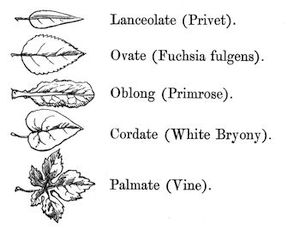
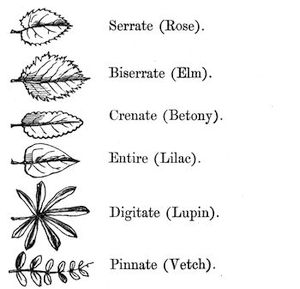
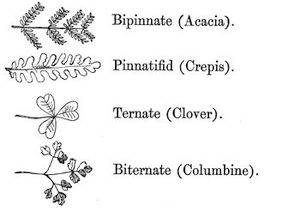
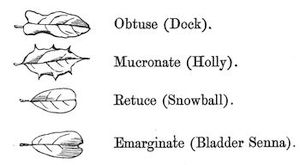
At the base of many leaves are a pair of scales called stipules; the petiole or leaf-stalk is generally cylindrical, but frequently triangular, and in grasses it is flat and surrounds the stem, this is called a sheath; when leaves are narrow and not expanded into a lamina, as in the pine tribe, they are said to be "acicular."
The stalks which bear the flowers are called "pedicels," at the base of which are a pair of scales called "bracts;" when these are large and expanded, so as to enclose the flowers, they are called "spathes" (this is seen in the arum), [Pg 132] and when there are a number of flower-stalks arising from one point the bracts there collected are called an "involucre." A flower consists of several parts, the outermost green scales, composing a set, are called the calyx, and each part of it, is called a "sepal," within this is the "corolla" or that coloured part which forms the most characteristic feature of the flower, each part of the corolla is called a "petal;" when the corolla consists of but one piece, it is called "monopetalous," and when of many, "polypetalous."
The forms of corolla vary according to the form and the mode in which the petals are placed, whether united or separated, and to what extent, whether regular or irregular; the most usual forms are the following:—
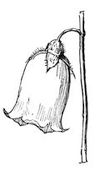
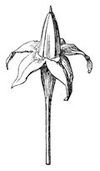
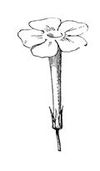
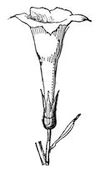
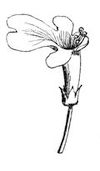
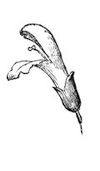

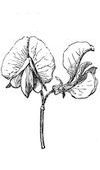

Within the corolla are placed the "stamens" (male reproductive organs) these consist generally of two parts, the head and stalk, the former called the "anther" and the latter the "filament," which last is sometimes absent, and the anther is said to be "sessile;" on the surface of the anther is the "pollen" or fertilising dust.
Within the centre of the flower is the "pistil" (female reproductive organ), this consists of one or several cells called "ovaries," from the pistil a tube rises, having an expanded end called the "stigma," it is by the application of the pollen dust to this stigma that the ovaries are fertilised, and the various insects, especially bees, who seek for honey, shake off by their movements the pollen from the anthers and cause it to be applied to the stigma, thus unconsciously performing a necessary office for the plant while they rob it of that only which is not required.
The stamens are sometimes separate, sometimes bound up into one or more bundles, and are placed in various situations, names are given to describe such arrangements as follows:—
Stamens in one bundle, Monadelphous.
Stamens in two bundles, Diadelphous.
Stamens in more than two bundles, Polyadelphous.
Filaments placed directly below the pistil, Hypogynous.
Placed upon the sides of the calyx, Perigynous.
On the sides of the corolla, Epipetalous.
On the top of the ovary, Epigynous.
When the ovaries are fertilised the flower dies and they begin to enlarge and ripen to form the fruit, which is the pistil enlarged, and contains the ovules ripened into seeds.
The fruits of different plants are known by various names according to the state of development of the various parts composing them. If the ripe fruit split open so as to let out the seeds (as in the common pea) it is called "dehiscent," if it do not so split (as in the apple) it is said to be "indehiscent;" the outer part of fruit is called the "pericarp," and this may be soft and fleshy as in the apple or cherry, or hard as in the filbert. The following are the names of the principal varieties of fruit:—
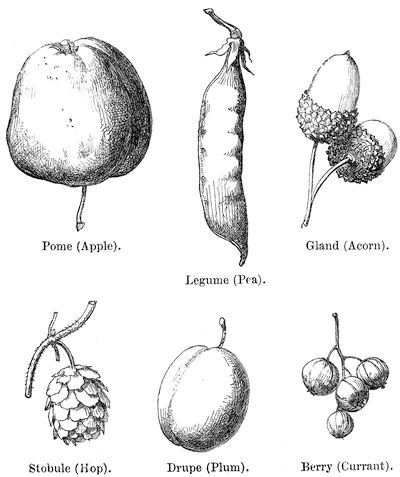
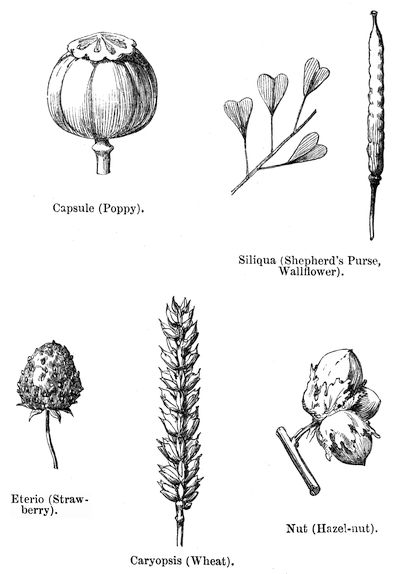
The seed is the ovule ripened, it contains the germ of the future plant, called the "embryo," the outer part of the seed is called the "testa," and the space between this and the embryo is generally filled with starchy matter called the "albumen." The embryo consists of the plumule or [Pg 136] stem, the "radicle" or root, and the cotyledons or leaves of the future plant; when the seed has but one cotyledon it is called "monocotyledonous" and when it has two "dicotyledonous."
Flowers are arranged in various ways upon the plants which produce them, and receive names accordingly; the whole arrangement of flowers is called the "inflorescence."
The following are the principal forms of inflorescence:—
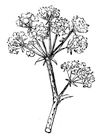
Hemlock.
|
The Umbel, in which all the flower-stalks (pedicels) radiate from one point, as in the carrot (daucus carota). Umbels are sometimes compound, that is, the flowers are placed in umbels at the end of stalks themselves radiating from a point and so forming an umbel, as in the Hemlock (Conium maculatum). |
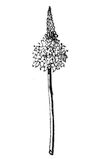
Plantain.
|
The Spike, is that kind of infloresence in which all the flowers are seated without stalks upon a general peduncle or axis, as in the Plantain (Plantago media), in which the spike is entire, or as the Lavender (Lavandula Vera), in which the spike is interrupted, that is, the inflorescence is not continuous. [Pg 137] |
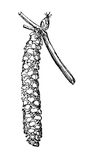
Hazel.
|
Catkin, or Amentum, is the same as a spike, but in which the flowers are imperfectly developed, as in the Hazel (Corylus), Willow (Salix), White Poplar (Populus Alba), &c. |
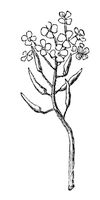
Water-cress.
|
The Raceme has the inflorescence placed along a common axis or centre, the same as a spike, but with the flowers placed upon stalks instead of being sessile, as in Water-cress (Nasturtium officinale) and Red Currant (Ribes rubrum). |
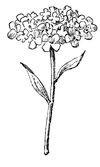
Candy-tuft.
|
The Corymb is a form of inflorescence pretty much the same as raceme, but the flowers of which proceed upwards till they are all on a level, as in Candy-tuft (Iberis). |
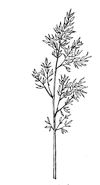
Creeping Soft Grass.
|
The Panicle, the same as the raceme, but having the flower stalks themselves divided into branches, as in Creeping Soft Grass (Holcus mollis). This and the spike are the most usual form of inflorescence found among grasses, in many of which the panicle, however, is often contracted almost to a spike. |
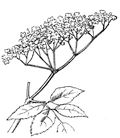
Elder.
|
The Cyme, this resembles the panicle shortened in such a manner as to become flattened or almost corymbose, as in the Elder Tree (Sambucus nigra), in which there are five principal stalks of inflorescence. |
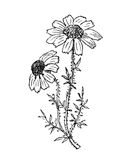
Chamomile.
|
Capitulum, in which the flowers arise from a broad round head or receptacle as in the composite flowers, such as Chamomile (Anthemis nobilis); in such flowers the star-like ray of florets are called the florets of the ray, and those composing the centre the florets of the disc. |
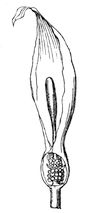
Arum.
|
The Spadix is that form of inflorescence in which the expanded bract, called a spathe, forms a sort of sheath inclosing the flowers. This spathe is white in the example given, and is often mistaken for part of the flower itself, as in the Wake-robin or Arum (Arum maculatum). |
The vegetable kingdom is divided into three great natural families, the Acrogenæ, the Endogenæ, and the Exogenæ.
The acrogenous plants are those which as a general rule have neither branches, leaves, nor flowers; they are almost wholly made up of cellular tissue, and are many of them so minute that they are quite invisible individually to the unassisted eye, and are among the most wonderful works of the Creator, having an amount of beauty in form and elaboration of ornament bestowed on them, quite equal to anything among the higher and larger creations, and yet some of these are so small that tens of millions may be placed in the space of a cubic inch, of such are the Diatomaceæ and Desmidiaceæ.
The acrogens take an immense range in the scale of organisation, from the ferns (which appear but little inferior to the exogenæ or endogenæ, have stems and leaves, and in some cases, as in hot and moist climates, assume the size and form of a tree), to the very lowest state of vegetable existence, consisting of simple cells uniting into strings or forming simple threads, such as the green algæ which form on stagnant waters and damp ground or wood-work, and the mould or mildew which forms on all decomposing substances. The general name for these acrogens, "cryptogamia," which has been in use [Pg 140] for a long time and is commonly still used, indicates that the reproductive organs are invisible, hence the expression used by one of Shakespeare's characters, "We have the secret of fern seed, we walk invisible;" but this is not really the case, for the "sorri" at the back of fern-leaves, are vessels filled with spore cases each having a number of angular seeds within it; the lower tribes of the acrogens do not commonly grow from seed but by an extension of their several parts by the development of the cells of which they are composed, and by their separation into portions.
Few of this tribe have anything like true woody texture, except their highest order, the ferns, which form some of the most beautiful objects in the vegetable world. Few of the family of acrogens are of much direct use to man, the mushroom tribes are very generally eaten where they abound, the lichens of the arctic regions form the food of the reindeer (the greatest friend of man in these cold climes) as well as, in part, the food of man himself; but although these lowly plants serve man but little, directly, there is not a shadow of doubt that they have as important an office to fulfil as any other family or tribe of organised creatures, whose purpose may meet the eye more plainly. For all the members of creation form, as it were, the links of one great chain, and were but one removed, though it might perchance be only some poor weed or lowly moss, yet might it cause the whole to be annihilated; for certain earthy matters enter into the structure of all plants, and it appears to be the wonderful office of some of these lowest tribes of plants to prepare this earthy matter for its reception into the systems of higher organisms, for as silica is one of the primitive rocks of the earth and is only found in fragments, from the largest to the sand on the sea-shore, which is nothing but a collection of minute fragments of quartz worn small by attrition, yet a grain of sand is a gigantic mass of rock in comparison with the thin porous hollow shells of the Diatomaceæ, &c., and by far too large to be absorbed or dissolved so as to be taken into the systems of other plants that may require it, which plants would cease to exist if this earth were not thus prepared [Pg 141] for them; now these are the corn-bearing plants, the most useful to the animal world, and upon which it in reality depends for existence. Moreover the whole of the mould in which the higher orders of plants grow, is formed by the decomposition of the more humble grades, especially the lichens, which first take possession of the surface of bare rocks and stones, and furnish by their death food fit for the sustenance of those which follow them. Like the higher orders of vegetation, these minute plants excrete oxygen, and thus in the ocean may supply this vital element for the respiration of the various corresponding minute animal organisms which inhabit the depths of the sea and which cannot come to the surface to get it, so that the two thus supporting each other, form food for all the higher marine animals, which are finally eaten by man. So that upon some of these minute and apparently useless creatures hang the lives and well-being of many of the most important vegetables and animals.
Dr. Lindley divides the acrogens into the following orders:—
1. Algæ (Algals), including Sea-weeds, &c.
The Algæ include the lowest of all the vegetative organisms, the "Protophytes" (first plants). These have no individual parts, but consist of living cells, propagating by sub-division or by the union of two cells into one, causing the formation of "nuclei" or smaller cells within them, each of which becomes a parent cell after the rupture of the cell-membrane which contained them.
Dr. Carpenter, in his "History of the Microscope," says:—"The life-history of one of these uni-cellular plants in its most simple form, can scarcely be better exemplified than in the Palmoglœa macrococca, one of those humble forms of vegetation which spreads itself as a green slime over damp stones, walls, &c. When this slime is examined with the microscope, it is found to consist of a multitude of green cells, each surrounded by a gelatinous envelope; the cell, which does not seem [Pg 142] to have any distinct membranous wall, is filled with granular particles of a green colour, and a 'nucleus' may sometimes be distinguished through the midst of these. When treated with tincture of iodine, however, the green contents of the cell are turned to a brownish hue, and a dark-brown nucleus is distinctly shown. Other cells are seen, which are considerably elongated, some of them beginning to present a sort of hour-glass contraction across the middle; in these is commencing that curious multiplication by duplicative subdivision which is the mode in which increase nearly always takes place throughout the vegetable kingdom."
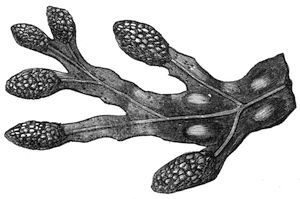
The higher tribes of Algæ embrace the sea-weeds; these are for the most part broad, leaf-like expansions of "thallus," composed of cellular tissue, they sometimes grow to an enormous length. Humboldt mentions the sea-grass as extending for miles, and forming continuous extensions of two or three hundred feet, and the Macrocystis pyrifera attains to the length of more than a thousand. The common Bladder-wrack (Fucus vesiculosus) was formerly much used to procure soda from, its ashes containing a considerable quantity, it is also used for manure; the Laminaria digitata is eaten under the name of "tangle," and a nutritious jelly is made from the "Carigeen moss" (Chondrus crispus).
|
2. Characeæ (Charas). | |
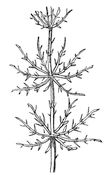
Charas.
|
These are a kind of fresh-water Algæ, composed of tubes of cellular tissue; they are peculiar, from the fact that the spores of the plant have cilia, giving to them the powers of motion and enabling them to swim away and spread the plant afar off. It is in the Charas that the peculiar circulation of the granules of "endochrome" called "cyclosis" is best seen. |
3. Fungi (Fungals), including Mushrooms, &c.
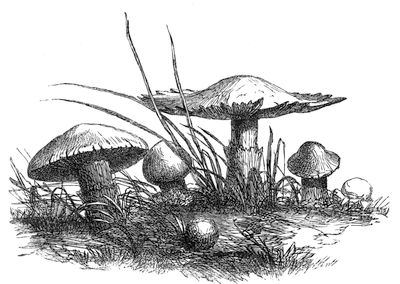
The Fungi comprise a great variety of vegetable growths, from the mould which grows on any animal or vegetable substance, to the mushroom. Some of the moulds or mildews found on various decaying substances are [Pg 144] peculiar to them, and in many cases exceedingly destructive. The microscopic fungus Puccinea graminis, is the parasite which fixes itself to corn and produces the disease known as mildew, and the Uredo segetum (another microscopic fungus) causes the "smut;" the "bunt" is caused by the Uredo fœtida, and the "spur," or "ergot," which attacks rye, is caused by the Acinula clavis. These fungi completely destroy the grain of corn, in which they form, and propagate in the most rapid manner; the ergot is moreover a dangerous poison to those who eat the bread made of rye infected by it. The Truffle (Tuber cibarium) is a kind of underground fungus, and is esteemed a dainty. Mushrooms are also fungi, and several species are sufficiently wholesome; these are the Field Mushroom (Agaricus campestris) and the Fairy-ring Mushroom (Agaricus pratensis).
4. Lichenes (Lichens),
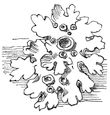
Are those dry scaly growths forming grey, green, or yellow spots on the barks of trees and in various other places, and they grow in a sort of leaf or scale called a "thallus." They are used as articles of food and as "dye-stuffs;" the Cetraria Icelandica is the "Iceland Moss" used here for making a sort of nutritious drink or jelly, the natives of Iceland, however, use it as common food; the Cladonia rangifarina, or Reindeer Moss, is the chief food of that useful creature which forms the whole property of the Laplander; and the Roccella tinctoria is the substance from which the dye called "archil" is procured.
5. Filices (Ferns).
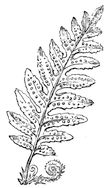
The Ferns are a very numerous order of acrogenous plants, growing in the temperate regions from a rhizome or underground stalk (commonly called its [Pg 145] root), which throws up "fronds" or leaves with a strong midrib; this midrib is commonly called its stalk, but in tropical countries the fern stalk rises above ground to the height of 30 or 40 feet, and then it is seen that the ordinary stalks are but the midribs of the fronds. There are between two and three thousand species of fern. The fronds open in a peculiar manner, unwinding as it were from a round ball. The "sorri" or seed-cases are situated at the back of the fronds in little brown spots, each of which is found to consist of a heap or collection of round capsules, and if these be placed under the microscope they have the appearance of little membraneous cases covered with net-like markings, and at the upper part a striated band of a brown colour, which after a time stretches out into a nearly straight line, tearing open the bag or capsule, and a number of seeds escape. Ferns grow best in damp and shady situations, and will thrive well in damp mould under a glass case.
|
6. Marchantiaceæ (Liver-worts). | |
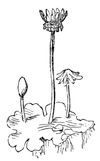
Liver-worts.
|
These Liver-worts are much like Lichens, growing between and upon stones near springs and moist places, and forming a broad thallus or root from which grow cup-shaped sporangia or seed-cases. The Marchanta polymorpha is one of its chief members. [Pg 146] |
| 7. Jungermanniaceæ (Scale-mosses). | |
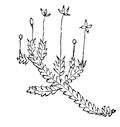
Scale-moss.
|
The Scale-mosses grow in moist places and under the stems of trees and plants. Their appearance is scaly, and they have a sort of stalk. |
| 8. Bryaceæ (Urn-mosses). | |
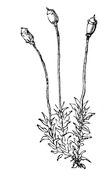
Urn-moss.
|
Urn-mosses comprise the most ordinary of the mosses, the "Brium," which grows on the ground everywhere, forming tufts; its fructification resembles an urn, and hence its name. |
| 9. Lycopodiaceæ (Club-mosses). | |
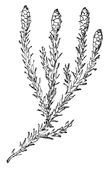
Club-moss.
|
These are very beautiful mosses, of a bright green colour, growing in moist places. There are about 200 species of club-mosses known. The common Lycopodium is its most characteristic member. It grows well with ferns under a glass case. |
| 10. Equisetaceæ (Horsetails). | |
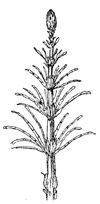
Horsetail.
|
The Equisetaceæ are the highest of the Acrogens, and nearly resemble the Endogens; they grow in ditches and pools, have a hollow stem with joints at regular intervals from each of which a whorl of green modified leaves arises; they are very full of earthy matter (silica), and one kind (Equisetum Hyemale), called Dutch Rush, is so rough with it that it is used for polishing and scraping many articles. |
The second division of the vegetable kingdom are the Endogenæ, which are those plants growing from a central bud only, as the palms, bamboos, and canes of all kinds, the grasses and all graminiferous or grain-bearing plants, as wheat, barley, &c. They have but one cotyledon in the seed and have no bark, but in place thereof a kind of natural varnish or thin coating of silica; this varnish or external polish is seen in the stalks of corn and on canes. Their leaves are often of great size, the veins run parallel to each other (fig. 8), they often grow from an expanded base which surrounds the stalk as in corn, and branch off at regular intervals making knobs or joints, as may be seen in the bamboo cane (figs. 9 and 10), in other cases they branch off spirally, and when fallen form a sort of trellis-work on the stem (as in some of the palms) but always in a regular manner. The wood of this family of vegetables has the same porous structure as cane (figs. 11, 12, 13,14), and is often hollow in the centre, becoming more and more solid according to the age of the tree. The stems of these plants are limited in growth and soon acquire their full size, which never exceeds eighteen or twenty inches in dia [Pg 148]meter although some of the palms are nearly 150 feet high. When the stem has acquired its full size, the continual production of more woody fibres makes it impossible that these (like the exogenæ) can have a very extended period of existence, for when every part of the stem is full of woody matter, the plant ceases to grow from obstruction to the circulation of the juices. The stems of some of this family are always hollow like the stalks of corn; this arrangement allows of great elevations without bending, [Pg 149] and is found to be the form which gives the greatest strength from a given quantity of material—one of those beautiful mechanical perfections of nature which man first admired and then endeavoured to imitate.



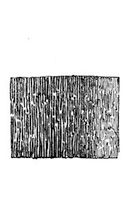
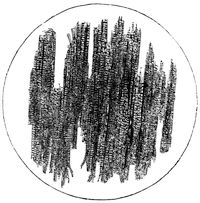
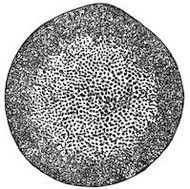
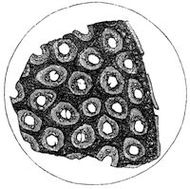
Some of the palms and other endogenæ are of a most beautiful form, and are moreover quite as useful as beautiful, furnishing food to the inhabitants of many regions, especially the Arabs of the Desert, who carry the dried fruit of the Date-palm with them, on crossing these vast plains of sand, as their chief food. The Plantain (Musa sapientum) forms a most beautiful and graceful object, with its enormous leaves springing up from the ground by their midrib in clusters, and extending upwards for 20 or more feet in graceful curves, affording a shady and cool retreat beneath them from the burning rays of the sun; the fruit is also one of the necessaries of life in the regions where they abound. The Fan-palm is another beautiful specimen, from the fan-like leaves of which the punkahs or Indian fans are made. The Palmyra palm furnishes leaves which are used to thatch houses, the sap is drunk as a refreshing beverage, and when evaporated yields a kind of sugar called "juggery," from which palm-wine is made.
The palms were amongst the first trees created, their fossil stems being constantly found; they were even then associated with the elephant and rhinoceros, and although these are found chiefly in the northern parts of Europe, yet it is much more reasonable to suppose that the climate of these parts has changed, than that these two favourites of the sunny regions should have had their natures changed.
Among the useful members of the endogenæ may be mentioned the Maranta Arundinaceæ, or Arrow-root plant, which is thus described by Dr. Baird:—"It is a genus of monocotyledonous plants, belonging to the natural order Cannaceæ or Marantaceæ, and composed of herbs which have a well-developed rhizome or tuberous root containing a large quantity of fecula or starch. The species are natives for the most part, of tropical America, a few being also found in India. The structure of the flowers is remarkable, and the fruit fleshy. The most important species is the Maranta Arundinaceæ, a plant which is extensively cultivated in the West Indies, the southern parts of the United States, and in the Isle of France, for the sake of its root, which affords the substance so well-known as Arrow-root. [Pg 151] This root consists of a tuber of a peculiar form, and contains a large proportion of fecula; the stem is upwards of three feet high, and the flowers are white, delicate, and small. In Cayenne the tubers are eaten by the natives, roasted, as a cure for intermittent fevers, and when bruised, are applied by them to wounds, and considered more especially as a specific against those caused by poisoned arrows, hence the name of Arrow-root."
According to Dr. Livingstone, the inhabitants of Angola live almost exclusively upon the Tapioca plant. He thus describes the mode of preparing it, &c.:—"They (speaking of the half-caste Portuguese) subsist chiefly on the Manioc, and as that can be eaten either raw, roasted, or boiled, as it comes from the ground, or fermented in water and then roasted or dried after fermentation and baked, or pounded or rasped into meal and cooked as farina, or made into confectionery with butter and sugar, it does not so soon pall upon the palate as one might imagine when told that it constitutes their principal food. The leaves, boiled, make an excellent vegetable for the table, and when eaten by goats, their milk is much increased. The wood is a good fuel, and yields a large quantity of potash.... The root, rasped while raw, placed upon a cloth, and rubbed with the hands while water is poured upon it, parts with its starchy glutinous matter, and this, when it settles at the bottom of the vessel and the water is poured off, is placed in the sun till nearly dry to form tapioca, the process of drying is completed on an iron plate over a slow fire, the mass being stirred meanwhile with a stick; when dry, it appears agglutinated into little globules, and is in the form we see in the tapioca of commerce."
Although none of this family of plants produce building timber (according to our notions of that article), yet it is questionable whether we have a greater number of uses for our exogenous woods than are found by the natives of those countries where the Endogenæ abound for palm stems and bamboo canes; as the Grecian styles of architecture arose from the imitation of structures of timber, so the Hindoo and Chinese styles have arisen from imitation of bamboo [Pg 152] buildings. There is scarcely a constructive use that can be imagined to which this convenient material is not applied. In the "Penny Cyclopædia" (article "Bambusa") is the following:—
"The purposes to which different species of bamboo are applied, are so numerous that it would be difficult to point out an object in which strength and elasticity are requisite, and for which lightness is no objection, to which the stems are not adapted in the countries where they grow. The young shoots of some species are cut when tender, and eaten like asparagus. The full-grown stems, while green, form elegant cases, exhaling a perpetual moisture, and capable of transporting fresh flowers for hundreds of miles; when ripe and hard, they are converted into bows, arrows, and quivers, lance-shafts, the masts of vessels, bed-posts, walking-sticks, the poles of palanquins, the floors and supporters of rustic bridges, and a variety of similar purposes. In a growing state the spiny kinds are formed into stockades, which are impenetrable to any but regular infantry aided by artillery.
"By notching their sides the Malays make wonderfully light scaling-ladders, which can be conveyed with facility where heavier machines could not be transported. Bruised and crushed in water, the leaves and stems form Chinese paper, the finer qualities of which only are improved by a mixture of raw cotton, and by more careful pounding.
"The leaves of a small species are the material used by the Chinese for the lining of their tea-chests. Cut into lengths and the partitions knocked out, they form durable water-pipes, or by a little contrivance are made into excellent cases for holding rolls of papers; slit into strips they afford a most durable material for weaving into mats, baskets, window-blinds, and even the sails of boats. Finally, the larger and thicker truncheons are exquisitely carved by the Chinese into beautiful ornaments. It is however more especially for building purposes that the bamboo is important (fig. 15). According to Marsden, in Sumatra the framework of the houses of the natives is chiefly composed of this material. In the floorings, whole stems four or five inches in diameter [Pg 153] are laid close to each other, and across these laths of split bamboo about an inch wide are fastened down with filaments of rattan-cane. The sides of the houses are closed in with the bamboo opened and rendered flat by splitting or notching the circular joints on the outside, clipping away the corresponding divisions within and laying in the sun to dry pressed down with weights. Whole bamboos often form the upright timbers, and the house is generally roofed in with a thatch of narrow split bamboos six feet long, placed in regular layers, each reaching within two feet of the extremity of that beneath it, by which a treble covering is formed. Another and most ingenious roof is also formed, by cutting large straight bamboos of sufficient length to reach from the ridge to the eaves, then splitting them exactly in two, knocking out the partitions and arranging them in close order, with the hollow or inner sides uppermost; after which a second layer with the outer or convex sides up, is placed upon the other in such a manner that each of the convex falls into the two contiguous concave pieces, covering their edges, the latter serving as gutters to carry off the rain that falls upon the upper or convex layer."
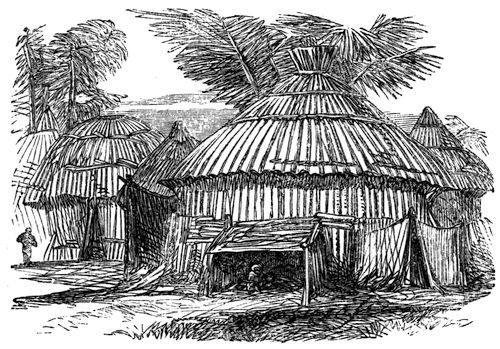
The Endogenæ are divided into twelve orders, as follows:—
1. Graminacæ (Grasses).
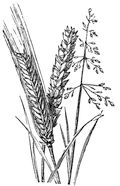
The Graminacæ comprise the great bulk of those plants which supply man and the lower animals with food, for it contains all the grasses and corn-bearing plants, including rice, maize, wheat, oats, barley, and rye. Upon these all the Ruminants of the earth feed, and millions of human beings taste no other kind of food. There are nearly 4000 species of graminaceous plants, rice and maize being the most broadly extended, forming the chief food of the Chinese, Hindoos, and other nations; wheat is here the most valuable grain, and is now grown in all parts of Europe and America. Humboldt, in his "Views of Nature," gives an interesting account of the first wheat grown in New Spain. He says:—
"A negro slave of the great Cortes was the first who cultivated wheat in New Spain, from three seeds which he found in some rice brought from Spain for the use of the troops. In the Franciscan convent of Quito I saw, preserved as a relic, the earthen vessel which had contained the first wheat sown in Quito by the Franciscan monk Fra Jodoco Rixi de Gante, a native of Ghent in Flanders. The first crop was raised in front of the convent, on the Plazuela di San Francisco, after the wood which then extended from the foot of the volcano of Pinchincha had been cleared. The monks, whom I frequently visited at Quito, begged me to explain the inscription, which, according to their conjecture, contained some hidden allusion to wheat. On examining the vessel, I read in old German the words,
"'Let him who drinks from me ne'er forget his God.'
"This old German drinking-cup excited in me feelings of veneration. Would that everywhere on the New Continent the names of those were preserved who, instead of devastating the soil by bloody conquests, confided to it the first fruits of Ceres."
| 2. Cyperaceæ (Sedges). | |
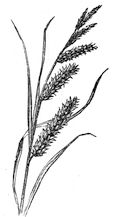
Sedges.
|
These plants much resemble the Grasses, they afford but little nourishment, however, to cattle, having but little starchy matter in them, and being but little succulent. The Cyperus Papyrus is the plant from which the ancient "papyrus" was made, and is probably (according to Dr. Baird) the plant termed in Scripture the Bull-rush. |
| 3. Araceæ (Arum tribe). | |
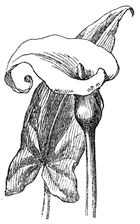
Arum.
|
The Araceæ include the Arum maculatum, or Cuckoo-pint, peculiar in having the flowers enclosed by a kind of sheath formed like a leaf, and called a "spathe." The "Portland Sago" is obtained from the Rhizome of this plant, but some of the species of this order are poisonous. The Dumb-cane (Caladium Segninum) paralyses the tongue, if chewed. [Pg 156] |
| 4. Typhaceæ (Bull-rush kind). | |
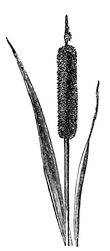
Bull-rush.
|
The Typhaceæ are the Bull-rush tribe, having the Typha latifolia or great Reed-mace for its characteristic member. It grows in ditches and marshy places. The young shoots of the Bull-rush, which resemble asparagus, are eaten by the Cossacks as food. |
| 5. Melanthaceæ (Colchicum kind). | |
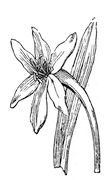
Meadow Saffron.
|
This includes many plants which have bulbous roots, some of them being poisonous. The Colchicum autumnale, or Meadow Saffron, is the type of this order; it grows in moist meadows, producing a purple flower which appears before the leaves. The root or bulb, and the seeds, are used in medicine. [Pg 157] |
| 6. Liliaceæ (Lily kind). | |
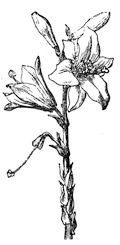
Lily.
|
The Liliaceæ are a very numerous tribe, including the Lilies, Hyacinths, and Tulips, the Onion, Garlic, Asparagus, the Cape Aloe, Yucca, and many others; they are for the most part bulbous plants, having simple leaves enclosing the stem. The Palms are included in this order; they are among the tallest and most graceful of the vegetable tribes, and in the countries where they abound are applied to almost every purpose that can be enumerated. |
| 7. Amaryllidaceæ (Narcissus kind). | |
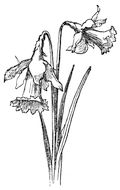
Narcissus.
|
The Amaryllidaceæ are the Narcissus tribe, including also the Agave, or American Aloe, and the Snow-drop. The greater number of species belonging to this order are natives of the Cape of Good Hope, some of these are poisonous; the juice of the Cape Blood-flower (Hæmanthus Toxicarius) is used by the Hottentots to poison their arrows with. [Pg 158] |
| 8. Iridaceæ (Crocus tribe). | |
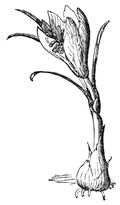
Crocus.
|
The Iridaceæ include the Crocus (Crocus sativa), the Corn-flag (Gladeolus communis), and the Blue-flag (Iris Germanica); the bulb of the Iris Florentina, is dried and used for various purposes, it has a scent resembling violets and is sold at druggists' shops by the name of orris-root, a corruption of iris-root. |
| 9. Orchidaceæ (Orchids). | |
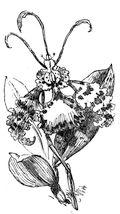
Butterfly Orchis. |
The family of the Orchis. Dr. Baird, in describing them, says:—"They are almost all herbaceous, a very few only being somewhat shrubby in their growth; some live in the ground, and besides the ordinary roots have bulbs or starch-bearing tubercles; others are what may be called pseudo-parasites, living attached to the bark of trees. These plants abound in the forests of tropical countries, where the climate is moist, and are generally known by the name of Epiphytes. The flowers vary very much in shape, form, and colour, and in many instances have a striking [Pg 159] resemblance to insects, various birds, and animals, as Oncidium, in which the resemblance is to butterflies, &c.; Cychnoches, in which (in one species) the likeness is strikingly similar to a swan; Peristeria, one species of which is called the Sprito-Santo plant, of Panama, and in whose flower there is the likeness of a dove descending upon the lip, &c. A curious fact in this part of their history is, that in the same plant, on the same stem, and even on the same head of flowers, we find flowers so different in appearance that we might place them in different genera." |
| 10. Naiadaceæ (Naiads). | |
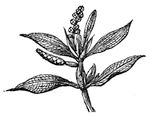
Pond Weed.
|
Water-plants, called "pond-weeds," and grow on both fresh and salt water. The marine species, Zostera marina, is dried and used for stuffing mattresses. |
| 11. Butomaceæ (Flowering Rushes). | |
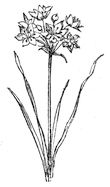
Flowering Rush.
|
Of this order the Butomas umbellatus, a sort of rush, producing very handsome pink flowers in umbels, growing in ditches and by the sides of rivers, is the most characteristic member. [Pg 160] |
| 12. Alismaceæ (Water Plantain). | |
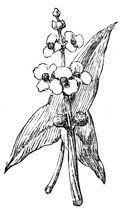
Water Plantain.
|
The two chief members of this order are the Alisma Plantago or Water Plantain, which grows in ditches, having its flowers in the form of panicles, and the Sagittaria sagittæfolia or Arrowhead. |
The third great natural family of plants are the Exogenæ. They comprise all the trees and shrubs of the temperate and colder regions, together with many of the flowering plants. They are characterised by certain peculiarities which can be at once recognised, such as the twisted and branched form of the stem, the possession of bark, leaves having the veins covering them running in all directions and forming a network, and the seeds containing two cotyledons; the wood, moreover, is deposited in rings (figs. 16, 17, 18, 19), one of which is formed every year, by the new wood being produced on the outside of the old, and between it and the bark. This deposition takes place as follows: after the rains of winter and early spring have well saturated the earth with moisture, and the warmth of spring has begun to penetrate to the roots of the plants, a development of the points of each fibrile or radicle takes place, forming new spongioles; these, being formed of new porous cellular tissue, begin to absorb (by endosmose) the moisture of the earth, which entering at all these thousands of minute spongioles at once, collects and rises in the vessels of the trunk and branches, [Pg 161] and arriving at the vessels forming a plexis on the surface of every leaf, begins to be changed by the action of the sun's rays, absorbing carbon and giving out oxygen from the carbonic acid always contained in the air. The sap [Pg 162] which has thus risen is the juice of the earth in which the plant grows, containing several earthy salts and vegetable extract drawn from the manure or decaying vegetation contained in the mould, together with carbonic acid dissolved in the fluid; this carbonic acid is changed by the sun's rays as well as that which was contained in the air, and the carbon uniting with the watery part of the sap, forms the green substance before alluded to, called chlorophyll, which is the green colouring matter of all plants, and is the basis of the wood. The altered sap descends between the wood and the bark, and forms a deposit gradually, which at the end of the year is a complete ring of wood surrounding the wood of former years. This circulation of juices continues through the summer, until, the cold weather coming on and the light being diminished, the sap neither rises nor is the leaf nourished by it, when it decays and falls off.
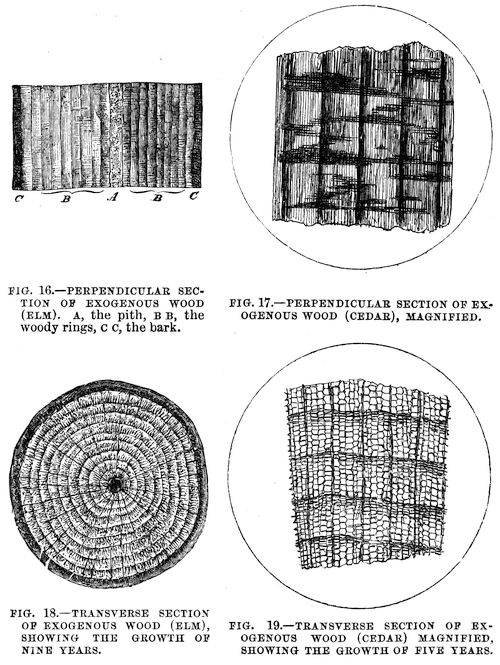
The age of exogenous wood can be ascertained—where the centre has not decayed—by counting the rings, one only being deposited every year; and it is truly astonishing to find that some trees will continue to live and flourish for several thousand years! There does not, in truth, appear to be any limit assigned to the life of an exogenous tree if it escape accidents; for, although decay inevitably attacks the heartwood, and a cavity is the result, yet, the new wood continuing to be deposited on the outer part, the vitality of the tree is kept up, and its size continues to increase.
The Baobab or Monkey Bread-fruit trees, growing at the mouths of the Senegal, have been estimated by Adinson to be upwards of six thousand years old, and are, in all probability, the oldest relics of organic life existing at the present time. The cedars of Lebanon are supposed to have existed longer than the records of history. The Yew at Braburn, in Kent, is at least three thousand years old; and that of Fortingal nearly as much.
Dr. Livingstone, describing the Mowana or Baobab tree (fig. 20), thus comments upon its power of withstanding injury:—
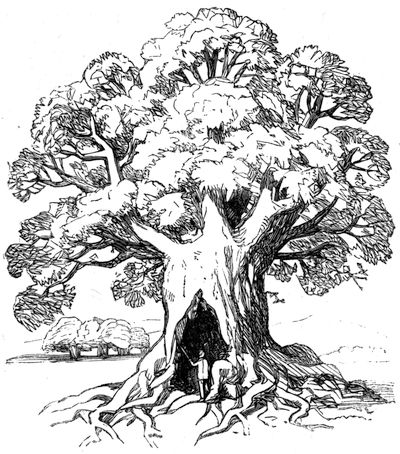
"No external injury, not even a fire, can destroy this tree from without, nor can any injury be done from within, as it is quite common to find it hollow, and I have seen one in which twenty or thirty men could lie down and sleep as in a hut. Nor does cutting down exterminate it, for I saw instances in Angola in which it continued to grow in length, after it was lying on the ground. Those trees, called exogenous, grow by means of successive layers on the outside; the inside may be dead, or even removed altogether, without affecting the life of the tree; this is the case with most of the trees of our climate. The other class is called endogenous, and increases by layers applied to the inside, and when the hollow of the tree is full, the growth is stopped, and the tree must die. Any injury is felt most [Pg 164] severely by the first class on the bark, by the second on the inside, while the inside of the exogenous may be removed, or the outside of the endogenous may be cut, without stopping the growth in the least. The Mowana possesses the power of both. The reason is, that each of the laminæ possesses its own independent vitality; in fact, the Baobab is rather a gigantic bulb run up to seed than a tree. The roots, which may often be observed extending along the surface of the ground forty or fifty yards from the trunk, also retain their vitality after the tree is laid low, and the Portuguese now know that the best way to treat them is to let them alone, for they occupy much more room when cut down than when growing."
On examining the wood of the exogenæ, it will be found that in the very centre is a small column of cellular tissue, called the pith, and that from this, fine layers of the same substance radiate towards the circumference. These are called the medullary rays, or silver-grain; they form an exterior layer or ring of cellular substance on the outside of the wood, which is called the cambium. The lightness of wood is owing to its porosity, and, on examining a transverse section under the microscope (figs. 17 and 19), it will be seen how little of real space is occupied in wood by solid substance. The spaces between the wall-work of woody matter in the tree are all filled with sap, and hence it is that "green wood" is so much heavier than that which is well seasoned. It is its lightness and strength, together with the ease with which it can be cut and fashioned, which renders wood so exceedingly useful; but its inflammability and liability to decay are great barriers to its more general use.
The leaves of the exogenæ have their veins always in the form of a network, and not running parallel with each other, as in the endogenæ (fig. 21).
Of the three divisions of the vegetable kingdom, the exogenæ alone furnish building timber, properly so called, and it is doubtful whether nature has supplied a more generally applicable substance than wood; being a bad conductor, it can be handled in the coldest weather, which [Pg 165] metal cannot, and, being easily cut or split, can be fashioned into almost any form.
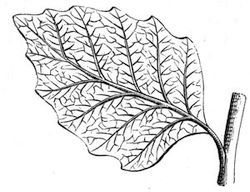
The woods mostly in use for general purposes are the different kinds of pine, as American Pine, Norway Pine, yellow and white Deal, Mahogany, Oak, Beech, Elm, Ash, and Maple. In the "Penny Cyclopædia," under the article "Wood," is the following description of the different kinds used by cabinet-makers, &c.:—
"The woods that are used by the cabinet-maker for furniture of a more delicate kind are called 'fancy woods.' The use of these has become much more general since the introduction of the art of veneering, and now that this is done by machinery instead of by hand, a number of woods are used for furniture and other purposes, which, on account of their scarcity, could have been formerly used only to a very limited extent. The most common of the fancy woods, and that which is most used by cabinet-makers, is Mahogany. This wood is the produce of the 'Swienteria Mahogani.'
"Next in point of importance and use to Mahogany, is Rosewood. This wood obtains its name from its fragrance, and is the produce of a mimosa from the forests of Brazil; in veneering it affords about eight plates to the inch.
"King-wood is a beautiful wood much in use, brought from Brazil in logs four feet long and about five inches wide, and is used only for delicate articles; it is said to be the [Pg 166] produce of a species of Baphia, a genus of Leguminous plants.
"Beef-wood is a very heavy wood of a pale red colour, and is brought from New Holland in logs nine feet long and thirteen or fourteen inches wide; the tree from which this is obtained is unknown to botanists, as well as most of those producing the fancy woods of commerce.
"Tulip-wood is brought into the market in very small pieces, not more than four feet long and five inches in diameter, so that probably it is the production of a shrub; it is clouded with red and yellow colours, and is used for bordering and for making small articles, such as caddies and work-boxes.
"Zebra-wood is probably the production of a large tree, as it is cheap enough to be made into tables, pianofortes, &c.; it is coloured brown on a white ground and clouded with black.
"Satin-wood is of a brilliant yellow colour with delicate glowing shades. It is the produce of a plant called Chloroxylon Swienteria, a native of India; it is one of the trees that yield the wood-oil of India, and belongs to the natural order Cedrelaceæ, the same order in which the mahogany is placed; it is found in the market in logs two feet wide and seven or eight feet long.
"Sandal-wood is the produce of a species of Sandoricum belonging to the family Meliaceæ; the wood is of a light brown colour with golden-coloured waves.
"Ebony and Iron-wood are the names given to some very hard woods, the produce of the natural order Ebenaceæ. These woods are mostly brought from India, although some of the species are found in Europe and America.
"There are several other woods occasionally used amongst cabinet-makers, of which little is known, either with regard to the places they come from, or the trees to which they belong. Canary-wood has a yellow colour; Purple-wood has a purple colour, without veins; Snake-wood is of a deep colour with black shades; Calander-wood is a handsome cheap wood taking a high polish, and is brought from Ceylon.
"Other woods are named after the places they come from, as Coromandel-wood, Amboyna-wood, &c."
Woods are largely used as dye-stuffs; the chief of these is log-wood, which has a deep red colour, is very heavy and solid, and yields a great deal of red colouring matter. It is very astringent, and contains tannic and gallic acids, from which properties it produces a deep black colour when mixed with any of the salts of iron; from this peculiarity it is very valuable as a black dye, but the black dye so extensively used for dyeing cloth, is, for the most part, made from galls, or "nut-galls," as they are sometimes called. These are hard round substances found growing on many species of oak, chiefly the "Quercus infectoria," and the best are brought from Aleppo; they are diseased growths produced by a little insect, called the "Cynips Quercus," which deposits its eggs under the epidermis of the leaf, and the juice collects and forms the gall (fig. 22), from the interior of which the larva eats its way out; thus it will be found that every gall must have a little round hole in it, whence the larva of the cynips has issued.

The root of the Madder plant (Rubia tinctorum) produces the most beautiful and permanent of our red dyes, and the cochineal insect (Coccus cacti) obtains its colour from feeding upon the cactus.
A useful and very permanent blue dye is obtained from Indigo, a kind of extract from the plant "Indigofera," growing in India and other places, and many other members of the vegetable kingdom yield dyes and colours used in the arts.
Amongst the various and almost endless purposes to which wood is applied, that of serving as a material to engrave on and print from must not be omitted. The wood used for this purpose is that of the box-tree (Buxus sempervirens), which furnishes a close, even-grained, hard wood, admirably suited to the purpose; and the cultivation and perfecting of this most admirable art, has produced an [Pg 168] improvement in book-illustrating which can hardly be sufficiently appreciated.
Wood must have supplied one of the earliest materials with which to erect buildings; the Grecian styles of architecture, beyond doubt, were derived from imitating in stone those structures first made of wood. All the largest members of the vegetable kingdom belong to this division; and indeed the same may be said of size which has been said of age, namely, that there is no limit except from accidental circumstances.
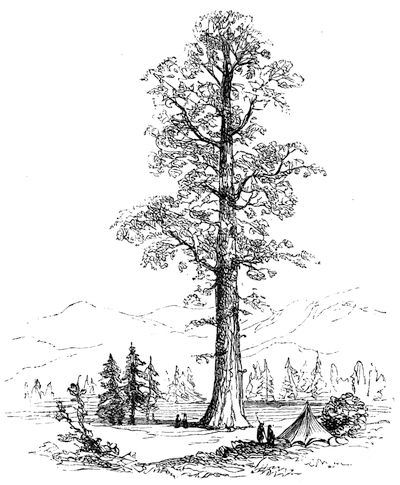
In the Crystal Palace at Sydenham is a most wonderful and gigantic specimen of the Wellingtonia Gigantea (fig. 23), one of the class of trees called coniferous, and belonging to the exogens, the bark of which has been stripped off in [Pg 169] portions at the place where it grew, each of which being numbered, has enabled them to be re-adjusted in their original places, the result of which is, the whole bark of this most magnificent tree appears as if growing on the timber. It measures 31 feet across at the base, and 93 feet in circumference; the original tree was 363 feet in height, its present height is 116 feet, and the bark is 18 inches thick. The Norfolk Island Pine (Araucaria excelsa) sometimes grows to 300 feet in height, and Humboldt, describing a specimen of the Pinus Trigona, says, "This gigantic fir was measured with great care; the girth of the stem at 6-1/4 feet above the ground was often 38 to 45 feet; one stem was 300 feet high, and without branches for the first 192 feet."
As the exogens grow by the addition of woody matter to their circumference, of course the older the tree (other conditions being equal) the larger will be the trunk, but as the new wood is added to the outside, the centre loses its vitality and is liable to the attacks of both animal and vegetable parasites, and is therefore constantly found either decayed or totally destoyed; this is not, however, invariably the case, and many instances are found of wood of a great age remaining sound in the centre. At St. Nicholas in Lorraine is exhibited a plank of walnut wood made into a dining-table which is twenty-five feet wide. Besides timber for various useful purposes, this division of the vegetable kingdom furnishes us with both cotton and linen for clothing, and many of the dye-stuffs for ornamenting such clothing, also with many articles of food (although not so prolific in this respect as the Endogenæ), the potato, most green vegetables, as cabbages, lettuces, are exogenous, together with such roots as carrots, parsnips, &c.
To this class of plants belong many of the most beautiful flowers, and all our fruit-trees, not the least important of which is the fig-tree, although the fig can hardly be called a fruit in the strict sense of the word, being a consolidated mass of flowers within a receptacle. The figs of commerce are produced from the Ficus carica, the fruit being dried in the sun; they form a considerable article of commerce. The celebrated Banyan tree (Ficus indica, fig. 24) is one of the [Pg 170] fig tribe, it throws down branches (as do many others of this tribe) which take root in the earth and form fresh stems, so that one of the banyan trees with its off-shoots will cover a space of ground sufficient to shelter a regiment of cavalry, and many of the fig tribe, especially the sycamore (Ficus sycamorus), are planted for the sake of the shelter they supply by their broad crowns of leaves; another of the fig trees (Ficus elastica) supplies a great part of the India-rubber of commerce.
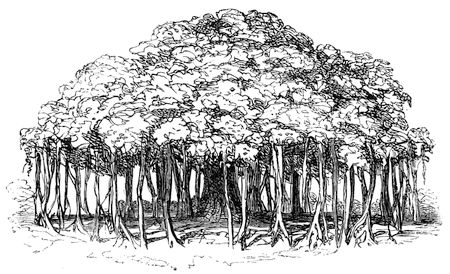
De Candolle divides the class of exogens into four sub-classes according to the arrangement of their flowers &c.; they are as follows:—
1. Thalamifloræ, the flowers of which are furnished with both calyx and corolla, the corolla having distinct petals, and the stamens hypogynous, that is, growing immediately from below the pistil.
2. Calycifloræ, having flowers with both calyx and corolla, the corolla divided into distinct petals, but the stamens always Perigynous, that is, growing upon the sides of the calyx.
3. Corollifloræ, having flowers with both corolla and calyx, the former having its petals united.
4. Monochlamydeæ, flowers without corolla and often without a calyx.
These four sub-classes have been divided into orders as follows:—
Orders of Thalamifloræ.
1. Nymphaceæ (Nymphæa alba) White Water-Lily.
(Nuphar luteum) Yellow Water-Lily.
This order contains water plants of great beauty, they grow in the mud at the bottom of the water, sending up long flower- and leaf-stalks so that the flowers may blossom in the air and the leaves float on the surface; the leaves are generally round and turned up slightly at the edges. The "Victoria Regia" is a magnificent specimen of this order; it originally came from Brazil, and has flowers a foot wide, leaves four or five feet across, and is sufficiently buoyant, it is said, to bear the weight of a child. The Lotus of the Nile, the blossom of which so frequently occurs on the carvings of the Egyptians as an offering to Isis, is another member of this order.
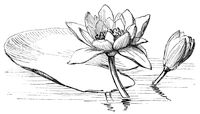
2. Papaveraceæ (Papaver somniferum) White Poppy.
(Papaver Rhœas) Red Poppy.

Opium is prepared from the unripe capsules of the White Poppy, it is chiefly cultivated for this purpose in India and Turkey. The Chinese are the great consumers of [Pg 172] opium, it being a common habit with them both to eat and smoke it. Opium is made by collecting the juice in the morning which has exuded from incisions made in the capsules over night; those employed for this purpose use a small knife with several blades and go round the plantations scarifying the capsules in the evening, and the juice which issues and forms a thick concrete matter, is scraped off, beaten up, and dried in round lumps. About £2,000,000 worth are exported from India annually.
|
3. Ranunculaceæ (Anemone coronaria) Garden Anemone. | |
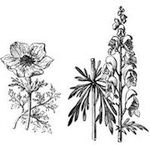
Garden Anemone. Monk's-hood.
| Besides the above examples, there are many beautiful flowers belonging to this order, as the Clematis and Peony. Members of this order are for the most part poisonous, and some of them, as Monk's-hood and Hellebore, are violently so, while even the Butter-cup is to a certain extent acrid. [Pg 173] |
|
4. Fumariaceæ (Fumaria officinalis) Fumitory. | |
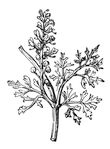
Fumitory.
| This order contains no plant of any importance. The common Fumitory derives its name from the supposed resemblance of the odour of its flowers to smoke. |
|
5. Brassicaceæ (Sinapis alba) White Mustard. | |
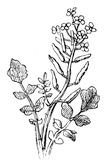
Water Cress.
| In this order are contained many of the useful occupants of our kitchen gardens, the Cabbage, Turnip, Cauliflower, Radish, and many more; they have nearly all a pungent taste, and some, as the Rape, yield seed producing much oil. The Water Cress is grown near London in square pools, into which some neighbouring stream is turned. These pools are arranged side by side, and those who gather the plants lie down on a plank of wood placed across. Enormous quantities are thus supplied to the London markets. [Pg 174] |
|
6. Cistaceæ (Helianthemum Vulgare) Helianthemum. | |
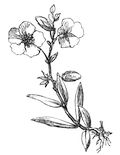
Helianthemum.
| These plants are for the most part evergreens; the Yellow Cistus is our most familiar example of the order. In Turkey the Rock-roses are much cultivated, they exhale a gum having a highly aromatic odour, which is there used as a perfume. |
|
7. Berberidaceæ (Berberis vulgaris) Common Berberry. | |
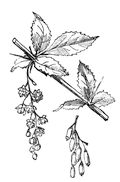
Common Berberry.
| The Berberry is commonly found in our hedgerows, and its fruit is sometimes eaten; in Italy it grows to a good-sized tree. It is remarkable as furnishing an example of vegetable motion, from the irritability of its stamens, which if touched will bend forward in a curved position, and touch the stigma with the anther, and after remaining a short time in that position the stamens recover their natural form. [Pg 175] |
|
8. Violaceæ (Viola odorata) Sweet Violet. | |
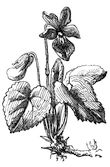
Sweet Violet.
| The well known Sweet-smelling Violet belongs to this order, which otherwise contains no plants of importance, except one, the Cephaelis Ipecacuanha, which produces the well-known emetic bearing that name. |
|
9. Droseraceæ (Drosera rotundifolia) Sun-dew. | |
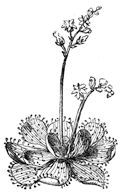
Sun-dew.
| The Sun-dew is so called from the globules of a sort of viscid liquid excreted by the hairs of this plant while in sunshine, and looking like dew; some species of this order have their leaves so irritable that an insect alighting on them causes them to shut up and catch it, hence the name "Venus's Fly Trap" (Dionea muscipula) which is given to an American species. [Pg 176] |
|
10. Polygalaceæ (Polygala vulgaris) Milk-wort. | |
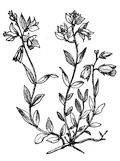
Milk-wort.
| The Polygala Senega, or Virginian Snake-root, is a member of this order; it is celebrated in America for the cure of the bite of snakes, and is used here as an expectorant. The Rhatany, a very powerful astringent, is also of this order. |
|
11. Caryophyllaceæ (Lychnis dioica) Bachelor's Buttons. | |
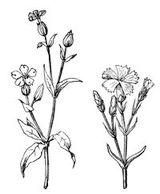
Bachelor's Buttons. Pink.
| There are upwards of a thousand species of this order, but none are of much importance; they form however many of our most beautiful ornamental garden flowers, of which the Carnation, Sweet William, and several others, are familiar to all. [Pg 177] |
|
12. Tiliacæ (Tilia Europæa) Lime Tree. | |
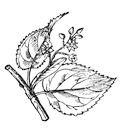
Lime Tree.
| The Lime Tree grows often to a great size, is a fine handsome tree, commonly found in our plantations, has heart shaped leaves, and flowers generally in corymbs; it is very general in tropical climates, and produces a fine close grained wood. |
|
13. Hypericaceæ (Hypericum perforatum) Perforated Hypericum. | |
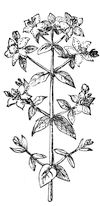
St. John's Wort.
| Many species of Hypericum are cultivated in our gardens, and form handsome flowers; the well known plant called Aaron's Beard (Hypericum calycinum) is a member of this order, and is remarkable for the long runners which it throws out forming fresh plants at intervals. It is often suspended in pots, from which these runners descend in a very graceful manner. |
14. Malvaceæ (Malva sylvestris) Common Mallow.
(Althæa officinalis) Marsh Mallow.

The Marsh Mallow has been much esteemed as a demulcent medicine, and an ointment is made from it for external use; but one species of this order, the Gossypium, is one of the most important plants in the whole [Pg 178] world, producing that most useful article, cotton, so largely grown in America, and for which the slave population are chiefly employed. The fine white hairs surrounding the seeds and filling up the pod is the part picked out and preserved, it forms the cotton-wool of commerce, of which some eight hundred millions of pounds' weight are used annually! employing a million and a half people, in England alone, and furnishing clothing to hundreds of millions. It is grown in India, which is supposed to be its native place, and will probably be grown to a much greater extent when railways and canals shall have made a more easy communication from the interior of that country to the sea-board.
|
15. Geraniaceæ (Geranium pyreniacum) Meadow Geranium. | |
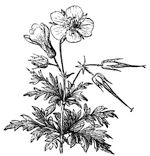
Meadow Geranium.
| Many species of this order are indigenous, and when cultivated produce some of our most beautiful garden flowers, as the Geraniums, Pelargoniums, and Erodiums. The Geraniums are those species which have five irregular petals and ten stamens; they are the most characteristic of the order. |
16. Linaceæ (Linum usitatissimum) Common Flax.
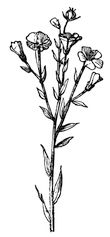
The Flax plant is another of those insignificant plants which, from certain properties they possess, have [Pg 179] become the greatest boons to mankind; the stalks of the Linum usitatissimum, soaked, bruised, and prepared by combing, &c., form the flax of commerce, from which all our linen fabrics are made. The manufacture of flax is one of the oldest arts known, the ancient Egyptians formed their mummy-cloths from this article, and a piece of one of these cloths, bleached and placed side by side with some of the present date, would hardly suffer by the comparison, but the rapidity of its manufacture, and the price at which supplied, are doubtless very different in the two cases.
The value of the linen manufacture of Great Britain is between seven and eight millions yearly.
The seeds of the flax plant (Linseed) are used to crush and produce the linseed oil of commerce so extensively used in the production of paints and varnishes, and the cake is used as food for cattle.
|
17. Aceraceæ (Acer campestre) Maple Tree. | |
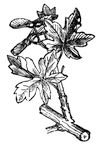
Maple Tree.
| This order contains the Maple and Sycamore, fine trees, not only ornamental, but producing wood much in request, moreover the Acer saccharinum or Sugar Maple of North America is used to produce sugar, which is obtained from its sap. [Pg 180] |
|
18. Rutaceæ (Ruta graveolens) Rue. | |
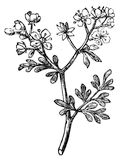
Rue.
| Rue is a well-known shrub with small pinnate leaves, and possessing a strong and very disagreeable odour; this depends upon the volatile oil which is contained in the glands with which the leaves are dotted. It has been, from time immemorial, used as a medicine. Another member of this order, the Buchu (Diosmia crenata), is also used medicinally. |
|
19. Oxalidaceæ (Oxalis acetosella) Wood Sorrel. | |
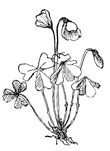
Wood Sorrel.
| The Wood Sorrel is very acid, and from its juice is made the salt of sorrel (which is bin-oxalate of potash), used to get out ink and iron stains from linen, &c. This is supposed to be the true Shamrock. |
This completes the orders of Thalamifloræ, which, with the following sub-class, Calycifloræ, contain all our star-like flowers, or those in which the corolla forms a whorl or open ring of petals. The third sub-class contains those chiefly in which the flowers form cups or bells.
Orders of Calycifloræ.
|
1. Celastraceæ (Euonymus Europæas) Spindle Tree. | |
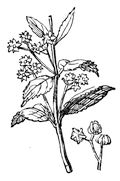
Spindle Tree.
| This order consists of shrubs or small trees growing in the temperate regions of most parts of the world, and some of the species, as Celastrus venatus, are said to be poisonous; the seeds of the South African species are used to express oil from. |
|
2. Rhamnaceæ (Rhamnus catharticus) Buckthorn. | |
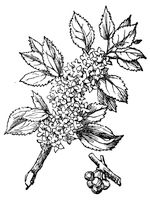
Buckthorn.
| Buckthorn berries afford a juice which, when made into syrup with sugar, is a popular purgative medicine; the juice precipitated with lime produces the green pigment known to artists as "sap green." The "French Berries" used as a yellow dye-stuff are procured from a species of Rhamnus. [Pg 182] |
|
3. Fabaceæ, or } (Cytisus scoparius) Broom. | |

Broom.
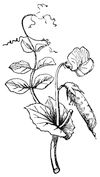
Garden Pea.
| The plants producing pods or legumes are among the most important of the orders of this class, giving us very many useful and nutritious plants, which, for the most part, are climbers, as Peas, Beans, &c. The Tamarind and Cassia trees belong to this order, also those which produce gum-arabic, catechu, logwood, and indigo. There are between six and seven thousand species of the Leguminosæ. |
4. Rosaceæ (Rosa centifolia) Hundred-leaved Rose.
(Fragaria vesca) Wood Strawberry.
(Rubus fruticosus) Bramble.
(Pyrus communis) Pear Tree.
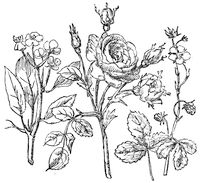
This important order yields us our most beautiful flower, the Rose, of which there are a great many varieties, among which the Dog-rose—that beautiful ornament to our hedges—deserves to hold a conspicuous place, [Pg 183] also the Sweetbriar or Eglantine. The rose is used in Turkey and Persia for obtaining that most valuable and delicious perfume, "Otto of Roses." It is made by distilling a portion of water from several quantities of fresh roses, until it becomes saturated with the volatile oil. This water is then exposed to the open air, and, in the cool night time, drops of the otto collect on the top, from which it is carefully gathered, and the same water again distilled from a fresh quantity of roses. Besides the Rose tribe, this order contains some of our most valued fruits. The Apple, Pear, and Strawberry belong to it, also the Almond.
|
5. Lythraceæ (Lythrum salicaria) Purple Loose-strife. | |

Loose-Strife.
| The Purple Loose-strife is indigenous to England, bearing a purple flower, and is also found in Australia. There are several varieties of this plant; an Indian species, Lythrum Hunteri, bearing a red flower, has been used by the natives as a red dye. [Pg 184] |
|
6. Onagraceæ (Epilobium angustifolium) French Willow. | |

French Willow.
| This order contains some very beautiful flowering plants, as the Evening-primrose (Enothera biennis), Fuchsia, &c. of which there are a great many varieties; they abound plentifully in America, of which country the Evening-primrose is said to be a native. |
|
7. Myrtaceæ (Myrtus communis) Myrtle. | |
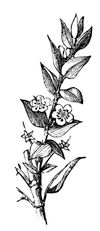
Myrtle.
| The Myrtles are, for the most part, inhabitants of the warmer climates. They are shrubs or trees, and sometimes of great size and beauty; the flowers and leaves of many species are odorous. There are upwards of fifty species of Myrtle, and they are found in most of the warmer parts of the Old and New Worlds. [Pg 185] |
|
8. Crassulaceæ (Sempervivum tectarum) House-leek. | |
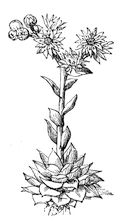
House-leek.
| The species of this order have, most of them, thick succulent leaves. The Sedums, Stone-crop, and House-leek, are among the most common, growing in dry, earthy matter, on walls or housetops; they, nevertheless, are full of a milky juice. The juice of Houseleek mixed with cream has been a long time a popular remedy for various external complaints, but, like most popular remedies, does neither good nor harm. |
|
9. Grassulariaceæ (Ribes rubrum) Red Currant. | |
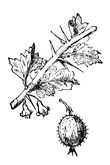
Gooseberry.
| The Gooseberry and Currant are members of this order. They are useful plants for the kitchen-garden, and afford a grateful and wholesome fruit, although unripe gooseberries (eaten raw) are extremely unwholesome, as the acid they contain is the "oxalic." [Pg 186] |
|
10. Saxifragaceæ (Robertsonia umbrosa) London Pride. | |
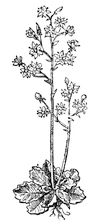
London Pride.
| These are plants growing, for the most part, in mountainous regions, and in the crevices of rocks. The London Pride and Hydrangea are the best known, the latter producing very large corymbs of flowers. They occur in temperate climates in most parts of the world. |
|
11. Apiaceæ, or } (Fœniculum officinale) Fennel. | |

Fennel.
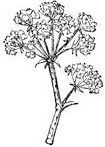
Hemlock.
| Contains many of our useful vegetables, as the Carrot (Daucus Carota), Parsnip (Pastinaca), &c. The Celery also, and many of our aromatic seeds, are produced by the Umbelliferæ, as Anise, Carraway, Dill, Coriander, and Fennel. Some members, however, are poisonous, as Hemlock (Conium Maculatum), and Cow-bane or Water Hemlock (Cicuta Virosa). |
Orders of Corollifloræ.
|
1. Cucurbitaceæ (Cucurmis melo) The Melon. | |
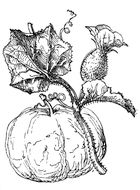
Melon.
| The Cucumber (Cucurmis Sativa), the Melon (Cucurmis Melo), both esteemed as delicacies, are of this order. Also the numerous tribe of Gourds (Cucurbita), as the Pumpkin, Large Gourd, Bottle Gourd, Squash, &c., also the Vegetable Marrow. Gourd-shells form the most common vessels for holding liquids, in many parts of Asia. |
|
2. Cornaceæ (Cornus Sanguinea) Dogwood. | |
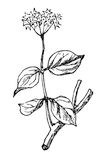
Dogwood.
| These plants are chiefly shrubs or trees, growing in most temperate regions, and especially in America. The Cornelian Cherry (Cornus muscula) produces a berry somewhat resembling a cherry. Some species are used in America as a tonic medicine. [Pg 188] |
|
3. Caprifoliaceæ (Sambucus nigra) Elder Tree. | |
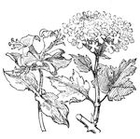
Honeysuckle. Guelder Rose.
| This order contains few plants of any importance. The Honeysuckle is a very favourite ornamental plant, and the fruit of the Elder produces the Elderberry-wine so much used on Christmas Eve, with toasted bread, in many parts of the country. |
|
4. Galiaceæ (Galium cruciatum) Cross Wort. | |

Cross-wort.
| The root of the Madder is one of our most important "dye-stuffs," producing the most permanent reds and browns used in dyeing. It is a native of the south of Europe and of Asia. Animals fed upon madder are found to have their bones tinged of a red colour. [Pg 189] |
|
5. Valerianaceæ (Valeriana officinalis) Valerian. | |
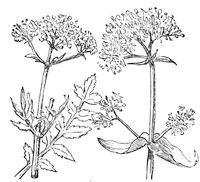
Valerian. Red Valerian.
| |
Valerian is indigenous, growing by ditches, and bearing a pink flower; the root is used in medicine, and has a most disagreeable odour. Several species are cultivated as ornamental garden flowers; there are about 125 species. | |
|
6. Dipsacaceæ (Dipsacus fullonum) Teasel. | |
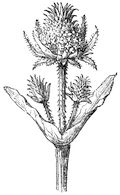
Teasel.
| The heads of the Teasel were formerly used, to an enormous extent, for carding cloth, and were cultivated largely in some parts for that purpose—wagon-loads of them were brought to the cloth-dressers—but their use is now, to some extent, superseded, the process called "teaselling" being frequently performed by machinery. [Pg 190] |
|
7. Asteraceæ (Tussilago Farfara) Coltsfoot. | |
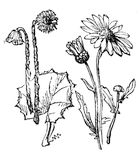
Coltsfoot. Ox-eye Daisy.
| The members of this family have a star-like inflorescence, as the Sunflower, China Aster, &c.; the centre part or eye, being composed of undeveloped florets, is frequently, by cultivation, almost lost, forming florets which are added to the ray. |
|
8. Campanulaceæ (Campanula rotundifolia) Hare-bell. | |
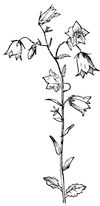
Harebell.
| Comprise the various "Bells," which form of inflorescence is characteristic of the Corollifloræ. There are about 500 species of this order, the flowers of which are for the most part of a blue or purple colour; the Hare-bell is also known as the "Bluebell of Scotland." [Pg 191] |
|
9. Ericaceæ (Calluna vulgaris) Heather. | |
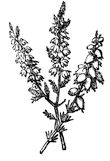
Grey Heath.
| The Heaths are, for the most part, social plants, growing in great numbers on waste ground, and giving great beauty to scenery. The Heather gives a peculiar aspect to the hills of Scotland. Humboldt observes, "It is curious that, out of more than 300 species of Erica, one only should be found throughout the whole American continent." |
|
10. Gentianaceæ (Gentiana campestris) Field Gentian. | |
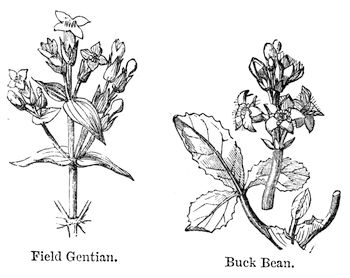
| |
This order contains no member of great importance; the Gentian-root, much used as a tonic, is the product of the "Gentiana Lutea." [Pg 192] | |
|
11. Primulaceæ (Anagallis arvensis) Pimpernel. | |
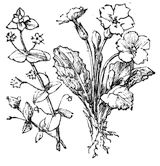
Pimpernel. Primrose.
|
These well-known and beautiful flowers form ornaments to our meadows, hedgerows, and gardens; the Oxlip, Polyanthus, and Auricula belong to this order, of which many varieties are produced by cultivation. |
|
12. Convolvulaceæ (Calystegia sepium) Bindweed. | |
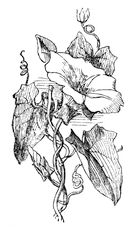
Bindweed.
| The Bindweeds are gay and beautiful flowers, and besides being used for ornamental purposes, many of this order have medicinal properties of great importance. The Jalap root is from the Convolvulus Jalapæ, which comes from Xalapa, in Mexico, of which name Jalap is a corruption. Scammony, another medicine much used, is a resin procured from a species of this order. [Pg 193] |
|
13. Boraginaceæ (Borago officinalis) Borage. | |

Borage.
| The members of this order have most of them rough hairy leaves, they contain a certain amount of nitrate of potash in their juices, and it is this which gives them the peculiar taste which has gained for them the name of "Oyster plants;" the common Borage has been used as a remedy for coughs. |
|
14. Liniaceæ, or } (Salvia officinalis) Sage. | |
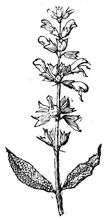
Sage.
| The name Labiates has been given from the form of their infloresence, which is generally "Labiate" (having lips); they frequently possess aromatic properties, and are mostly of a strong smell. Although not commonly used as food, yet most of them are employed to flavour it, as Mint, Thyme, Sage, and many more. [Pg 194] |
15. Solanaceæ (Atropa belladonna) Deadly Nightshade.
(Solanum tuberosum) Potato.
(Capsicum annuum) Capsicum.
(Hyoscyamus niger) Henbane.
(Nicotiana Tabacum) Tobacco.
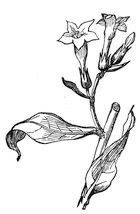
A great many members of this order are poisonous, among which the Deadly Nightshade (Atropa Belladonna) is the most virulent, there are also Henbane and Tobacco, both strong poisons; but, to compensate for this bad character, the order contains one of the most useful vegetables used in Europe—the Potato. This is the tuber of the "Solanum tuberosum." The following account of the introduction of the Potato into England is from the "Penny Cyclopædia":—
"Queen Elizabeth, in 1584, granted a patent 'for planting and discovering in new countries, not possessed by Christians,' and, under this sanction, some ships, principally equipped by Sir Walter Raleigh, sailed with him to America. Thomas Harriott (afterwards known as a mathematician) who accompanied the adventurous squadron, transmitted to England the description of a plant, called Openawk by the natives of that part of America, which the courtier-like gallantry of Raleigh had named 'Virginia.' Harriott described the Openawk as having the roots round, and 'hanging together as if fixed on ropes, and good for food either boiled or roasted.' Girarde in his Herbal a few years subsequently, distinguished the plant by a plate, and not only confirmed the assertion that it was an indigenous production of Virginia, whence he himself had obtained it, but [Pg 195] supplied some curious details of its qualities, and of the various modes in which it might be dressed for the table. But the Potatoe had been known in Spain and Portugal at an earlier period, and it is from the latter country that we most directly derive the name by which we know it. This is easily shown; although the natives of South America called the plant by the name 'Openawk,' those of the South, more particularly the inhabitants of the mountains of Quito, called it 'Papas,' which the Spaniards corrupted into 'Battata,' this again their neighbours in Portugal softened into 'Ba-ta-ta' (da terra), to which 'potato' is a very close approximation."
This plant, the tubers of which for a long time were a luxury obtainable by the rich only, now yields the support of the poor, and furnishes the cheapest food known; the peasantry of Ireland almost subsist upon Potatoes, and the poor of most parts of Europe find it indispensable to their living.
|
16. Scrophulariaceæ (Digitalis purpurea) Foxglove. | |
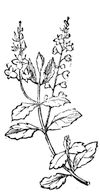
Speedwell.
| Some of the members of this order were formerly considered useful in scrofulous complaints, especially the Scrophularia nodosa, a common plant growing by the sides of ditches, and whose tuberculated roots were considered to resemble scrofulous tumours, and therefore to be the natural remedy for them. The Foxglove is used as a medicine and is highly poisonous. [Pg 196] |
|
17. Lentibulariaceæ (Pinguicula vulgaris) Butterwort. | |
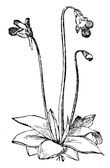
Butterwort.
| This order includes the Butterworts, which are herbaceous indigenous plants, growing in ditches and wet places; they are divided into the Pinguicula and the Urticularia. The example given is the most common and characteristic of the order. |
|
18. Plantaginaceæ (Plantago lanceolata) Plantain. | |
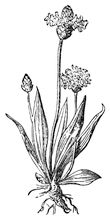
Plantain.
| The common Plantain or Way-bred is found by roadsides, the leaves form a sort of star on the ground, from the centre of which a tall stalk arises, forming a "spike" of flowers. The seeds of plantain are much in request by bird fanciers, cage-birds being fond of them. The leaves were once in great repute as a styptic, or application for stopping the bleeding of wounds. [Pg 197] |
|
19. Plumbaginaceæ (Armeria maratima) Thrift. | |
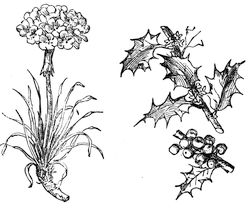
Thrift. Holly.
| |
The most characteristic of this order are the two examples given, especially the Holly, which is universally known and admired for the decorative uses to which it is applied in our churches and houses at Christmas time. | |
Orders of Monochlamydeæ.
|
1. Sanguisorbeæ (Alchemilla vulgaris) Ladies' Mantle. | |
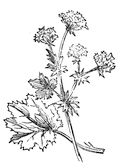
Ladies' Mantle.
| Some species of this order, especially the Greater Burnet (Sanguisorba officinalis), were once much cultivated as food for cattle, but it is now superseded by other plants, especially Sainfoin. [Pg 198] |
|
2. Chenopodiaceæ (Beta vulgaris) Beet. | |
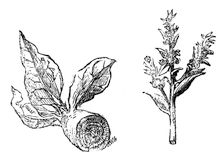
Beetroot.
| |
The most important species of this order is the Beetroot, employed in France for the production of sugar. Its variety, Mangold-wurzel (Beta altissima), is also extensively used as food for cattle. | |
|
3. Polygonaceæ (Polygonum Fagopyrum) Buckwheat. | |
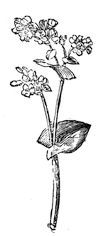
Buckwheat.
| Buckwheat is used as food in America and other places, and the root of the "Rheum palmatum" furnishes the Rhubarb of commerce. It is brought from Turkey; but is grown in China, and thence passes through the hands of Russians to Turkey. Other species of Rhubarb, as "Rheum compactum," are cultivated here for the sake of the leaf-stalk, which has an agreeable acid taste, and is much used for making tarts and puddings. [Pg 199] |
|
4. Elæagnaceæ (Elæagnus angustifolia) Oleaster. | |
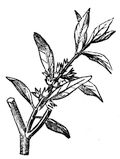
Oleaster.
| Some foreign species of the Oleaster are extremely fragrant, and others, especially those of India, produce a fruit of a pleasant taste and is there eaten. The Sea Buckthorn (Hippophæ Rhamnoides) is the only English species. |
|
5. Thymelaceæ (Daphne pontica) Spurge Laurel. | |
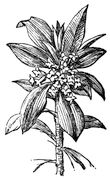
Spurge-Laurel.
| Some species of this order are cultivated in gardens and are very fragrant, others partake of a poisonous quality; the Daphne mezerium, the bark of which is very acrid, is used in medicine, and forms one of the ingredients in the celebrated compound decoction of Sarsaparilla. |
6. Corylaceæ (Castanea vesca) Sweet Chestnut.
(Quercus pedunculata) Oak.
(Corylus avellana) Hazel Nut.
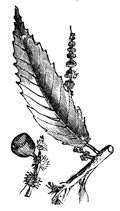
This order contains some of our finest trees; the Oak, that prince of trees, is of this order. It attains a great age and size, and there are some celebrated specimens [Pg 200] existing which have stood many centuries. Oaks constitute the greater part of the forest trees, both on the Continent and in England; great numbers are cut in France for fire-wood, and in both countries for ship-building. The roof-timbers of our old churches and halls are nearly all oak. The bark of the oak is largely used for tanning leather. About 30,000 tons are imported into this country yearly for this purpose, besides the product of our own trees. The bark of the Cork-oak (Quercus suber) is used for making corks, some 2,000 tons of this are imported annually. Moreover, the Gall-nut used in tanning, and also to make black dye, is the product of an oak. The Chestnut is a fine tree, the nuts of which are commonly eaten by the peasantry of Spain and Italy as food; the tree grows to a great age and to an enormous size.
|
7. Euphorbiaceæ (Buxus sempervirens) Box. | |
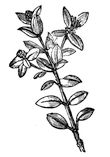
Box.
| Many species of this order are acrid and poisonous, and have been used for poisoning arrows. The Castor-oil plant (Ricinus palma-christi), and the plant that yields that most violent purgative, Croton-oil (Croton tiglium), are of this species; also the Box-tree, from which that useful wood, known as box-wood, is obtained. [Pg 201] |
|
8. Urticaceæ (Urtica urens) Stinging Nettle. | |

Hop.
| The Nettle in Australia grows to the size of a tree; the Hop also belongs to this order, and is largely cultivated in Kent and Sussex for the use of brewers, as it communicates an agreeable bitter to beer which no other plant seems to be able to substitute. |
|
9. Salicaceæ (Salix alba) White Willow. | |
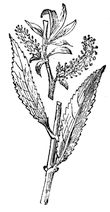
White Willow.
| The most characteristic of this order are the examples given; the Willows are well-known trees, growing by the margins of water and in damp places. The Poplar is one of our tallest trees, specimens being known 100 feet high; its peculiar tall form distinguishes it from all other trees. [Pg 202] |
|
10. Betulaceæ (Betula alba) Birch. | |
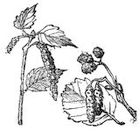
Birch. Alder.
| The Birch and Alder are both well known trees in our plantations, the Alder is often confounded with the Elder. The bark of the Birch tree contains tannin; it is used to tan skins in Russia, and gives to Russian leather its peculiar qualities. |
|
11. Ulmaceæ (Ulnus campestris) Elm. | |
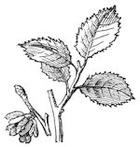
Elm.
| The Elm is one of our largest and noblest trees, growing to 80 or 90 feet high, it has often a girth of 10 to 11 feet, and forms a very fine tree with a broad crown; the wood is much used for making coffins. |
|
12. Pinaceæ (Taxus baccata) Yew. | |
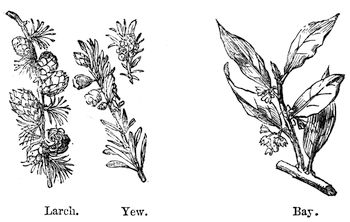
| |
This order contains the various Pines and Firs, together with the Yew and Bay trees, and is sometimes called [Pg 203] the "Coniferæ," as they all bear cones. In their general aspect many of these somewhat resemble endogenous trees, growing perfectly straight in the stem, and giving off branches in whorls at regular distances; some, as the Norfolk Island Pine, form perfectly regular figures by the interlacement of their branches. The Firs have their thin narrow leaves starting off singly from the branch, and always on the upper side, like the teeth of a comb, while the Pines have their leaves grouped together, starting off in fours or fives from the same spot. The Conifera furnish the longest and straightest timber of all trees, they commonly grow to 100 feet high, and in New Zealand and California to more than 300. The Wellingtonia Gigantea is the tallest species known, and the Araucaria Excelsa (Norfolk Island Pine), perhaps, the next. The trees of this order are amongst the most useful to man, supplying a number of useful articles, such as turpentine, resin, &c., besides the most valuable timber. Pines, like the Palms, serve as a screen against the severity of the weather, but, while the palms keep off the burning rays of the sun, the pines defend us from the cold of the mountain blasts; they are indeed used as nurses, and as such, in our oak plantations, serve to screen the young saplings [Pg 204] which are planted among them from the effects of cold until strong enough to bear exposure; when the pines are cut down, and what before appeared to be a pine-wood, appears as a plantation of oaks. The pine-trees furnish those straight stems largely used by builders under the name of "scaffold poles." They also make the best wood for rending into laths for building purposes, their straight and open grain allowing of their being easily split. | |
It is from the vegetable kingdom that most of the medicines in use are derived, but many of these, in improper doses, act as violent poisons; indeed, the most rapidly fatal of all poisons, prussic acid, was originally distilled from the Laurel-cherry, and strychnine, which is hardly less rapid, is the produce of the Nux vomica (Strychnos nux vomica).
The following is a list of the principal poisonous plants found growing wild in England:—
|
* 1. Monk's-hood (Aconitum Napellus). | |
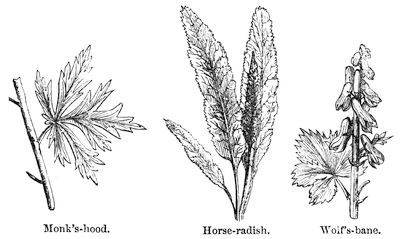
| |
All parts of Monk's-hood and Wolf's-bane are extremely poisonous; the root of Monk's-hood has often been [Pg 205] mistaken for that of Horse-radish, of which an example is therefore given, to show that it is impossible for this mistake to be made, if the least attention be paid to the leaves, as they are totally dissimilar. | |
|
* Bryony (Bryonia dioica). | |
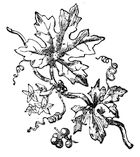
Bryony.
| The whole of this plant is poisonous, and, as the berries are red and tempting, it is dangerous to trust children with them. The root is large and succulent, and is known by the name of Mandrake; it is very purgative and acrid. |
|
* Green Hellebore (Heleborus viridus). | |
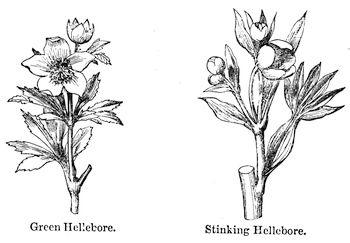
| |
Both poisonous in every part of the plants. [Pg 206] | |
|
* Mezerium (Daphne mezerium). | |
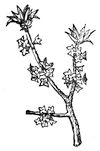
Mezerium.
| The bark of this plant is acrid and poisonous, producing a burning sensation in the throat if chewed, and blistering the skin if applied, for which purpose it was often formerly used medicinally. |
|
* Meadow Saffron (Colchicum autumnale). | |
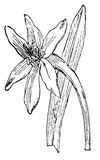
Meadow Saffron.
| The corm (root) and seeds of this plant are poisonous. Meadow Saffron is also called Colchicum, it is much used in medicine, and although a good and useful one in small doses for gouty affections, yet in over-doses it produces violent purging and vomiting. [Pg 207] |
|
Foxglove (Digitalis purpurea). | |
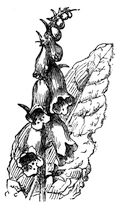
Foxglove.
| This plant is very poisonous and dangerous, the leaves are the most active part. It is frequently used medicinally, but requires great care, as it lowers the action of the heart, the effect of many small doses accumulating and at last acting like one large one. |
|
* Staves-acre (Delphinium Staphisagria). | |
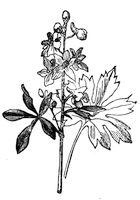
Staves-Acre.
| The Ranunculaceæ are, most of them, poisonous, and this order includes the Larkspurs, of which the Staves-Acre is a species. The seeds are to a certain extent poisonous, and when ground into meal and mixed with flour have been often used by farmers to destroy vermin of various kinds, such as rats, mice, beetles, &c. [Pg 208] |
|
Deadly Nightshade (Atropa Belladonna). | |

Deadly Nightshade.
| The Deadly Nightshade is also called Belladonna. Both leaves and berries are a deadly poison. The berries have been mistaken for black currants by children, as they much resemble them. There are several species, of which the Solanum nigrum, or Common Nightshade, very much resembles the "Deadly." |
|
Woody Nightshade (Solanum Dulcamara). | |
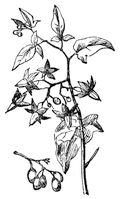
Woody Nightshade.
| This plant, also called Bitter-sweet, from its taste, produces the bright red berries so often seen in hedges, and which from their pretty appearance frequently tempt children to eat them. They are poisonous, but not so much so as the twigs of the plant, which are very acrid and narcotic. [Pg 209] |
|
Hemlock (Conium maculatum). | |
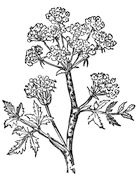
Hemlock.
| The Hemlock is an umbelliferous plant growing by road-sides and under hedges, and flowers in June and July; it has been mistaken for Parsley, but may be known by the stems being spotted with black; the leaves are of a dark green colour, the upper ones bi-pinnate and the lower ones large and standing on long channelled foot-stalks. |
|
Thorn-Apple (Datura strammonium). | |
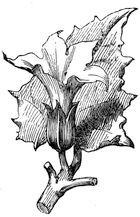
Thorn-Apple.
| The Thorn-Apple is a native of America, but has become almost indigenous, and is frequently found growing in waste places. The whole of the plant is poisonous, and is narcotic when smoked, like tobacco. It is an annual, bearing a funnel-shaped white flower, the fruit is a four-celled capsule covered with sharp spines or thorns, hence its name. [Pg 210] |
|
Poppy, Red (Papaver Rhœas). | |
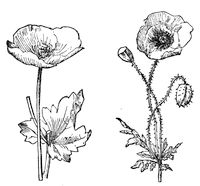
White Poppy. Red Poppy.
| The unripe capsules of both of these species of Poppy are narcotic and poisonous, but chiefly those of the White Poppy, from which, the opium of commerce is procured. The leaves are but very slightly narcotic, and the seeds not at all. |
|
Henbane (Hyoscyamus Niger). | |
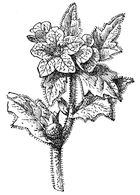
Henbane.
| This plant is an indigenous annual growing in waste places, especially in chalky soil, bearing flowers in July, which are of a yellowish green colour and nauseous odour; the stalk, leaves, and indeed the whole of the plant is covered with hairs. It is very narcotic, and is much used medicine; in over-doses it is poisonous. [Pg 211] |
|
Caper (Euphorbia Lathyris). | |
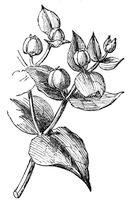
Caper.
| The Caper is a biennial often found in gardens; the seeds are very purgative, and to some persons poisonous. This plant bearing the name of Caper, many persons have erroneously thought the seeds to be the ordinary "Capers" sold at shops for making "Caper-sauce." These, however, are the flower-buds of quite another plant, known as "Capparis spinosa." |
|
Wild Lettuce (Lactuca virosa). | |
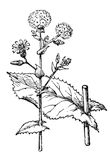
Wild Lettuce.
| The Wild Lettuce is a biennial plant flowering in July and August; it is found growing on the banks of ditches, and is sufficiently narcotic to be called poisonous. The dried juice has been used as a substitute for opium, but by cultivation the narcotic property is nearly or altogether lost. [Pg 212] |
|
Mushrooms, Toadstools, and Other Fungi. | |
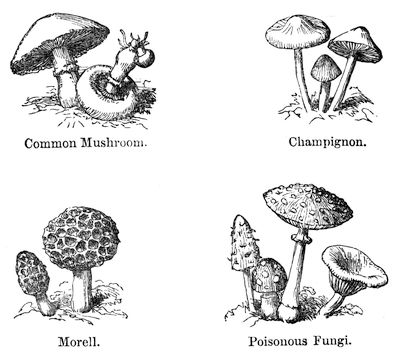
| |
The only kinds of Mushroom which can be eaten with safety are the common Mushroom (Agaricus campestris), the Champignon (Agaricus oreades), and the Morell (Marchella esculenta). Those which are of very bright colours, or have spots on the cap, those with thin caps, or those which are moist—have a film like a cobweb about the stalk, or have the stalk coming from one side of the cap—are poisonous. | |
Those marked (*) in the foregoing list are acrid poisons, and the remainder are narcotic.
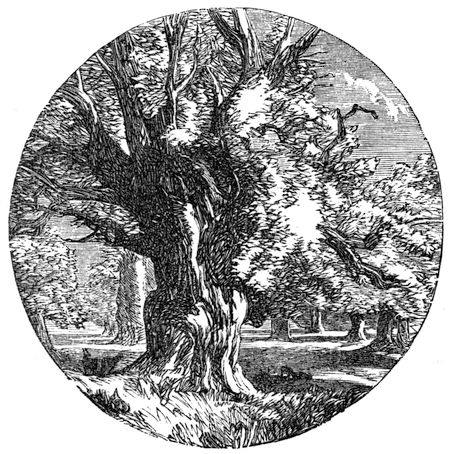
Out of these three great families of plants, in their almost endless variety of size, form, and colour, it has pleased the Great Author of Nature to form all the vegetation which beautifies this earth, from the lofty [Pg 213] Palm—which, from its grateful freshness and the beauty of its structure, seems almost as if possessed of more than vegetative life, to the Algæ, which form "the pool's green mantle"—from the gigantic and "storm-defying" Oak, with its green foliage spreading out far above, and throwing its welcome shade around, to defend from the sun's rays the gentle deer who pasture on the herbage beneath—to the grass and clover, and the sweet-smelling wild flowers at their feet—
form inexhaustible themes on which to exercise our faculties of admiration, and which serve admirably to minister to those wants which, without doubt, were given to us that we might derive pleasure from their being thus beautifully [Pg 214] gratified—themes for the pencil of the artist, who "holds, as it were, the mirror up to nature," and the architect, when he designed his vistas of slender columns spreading out into and supporting roofs of tracery, might well be supposed to have had in his "mind's eye" some beautiful recollection of the arcades of Nature's palaces in the sombre forests, where the twisted trunks of the trees, the fretwork of their branches, and the leafy covering formed by their leaves, supply all the requisites of a grand and lofty temple, fit for the worship of that great First Cause who formed them.
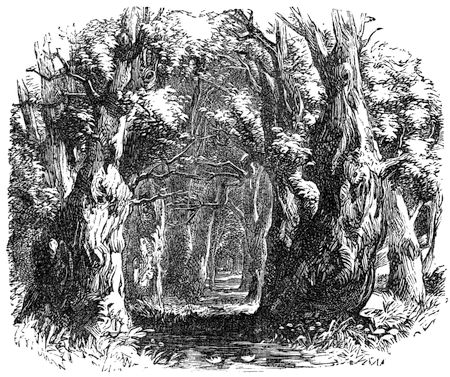
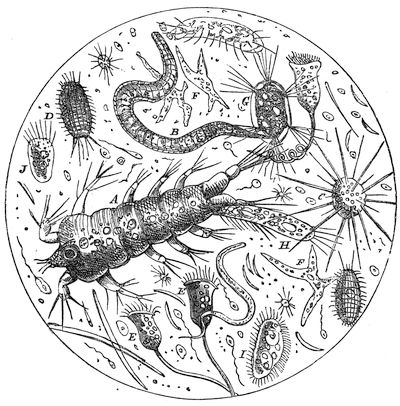
| A, Cyclops Quadracornis. | F, Ambœba princeps. |
| B, Anguillula. Fluviatilis. | G, Acineta mystacina. |
| C, Actinophrys. Sol. | H, Oxytrycha. |
| D, Coleps Hirtus. | I, Triophthalamus dorsalis. |
| E, Vorticella. | J, Polyarthra. |
After considering the beautiful covering which a kind Providence has given to the earth in the form of all sorts of vegetation, it will be necessary now to consider for what kind of creatures this most delightful garden was prepared, whether they seek their food in the air, water, or earth, for [Pg 216] all these places are abodes of the vegetable tribes, and where there is vegetation there are animated beings; for there is not an animal in existence, but directly or indirectly feeds upon the vegetable kingdom, from the elephant and rhinoceros which devour whole plantations, to the minute animalculæ which float in the air or dwell in every drop of stagnant water, where food in the form of equally minute algæ is found—each possessed of wonderful organs and powers suitable to the kind of existence they lead, for God has often placed life in the most simple as well as complicated forms. Dr. Mantell says:—
"We have been accustomed to associate the presence of vitality with bodies possessing various complicated organs for the elaboration and maintenance of the energies of existence, but here we see perfect and distinct creations in the condition of globules and cells, which live and move and have their being, and increase in numbers with a rapidity so prodigious, and in modes so peculiar, as to startle all our preconceived notions of animal organisation."
And it is in these Protozoa, the lowest of the animal creation, that a perfect similarity of condition exists to those of the vegetable kingdom, they are here upon a level; but arising out of these simple forms, God has created two sets of types or portraits, the members of each resembling those below it in some particular, but having organs which are superior to it; and above these are found members whose organs are of a still higher order, and so on till the one set comprises the highest orders of the vegetable, and the other those of the animal kingdom, in its ranks. But these simple organisms are never developed so as to resemble those placed above them; they each, whether high or low, continue to produce their like, for each grade was a creation of itself and a separate one from God's hands. There have been writers, who would endeavour to make it appear that God only created the lowest and most simple germs, and the circumstances which were necessary to develop them, and then allowed these to act and re-act until a man or an oak tree at last became the result! Were this the case, geology would long before this have shown the "small beginnings" [Pg 217] of man; but no! as soon as traces of man's creation are perceived, he is found as perfectly formed and organised as he is now, there are no transition stages of man's existence, nor of any other animal. It is true that the simpler forms of both animal and vegetable existence were created first, but this was in accordance with the state of the earth's surface, which was not at first suitable to the requirements of the higher animals, which were only created when the earth was in a state suitable to receive them.
But when the surface of the earth was still more developed God created man. His last and greatest work; and there can be no doubt that God in His wisdom caused all these changes to precede the creation of man, that he might lack nothing to confer happiness on him, nor objects to exercise his faculties upon.
Animals are divided into two great natural families, the Invertebrate and the Vertebrate, the former having neither spine nor internal skeleton, the latter having both.
The Invertebrate animals are divided into the following sub-families, classes, and orders by Dr. William Carpenter.
| Sub-family 1.—Radiata, having Four classes. | ||||
|---|---|---|---|---|
| 1. Infusoria. | ||||
| 2. Entozoa. | ||||

| Hydroida | 
| ||
| 3. Zoophyta. | Asteroida | 4 Orders. | ||
| Helianthoida | ||||
| Ascidioda | ||||
| 4. Radiaria. | 
| Acalephæ | 
| 2 Orders. |
| Echinodermata | ||||
| Sub-family 2.—Articulata, having Five classes. | ||||
| 1. Annellata. | ||||
| 2. Cerripeda. | ||||
| 3. Crustacea. | ||||

| Coleoptera | 
| ||
| Orthoptera | ||||
| Neuroptera | ||||
| Hymenoptera | ||||
| 4. Insecta. | Strepsiptera | 9 Orders. | ||
| Lepidoptera | ||||
| Hemiptera | ||||
| Diptera | ||||
| Aptera | ||||
| 5. Arachnida. | ||||
Sub-family 3.—Mollusca, having Six classes.
| Acephala, or Headless. | Encephala, Having a Head. |
|---|---|
| 1. Tunicata. | 4. Pteropoda. |
| 2. Brachiopoda. | 5. Gasteropoda. |
| 3. Lamellibranchiata. | 6. Cephalopoda. |
The Infusoria, the first class of the Radiata, comprise all those microscopic organisms called "Protozoa;" they consist of a membranous cell with fluid contents, and are very nearly allied to the Protophytes or lowest vegetable existences. It is still a matter of discussion amongst physiologists and microscopists as to which kingdom shall claim certain of them, but, according to Dr. Carpenter, it appears that the vegetable cell-beings have two envelopes, the inner one albuminous and the outer one cellulose or starchy, and the following passage occurs in his treatise on the Microscope (which should be in the hands of all enquiring minds):—
"The animal cell, in its most complete form, is comparable in most parts of its structure to that of the plant, but differs from it in the entire absence of the 'cellulose wall' or of anything that represents it, the cell-contents being enclosed in only a single limitary membrane, the chemical composition of which, being albuminous, indicates its correspondence with the primordial utricle. In its young state it seems always to contain a semi-fluid plasma, which is essentially the same as the protoplasm of the plant, save that it does not include chlorophyll granules, and this may either continue to occupy its cavity (which is the case in cells whose entire energy is directed to growth and multiplication) or may give place, either wholly or in part, to the special product which it may be the function of the cell to prepare. Like the vegetable cell, that of animals very commonly multiplies by duplicative sub-division, it also (especially among Protozoa) may give origin to new cells by the breaking up of its contents into several particles."
Some of these creatures are so exceedingly minute that hundreds of millions may be contained in a drop of water. They have no organs of any kind, but consist of single cells [Pg 219] of a soft substance called "sorcode;" there is no distinction of sexes, and generation takes place by sub-division, each cell separating into two, and these again into two more, and so on with marvellous rapidity; this is the usual method of increase, but occasionally an act of conjugation takes place, two cells blending into one at the points of contact, the result of which is a nucleus or cell within the original one. These animated cells are of all forms, having prolongations which appear to be thrown out to absorb any particle of organic matter within reach, which then enters within the soft substance of the animalcule and is digested or dissolved, such are the Ambœba, the Actinophrys, &c. (see fig. 1); a step or two higher from these, the very lowest, infusoria are found to possess the first rudiments of organs in the form of cilia, which consist of minute elongations having a constant vibratory motion, for the purpose of causing a current in the water in which they live and bringing food into their vicinity.
Some very curious and complicated changes take place in the lowest of the animals, very similar to those in the lowest vegetables; and what has been called the life-history of these beings, often embraces a great number of forms before the circle of their metamorphoses comes round to the starting-point. Some of these phases of existence are quite different from those going before and after them, and as the vegetable free-cell at one time is capable of motion, it has long been mistaken for an active living animalcule (the Protococcus pluvialis, &c.), and there can be no doubt but that it will be found that many of the lower forms of animated life described by Ehrenberg and others, and still considered as such, will prove to be merely different stages of the metamorphosis of the same protozoon; or it may be not an animal at all, but a simple vegetable or protophyte.
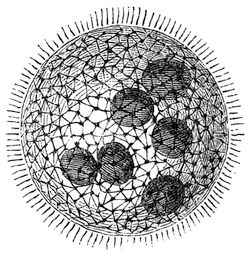
Dr. Carpenter says, "It is quite certain that the Desmidiaceæ, like the confervoid plants in general, grow at the expense of the inorganic elements which surround them, instead of depending upon other living beings for their subsistence, and that they decompose carbonic acid and give off oxygen under the influence of sunlight. They have the [Pg 220] power of generating from these materials the organic compounds which they require for their own development, and these are such as are formed by other undoubted protophytes, as is proved by the application of the appropriate tests." These "Desmidiaceæ" were long considered to belong to the animalculæ, as were the "Diatomaceæ," "Volvox globator" (fig. 2), &c.

Some of the Infusoria, however, have a far higher organisation, such as the "Rotiferæ," and especially the "wheel animalcule" (fig. 3), which at one time was supposed, absurdly enough, to possess a living wheel turning round rapidly on its head! This wheel, however, proved to be nothing else than a vortex of water produced by rotatory cilia. This and many other mistakes were owing to the imperfect construction of the microscopes of that date. These and their fellow animalcules possess several organs, as a stomach, &c. The protozoa at one time were supposed to possess a number of stomachs, and were thence called "poly-gastric infusoria," but it has now been demonstrated that these beings merely absorb or entangle portions of organic matter into their substance, and that there are no cysts or stomachs for their reception. Some of the Infusoria are able to withstand enormous changes of temperature, without losing their vitality; cold far below freezing point, and heat equal to boiling water does not destroy them, and they may be dried in the most complete manner which chemists can devise, and kept in this dry state for years, and yet, on the [Pg 221] application of moisture, return to life. There is no doubt but every inch of air contains the germs of some of the Infusoria in a dry state or their ova, and make up a portion of that fine halo of dust which always appears in the air when a gleam of sunshine is let into a dark place.
The second class of the Radiata, the Entozoa, are those beings which inhabit, as parasites, the intestines and other parts of animals. Their history is very obscure, but there seems to be about twenty varieties of these creatures, and a great number of animals have their peculiar Entozoa. The best known in the human subject are the "Ascaris" or thread-worm, the "Lumbricus Teres" or long-worm, and the "Tænia" or tape-worm; this last is jointed, and grows to several yards in length.
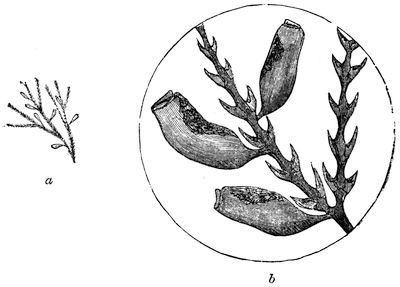
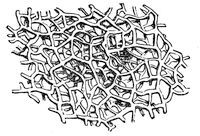
The third class, the Zoophyta, includes four orders. The first of these, the Hydroida, comprise the Tubularia, Sertularia (fig. 4), and Sponges (fig. 5); these are minute gelatinous creatures, secreting a sort of tube in which they dwell. These tubes are congregated into masses of different forms and colours, and, with other structures totally different, are erroneously known by the general name of "sea-weed." [Pg 222] The Zoophyte which dwells in these tubes is furnished with a set of cilia forming a sort of plume. Most of these Hydroida are phosphorescent, such are those which, scattered about on the surface of the sea, contribute to that luminosity so frequently seen.
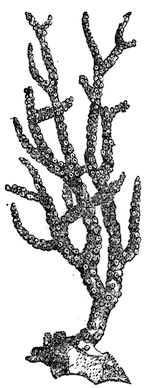
The second order of the Zoophyta, Asteroida, are those which have a star-like shape; they are congregated into compound structures, forming what are called sea-fans (Gorgonia, fig. 6). These Gorgonia are of all colours, and very beautiful; the animals or "polypes" are gelatinous, and have a gelatinous mass or stalk with branches, strengthened and supported by a horny centre. This gelatinous mass forms the animal itself, as well as a sort of common integument connecting the whole family of many thousands. The Gorgonia or sea-fans usually preserved, are dry and hard, as the gelatinous covering has so little substance that, when dried, it forms a rough powdery covering only to the horny support. This powdery surface, if washed off with a little water and placed under the microscope, is found to contain and be made up of spiculæ or crystals of carbonate of lime, of various colours and beautiful forms [Pg 223] (fig. 7); these, when the animal is alive, help to support its gelatinous frame; the Tubiporæ also belong to this class. Fig. 8 represents the Organ-coral (Tubipora musica); it is of a bright red colour, and, when the polypes are living, is a very beautiful object.
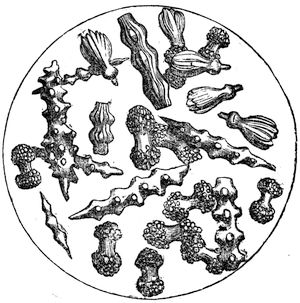
The third order of Zoophytes is the Helianthoida, which include the "Actinia." These Zoophytes are entirely gelatinous, and have beautiful variations of colour. They throw out tentacles like the petals of a flower, and form very beautiful objects; they may be seen in the aquatic vivaria of the Zoological Gardens. To this order of Zoophytes belong the "corals" or Zoanthoid polypes, which produce the coral reefs, extending in some cases hundreds of miles. Dr. Baird gives the following account of them:—
"By far the greater part of the Zoanthoid polypes, as they grow, deposit in the cellular substance of the flesh of their back an immense quantity of calcareous matter which enlarges as the animal increases in size, and, in fact, fills up those portions of the substance of the animal, which by the growth of new parts are no longer wanted for its nourishment, and in this manner they form a hard and strong case, amongst the folds of which they contract themselves so as to be protected from external injury, and by the same means they [Pg 224] form for themselves a permanent attachment which prevents their being tossed about by every wave of the element in which they live. The stony substances so formed are called corals, and their mode of formation causes them exactly to represent the animal which secretes them. The upper surface is always furnished with radiating plates, the remains of the calcareous particles which are deposited in the longitudinal folds of the stomach. These, in all probability were the constructors of all the strata of limestone rocks, which form some of our largest mountains—they were once the beds of seas, and were up-heaved by internal forces. The Madrepores (fig. 9) are also of this order, and form the stony matter in the same way. These are of various patterns, and the beautiful brain-stones in the British Museum are of their construction."
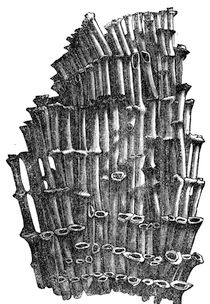
The fourth order of Zoophytes are the Ascidioida, including [Pg 225] formerly the Flustræ (fig. 10), but of late these have been shown to be closely allied, if not identical with, the Tunicated Mollusca, and have received the name of Polyzoa, they will therefore be noticed under that head.
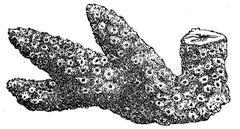
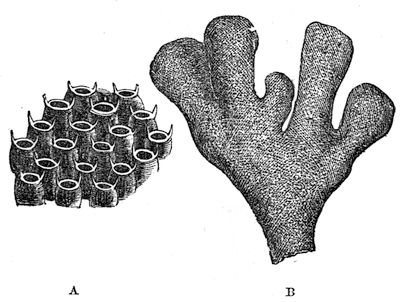
The fourth class of the Radiata, are the Radiaria, including two orders. The first of these are the Acalephæ; the Medusæ or Jelly-fishes belong to this order; these creatures float about sometimes in great numbers, they are transparent and gelatinous, of a hemispherical form, the flat surface being fringed round with fibres, some of which sting like nettles if brought into contact with the skin.
The second order of the Radiaria include the Echinodermata or Sea-hedgehogs, Star-fishes, &c., these are many of them furnished with a profusion of spines, and hence their [Pg 226] name; they are also called Sea-eggs or Sea-urchins (fig. 11), and are mostly of a conical or spherical shape, divided into five segments covered with minute holes, from which project tentaculæ serving as organs of locomotion, touch, &c., and the surface of the body is covered with shelly spines of various forms and thicknesses; the mouth is in the centre, and they feed upon marine productions. The spines, if cut across and ground thin so as to be transparent, show a most complicated and beautiful structure when under the microscope (fig. 12).
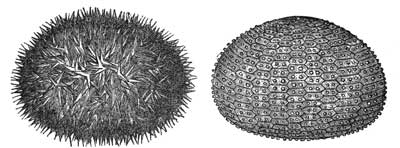
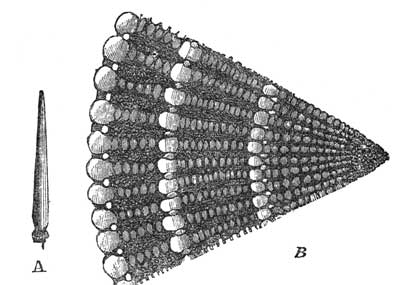
The Star-fishes are inhabitants of the sea, and have generally five arms covered beneath with tentaculæ having small suckers at the point, it is by means of these that they [Pg 227] move from place to place; the mouth is in the centre. They live upon small marine animals, and have the power of reproducing any of the rays which happen to be broken off; and if cut into two or more pieces, each will produce a fresh animal. There is a species of Star-fish, so brittle, that it is quite impossible to touch it without breaking it, or rather it breaks itself, for it seems to have the power of casting off its arms at pleasure. These forms complete the Radiate series of animals, they have nearly all a somewhat regular radiated form, and some of them are very beautiful, such as Sertularia, which grow in communities and form many beautiful branched objects, much resembling sea-weeds and flowers, hence the name Zoophyte, which means animal flowers.
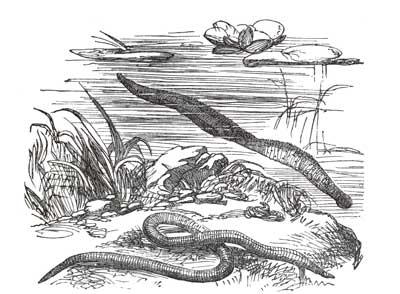
The Articulata form the second division of the Invertebrata. It has five classes, the first of which is the Annellata; in this order are included the Worms and Leeches (fig. 13), these have no hard covering but are soft throughout, they are made up of a number of soft rings which encircle their bodies from one end to the other, and are capable of being [Pg 228] shortened or elongated by the muscles which draw together the rings (these are placed longitudinally), or by those which contract and widen them, placed circularly; this enables them to move along, and in so peculiar a manner that it has received the name of "vermicular," or worm-like. The most familiar example of this class is the Earth-worm (Lumbricus terrestris), this lowly creature lives in soft mud and clay and bores its way into the ground, in doing so it is assisted by a slimy secretion which covers it, its food consists of earth containing organic matter, this it swallows constantly and extracts what is fit for its nourishment ejecting the remainder apparently unaltered; the curious little heaps of soft dirt which are so often seen in wet weather on the garden-paths, &c., are formed in this way. The Leech is another familiar example of the Annellata or Annelidæ, this little useful creature lives in ponds and stagnant waters, and feeds by sucking the fluids of other animals (chiefly frogs and fish) with which it will gorge itself till it is double its original size, it will then remain (often for months) without food till it is all appropriated, the process going on very slowly; a full-grown Leech is perhaps twenty years old, they grow so slowly, (hence it is, that Leeches may be kept for months after being gorged with blood without any food, and they will live and be healthy). They are furnished with two suckers, one at each end, and a mouth with numerous fine teeth placed in a tri-radiate manner, with which they pierce the skin when about to feed. They move in the water with great rapidity by a wavy motion of their bodies, but on solid substances their mode of progression is that of adhering by the sucker in front, then drawing the other one close up and extending the body to its full length, taking hold again by the front sucker and again bringing up the hindermost.
The Cirripeda constitute the second class of the Articulata, which comprise the "Acorn shells" and "Barnacles" (fig. 14); these little creatures were formerly described as Molluscs, but are now considered to be articulate animals, and by some as Crustaceans. Dr. Baird gives the following description of them:—"The Cirripeds are articulated animals contained within a hard covering composed of several pieces and con [Pg 229]sisting of calcified chitine. The body of the animal is enclosed in a sac lined with the most delicate membrane of chitine, which in one group is prolonged into a peduncle and contains the ova; the body is distinctly articulated and placed with the back downwards."
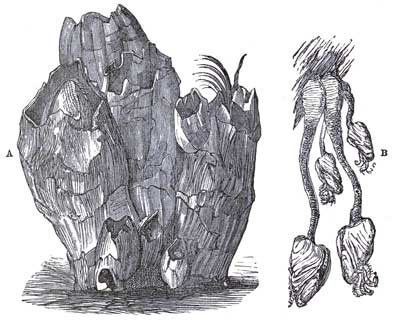
Dr. Carpenter describes the young of the Cirripedes as not fixed like the adult creatures, but moving about freely, and only becoming fixed in the form of the usual acorn shell after undergoing several strange metamorphoses, during which stages they more resemble the ordinary Crustaceans than they do in their fixed state.
The Crustacea form the third class of the Articulata, they comprise animals covered with a hard shell or carapace, like a case made up of rings, with joints allowing the pieces to move upon each other, except where several of them are consolidated to form the principal covering. These rings generally amount to twenty-one in number, some composing the claws, others the legs, &c. The shell is chiefly made [Pg 230] of carbonate of lime (chalk) held together by animal matter. The greater part of the Crustacea inhabit the waters, and they cast their shells from time to time as they grow; the Lobster (Astacus marinus), is a familiar example, it is found in the sea near rocky shores, and is capable of rapid motion under the water, darting along (tail foremost) with great rapidity, it has powerful claws, with one of which (the blunt one) it holds its food and with the other (the sharp one) cuts it up into pieces; they have the power of casting off these claws and reproducing them; they feed upon smaller Crustacea and fish, or any animal matter they can find. The Cray-fish is another example, it is a sort of fresh-water Lobster, living in holes (frequently deserted rat holes) in the banks of rivers; its shell is very rough, but otherwise somewhat resembles the Lobster. Crabs, Shrimps, and Prawns, are members of this class (fig. 15).
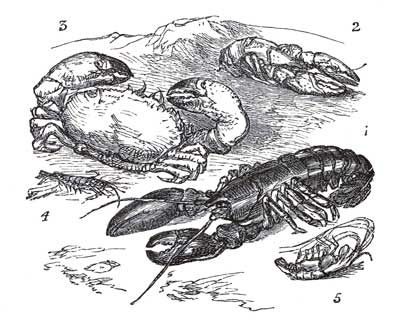
| 1. Lobster (Astacus marinus). | 3. Crab (Cancer pagurus). |
| 2. Cray-fish (Astacus fluviatilis). | 4. Shrimp (Crangou vulgaris). |
| 5. Prawn (Palæmon serratus). | |
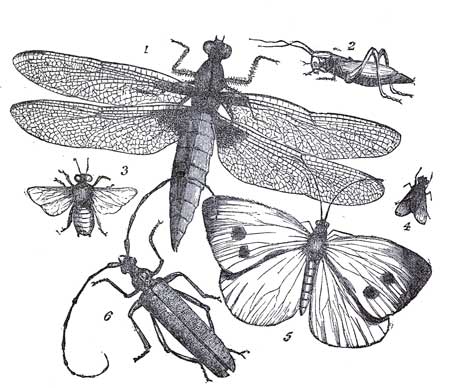
| 1. Dragon-fly (Libellulina depressa). | 4. Fly (Musca domestica). |
| 2. Grasshopper (Gryllus). | 4. Butterfly (Pontia brassicæ). |
| 3. Bee (Apis mellifica). | 6. Musk-beetle (Cerambyx moschatus). |
The Insects form the fourth class of this division, and by far the most important and numerous. They come to maturity only after undergoing successive changes from the egg to the perfect animal; these transformations are amongst the most wonderful things connected with them. The eggs (some of which are very beautiful) are first deposited in some safe place, either attached to a leaf or tied up in a small bundle by silken threads spun by the parent insect, and in some nutritious substance, so that when it comes to life it may at once have food; this is sometimes in manure, sometimes in flesh, and sometimes under the skin of a living animal (few are exempt from this infliction), where they remain for a time and then come forth as maggots, caterpillars, &c.; in this state they are called [Pg 232] "larvæ," these are generally active creatures and eat most voraciously, which seems to be the principal act of this state of their existence. These larvæ frequently change their skins as they grow, and at last they assume the next stage of their life, the pupa or chrysalis state, which is one generally of complete inactivity; many of these larvæ, weave themselves a covering of a sort of silk, to defend them while in the pupa state—such as the Silkworm, whose covering (cocoon) is the source of all the silk of commerce—others merely place themselves in a situation of security. The pupa remains dormant for a certain time, and then becomes the imago or perfect insect (the last state of its existence), such as a Moth, a Butterfly, a Beetle, &c. These are of different sexes, and in due time produce a batch of eggs and then die; these eggs are often incredible in numbers, amounting to many thousands—fortunately but few escape the watchful eyes of other insects and of birds who feed upon them.
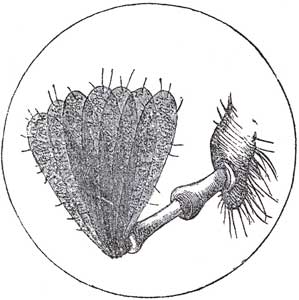
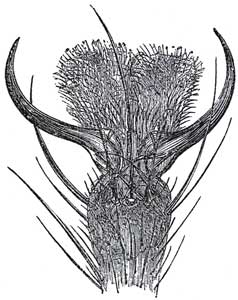
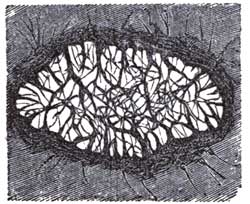
Insects have six jointed legs, a pair of antennæ or horns (as they are called) and generally one or two pairs of wings. The head is joined to the body by a constricted neck, the part of the body to which it is joined is called the thorax, and to this is added the posterior part or abdomen; this part is extremely various in form in different insects, in some it is round and full, in others long and extended. The antennæ arise from the head, and are generally composed of eleven pieces variously disposed; these wonderful organs are possessed of great sensibility, and they certainly serve to convey information to the insect, of the nature of one of the special senses; it was formerly thought to be simply that of touch very much refined, or of smell, but it is now generally considered to be that of hearing, or a modification of it. The forms of the antennæ are very various, fig. 17 represents that of the Cockchaffer (Melolontha vulgaris). The legs proceed from the thorax, as do the wings, the abdomen giving rise to none of the extremities; the feet of insects are all pretty much upon the same model, some being more developed than others, they have a pair of hooks or claws for catching and clinging to rough surfaces, and a pair of cushions or pads, covered in some cases with suckers. The foot of the [Pg 233] Fly (fig. 18) is well developed in this particular, enabling it to walk with perfect ease even on glass or the smoothest surface, and in any position. Insects do not breathe by lungs or gills, but by means of branched tubes called "tracheæ," which convey the air to the interior of the [Pg 234] animal. On the surface of these, the blood vessels ramify, giving out the carbonic acid of the blood and receiving oxygen; the openings to these air-tubes are arranged along the sides of the body, and are called "spiracles" (fig. 19). They are curious objects under the microscope, some of them being closed by a perforated membrane, others have a sort of sieve or network of fibres, and most of them a contrivance to catch and exclude minute particles of matter floating in the air, and thus prevent their entry into the tracheæ. Insects have two eyes, one on each side of the head, which are of great size, often forming complete hemispheres; each eye is made up of several thousand separate eyes or "ocelli," hence they are called compound eyes; these ocelli are placed closely together, so as to form a sort of honeycomb arrangement; the appearance of a part of one of these eyes is shown in fig. 20.
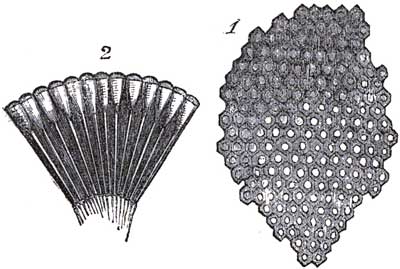
Insects are amongst the most active of creatures, whether for good or for evil, and the prodigious rapidity with which they increase under favourable circumstances would soon cause them to overrun the whole earth, to the extinction of almost every other creature, were these circumstances not controlled by an all-wise Providence, who keeps a constant [Pg 235] check upon their progress by causing one insect to feed upon another, and who has formed almost innumerable other creatures (including birds, reptiles, and fishes) with instincts which lead them to feed upon insects in every stage of their development (fish devour the larvæ of many insects which inhabit the waters during the first stage of their existence); but it occasionally happens, when some of these salutary checks upon their increase are withdrawn, that they multiply with such fearful rapidity as to produce a complete famine, for they eat up everything before them. Who has not heard of the plagues of Locusts and the depredations of the White Ants? The swarms of Locusts in Africa will sometimes cover many hundred square miles of surface, and in this space not a vestige of any vegetation would remain after their visit. The description of the prophet Joel is sublime: "The land is as the garden of Eden before them, and behind them a desolate wilderness: yea, and nothing shall escape them.... The earth shall quake before them, the heavens shall tremble: the sun and the moon shall be dark, and the stars shall withdraw their shining."
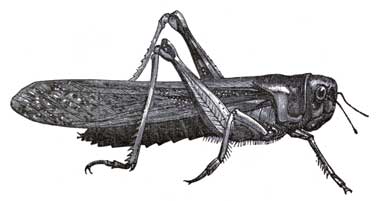
But it is kindly ordained that these visitations shall only occasionally take place, and even when they do, terrible as is the infliction, a benefit in reality outweighing the injury often succeeds; for the land in these countries is often made almost barren by the quantities of tangled roots and stubble [Pg 236] on the surface of the earth, which by the destructive powers of these insects is completely removed, and their manure left in its place, so that the fertility of the ground is much increased (often tenfold) after their visits.
The thousands of species of insects which exist, render it impossible in a work like this, even to name them, but under the separate orders will be given a slight outline of the more important.
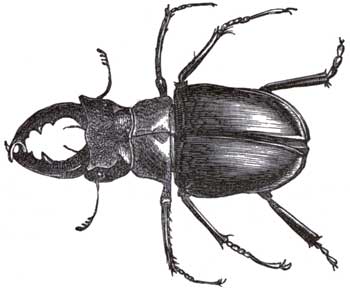
Insects are divided, according to the character of their wings, into nine orders.
1. Coleoptera (Black-winged).
The Coleoptera are those insects generally denominated Beetles, they have four wings, the two outer of which are not used to fly with, but as cases to cover and protect the other two; they are called "elytra," are horny and firm in texture, and in some cases, as the Diamond Beetle and Musk Beetle, beautifully ornamented; the under pair of wings fold transversely so as to pack up under the outer ones, which are shorter. All Beetles live but one season, both sexes die before winter, leaving nothing but their eggs to continue the species, the larvæ which come from these are very destructive, eating most voraciously; for [Pg 237] the most part, Beetles feed on decaying substances such as dung, &c., and are therefore useful creatures; there are between 40,000 and 50,000 species of them. Beetles have been called the scavengers of nature, and truly they are so, for they (with other insects) clear off all dead matter, whether animal or vegetable; the Geotrupes stercorarius, and others, dig holes in the ground and bury the excrement which is deposited on the surface, thus doing a great service to vegetation, taking it down to nourish the roots of the grass and other plants instead of allowing it to harden and decompose on the surface. All dead animals are at once attacked and devoured by insects, and the Beetles play their full share in this necessary operation.
There are certain Beetles, called Burying Beetles (Necrophorus vespillo), which remove the earth from under the dead bodies of small animals, such as birds or mice, till they are beneath the level of the ground, when they cover them up and deposit their eggs in them; these bodies form stores of food for the future larvæ.
The Stag Beetle (Lucanus cervus, fig. 22), the Dor Beetle (Geotrupes stercorarius), the Cockchaffer (Melolontha vulgaris), the Musk Beetle (Cerambyx moschatus, fig. 16), and the Lady-bird (Coccinella), are well-known members of this order.
2. Orthoptera (Straight-winged).
The Orthoptera are those insects whose wings fold longitudinally; they have two pairs, but the anterior pair are horny and serve as wing-cases to the posterior pair; their food is chiefly vegetable, but to many of their species any kind is acceptable, as their mouths are suitable for grinding-up hard substances. The Locusts (Locustidæ, fig. 21), Grasshoppers (Gryllidæ), Crickets (Achetidæ, fig. 16), and Cockroaches (Blattidæ), or Black-beetles, as they are sometimes incorrectly called, belong to this tribe. Their metamorphoses are not so complete as in many other insects, for they never entirely change their [Pg 238] form; the larva as it leaves the egg has no wings, but otherwise is much like the parent; it changes its skin several times, which stage is analogous to the pupa state, after casting it five times and obtaining wings, it becomes the imago or perfect insect. The ravages of the Locusts are so well known that little need be said; the following is from Kirby and Spence's Entomology:—
"Although this animal be not very tremendous for its size, nor very terrific in its appearance, it is the very same whose ravages have been the theme of naturalists and historians in all ages, and upon a close examination you will find it to be peculiarly fitted and furnished for the execution of its office. It is armed with two pairs of very strong jaws, the upper terminating in short, and the lower in long teeth, by which it can both lacerate and grind its food; its stomach is of extraordinary capacity and powers; its hind legs enable it to leap to a considerable distance, and its ample vans are calculated to catch the wind as sails, and so to carry it sometimes over the sea; and although a single individual can effect but little evil, yet when the entire surface of a country is covered by them, and every one makes bare the spot on which it stands, the mischief produced may be as infinite as their numbers. So well do the Arabians know their power, that they make a Locust say to Mahomet, 'We are the army of the Great God; we produce ninety-nine eggs; if the hundred were completed, we should consume the whole earth and all that is in it.'"
3. Neuroptera (Nerve-winged).
The Neuroptera comprise the Dragon-fly (Libellulina, fig. 16), Ant-lion (Myrmelion), Caddis-flies (Phryganidæ), and the May-flies (Ephemera); these insects have wings of a beautiful network structure, as may be seen in the Dragon-fly, they make their appearance about the middle of June in the locality of ditches and ponds. The Caddis-fly is noted for the peculiar case which the larva makes for itself; the larva inhabits the [Pg 239] water and the ease is made of little fragments of wood, shell, and sand, agglutinated together so as to float; the perfect insect is not aquatic, and flies away when formed. The May-flies are noted for the shortness of their existence, the larvæ live in the water, and many of them are eaten by fishes who are very fond of them, but sufficient numbers come to the perfect state, to form complete clouds in the air where the larvæ were, these creatures live but a day, and some of their species but an hour or two, in the perfect state, they deposit their eggs in the water, which come to life in the mud at the bottom. The flight of these fragile beings and their short-lived holiday festivities are well described by Kirby and Spence:—
"In the beginning of September, for two successive years, I was so fortunate as to witness a spectacle of this kind, which afforded me a more sublime gratification than any work or exhibition of art has power to communicate. The first was in 1811. Taking an evening walk near my house, when the sun, declining fast towards the horizon, shone forth without a cloud, the whole atmosphere over and near the stream swarmed with infinite myriads of Ephemeræ and little gnats of the genus chironomus, which in the sun-beam appeared as numerous and more lucid than the drops of rain, as if the heavens were showering down brilliant gems. Afterwards, in the following year, one Sunday, a little before sunset, I was enjoying a stroll with a friend at a greater distance from the river, when in a field by the road-side the same pleasing scene was renewed, but in a style of still greater magnificence; for, from some cause in the atmosphere, the insects at a distance looked much larger than they really were. The choral dances consisted principally of Ephemeræ, but there were also some chironomi, the former, however, being most conspicuous, attracted our chief attention. Alternately rising and falling, in the full beam they appeared so transparent and glorious, that they scarcely resembled anything material; they reminded us of angels and glorified spirits drinking [Pg 240] life and joy in the effulgence of the Divine favour. The Bard of Twickenham, from the terms in which his beautiful description of his sylphs is conceived in the 'Rape of the Lock' seems to have witnessed the pleasing scene here described:—
4. Hymenoptera (Membrane-winged).
The Hymenoptera are those insects which have four membraneous wings. The Bees (Apidæ, fig. 16), Wasps (Vespidæ), the Ants (Formicidæ), and the Ichneumon Flies (Ichneumonidæ), are the chief tribes of this order. The Bees, Wasps, and Ants are celebrated for forming societies, more perfectly arranged and governed than in any other creatures but man. It is curious that the most perfect instincts (such as approach so nearly to reason that they almost defy us to make a distinction) should have been given by the Creator to creatures so far removed from man in the scale of existence, and so little resembling him in any other particular. This is one of the stumbling-blocks in the way of those who wish to have it believed that all animals are progressive from certain types, which cannot be got over; if such were the case, man would be most nearly imitated by the Apes, and these again by those most nearly allied to them, and so on downwards, but here we find a government almost as perfect as that of the human species—an arrangement of work, a division of labour, buildings, storehouses, &c.—showing nearly all the social habits and feelings of man, in creatures who in form and size have no resemblance to him.
Kirby and Spence, in describing the societies of insects, say:—"But when we consider the object of these societies, the preservation and multiplication of the species, and the means by which that object is attained (the united labours and co-operation of perhaps millions of individuals), it seems as if they were impelled by passions very similar to those main-springs of human associations which I have just enumerated. Desire appears to stimulate them, love to allure them, fear to alarm them. They want a habitation to reside in and food for their subsistence. Does not this look as if desire were the operating cause which induces them to unite their labours to construct the one and provide the other? Their nest contains a numerous family of helpless brood. Does not love here seem to urge them to exemplary and fond attention, and those unremitted and indefatigable exertions manifested by the whole community for the benefit of these dear objects? Is it not also evident by their general and singular attachment to their families, by their mutual caresses, by their feeding each other, by their sympathy with suffering individuals and endeavours to relieve them, by their readiness to help those that are in difficulty, and finally by their sports and assemblies for relaxation? That fear produces its influences upon them seems no less evident, when we see them agitated by the approach of enemies, endeavour to repel their attacks, and to construct works of defence. They appear to have besides a common language, for they possess the faculty, by significative gestures and sounds, of communicating their wants and ideas to each other."
Numerous works have been entirely devoted to the habits and instincts of Bees and Ants, and very interesting they are, but it would be impossible to give an intelligible account of them in the small space allotted in this volume.
The wax of which Bees build their beautiful six-sided cells, and which is the whole source of all the wax used by men for a variety of purposes, is secreted in little scales [Pg 242] or flakes, between the joints of the abdomen, from whence the wax-making Bees take it to build the comb; the cells of the comb are filled with honey, which is obtained by the Bees (by means of the apparatus shown at fig. 23), from the nectaries of flowers in the form of nectar, and is converted into honey in the honey-bag of the Bee, from whence it is discharged into the cells. Bees also collect the pollen from the flowers they visit, this adheres to the hairs on the Bee, and is scraped and brushed off, and collected into two little lots, which the Bee carries on each hind leg, this pollen is made into bee-bread. By scattering the pollen, flowers are often fecundated, for there are many plants, the female flowers of which are separate from the males, and it is only by insects and the wind, that the females are fecundated, for the Bee, with the pollen adhering to every part, first visits one flower and then another in search of nectar.
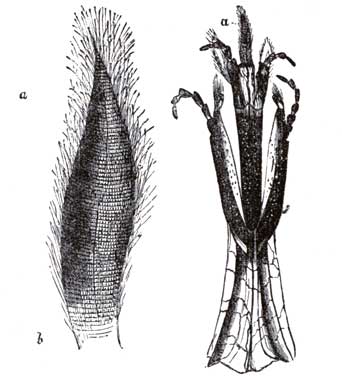
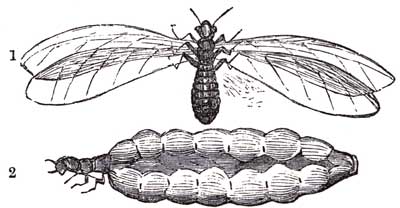
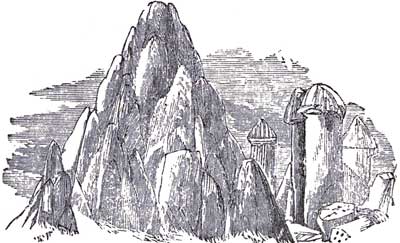
With respect to the Ants, Kirby and Spence give the following account of the building of their habitations.
"The nest of Formica brunnea is composed wholly of earth, and consists of a great number of stories, sometimes not fewer than forty, twenty below the level of the soil, and as many above, which last, following the slope of the ant-hill, are concentric. Each story, separately examined, exhibits cavities in the shape of saloons, narrower apartments, and long galleries which preserve the communication between both. The arched roofs of the most spacious rooms are supported by very thin walls, or occasionally by small pillars and true buttresses; some having only one entrance from above, others a second, communicating with the lower story; the main galleries, of which, in some places, several meet in one large saloon, communicate with other subterranean passages, which are often carried to the distance of several feet from the hill. These insects work chiefly after sunset. In building their nest they employ soft clay only, scraped from its bottom when sufficiently moistened by a shower, which, far from injuring, consolidates and strengthens their architecture. Different labourers convey small masses of this ductile material between their mandibles, and with the same instrument they spread and mould it to their will, the antennæ accompanying every movement. They render all firm by pressing the surface lightly with their fore feet; and however numerous the distinct masses of clay composing these walls, and though connected by no glutinous material, they appear when finished, one single layer, well united, consolidated and smoothed. Having traced the plan of their structure, by placing here and there the foundations of the pillars and partition-walls, they add successively new portions; and when the walls of a gallery or apartment, which are half a line thick, are elevated about half an inch in height, they join them by springing a flattish arch or roof from one side to the other. Nothing can be a more interesting spectacle than one of these cities while building. In [Pg 244] one place vertical walls form the outline, which communicate with different corridors by openings made in the masonry; in another we see a true saloon, whose vaults are supported by numerous pillars; and further on are the cross-ways or squares where several streets meet, and whose roofs, though often more than two inches across, the Ants are under no difficulty in constructing, beginning the sides of the arch in the angle formed by two walls, and extending them by successive layers of clay till they meet; while crowds of masons arrive from all parts with their particles of mortar, and work with a regularity, harmony, and activity, which can never enough be admired. So assiduous are they in their operations, that they will complete a story [Pg 245] with all its saloons, vaulted roofs, partitions and galleries, in seven or eight hours. If they begin a story, and for want of moisture are unable to finish it, they pull down again all the crumbling apartments that are not covered in."
Every one has heard of the destructive as well as constructive qualities of the "White Ant;" another quotation from Kirby and Spence will illustrate both.
"When they find their way into houses or warehouses nothing less hard than metal or glass escapes their ravages; their favourite food, however, is wood of all kinds, except the Teak, and Ironwood, which are the only sorts known, that they will not touch; and so infinite are the multitudes of the assailants, and such is the excellence of their tools, that all the timber-work of a spacious apartment is often destroyed by them in a few nights. Exteriorly, however, everything appears as if untouched; for these wary depredators (and this is what constitutes the greatest singularity of their history) carry on all their operations by sap and mine, destroying utterly the inside of solid substances, and scarcely ever attacking their outside until they have first concealed it and their operations with a coating of clay. A general similarity runs through the proceedings of the whole tribe, but the large African species, called by Smeathman Termes bellicosus, is the most formidable. These insects live in large clay nests, from whence they excavate tunnels all round, often to the extent of several hundred feet; from these they will descend a considerable depth below the foundation of a house, and rise again through the floors; or, boring through the posts and supports of the building, enter the roof and construct their galleries in various directions.
"If a post be a convenient path to the roof, or has any weight to support, (how they discover it is not easily conjectured), they will fill it with their mortar, leaving only a track-way for themselves, and thus, as it were, convert it from wood into stone as hard as many kinds of freestone. In this manner they soon [Pg 246] destroy houses, and sometimes whole villages, when deserted by their inhabitants, so that in two or three years not a vestige of them will remain. These insidious insects are not less expeditious in destroying the wainscoating, shelves, and other fixtures of a house, than the house itself; with the most consummate art and skill they eat away the inside of what they attack, except a few fibres here and there, which exactly suffice to keep the two sides, or top and bottom, connected, so as to retain the appearance of solidity after the reality is gone; and all the while they carefully avoid perforating the surface, unless a book or any other thing that tempts them should be standing upon it.
"Kœmpfer, speaking of the White Ants of Japan, gives a remarkable instance of the rapidity with which these miners proceed. Upon rising one morning he observed that one of their galleries of the thickness of his little finger had been formed across his table; and upon a further examination he found that they had bored a passage of that thickness up one foot of the table, formed a gallery across it, and then pierced down another foot into the floor; all this was done in the few hours that intervened between his retiring to rest and his rising."
Most of this order are armed with some weapon of defence. The Bee and Wasp have each a most formidable sting, with which they are able to inflict a wound fatal to most insects. The Ants have a peculiar secretion, consisting of formic acid, which they eject with great force, and which has a very disagreeable smell. The eggs of Ants when hatched produce a small grub, which spins itself a sort of cocoon, and in this state it so much resembles a grain of corn, that it has been mistaken for it; this error has given rise to the supposition that Ants store up corn for winter, whereas they never eat corn, but the care they take of these larvæ, removing them from place to place, taking them up in their mandibles and running along with them, has been mistaken for the act of storing away grains of corn.
5. Strepsiptera (Twisted-winged).
This order includes but a few species; Dr. Baird in his Cyclopædia, gives the following account of them:—
"Certain insects were discovered by Kirby, living parasitic in the abdomen of some Andrenæ, which at that time were nondescript, and could not be referred to any existing order. They were afterwards placed in an order by themselves, which he called Strepsiptera. The larvæ live in the bodies of Bees, Wasps &c., and the males only undergo a perfect metamorphosis; the females, even when adult, have neither legs, wings, nor eyes, but resemble larvæ, and continue to live parasitic in the bodies of the Hymenopterous insects within which they were born. The characters are thus taken from the male and consist chiefly in the structure of the wings. The anterior pair are quite rudimentary, being transformed into a pair of short, slender, contorted appendages resembling narrow balancers or halters. The posterior pair are large and membraneous, their nervures are only longitudinal, so that they are able to fold them like a fan. They have large globular eyes, with the facets few, but of comparatively large size."
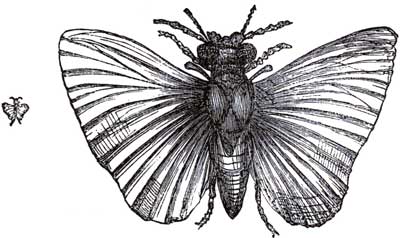
"About ten or twelve species are known, forming a small family, "Stylopidæ." The genus Stylops may be taken as the type, and contain such species as have the tarsi with four points and the antennæ with six."
6. Lepidoptera (Scaly-winged).
This order includes the Butterflies and Moths, they have four wings, which are large and covered with minute scales, which are for the most part of a heart or battledore shape, as in fig. 27. The wings of these insects are many of them beautifully marked and tinged. There are about 12,000 species, by some divided into "diurnal" (or those which fly by day), "crepuscular" (or those which fly in the evening), and "nocturnal" (or those flying by night). The Moths are mostly crepuscular and nocturnal, while the Butterflies are chiefly diurnal, but the most usual distinction between the Moth and Butterfly consists in the form of the antennæ, those of the Moth being feather-shaped, while those of the Butterfly have a small knob at the end, or, as it is called, "club-shaped." The Lepidoptera feed upon the nectar of flowers, for which purpose they are furnished with a long proboscis or "Haustellium," which is curled up under the head, it consists of two semi-cylindrical pieces which when placed side by side form a tube, up which [Pg 249] the nectar is drawn by capillary attraction. The metamorphosis of these insects is complete.
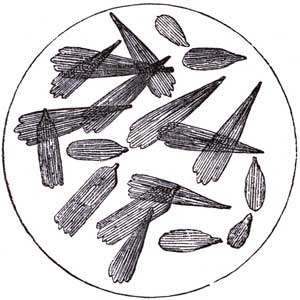
The Silkworm (Bombyx mori) belongs to this order. It is the most important of all insects to man, as from it alone all the silk of commerce is obtained. Its cocoon is of a beautiful yellow colour, varying in shade from orange to pale straw-colour; the silk of one cocoon weighs somewhere about three grains; it would therefore, at this calculation, take 1920 worms to spin one pound. The annual import of silk into this country alone is about 7,000,000 pounds, it must therefore take 13,440,000,000 Silkworms to supply us with silk yearly! The Silkworm feeds almost exclusively on the leaves of the mulberry.
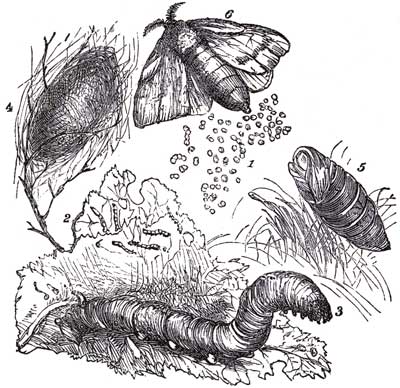
7. Hemiptera (Half-winged).
The Hemiptera have two pairs of wings, the hindermost small, and the foremost pair half horny and half membraneous, the base being horny, and the apex membraneous. They include the Bugs, some of which are aquatic, as the Water Scorpion (Nepa), and the Water Boatman (Natonecta), which swims on its back, rowing itself by means of a pair of long legs, which look like oars; the common bed Bug is also of this order, although wingless, as are also the Plant Lice (Aphides), which, however, obtain wings in their perfect state.
8. Diptera (Two-winged).
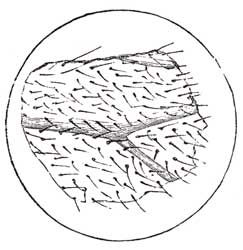
The Diptera include the common House Fly (fig. 16), Bluebottle Fly, Gnat, and many others; their wings are like the Neuroptera, but they have but one pair, the other pair being undeveloped, form little knobs called "balancers." The wings of Flies are generally covered with short stout hairs, as seen in fig. 29; the common Fly feeds upon almost anything, but some of the Diptera feed exclusively on the blood of other animals; the Gnat (Culex pipiens), of which the Mosquito is a variety, deposits [Pg 251] its egg in the water on any floating substance, the larva which comes from the egg is aquatic, living with its head downwards, the end of the abdomen only being above the water, in this there is a spiracle or breathing orifice, which enables it to take in the air; the Gnat, when it comes from this larva, stands on its shell for a moment, and then flies off, for it is not suited to live in the water; this history of the early stages of its life, accounts for Gnats being always found in such numbers near pools of water. The Tsetse, which Dr. Livingstone describes as being so fatal to cattle, is of this order; he says, "It is well known that the bite of this poisonous insect is certain death to ox, horse, or dog.... A most remarkable feature in the bite of the Tsetse is its perfect harmlessness to man and wild animals, and even calves, so long as they continue to suck the cows."
9. Aptera (Wingless).
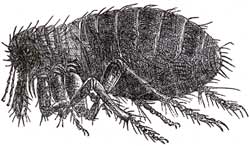
To this order belongs the Flea (Pulex irritans), which is furnished with lancet-shaped weapons, through which it sucks the blood of other animals, for it is entirely parasitic, and also the "Chigeo" (Pulex penetrans), which is a troublesome and even dangerous pest in the West Indies; it penetrates the skin of the feet, and deposits its young beneath it.
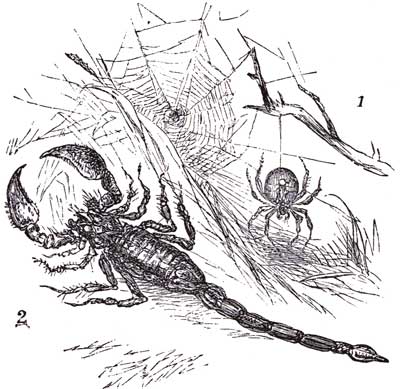
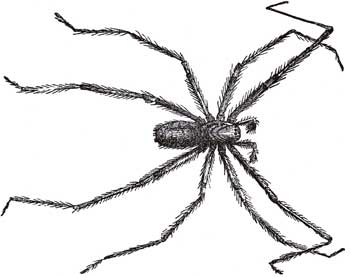
The last class of the Articulata, the Arachnida, includes [Pg 252] the Spiders, Scorpions, Centipedes, and Millipedes. The Arachnida differ from insects, in having eight or more legs, more than two eyes, no wings, and no head; the Spiders have four pairs of legs, and six, eight, or more, simple eyes, which appear as minute spots on the upper part of the thorax. Spiders nearly all live by preying upon small insects, which they catch in several ways, but by far the most general mode is by constructing a web or net to entangle them; the threads of this web are made of a fluid glutinous substance, which is secreted within the abdomen, and which they project from extremely minute orifices, several of which exist on the point of little projections called "spinnarets," this liquid dries into a solid thread immediately it comes into contact with the air; it is extremely strong, and so fine that several thousand of the single fibres will only make the size of a human hair. The Garden Spider (Epeira diadema) is often called the Geometrical Spider, from the regularity of its web. These [Pg 253] Spiders will often place a thread from one spot to another, where it would seem impossible that they could attach it, such as from the branch of a tree to the corner of a house twenty feet or more from the ground; it has never been accurately determined how the Spider does this, and it is the more difficult to observe, as it is always done in the night, but it has been supposed that a fine thread is spun, and that the wind carries it across, when it is strengthened and afterwards made tight. The Spider (Araneæ domestica) that makes "cobwebs" in the corners of rooms, is called the Weaving Spider. Some Spiders are called Hunting Spiders, they do not construct webs, but pounce upon their prey with a leap; the Mygale avicularis of South America is one of this kind; it is said that some grow so large that their feet spread out a foot wide. The Long-legged Spider, often found in our houses, and of which fig. 32 is an exact copy, measures 3½ inches, and is the largest species we have. There are also aquatic Spiders, which feed upon insects in the water and dive down for them; their surface being hairy and unctuous, retains sufficient air to bring them up and prevent them being wetted. The eyes [Pg 254] of Spiders are different from those of other insects; they appear as simple, shining spots, or "ocelli," and not compound eyes, having a great many "ocelli" compounded into one. These "ocelli" are arranged in a group of eight or more, and placed on the upper part of the thorax, for Spiders have no head, although generally represented with one. The eggs of Spiders are generally deposited in some sheltered place, fastened together and partly covered with a net-work of a sort of yellow silk, very much resembling the cocoon of the Silkworm. The Scorpion, so terrible in appearance, and in its sting so deadly, and which is sometimes a foot in length, belongs to this order. It has eight legs, and a pair of claws like a lobster, the body is lengthened into a sort of tail, at the end of which is a claw or sting, like the poison fang of a serpent, with a poison bag at its root; its effects are often fatal to man, and always so to the insects and other small animals upon which the Scorpion feeds, its usual mode of killing which, is to catch them with its claws and then to sting them to death. The Centipede is a scarcely less frightful creature; in South America and the West Indies it is sometimes found to grow to eight or ten inches in length, it is of a long jointed form, with generally twenty-one pairs of legs, although some have double this number; its bite is much to be dreaded, as it is poisonous, especially the "Scolopendræ," which have a poison gland, like the snake; in this country they are very small indeed, and are generally found in moist places.
The Centipedes and Millipedes are, by some, placed in the class Arachnida, but by others in a separate class called "Myriopoda," divided into two orders, the Chilognatha, which have rounded cylindrical bodies, and generally more than one pair of legs to each segment of the body, and the Chilopoda, which have a distinct flattened head and but one pair of legs to each segment.
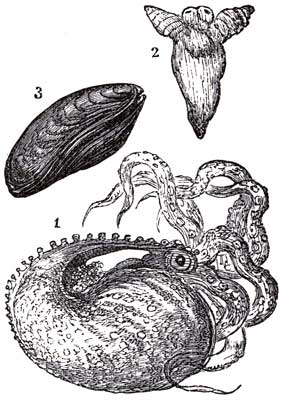
The last of the three great divisions of the Invertebrata is formed by the Mollusca; it is divided into six classes, (see page 218). The Mollusca are characterised by having no internal skeleton, nor external horny case, as in the Articulata; they are rather soft, and either void of solid covering, or possessed of "shells" composed chiefly of earthy matter (chalk), and in one or two pieces, called valves, hence the names, uni-valve and bi-valve; all shells of this description belong to the Mollusca, some of which have no means of locomotion, as Oysters; others have a "foot" covered with a muscular expansion, called the "mantle," by which they glide onwards, as the Snail.
1. The Tunicata have no shell or hard covering, but are of a pretty firm consistence; they are either fixed to rocks and sea-weeds, or float about freely, and are either solitary, social, or compound. The "Ascidians" are united in groups, and are all connected [Pg 256] by a common stalk or "Stolon," from which they grow by buds.
2. The Brachiopoda. These Molluscs are furnished with a pair of shells, within which the animal lives; one of these shells (the ventral one) has a small hole in it, close to the hinge, and through this a long tendinous cord passes, which fixes the creature to some stone or rock, hence the name Brachiopodous, which means arm-footed. The young of this Mollusc are not fixed, but float about. The Lingula has horny shells, and the foot passes out between them; these creatures were some of the first created, if not the very first; the shells of Terebratula are found in vast quantities in the oldest fossiliferous strata.
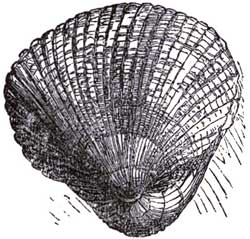 FIG. 34.—COCKLE (Cardium edule).
FIG. 34.—COCKLE (Cardium edule).3. The Lamellibranchiata include a great many of our most ordinary Mollusca, commonly known as "shell fish." They have a pair of shells, and are thence called "bivalve." The Oyster (Ostrea edulis), Mussel (Mytilus edulis), Cockle (Cardium edule), Scallop (Pecten), belong to this class. Oysters form a considerable article of commerce, thirty or forty thousand bushels are brought each season to London; they are dredged up from "beds," where they are found in great quantities. They spawn in May and June, and are not then good. There is an old and a well-known saying, that "Oysters are not fit to eat, unless there is an R in the month," all the names of the months containing an R but May, June, July, and August. The spawn is collected and placed in artificial beds, consisting of shallow places or hollows in the sea, where the tide will not wash them away, and whence they can be easily removed when sufficiently grown, which is in five or six years; these creatures have no powers of locomotion, but remain where the tide [Pg 257] washes them; but Scallops, Cockles (fig. 34), and Mussels (fig. 33), have the power of fixing themselves to any substance they wish, by means of the "byssus" or beard, which is a tuft of fibres passing out from between the shells; and it is said, the Scallops have the power of progression, by suddenly opening and shutting the shells.
4. The Pteropoda are Mollusca which have no shell, or a very thin one; the Clio borealis (fig. 33), which forms the chief food of the Whale, is found in great multitudes in the Arctic seas, it swims about by means of two extensions, similar to wings. The Hyalœa has a small round transparent shell.
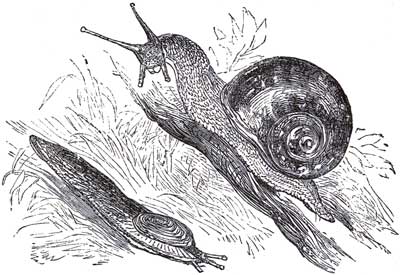

5. The Gasteropoda are extremely numerous; most of them have univalve shells, but many of them have none, as the Garden Slug (Limax, fig. 35). The Whelk (Buccinum undatum), Perriwinkle (Littorina littoria), Garden Snail (Helix aspersa, fig. 35), and the Wentle-trap (Scalaria, fig. 36), are the most familiar examples of this class. These Mollusca walk by means of the [Pg 258] mantle, which is muscular, and capable of alternate contraction and expansion; they breathe by means of lungs on their back beneath the shell, and to which there is an opening in their side. What are usually called the horns are four in number, two short and two long; they are tentaculæ, but what is peculiar in them is the circumstance of having the eyes placed at their ends. These Mollusca have a sort of valve, which, when they retire into the shell, closes it like a lid; it is called the "Operculum;" in some cases it is horny, as in the Perriwinkle, and in others, resembles shell; the shells of these mollusca are coiled into a spiral, this is caused by the shell always growing by additions to the edges of the mouth, and in nearly every case this spiral turns in the same direction that a screw does, but in a very few it turns in the opposite direction, as in the "Fusus contrarius."
6. The Cephalopoda include the "Cuttle-Fish," and Nautilus (fig. 33). They are furnished with eight or ten tentacula or arms, which spring from the head, and which are covered with suckers; the mouth is in the centre, and these tentacula are used to lay hold of their prey and convey it to the mouth; they have two perfect eyes, and they breathe by gills. The Nautilus has a univalve shell, which is of a very graceful and elegant form; its interior is divided into chambers, with a syphon running through them, by which the air is exhausted or compressed so as to cause them to sink or swim; the animal occupies only the outer chamber; the extinct Ammonite belonged to this class. It is from the Cuttle-Fish (Sepiæ) that the beautiful dark brown pigment, known as "sepia," is obtained, and also the material of which Indian-ink is made.
The Vertebrate animals are those which have a brain and spinal cord inclosed within a bony case, an internal skeleton, to which are affixed the muscles, and which is moved by them; they all possess four extremities, more or less modified in form, with the exception of the Serpents. They are divided into four classes, Fishes, Reptiles, Birds, and Mammals.
The Fishes live in water, and are unable to live in the air; they receive oxygen from the water, but this is received much more slowly than by air-breathing animals, and as the combination of oxygen with the carbon of the system gives the elevated temperature of animals, so in Fishes, the oxygen being received slowly, their temperature rises but little above the temperature of the water they inhabit; they have thence received the name of "cold-blooded." Fishes live upon the marine animals which they capture, the various sea-weeds which grow in the water, and insects which fall into, or breed there. They have fins instead of legs, but the two pairs of fins known as "Pectoral" and "Ventral" are analogues of them, and in a pectoral fin may be found bones analogous to all the bones of the arm and hand of Man, or the fore-feet of the other Vertebrata. Fishes urge themselves through the water chiefly by the action of the tail from side to side, and in those members which have more extended forms (as Eels), by a wavey motion of the body itself; and the rapidity with which they swim is such, that Sharks have been known to go round the ship they are following many times in a very short space, although it may be sailing at a great speed before the wind. Fishes are covered with scales, and the head is united to the body without any constriction which can be considered as a neck; they are mostly of a form such as can easily pass through the water, without offering much resistance, and their specific gravity is so nearly that of water, that, by the compression of a small vessel filled with air, called the [Pg 260] swimming bladder or "sound," they can rise and sink with little effort. Many tribes of the human family, such as the Esquimaux and Polynesians, almost live upon Fish, and even in Great Britain, in fishing districts, it forms a great part of the food of the inhabitants, and their capture gives employment to thousands.
Fish inhabit all kinds of water, the sea, rivers, and ponds, and many which live habitually in the sea come into rivers at certain seasons; and with respect to those which dwell always in the sea, some inhabit certain tracts only, and confine themselves to them, just as quadrupeds do to certain localities on the land. It has been a matter of wonder how the Fish get into ponds formed by the drainage of lands; but most ponds are supplied by springs which run underground from adjacent lakes or rivers, or by rills running on the surface, these bring the ova or eggs, which in favourable situations become hatched. Fish are exceedingly prolific, the eggs in the roe of a Codfish were estimated by Lewenhoec, to be upwards of 9,000,000, but not one in a thousand comes to maturity; there are enemies on all sides to devour them before they are hatched, and others to attack them afterwards. Some of the rivers of France have lately been artificially stocked with Fish by causing the fecundated spawn to be preserved till they are of a bulk and strength to protect themselves. This was effected by confining them in tanks floating in the water and perforated with holes, and afterwards placing them in a part of the river, inclosed both above and below by means of nets, so as to keep away their enemies—the larger Fishes.
Fishes were the first of the Vertebrated animals created, and as a proof of the incorrectness of the doctrine of development, these first-created Fish were of a class corresponding to the most highly organised Fishes of the present day.
Fishes are divided into two families: 1, Osseous Fishes (with a bony skeleton); 2, Cartilaginous Fishes (with a cartilaginious skeleton).
The Osseous Fishes are divided into six Orders:—
1. Acanthopterygii (Thorny-fin).
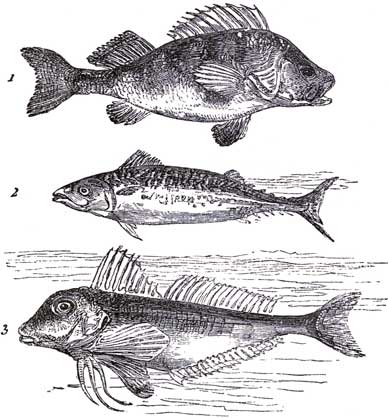
The Acanthopterygii include a great number of our ordinary useful Fishes, as Mackerel, Perch, Tunny, Gurnard, &c. (fig. 37). The Perch is a good example of this order, the sharp spines on its dorsal fin being well developed, and dangerous for anglers to handle.
2. Malacopterygii abdominales (Abdominal soft-fin).
The abdominal Malacopterygii include the Pilchard, Herring, Pike (fig. 38), Salmon (fig. 39), Anchovy, Trout, Roach, Chub, Tench, and many more of the Fish which inhabit our streams and the sea.
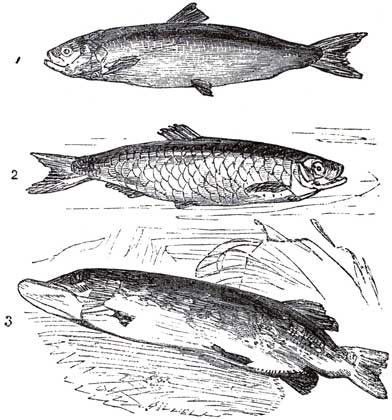
The following account of the Salmon, is extracted from Dr. Baird's Cyclopædia of the Natural Sciences:—"The Salmon is exceedingly abundant in all the northern oceans. It is found in France, England, Germany, Bohemia, Switzerland, Scandinavia, Iceland, and Greenland. It exists also in Labrador and Canada, and down the American coast to the Connecticut river, in latitude 41½ deg., and either it, or a species so closely allied as not to be distinguished except by close comparison, abounds in the Arctic seas washing the northern shores of the American continent. It does not frequent the rivers falling into the Mediterranean, and, though it has been stated to be the case, it does not occur in the Persian Gulf, or the Caspian Sea. In entering the mouths of rivers in order to spawn, the females are [Pg 263] always observed to precede the males, depositing their ova in little pools or sort of nests, which they form in the sand at the bottom, for the males to fecundate. The young grow very rapidly, and at the present time, the subject of the changes which they undergo in their progress to maturity is one exciting much interest. When first hatched they are about an inch in length, and during the first year are called "Parr." When they remove to the sea, they receive a more brilliant dress, and then become the "Smolt," varying from four to six inches in length. After a residence in the sea of from two months to ten weeks, they revisit the fresh waters, and are then from two-and-a-half to four pounds' weight, and are called 'grilses' or 'gilses.' During the ensuing winter they spawn, and are then known as Salmon. Salmon grow to a large size, full-grown specimens weighing about forty pounds, though individuals are mentioned which have weighed seventy or even eighty pounds. Such are now excessively rare, owing to the perfection of the means of capturing them at the mouths of our rivers, by which the chances are very greatly against any fish escaping the various dangers by which it is environed for such a succession of years as is likely to admit of its attaining to its full dimensions. The power these fish have in overcoming obstacles to their progress up large rivers at spawning time is very great; they shoot up rapids with the [Pg 264] velocity of arrows, and clear considerable waterfalls, leaping a height of ten, twelve, and even as much as twenty feet. The usual time at which the Salmon leaves the sea is the autumn; it remains in the rivers during the winter, and returns to the sea, after having deposited its spawn, in the spring. The fishing of this excellent and universally admired fish gives employment to many thousands of people, throughout the whole of the north of Europe. Salmon fisheries, it has been said, rank next to agriculture. In this country the Scotch rivers supply by far the greater proportion of the salmon brought to market. The total value of the Scotch fisheries has been calculated at £150,000 a year."
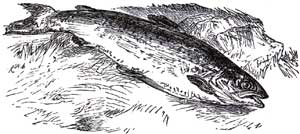
Many salmon are caught by stake nets, and also by the practice of "spearing;" this is a very picturesque sight, as it is conducted by torchlight.
The Herring (Clupea Harengus) makes its visit to this country about September, in enormous shoals, extending many miles each way; they are caught in great quantities and salted in the boats immediately; when brought on shore they are suspended in the smoke of wood fires, and become "red herrings." The Herring fisheries are very important, and afford—like the Salmon fisheries—employment to thousands; the greatest quantities are caught off the coast of Norway, where it is calculated about 400,000,000 are taken yearly. A great many are caught off Lowestoffe, and Wick, in Caithness. The Pilchard (Clupea pilchardus) is a kind of Herring, and is caught in enormous quantities off the coasts of Cornwall. The Sprat and Whitebait are species of "Clupea."
3. Malacopterygii sub-brachiales (Sub-brachial soft fin).
The brachial Malacopterygii include most of the Flat Fish; as the Turbot, Plaice, Sole, &c. (fig. 40). The Turbot, and Halibut are caught out in the deep waters, but the Plaice and Flounders, chiefly in shallows; these fish have one side dark and the other light, and both eyes are placed on [Pg 265] the dark side; they always swim with this side upwards; in the Turbot this is the left, while in Plaice it is the right side. The Cod (fig. 40) is also included in this order; it is a large fish, often weighing forty or fifty pounds, and three or four feet long; it is chiefly caught in northern regions, the banks of Newfoundland being the most celebrated for its Cod fisheries, and supply the London market. These fish are caught by a long line and hook let down to a great depth.
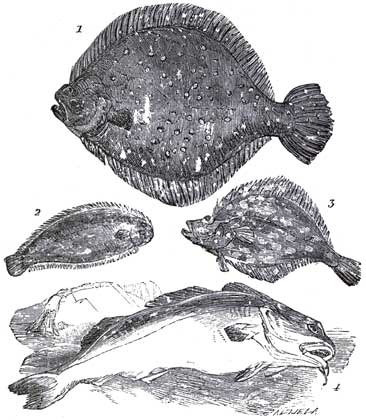
4. Malacopterygii apodes (Footless soft fin).
To this order belong the Eels (fig. 41). They have no abdominal fins, and are therefore called apodial, or footless; they very much resemble the serpent in their elongated form; they live chiefly in rivers and ponds, in the mud of which they obtain worms, &c., upon which they feed, they have been known to leave the water at night and travel for some distance in search of worms, frogs, &c. These fish live a long time after they are removed from the water, and are extremely tenacious of life; their skins are covered with such fine small scales that they appear quite smooth, and are extremely slimy. The Conger Eel is much thicker in proportion than the common Eel, and has a dorsal fin like a fringe all down the back; it grows to the weight of ninety or a hundred pounds sometimes. Eels are often caught by thrusting many-pronged spears (having the spears barbed) into the mud, and the Eels are brought up sticking between the prongs. The Electrical Eel (Gymnotus electricus) belongs to this section; it somewhat resembles a large ordinary Eel four or five feet long, but has a broad ventral fin running all along its lower part; it is famous for its power of giving electrical shocks when touched, and seems to have the power of using this influence at pleasure, but after giving a certain number of shocks its power becomes exhausted, and it has to remain some time before it can again give out shocks of any strength; these shocks are sufficiently [Pg 267] strong to prove fatal to small animals, and even to mules and horses crossing the streams which they frequent, when a number will attack them at once. This creature is a native of the rivers and pools of South America, Demerara, &c.; the natives kill them by driving in a great number of horses, and when the Eels have exhausted their electrical powers, they are then caught and killed.

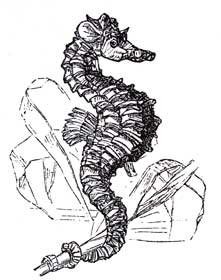
5. Lophobranchi (Tufted gill).
To the Lophobranchi belongs the Pipe-fish (Hippocampus, or Sea-horse, fig. 42). The following is Dr. Baird's description of these curious little creatures:—
"Most of these species are straight, but others of the family contract after death, so as to form a grotesque resemblance to a horse in miniature. These form the genus Hippocampus, and from their shape are generally called Sea-horses. Hippocampus brevirostris (the short-nosed Sea-horse) is occasionally met with on the British coast. It is from six to ten inches long, the body much compressed, short and deep; the whole length of the body and tail divided by longitudinal and transverse ridges, with tubercular points at the angles of the intersection. The snout is slender, and the tail long, quadrangular, and terminated in a naked or finless tip. When swimming about, the Hippocampus maintains a vertical position, but the tail is ready to grasp whatever meets it in the water; it quickly entwines in any direction [Pg 268] round weeds or other objects, and darts at its prey with great dexterity."
6. Plectognathi (Plaited jaw).
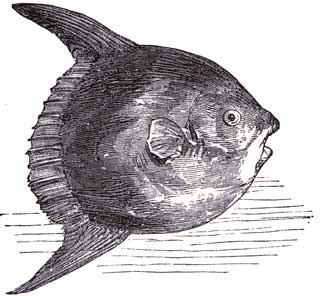
The Sea Porcupine (Diodon hystrix) belongs to this order. These Fish are of a peculiar thick rounded form, and occasionally inflate their stomachs with air, which makes them almost spherical, in which state they float with the belly upwards, and being covered with spines, present rather a formidable object to attack; the flesh is unwholesome, and, it is said, the liver is violently poisonous; some of the species of this fish are phosphorescent, and from this appearance they derive the name of Sunfish, as they shine very brightly in the dark. The short Sunfish (fig. 43) turns round as it swims; it is very large, sometimes weighing from three to four hundred pounds. They yield a considerable quantity of oil, for which they are caught. Their jaws are not divided into teeth, but consist each of a single piece; they live upon seaweeds and various crustaceans.
The Cartilaginous Fishes are divided into three orders.
1. Sturiones (Sturgeons).
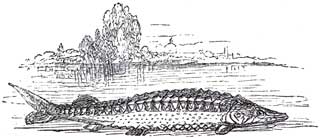
Sturgeons (fig. 44) are inhabitants of the northern seas, but are occasionally found in our rivers. They have rows of bony plates imbedded in the skin; they sometimes attain the length of twenty feet, but are usually from six to eight feet long. Isinglass is made of the swimming bladder of the Sturgeon, and the roe (dried and salted) forms the "Caviare."
2. Plagiostomi (Wide-mouthed).

The Plagiostomi comprise the Sharks (fig. 45) and Dog-fishes, a most voracious tribe; the White Shark often attains the length of twenty feet. They are terribly famous for their dreadful powers of destruction, swallowing all that comes before them; they are able to bite in [Pg 270] two, with one snap of their formidable jaws, the body of any one unfortunate enough to fall in their way; their mouths are armed with several rows of short spear-shaped teeth; the mouth is placed a considerable distance under the head, so that when biting they turn on one side or quite over; they have no gills, but the water passes through five oblong openings on each side. Sailors hold this terrible inhabitant of the deep in great detestation, as well they may, for there are few who have spent many years at sea but can tell of a friend or messmate who has been mutilated or devoured by the Sharks. When sailors catch one, it is hauled on deck and killed with great gusto; the stomach is opened and its contents examined, and it generally contains some terrible mementoes in the form of buttons, buckles, &c., the only relics of its victims.
3. Cyclostomi (Round-mouthed).

The Lamprey or Lampern (fig. 46) inhabits both rivers and lakes, and some species, the sea; it has a round mouth, by which it affixes itself to rocks, &c., and also to other fish, it is furnished with teeth on the outer edge, it has no scales, but is covered with a glutinous skin; in form it much resembles an Eel, and is from twelve to eighteen inches long. The Lamprey was once very plentiful in the Thames, and considered a dainty.
These constitute the second class of the Vertebrate animals. They are divided into four orders.
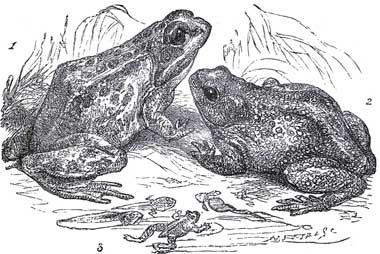
1. Amphibia (double-lived).
By some naturalists a separate class is made out of the Amphibia, including the Frog kind, Toads, and Newts (fig. 47), which they call "Batrachia," and which takes a place between Reptiles and Fishes, as the young of this class have a totally different form from the adult animal, and much resemble a fish, breathing by gills and having no legs, but as they become mature the gills are replaced by lungs, and the legs make their appearance.
The Amphibia have soft skins, which appear to serve as lungs or gills when they are under the water, extracting the air from it, and enabling them to remain a long time there without coming up to breathe; they are partly aquatic, and feed upon insects and other small creatures, which they capture by darting out the tongue, which is covered with a glutinous secretion, and drawing it in again instantly with the insect adhering to it, which [Pg 272] they swallow whole. The Frogs are furnished with webbed feet and swim well; they progress on land by leaps, their powerful hind legs carrying them to a great distance. The young of the Amphibia are brought forth as eggs, which float on the water, and when they first come to life form the curious little creatures called Tadpoles, having long tails and no feet, and, as before stated, more resembling Fish than Reptiles. The Toads are for the most part nocturnal in their habits, living in the daytime in gardens and holes; they feed upon insects, as do Frogs, and lay their eggs in the water. The stories of Toads being found alive in rock and the heart of trees, arise from the following circumstances: Toads when small will often creep into holes in rocks and hollows in trees, and in these situations they find abundance of food; being slothful in their habits, and capable of existing upon but little food, and abstaining from it a long time, they are apt to remain in their snug quarters and content themselves with what insects may come to them. In this way they grow too large to get out of the hole, and live for a great time in it; when chance discovers them, by the rock being broken open or the wood of the tree cleft, the opening into which they had crept is overlooked. The Water Newt (Triton cristatus) inhabits pools and ditches, and (like the others of this order) is first formed as a Tadpole; it is of a brown and bright yellow colour, with a crest down its back and tail, and has the most extraordinary powers of reproducing any part cut off or removed, such as a leg or the tail.
2. Ophidia (Snake-like order).
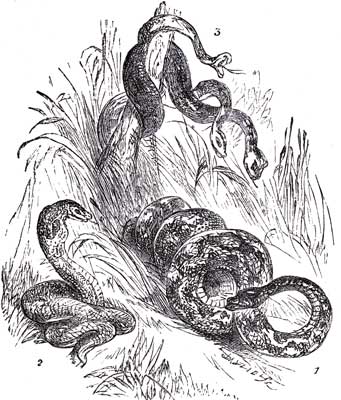
This includes the Serpents, Boas, and Pythons. These creatures are peculiar from their long and flexible form, and the absence of legs. They move by a sinuous winding action, and when about to seize their prey, make a sudden dart with great rapidity. They are covered with regular scales, and mottled with different colours; some, as the Adder and Rattle-snake, are very [Pg 273] venomous, the poison is contained in small glands connected with the poison-fangs, which are two long pointed teeth, having a groove or small canal leading from the side of the tooth to the poison-bag, upon which, when they bite, they press, and inject the poison into the wound while the tooth is in the flesh. These poison-fangs lie flat down when the creature is not excited, but are drawn up by muscles, when they are about to spring on anything. It is a common mistake to think that Serpents have a "sting," arising from their having a thin, long forked tongue, which they protrude and retract with great rapidity, and which has [Pg 274] been mistaken for a sting; the greater number of Snakes are not at all venomous. Serpents have no teeth fit for eating with, but they are used to hold their prey, while they swallow it, and they serve admirably for this purpose, as each tooth turns backwards. These creatures have mouths and throats capable of enormous distension (the lower jaw not being fixed to the upper one), so that they can swallow their food whole, which they always do; a Frog or Toad is often swallowed by the common Snake, which is quite disfigured by it when in its stomach. The Pythons and Boas (fig. 48) are the largest of this class, they kill their prey by coiling round it, and gradually tightening their folds till it is suffocated and almost crushed, when it is swallowed; these great creatures will grow to the length of 30 or 40 feet, and are capable of swallowing considerable quadrupeds, as Hares, Goats, Deer, &c.; after having their food, they lie torpid for several days. All Serpents lay eggs, and the Pythons coil themselves round upon their eggs to protect them; the Boa-constrictors are inhabitants of America, the Pythons of the Old World.
3. Sauria (Lizards).
The Sauria include the Crocodiles, Alligators, Skinks, Geckos, Iguanas, and Lizards; they are carnivorous, the smaller ones feeding on insects, and the larger members on whatever they can catch. They have four legs, and are covered with hard rough scales running in ridges on their backs, they have large strong tails, and their jaws are furnished with sharp teeth. The Alligator is found in great numbers in the Mississippi, and is a most formidable creature, attacking any who may venture into the water. In winter they bury themselves in the mud and remain there in a torpid state, they are from 15 to 20 feet long. The Crocodile is a native of Africa and the West Indies, there are many found in the Nile, it is larger than the Alligator, reaching often to 30 feet. Dr. Baird gives the following account of the Alligators and Crocodiles:—
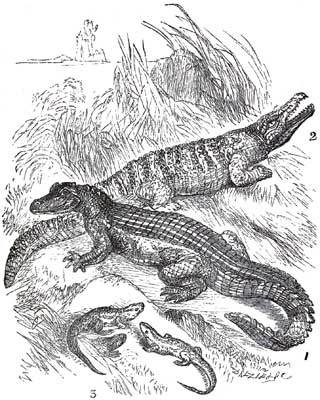
"The Alligator (Alligator lucius, fig. 49), a native of North America and abundant in the Mississippi, is a formidable and ferocious creature, prodigiously strong, and sometimes reaching the length of 18 feet. It is provided with numerous sharp teeth, long tenacious claws, and a powerful tail, a single blow of which is capable of overturning a canoe. It chiefly preys by night, assembling in large numbers, besetting the mouth of some [Pg 276] retired creek, into which they have previously driven the fish, and bellowing so loud that they may be heard at the distance of a mile. It is said to attack men and quadrupeds whilst bathing or crossing the rivers, and to be more fierce and voracious then the other species of this sub-family. In Winter it buries itself in the mud at the bottom of the swamps and marshes which it inhabits, and continues in a torpid state till Spring.
"The true Crocodiles are natives of Africa, the West Indies, and America; and the best known species is the Nilotic Crocodile (Crocodilus vulgaris, fig. 49). This animal is a native of the Senegal river, of the Niger, and other rivers of Africa, but more particularly of the Nile in Egypt, where it attains the length of about 30 feet. The Crocodile was held in great veneration by the ancient Egyptians, by whom it was known under the name of 'Champsa.' The Crocodiles are exclusively carnivorous, and are ferocious animals. Their numbers are, however, kept down by the enemies which surround them. For the adults, few animals could be their match, but the little Ichneumon or 'Mongooz' devours their eggs in great numbers while hatching in the sand; and birds of prey pounce upon their young on quitting their shell, and before they are able to reach the shore."
4. Testudinata (having a shield).
The Testudinata include the Tortoise, and Turtle kind. They are remarkable for their horny covering (carapace) which forms a sort of shell, out of openings in which, their head, tail, and legs protrude; they have short feet, covered with scales, and no teeth, but the edges of the maxillary bones are sharp, like the edge of a knife, and they bite out pieces from vegetable substances with ease. Some of this class (the Turtles) are residents of the water, and grow to a great size, weighing fourteen or fifteen hundred pounds, and measuring seven or eight feet long. Others are much [Pg 277] esteemed as food, especially the green Turtle. Dr. Baird, in his Cyclopædia of the Natural Sciences, under the article "Chelonia," gives a good description of these creatures, from which the following is extracted:—
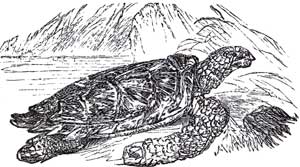
"The Green Turtle (Chelonia viridis, or midas, fig. 50) is five or six feet long, and weighs from seven to eight hundred pounds. It is principally found in the Atlantic Ocean, and is often met with seven or eight hundred leagues from land. They are easily caught when asleep on the surface of the water, to which they come to breathe. In the West Indies, the Bahama Islands, and the Island of Ascension, the capture of Turtles gives employment to many people, and affords food for thousands.
"The Hawk's-bill Turtle (Caretha imbricata) is a smaller species, scarcely ever exceeding two hundred pounds' weight, and is a native of the Atlantic and Indian Oceans. The flesh is not good, but the shells, which are formed of a considerable number of scales overlapping each other at their extremities, in the manner of tiles on the roof of a building, are of great importance as an article of commerce, and are much superior to that of any other species. It is extensively used in the [Pg 278] manufacture of combs, snuff-boxes, &c., also for inlaying, and other ornamental work.
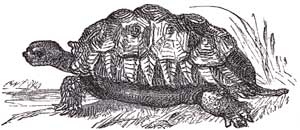
"In the family of land Tortoises (fig. 51), the feet are club-shaped, and their habits are terrestrial. The shell is very solid, thick, ovate, and (in the adult state) covered with horny concentrically-grooved shields, marked with a permanent areola. They have a short thick tail, are very slow in their motion, and live upon vegetables and roots. Most of the species are natives of the warm regions of the globe, but those that live in colder regions burrow and sleep during the winter. They are quiet, inoffensive animals, extremely tenacious of life, and remarkable for longevity. Individuals are stated upon good authority to have lived upwards of two hundred years.
"The common Tortoise, or Taragua (Testudo Græca), is a native of the south of Europe, and almost all the countries bordering on the Mediterranean; it is found in the islands of the Archipelago, Corsica, Sardinia, and in Africa, but is thought to be more common in Greece than elsewhere. It is from six to eight inches long, and weighs about forty-eight ounces. This species is often brought to this country and kept in gardens. One was brought to the Archiepiscopal garden at Lambeth, in the time of Laud, in 1633, where it lived till 1753, owing its death then, more to neglect than the effects of age."
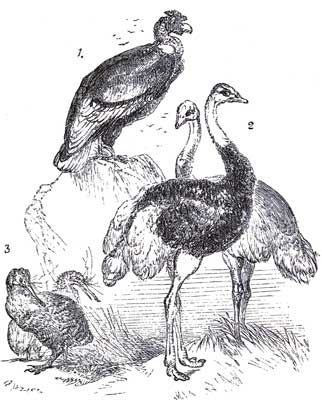
The third class of the Vertebrata, comprises the "Birds," or those whose young are not born alive, but in the form of eggs; who have warm blood, and breathe by lungs, the air-cells of which communicate with the hollow shafts of the bones, (these are full of air instead of marrow), this gives them lightness, and serves as a reservoir of air while flying; they have two anterior extremities so modified as to form wings, and a heart with four cavities; most of them have the power of flying through the air, and some to a very great height, as the "Condor" (fig. 52), while in others the wings are rudimentary and only assist them in running, as [Pg 280] in the Ostrich, (fig. 52) Cassowary, Penguin, &c., while in the "Apteryx" (fig. 52) they are quite absent.
Birds are covered with a peculiar modification of hair known as feathers; these consist of a central shaft with closely-set diverging branches, some of which have others branching from them with a serrated surface, giving them that peculiar metallic brilliancy so well shown in the feathers of the Humming Bird. Birds are furnished with beaks of almost every form, to suit their method of feeding, &c., and likewise feet, sometimes furnished with sharp and powerful talons, at others, feet suitable to climb with, and again in some they are webbed between the toes, so as to enable them to swim with great rapidity.
Birds are divided into five orders, as follows:—
1. Raptores (Preying) Eagle, Owl, &c.
2. Insessores (Perching), divided into 4 tribes, viz:—
1. Dentirostres (Tooth bill) Thrush, Butcher-bird.
2. Conirostres (Cone bill) Raven, Crow, Finch.
3. Scansores (Climbing) Parrot, Wood-pecker.
4. Fissirostres (Split bill) King Fisher, Goat-sucker.
3. Rasores (Scraping) Poultry, Pheasants, &c.
4. Grallatores (Wading) Heron, Crane, &c.
5. Natatores (Swimming) Goose, Duck, &c.
1. The Raptores, as the Eagles and Falcons, are furnished with hooked beaks and strong sharp talons (fig. 53), they prey upon all small animals, as birds of less strength, rabbits, &c., and some of them upon fish, as the Osprey, others feed upon dead flesh and offal, as the Vultures, and are very useful creatures in hot countries, where they are generally respected, they hover about the towns, feeding upon almost everything capable of being swallowed; it is not certain whether these birds detect the presence of food by smell or sight (both of these senses are possessed by them in perfection), but it is certain that in the desert, when any animal dies, these birds soon make their appearance, although a few minutes before not one could be seen for miles around. The Owls are nocturnal, their plumage is downy, and their eyes placed so that both shall look forwards, the pupils close, similarly to a cat's eye, and their vision, like the cats (their companions [Pg 281] among the Mammalia) is extremely sensitive, so that the expression "as blind as an Owl," has no more sense in it than "as blind as a Cat" would have; they feed upon rats, mice, insects, &c.
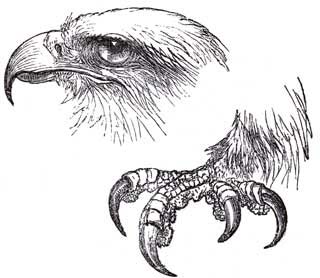
2. The Inessores include some that live by catching insects in the air while they fly, as the Swallows (fig. 54); these are furnished with great powers of flight and rapidity of movement; others (the Scansores) which climb and hold by the branches of trees, feeding upon nuts and fruit, as the Parrot; others live upon insects, but seek them in the crevices of old trees and other similar places, as the Woodpeckers (fig. 54). Some live entirely upon fish (King-fishers), which they catch from the streams on the banks of which they live. This order includes all the singing birds, and by far the greater number of birds of passage; this propensity to migrate is one of the most wonderful of all the instincts of Birds, the Swallow [Pg 282] leaves England in the Autumn to take up its abode for the Winter in Africa, or the Islands of the Archipelago, and returns again in the Spring, year after year, to the same nest; these journeys are accomplished at the rate of 40 or 50 miles an hour. Pigeons also have the wonderful faculty of returning home from almost any distance, appearing to know by instinct the right direction; as, after a turn or two, they take a straight course to their destination.
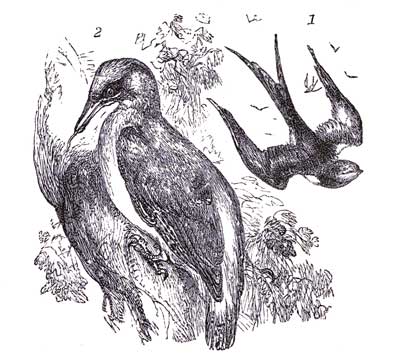
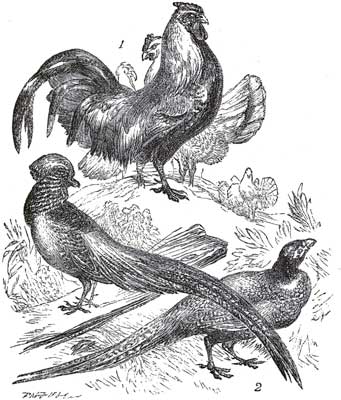
3. The Rasores include the common Fowl (fig. 55), Pheasant (fig. 55), Partridge, Turkey, &c.; they feed principally on grain, but occasionally on insects and worms, which they scrape up with their feet; they live chiefly upon the ground, on which they build their nests, but generally roost on trees. Most of this order supply excellent food, the Turkey is famous as a Christmas dish, and is often of a great size; this bird is very plentiful in Central and South America in a wild state, and often [Pg 283] attains a large size, weighing 30 or 40 pounds; the natives have a simple and curious method of catching these birds, which are extremely shy, never allowing any one to approach near to them. A sort of cage is built of twigs, large enough to contain many, and having holes close to the ground all round, of a size just sufficient to admit a Turkey when its head is bent down; leading to each of these holes a train of corn is placed, but none within, the birds coming to pick the corn, follow up the line of corn with their heads down, till they are within the inclosure, when finding no more, they raise up their heads and cannot get out, for they have not the sense to stoop their heads, so as to allow of their exit.
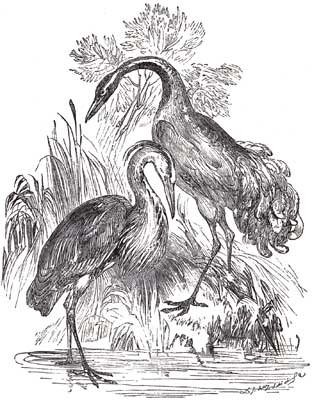
4. The Grallatores include the Herons and Cranes (fig. 56), which wade into streams and catch fish; these are furnished with long legs, neck, and beak, and when they have gone into the water as far as their long legs permit, they stand still and wait with the head resting on the shoulders and the eyes fixed on the stream, till an unlucky fish approaches near enough, when with a quick stroke they dart at it, and catch it; they are very picturesque objects, standing on one leg (as they commonly do) in some lonely pool or stream.
5. The Natatores, a very large class of Birds, live almost entirely in the water, they are web-footed and swim beautifully, as the Swans, Geese, Ducks, &c. (fig 57); these feed in general upon the vegetation growing in, and on the margin of the water, also on worms, larvæ, &c.; they have a beautiful mode of rising and flying in a line, when disturbed from their haunts, and this line is maintained for a long distance, and is sometimes double like the letter V, one bird leading and the others following in single file.
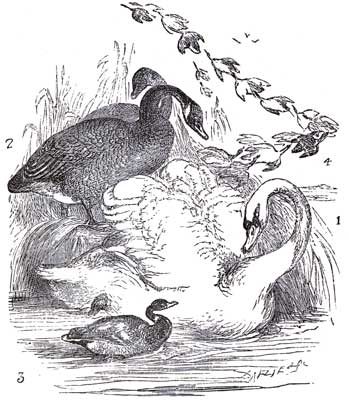
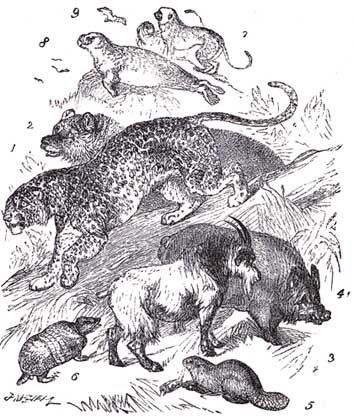
This class is divided into twelve orders:—
1. Marsupiata (Pouched) Kangaroo.
2. Monotremata (Having but one vent) Platypus.
3. Rodentia (Gnawing) Beaver, Rabbit.
4. Edentata (Toothless) Anteater.
5. Ruminantia (Chewing) Ox, Deer, Sheep.
6. Pachydermata (Thick skinned) Horse, Elephant.
7. Cetacea (Whale-like) Whale, Porpoise.
8. Carnivora (Flesh-eating) Lion, Tiger.
[Pg 287]9. Insectivora (Insect-eating) Mole, Hedgehog.
10. Cheiroptera (Hand-winged) Bat.
11. Quadrumana (Four-handed) Monkey, Ape.
12. Bimana (Two-handed) Man.
These twelve orders of the class "Mammalia," of the division "Vertebrata," (as their names imply), have their peculiarities, such as fit them to their modes of life, as, the medium in which they live, the climate, the food they eat, and the manner of obtaining it. They have all the five special senses, sight, hearing, smell, taste, and touch, but very differently developed in respect to power. Yet, as a whole, they maintain a similitude. They have all internal skeletons, and each part of this skeleton exists in all, but modified to suit different purposes. They have all the peculiar attributes of the "Mammalia," such as suckling their young, being born alive, having four extremities, warm blood, respiration by lungs, and a heart with two auricles and two ventricles.
A general description of the anatomy and some of the functions of Man will be given hereafter, and will apply equally to all the Mammalia; always bearing in mind that the difference in structure of every animal, although making it inferior to Man, does not do away with any of the essential qualities, which constitute it one of the members of the highest group; for, although immensely inferior to Man, yet the Mammalia are for the most part greatly superior to all the classes below it, the capability of being educated, being in itself a vast step beyond mere instinct, wonderful though this may be, and developed to an extraordinary degree, as in some of the insects; yet, in these, there is no possibility of improving it, while in some of the Mammalia, as the Dog, Horse, Elephant, and Monkey, there is an evident tendency to progressive improvement when aided by the example and tuition of Man.
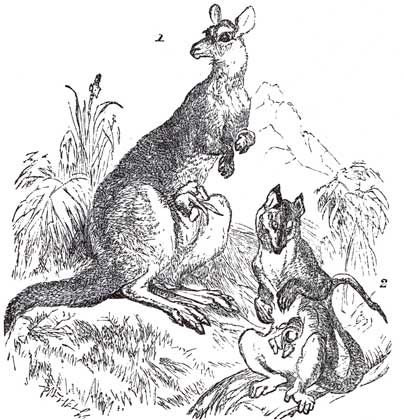
1. The Marsupiata include the Kangaroos and Opossums (fig. 59). They are characterised by the possession of a pouch at the lower part of the abdomen, into which the young enter as soon as born, for they are born in a very imperfect state, and when in the pouch they adhere to the teat of the [Pg 288] mother, where they remain till more fully developed. In these animals the hind legs are greatly developed, and the fore legs but little. They progress by enormous leaps, resting on the hinder legs and tail, both of which are very strong. They belong exclusively to Australia, which appears to produce many forms having peculiarities not met with elsewhere, and among the lowest of their type; this and the next order appear somewhat to partake of the form of the Bird, the undeveloped state of the young in the Marsupiata, being an approach to the egg of the Oviparous animals.
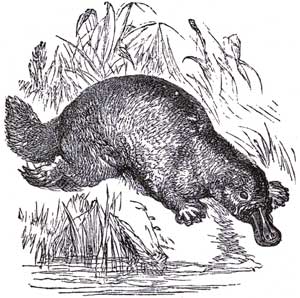
2. The Monotremata includes the Duck-bill, called also "Platypus," and "Ornithorynchus paradoxus," (fig. 60), a most singular combination of the forms of the mammal and the [Pg 289] bird. It has a mouth resembling the bill of a Duck, and several other peculiarities, which lead to the consideration of it as one of the connecting links between the forms of the Mammalia and Birds.
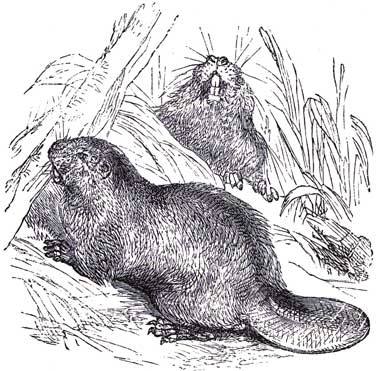
3. The Rodentia comprise the Rat, Beaver, Rabbit, Hare, Mouse, &c. They live upon almost any kind of vegetable matter; the Rat and Mouse will eat anything they can get. Their incisor teeth are two in front of each jaw, and are chisel-shaped and very sharp; they are so constructed that they shall be kept sharp by being used, which is effected by the hardest part or enamel being in front in a thin layer, so that it is not so easily worn away as the bony part. If these animals be fed on soft food, their teeth continue to grow nevertheless, and protrude from their mouths in a most singular way. The Beaver (fig. 61) is almost aquatic in its habits, it gnaws through the stems of trees, and uses them to dam up the water of the stream they inhabit, so as to secure a constant supply. They build houses or huts of wood, mud, and stones, which they unite in constructing. These houses have their entrances beneath the water, so [Pg 290] that the Beavers dive to enter them; they have two divisions or rooms in them, and are sufficiently large to lodge several families. The Rat is too well-known to need much description. The brown or Norway Rat has only been an inhabitant of this country about forty years, the black Rat being before that time the usual house Rat, but it is now almost exterminated, specimens being very rare. There are several other species of Rats; the best known is the Water Rat, who burrows in brooks and ditches, and partly lives in the water. Of the Mouse there are also several species. Besides the usual house Mouse, there is the wood Mouse, which forms a magazine of grain and nuts underground for winter store; and the harvest Mouse, which builds a little round nest between the stalks of corn. The Squirrel is also of this order. This pretty little creature lives in the trees, chiefly feeding upon nuts; can leap well, and run up the branches of trees with surprising agility. The Flying Squirrel has a broad expansion of skin between [Pg 291] the fore and hind legs on each side, so that when stretched out, they form a sort of parachute; this enables the creature to leap to a great distance from tree to tree, and supports it in the air as it goes. The Porcupine (Hystrix cristata), so celebrated for its quills, which supply a sort of defensive armour, is of this order.
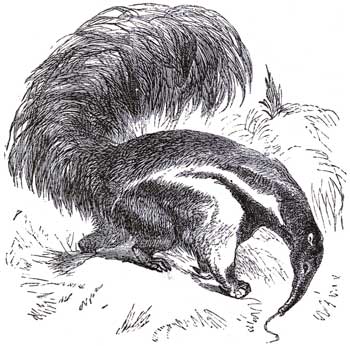
4. The Edentata, or Anteaters, have no teeth, but a peculiarly shaped tongue, which is covered with viscid mucus, and which they project and retract with great rapidity, causing the Ants and Termites, on which they feed, to adhere to it, and be carried into their mouths. The Great Anteater (Myrmecophaga jubata, fig. 62) is a very extraordinary animal in appearance; it has an enormously prolonged nose, and the back is covered with a sort of mane; the tail, also, is of prodigious size, and very bushy; when this curious animal lies down to sleep, the long snout is thrust under it, and the tail laid across the back, the end of [Pg 292] the snout projecting behind. In this position, it would lead anyone to suppose that the head was where the tail really is, and that when looking at the creature's hinder part, they were looking at its head; and the sudden reversal of the position of these parts, when it gets up quickly, is certainly extremely ridiculous.
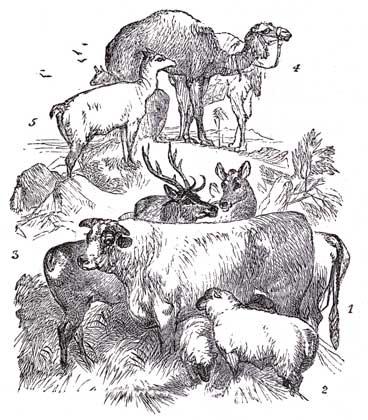
5. The Ruminantia.—The Ruminating animals (fig. 63) are those which chew the cud. There are a great many species, and their members are also very numerous. The Ox, and its varieties, the Buffalo, Bison, Yak, &c.; the Deer, Antelopes, Gazelles, &c.; the Sheep, Goat, Giraffe, and Camel, all belong to the Ruminants. These all have hoofs, cloven into two parts; have no incisor (or front) teeth in the upper jaw; and are essentially grazing animals. They have stomachs made up of four compartments; into the first of these (the Rumen) the crude grass enters, and is afterwards returned to the mouth, and again chewed at leisure; the molar teeth, or grinders, are flat, and roughened, so as to effect this purpose; and, that they may not become smooth by wear, the enamel (or hard part) of the teeth is so disposed in various layers, that it is always projecting above the bony part, which wears down first. The Ruminants are gregarious, associating in herds of enormous numbers. Cumming, describes the herds of Springboks, in South Africa, as being in countless thousands, continuing to pass for hours together; and covering the plain as far as the eye could reach. Cattlin, also, describes the American Bison of the Prairies as being congregated in the most surprising numbers. Some of the members of this order are very large and heavy animals. The Cape Buffalo is of enormous strength, and very fierce when attacked.
Dr. Livingstone, in his Travels in South Africa, speaking of the Lion, says:—"He seldom attacks full-grown Buffalos; but frequently, when a Buffalo-calf is caught by him, the cow rushes to the rescue, and a toss from her often kills him. One we found was killed thus, and on the Leambye, another, which died near Sesheke, had all the appearance of having received his death-blow from a Buffalo. It is ques [Pg 293]tionable if a single Lion ever attacks a full-grown Buffalo; the amount of roaring heard at night, on occasions when a Buffalo is killed, seems to indicate there are always more than one Lion engaged in the onslaught."
The Ruminants are the only members of the Mammalia furnished with horns, and some of these are of enormous size; the Elk, Buffalo, and Steinbok, are instances. In the Deer tribe they are shed yearly, and increase in size and in the number of their branches at each fresh growth. The flesh of the Ruminants forms the chief animal food of Man, [Pg 294] and some tribes of the American aborigines live exclusively on it.
The Camel, next to the Horse, is the most useful beast of burthen. The Arabs greatly prize these creatures, and from their power of carrying a supply of water in their stomach, they are very useful in crossing the desert; their hoofs are also spread out so as to enable them better to walk on the soft and yielding sand; there are two kinds of Camel, the Bactrian, with two humps, and the Arabian Camel with but one. The Dromedary is a small agile breed of the Arabian Camel, celebrated for its swiftness.
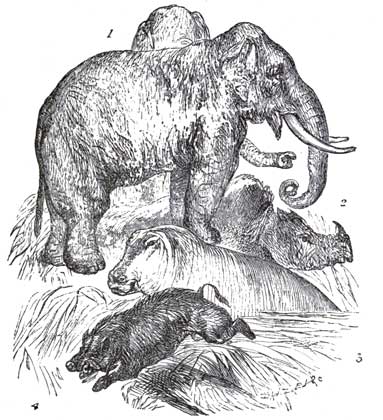
6. The Pachydermata or thick-skinned animals (fig.64) include the Elephant, Rhinoceros, Horse, Ass, and its varieties; Hog, Tapir, Hippopotamus, &c.; these have many of them a single solid hoof on each foot, as in the Horse and Ass tribe, others have separate toes clothed with a hoof, as in the Elephant. In nearly all the Pachydermata there is a prolongation of the nose or upper lip, the Horse even has some power of prehension in this part; the Rhinoceros is able to bring the upper lip into so fine a point as to pick up a crumb, and in the Tapir there is a considerable prolongation of the nose, while the Elephant has this part developed into a complete prehensile organ.
The Elephant, Rhinoceros, and Hog are fond of wallowing in the mud, with which they completely besmear themselves, and seem to derive great satisfaction therefrom. There are two kinds of Elephants, the Asiatic, or Indian, and the African, the chief distinction between them is the size of the ear, that of the African Elephant being of very great size; there is a very young specimen of this kind in the British Museum, but a full-grown African Elephant has never been brought to England. The Elephant is furnished with a pair of enormous tusks proceeding from the upper jaw, these are composed of solid ivory, and often weigh nearly a hundred pounds each; with the trunk, the Elephant is able to gather food in the form of grass and herbage, and put it into its mouth, it can also draw up a considerable quantity of water, and this being poured down its throat [Pg 295] from the trunk, constitutes its usual mode of eating and drinking, as the neck is too short for the animal to reach the ground except by the trunk. The Indian Elephant is much used as a beast of burthen, and for various other purposes; they are very docile and sagacious.
The Horse has been subjected to the service of Man from the earliest records, indeed it is not known when this beautiful animal was first trained to be his useful servant and companion; he is mentioned, in the Scriptures, as being subjected to the Bit, and in the sculptures brought from [Pg 296] the ruins of Nineveh by Layard; the Horse is constantly sculptured, decked in the most gorgeous trappings and driven by reins and a bit, almost in the same manner as in the present day, and these sculptures are among the earliest records of Man's hands. There are several breeds of Horses; the chief are the Arabian (from which stock proceed our race horses), the Flanders or Cart-horse, and the Sheltie or Shetland horse. The Horse is nowhere found in a state of nature, yet many wild Horses graze on the plains of America, but it is known that these are not native, but proceed from those placed there to graze, and which have bred and run wild. The Ass is distinguished from the horse by the tail having short hair on it, except at the extremity, and the mane being short and upright.
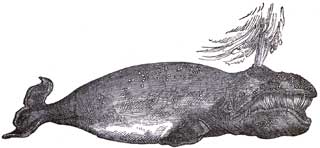
7. The Cetacea, or Whale kind, inhabit chiefly the colder latitudes, they are entirely aquatic, but breathe air; the Whale, Narwal, Dolphins, and Porpoises are the chief members.
In Whales (fig. 65) the anterior extremities are so developed as to form a sort of fin called a "flipper," but in which all the usual bones of an extremity exist; the posterior extremities are modified so as to completely resemble the tail of a fish; they have smooth skins devoid of hair. All these tribes have a considerable thickness of fat or [Pg 297] blubber (as it is called) beneath their skin; this protects them from the cold, for most of these creatures live in the very coldest climates, the oily matters acting as a non-conductor; it is for the oil yielded by this blubber that they are chiefly caught. The Cachelot or Sperm-whale (Phyceter macrocephalus) also yields spermaceti, which crystallizes from the oily matter contained in its head, and the Greenland-whale yields baleen or whale-bone, which is a substance forming a sort of sieve in the mouth, through which they draw the sea water and catch all it may contain for food, this consists of all small fish, but principally a small mollusc called the "Clio Borealis," which inhabits the northern seas in great numbers; a whole shoal of these is taken in by the Whale at a draught. The Whale often measures 60 or 70 feet in length, and the Razor-back Whale sometimes 100; a large Whale will yield 20 tuns of oil. The Narwal or Sea Unicorn is from 20 to 30 feet long; it has but one tooth, which is developed to a prodigious length, and projects in front in a straight line like a sort of horn, there are however sometimes two of these, one being always much larger than the other; this horn is 8 or 10 feet long, perfectly straight and twisted, it is used by the animal to break the ice so that it may breathe, and also to spear and capture fish, on which the Narwal lives. This horn produces beautiful ivory.
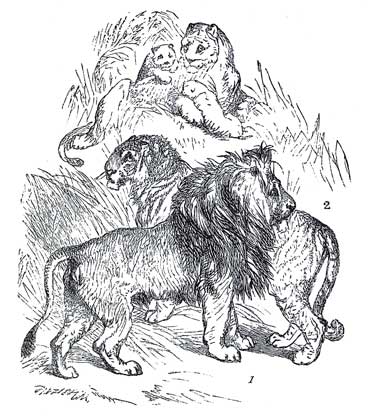
Lion (Leo Barberus); 2, Tiger (Tigris regalis).
8. The Carnivora, or Flesh-eaters (fig. 67), include the Feline tribe, as the Lion, Tiger, Jaguar (fig. 68), Leopard, &c.; the Canine, as the Hyena, Wolf, Jackal, Dog, Fox, &c., the Ursine, which includes the Bears, and the Phocine, including the Seal kind. The Feline tribe are formed to spring upon, hold, and rend other animals which they kill for food, and have teeth and claws suitable to this purpose, and great activity and strength to enable them to contend with, and overcome their prey. They are, for the most part, nocturnal in their habits, seldom seeking their prey but in the night, and then mostly frequenting the drinking-places where other animals come for water. They attack by gradually stalking after the animal, getting nearer and nearer, till at last [Pg 298] a well-directed spring brings them on to it at once. That these animals may better surprise their prey, they have eyes so extremely sensitive to light that they can see well when it would appear to Man to be quite dark, hence the saying, "cats can see in the dark." The Iris (or coloured part of the eyes) in this tribe is made so as to close up into a slit (1, fig. 66), and thus exclude the light of the day to a great extent, which would otherwise be too powerful, and injure the extreme sensibility of their vision. Their claws (2, fig. 66) are made to retract by a tendon, so as to keep their points from being worn by walking. This accounts for the silent, stealthy tread of the domestic cat; it enables them to creep quietly upon their prey, and at the moment they are about to seize them, the claws are extended. The pointed or flesh-teeth of the Carnivora are greatly developed, and are very sharp. Their molars (3, fig. 66) are pointed, and suitable to the food they are intended to masticate. The tongue of the feline tribe is very rough, and is used to rasp off the flesh from bones. When closely examined, the surface of their tongues present a series of horny hooks, all bending in one direction, and forming a sort of rasp.
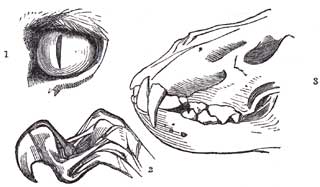
The Lion is usually placed at the head of this race, but it [Pg 299] is questionable whether he is so powerful as the Bengal Tiger, and combats between the two, generally give the mastery to the Tiger.
Dr. Livingstone, in his description of the Lion, takes off a good deal of the poetical nobility and imaginary superiority with which the Lion has been commonly invested. The following selections will show what are Dr. Livingstone's impressions from personal experience:—"When a Lion is met in the day-time, a circumstance by no means unfrequent to travellers in these parts, if preconceived notions do not lead them to expect something very 'noble' or [Pg 300] 'majestic,' they will see merely an animal somewhat larger than the biggest Dog they ever saw, and partaking very strongly of the canine features. When encountered in the day-time the Lion stands a second or two gazing, then turns slowly round and walks as slowly away for a dozen paces, looking over his shoulder, then begins to trot, and when he thinks himself out of sight bounds off like a greyhound. By day, as a rule, there is not the smallest danger of Lions which are not molested attacking Man, nor even on a clear, moonlight night, except at the breeding-time.
"So general, however, is the sense of security on moonlight nights that we seldom tied up our Oxen, but let them lie loose by the wagons; while, on a dark, rainy night, if a Lion is in the neighbourhood, he is almost sure to venture to kill an Ox. His approach is always stealthy, and the least appearance of a trap is enough to cause him to refrain from making the last spring.
"Lions never go near any Elephants, except the calves, which, when young, are sometimes torn by them. Every living thing retires before the lordly Elephant, yet a full-grown one would fall an easier prey than the Rhinoceros. The Lion rushes off at the mere sight of the latter beast."
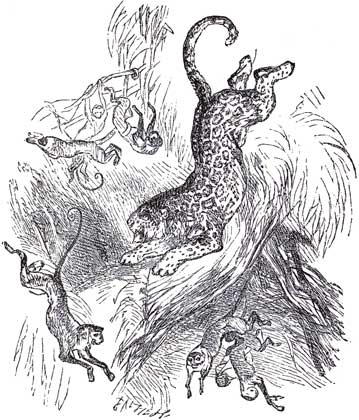
The Bengal or Royal Tiger is the largest of the Feline tribe, being generally 8 feet long and 4 high. It is, however, often found much larger. It would appear from the most correct accounts that the Lion is hardly a match for this formidable creature. The Tiger is as beautiful as dreadful; its colour is of a bright orange-buff, with white face and under parts, the back and legs being beautifully striped with black. The Tiger has no mane, but is of a sleek, graceful make, though terribly powerful. It inhabits India chiefly, and will prowl for hundreds of miles by the sides of rivers, secreting itself in the jungle and sleeping by day. Sometimes traces of a Tiger will be seen in the locality of villages or towns, and stray Sheep or Bullocks disappear from time to time, but it will destroy any human being who unluckily approaches its haunts, and having once tasted human blood, appears afterwards to prefer this kind of food to all others, and will pick out [Pg 301] a cow-herd in preference to the cattle he is driving; in all probability this preference is really owing to the ease with which the capture can be made; and the small resistance Man is capable of offering; be this as it may, the Tiger having once destroyed a man is called a "man-eater," and a reward is offered for his head; when this occurs near any of the stations of the East India Company, the officers generally make it a point to sally forth and endeavour to capture this terrific beast; this they do on foot, as it is impossible to depend on any Horse, their natural fear of the Tiger being so great that all Horses either shy, or at once retreat. The officers, armed with guns, take with them a [Pg 302] number of natives, who with long canes beat the jungle and generally start out the monster, at whom there are a few deadly rifles pointed, which invariably bring him at once to the ground.
The largest of this tribe inhabiting the New World, is the Puma or Cougar, which is much inferior to the Lion both in size and strength, although very fierce and dangerous, it is of a pale drab colour inclining to grey; it climbs trees and stretches itself along their branches, waiting for some unlucky animal to pass, when it drops quietly upon its shoulders and quickly destroys it. The Leopard tribe includes several varieties, as the Jaguar, Panther, Ounce, Ocelot, &c., they are all more or less spotted with black, and possess all the ferocity and much of the strength of the nobler species of their tribe, the smallest of them being more than a match for a man without weapons.
The Canine tribe of the Carnivora includes Dogs, Wolves, Jackalls, and Foxes. The Dogs are greatly altered from their wild nature by being domesticated, resembling in their wild state a small Wolf; the Dog in its domesticated state is too well known to need any description here. The Jackals and Wolves generally hunt in packs, and devour all kinds of offal, flesh and bones, which their strong jaws and teeth appear to crush and break up without difficulty.
The Bears form the next tribe, these are often very large animals; the Grisly Bear of the Rocky Mountains (Damis ferox) is the largest of the Brown Bears, it often measures eight feet long and is extremely powerful, the Brown Bear (Ursus arctos) is smaller, but still a powerful animal, the Polar Bear (Thalarctos maratimus) is white and is the largest of all the Bears, measuring eight or nine feet long, it is coated with long shaggy hair, and even its feet are clothed with hair underneath, that it may not slip on the ice, and to defend it from the cold; this Bear is found in the Arctic Regions among the ice, and feeds upon Fish and other marine animals. Bears in general are carnivorous, but eat many other kinds of food; they are very fond of honey, and are never contented if they smell it, until they get at it, for this purpose they will often gnaw a hole in a tree and [Pg 303] thrust in their head. Advantage is taken of this predilection to entrap the animal, the natives of the Rocky Mountains often baiting Bear traps with honey.
The Seals and Walrus (fig. 69) form the next, or Phocine tribe; they are amphibious, and feed chiefly on Fish, inhabiting the colder regions of the North; their hinder extremities are but little developed, and serve the purposes of a tail. They are covered with a close fur, and the canine teeth of the Walrus are so largely developed in the upper jaw as to form tusks, by means of which they hook on and attach themselves to the blocks of ice.
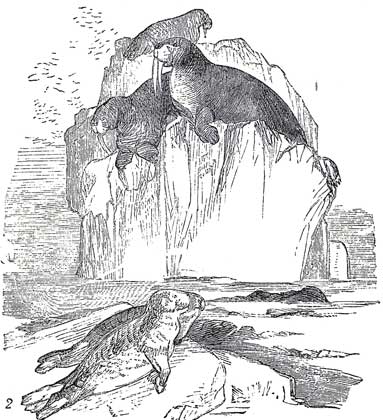
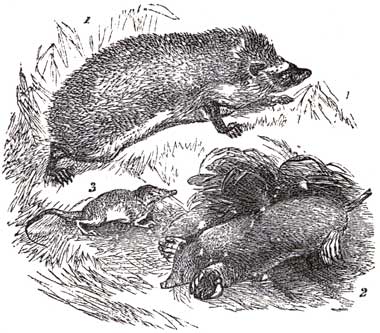
9. The Insectivora, such as the Mole, Hedgehog, and Shrew-mouse, (fig. 70), live entirely on insects, the Mole burrows for them in the earth, and the fore paws are so made as [Pg 304] to dig out and throw the earth behind it, and it burrows in this way with the greatest rapidity. As it is nearly always beneath the surface of the earth, and consequently in the dark, so a sense of vision is not required, it is therefore blind, but the senses of touch and smell, being very acute enable it to find its food. The Hedgehog and Shrew-mouse are furnished with pointed noses, with which they dig up the earth in search of insects, and when found they devour them with amazing rapidity. The Hedgehog has the power of rolling itself up into a ball and defying the attacks of almost anything, for its bristles are so stiff and sharp that they prick like thorns, and make a capital defensive armour; the Hedgehog is eaten by many, especially by the Gipsies, who esteem it a dainty.
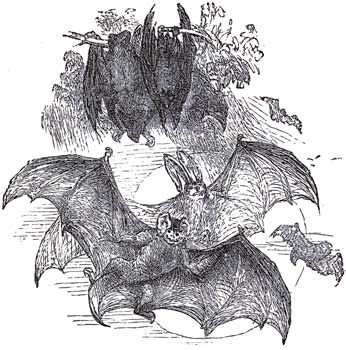
10. The Cheiroptera (Bat tribe, fig. 71), have fore feet so modified as to serve as wings, with which they fly with tolerable swiftness, producing a peculiar flapping sound. These wings are formed by a membrane which is stretched out between the fingers, which are exceedingly elongated, and [Pg 305] which reaches from the fore feet to the hind feet. The Bat tribe all feed upon insects, especially moths; they rest in the day time head downwards, clinging to rough places by means of the claws of their hind feet, coming out at night to seek their food; their sight, which is very quick, enabling them to see their prey when almost dark. Some of the larger species of this tribe, inhabiting America, are called Vampire Bats, they live by sucking the blood of various animals, such as cattle and horses, thereby inflicting dangerous wounds.
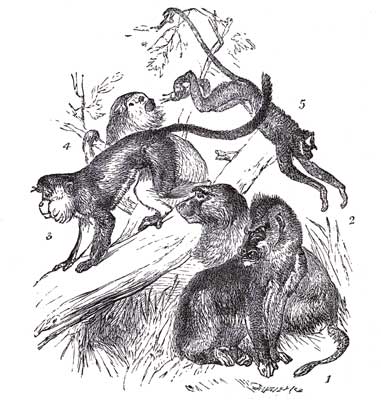
11. The Quadrumana (fig. 72), so called from their hind and fore feet both having thumbs, and being developed into hands, includes the Monkeys; they may be divided into two tribes, those inhabiting the Old World (Simiidæ), and those inhabiting the New (Cebidæ), these include what were formerly called Apes, Baboons, &c. These animals approach the most nearly to the form of the human being, the [Pg 306] Chimpanzee being considered the nearest in formation to Man; there are, however, many very broad distinctions between the two, especially in the foot and head. The Quadrumana are very clever, but their actions seem to have more meaning in them than they in reality possess, owing to the resemblance of these creatures to the human being. There are many surprising accounts of these beings, such as their arming themselves with sticks and stones to defend themselves; but no act of reason has ever yet been perceived in them, nor any tendency towards improvement, [Pg 307] except that which has been given them by Man. "The Monkey who had seen the world," and went home and taught his companions, is a fable in both senses of the word. The Monkey tribe are formed to pass their lives in the trees among the branches, their hands being formed to suit this kind of life. None of them walk well, but when they are among the branches, swinging themselves from bough to bough, few creatures are more active; their food is fruit and nuts of all kinds. The Chimpanzee, certainly, is the nearest approach to Man in the lower animals, and walks better in an upright position than does the Ourang-outang, whose whole life is spent in the trees, while the Chimpanzee often inhabits holes in the earth and rocks. In the "Penny Cyclopædia" is the following account of one, by Captain Payne:—
"It shook hands with some of the sailors, but refused its hand with marks of anger to others, without any apparent cause. It speedily, however, became familiar with the crew, except one boy, to whom it was never reconciled. When the seamen's mess was brought on deck it was a constant attendant, would go round and embrace each person, while it uttered loud yells, and then seat itself among them to share the repast."
Some of the Monkey tribe (the Spider-monkeys) have the power of holding fast with the end of the tail; it, in fact, forms a sort of hand, and they swing from the boughs by it, and it is said that several will attach themselves in this way, forming a long chain, and swing themselves from the topmost bough of a tree when they wish to cross a stream, the lowest catching hold of the boughs on the opposite side, and the uppermost of them letting go his hold, they are all thus conveyed across.
12. Bimana (two-handed). This order includes Man alone. Man has been placed in a separate class, and not as the first order of the Mammalia, but, as will be presently noticed, although he has many attributes which no other animal has, yet in bodily construction, and all the functions of his material part, he so nearly resembles the other orders [Pg 308] of his class that it is deemed better to place him at their head under the designation of "two-handed;" although indeed he is the only animal who can be said to possess hands, properly so called, for those of the Monkey tribe are so imperfectly developed that they have but little claim to the name.
In his circulation, respiration, digestion, &c., Man exactly resembles the other Mammalia, also in the organs of locomotion and special sense, modified slightly in form; but to these purely animal attributes, he has superadded faculties which raise him above them, and show him to be the last and most perfect of God's creatures, one step further, in fact, than any other living being; and it is a curious circumstance, and one showing the accuracy of detail, with which the Mosaic account of Creation in the Bible abounds, that this very superiority is not only mentioned in many ways, but recorded as the result of a special act of God over and above his formation as an ordinary animal, in which state he was created, for we find the words, "and breathed into his nostrils the breath of life, and man became a living soul," this especial act was not performed for any other being which God had created, of which it is stated simply "male and female created He them."
Man is possessed of sentiments (or those feelings which prompt him to believe in, look forward to, and hope for a higher state of existence, than that which he enjoys here) which none of the lower animals have, and of reason in place of instinct. There is certainly a vast difference between the two, although many would have us believe the one is the same as the other, but of a higher order; instinct causes its possessor to act from innate impulse without consciousness of the result, while reason points out "the why and the wherefore." Man is conscious of his own identity, this is also peculiar to him; moreover, all the performances of man can be improved by practice, none of the instincts can, but are as perfect at first as at last; the Bee makes the comb, and the Bird the nest, as well the first time as the last, and although the higher animals, as the Dog, Horse, Elephant, &c., can be taught to perform [Pg 309] various clever and useful acts, yet it is by Man's instrumentality and not by their own powers; in fact there is not an animal which left to itself has the slightest power within [Pg 310] itself of deviating one iota from those peculiar instincts which were given it by God. But Man at every effort rises higher than he was before, till he arrives at such a knowledge of the great works and designs of his Creator that he bows his head in awe and admiration of the wonders permitted to appear to his comprehension. With respect to his bodily structure, Man undoubtedly stands first in the race of beings, although, in some particulars, such as the acuteness of the senses, he may be inferior to some.
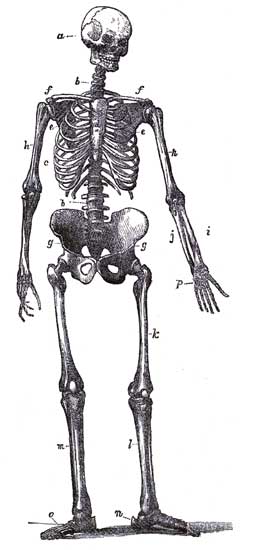
a. Skull.
b. b. Vertebral column or Spine.
c. Ribs.
d. Sternum or Chest bone.
e. e. Scapulæ or Blade bones.
f. f. Clavicles or Collar bones.
g. g. Pelvic or Hip bones.
h. h. Humeri or Arm bones.
i. Radius }
} Bones of fore-arm.
j. Ulna }
k. Femur or Thigh bone.
l. Tibia or Large bone of leg.
m. Fibula or Small bone of leg.
n. Calcaneum or Heel bone.
o. Tarsal bones or Bones of the
foot.
p. Carpal bones or Bones of the
wrists.
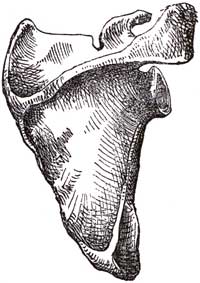
The Human frame consists of a skeleton (fig. 73) formed of hard
and unyielding bone, having joints to admit of motion in certain
directions; this skeleton performs certain great and important offices,
it forms strong boundaries or protecting cases for most of the vital
parts, so as to shield them from external violence, such as the brain
and spinal cord, the lungs, heart, &c., it also furnishes a series of
levers to be acted on by the muscles, for the purposes of motion, and a
firm support for the soft parts of the system. The skeleton is divided
into the head, trunk, and extremities; the head is again divided into
cranium and face; the trunk is divided into spine, thorax, and pelvis;
the extremities into the upper and lower, the upper consisting of arm,
fore-arm, and hand; the lower of thigh, leg, and foot. The bones are
divided into "flat bones" (fig. 74) and "long bones" (fig. 75), the
flat bones (as a general rule) form the boundaries of the cavities, and
the long bones the levers.

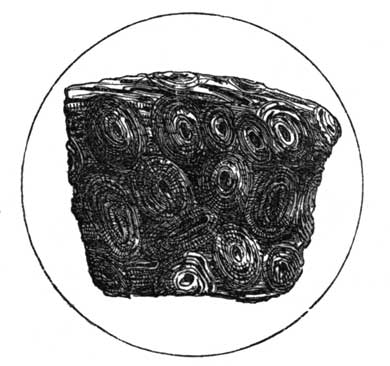
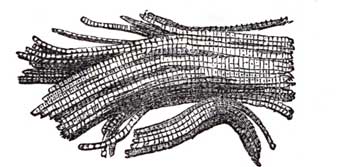

The bones consist of earthy matter, chiefly phosphate of lime, held together by a sort of cartilage, and arranged in fine scales or plates forming interstices or cells (fig. 76), these are large in the centre of the bone so as to make it nearly (and in some instances quite) hollow, and very small at the surface, so as to make it there nearly solid; this arrangement is found to be the very best to secure strength and lightness, [Pg 311] together with a very slight degree of flexibility. The general form of a long bone is that of a shaft, having an enlargement at either extremity, the shaft is generally curved slightly so as to give elasticity, and is more solid than the ends, which are expanded to give size and firmness to the joints, and porous to keep them light; the shaft is small and close in its texture, that there may be plenty of room for the muscles which lie on and cover it. The skeleton then, consists of bony cases which enclose the viscera, a series of levers covered with, and moved by the muscles, and the whole forming a solid framework to support the soft parts. All the various motions of the body, from the winking of the eyelid and the wonderfully adjusted motions of the eye itself—which are so accurate, that a certain perceptible motion is required to look alternately at one side [Pg 312] and the other of a pin's head—to the most powerful stroke of the arm, are performed by the contraction of the muscles. But there are several actions which would at first appear to be produced by elongation instead of contraction, such as the protrusion of the tongue, the winking of the eyelids, and the closure of the lips; but the first of these is produced by the contraction of a muscle which is attached at one extremity to the under part of the root of the tongue, and at the other to the inner part of the lower jaw, which, when it contracts, draws the whole tongue forwards, causing a part of it to protrude; the eyelids and lips are closed by circular muscles surrounding them, which, by contraction, draw together those parts.
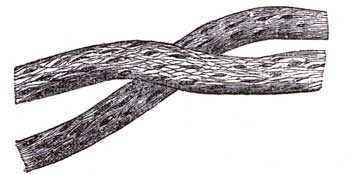
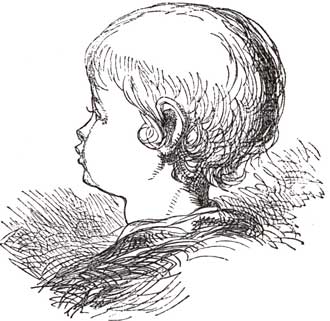
The muscles form the flesh of an animal, or that part which is of a red colour, and which is called lean (in contra-distinction to fat), they are composed of fibres, each fibre made up of a number of fibrils, and the whole bound up together by means of a fine membrane, called areolar tissue. Each of these fibrils consists of a number of cells pressed closely together and having a peculiar bearded appearance (figs. 77, 78). It is by the sudden approximation and flattening of these cells that the muscle is shortened during contraction, but the contraction of each fibril is only for an instant, and then a relaxation and elongation of the cells takes place, which is followed by a second contraction, and so on. Now, the way in which a muscle keeps in a state of permanent contraction is this: the various fibrils or strings of cells relieve each other instead of all contracting and all relaxing together, and in this way a part only of the fibrils are in a state of contraction at any given time, while the others are relaxed, and as one begins to relax another contracts, and [Pg 313] so keeps up a state of contraction in the muscle up to a certain point, when the contractions become gradually more feeble, and finally cease altogether; the muscle is then exhausted, but, if allowed to rest awhile, it again obtains its contractile power. This peculiar contractile power is a physical one, and exists for a short time after death, that is, until its perfect structure is altered by the beginning of decomposition; and what is a curious fact, the muscles of a dead body stimulated to contraction by pricking or galvanism, will tire and again obtain their contractility by rest, just as in the living body. The nature of the stimulus which causes the muscles to contract during life is not known; but, whatever it may be, it is conveyed from the spinal cord and brain, through the medium of a set of nerves, called the "motor nerves," or nerves of motion, to the muscles, to every fibre of which they are distributed. There is, however, another set of nerves which have nothing to do with motion, although exactly similar in appearance and generally associated and bound up in the same sheath with them; these are the nerves of sensation. They take their origin from every part possessed of sensibility or feeling—more especially the skin—and convey every impression of feeling to the brain. The muscles are not all under the control of the will, for the muscles of the heart, bowels, &c. are quite out of our control. Those which are subservient to our will are called "voluntary" muscles, or the "muscles of animal life," while those out of the control of the will, are the "involuntary" muscles, or "muscles of organic life" (fig. 79). These last have a structure different to the voluntary muscles, being composed of flattened fibres containing granules and overlapping each other. The tendons are the cord-like extremities of the muscles which connect them to the bones; they are fibrous and slightly elastic, flexible, and exceedingly strong; while moist they have a splendent appearance, somewhat like mother-of-pearl.
The ligaments are the strong fibrous bands which connect the bones together. Cartilages are substances of a white colour, smooth in their texture, and not very flexible; [Pg 314] they are connected to the bones which they sometimes serve to prolong, and are themselves often converted into bone in old people, by the deposition of earthy matter within their structure, in fact, they may be considered as bone in an undeveloped state; for, in the infant, many parts are cartilaginous, which, in the adult, are bony; such as the ends of the long bones, the bones of the nose, &c.
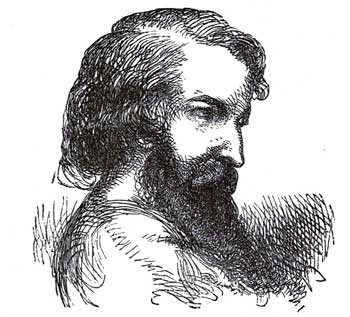
With respect to the development of the form of the human body, there are two chief conditions which influence it, namely, age and sex. With respect to age, the proportional magnitudes of the different parts, early and late in [Pg 315] life, vary very considerably. In the infant (fig. 80) the hand is by far the most completely developed (in size), next to this the abdomen, then the chest and upper extremities, and, finally, the lower extremities. In the adult (fig. 81), the largest measurement is round the chest and shoulders, but in the infant it is round the head; in the adult the lower extremities weigh one half of the whole body, but in the infant not one quarter. The infantile face has many peculiarities, so also has the face of old age (fig. 82). In the infant the lower part of the face is but little developed, the lower jaw is small, the chin scarcely at all prominent, and the distance from the nose to the chin very short, owing to the absence of the teeth, or (when formed) their smallness. The bones of the nose are scarcely formed, and this organ has therefore no bridge, properly so called; the nostrils are small, the lower part of the forehead small, smooth, and rounded, and the arches of the eyebrows but little prominent. The cheek-bones are small, and so are the bony arches which join them to the temples; the cheeks are full of fat, and the angles of the jaws rounded. In middle age the lower part of the forehead becomes more fully developed, the bony edges which support the eyebrows [Pg 316] project and overhang the eyes, the bridge of the nose and the nostrils become more fully formed, the space from the nose to the chin is greater, the teeth cause the lips to be pushed more forward, the lower jaw is larger, and the cheek-bones show more plainly. In old age the whole upper part of the face becomes more marked, the nose and eyebrows still more prominent, the cheeks hollow from absorption of the fat, the space from the nose to the chin (as in infancy) shortens from loss of teeth, but the chin, being more fully formed, projects as the jaw rises to fill the space occupied by the teeth. The angles of the jaw are also very sharp and square, the eyes sunk in the head, and the whole skin of the face loosened and wrinkled from loss of substance beneath. With respect to sex, in the Male the facial bones are more fully formed, the shoulders broader and higher, the collar-bones longer and more curved, the chest wider, the hips narrower, and the legs longer, and every bone has its processes or markings more fully developed, and is more contorted from the action of the muscles, which are larger and more powerful than in the Female. In the Female (fig. 83) there is a greater deposition of fat, [Pg 317] and, in many other respects, a tendency to a child-like conformation.
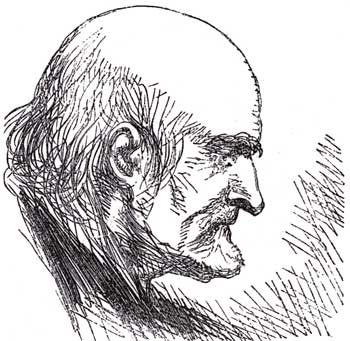
The body is everywhere covered by a common integument called the skin, beneath which is a layer of areolar and adipose tissue, which last has its cells filled with fat, which during life is in a liquid or oily state; this serves to protect the parts beneath both from cold and violence, fills up the hollows and irregularities between the muscles, and gives the body a more rounded and graceful appearance.
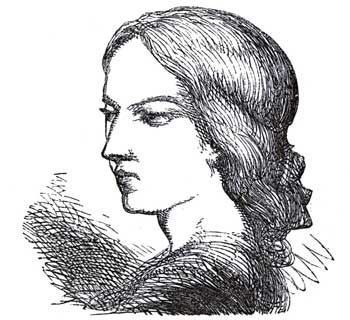
Man, in common with all the higher animals, is possessed of the five "special senses," namely, sight, smell, hearing, touch, and taste, the organs of which are the eyes, nose, ears, skin, and mouth; but these are developed in very different degrees in different animals.
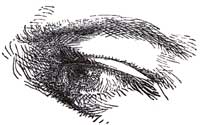
Sight is the sense by which we take cognisance of those external objects which either give out or reflect light. The eye (fig. 84) is an optical instrument of great beauty and perfection, and by its help an image of everything we look at is produced in miniature on the expanded optic nerve called the "retina," as an image is produced in the "camera," which instrument is made in imitation of the eye; this image by some unknown power is perceived by the mind, and produces [Pg 318] the sense of vision. By the sense of sight we recognise all forms, colours, and gradations of light and shade, and also (assisted by the experience gained by the sense of touch) the qualities of surface, such as roughness, smoothness, &c.; for instance, we know by touch that a piece of glass is smooth, that a piece of velvet has a different kind of smoothness, &c., and the mode in which these surfaces reflect the light, teaches us to recognise them so that we could predict from touch what appearance an object would have, or by the look how it would feel. Our knowledge of the solidity of bodies is known to the sense of sight by (unconsciously) looking at them with each eye alternately, so as to see to a certain extent round them, or somewhat on either side alternately. By this fact the principle of the stereoscope is explained, the pictures looked at through it, consist of two views of the same object, taken at points of sight a short distance apart (corresponding to the distance between the eyes) and they give us, when steadily looked at, the same result that real objects do when looked at with each eye, alternately. It is a curious fact, but one which has been clearly demonstrated by optical experiments, that the picture represented on the "retina" is inverted, but from habit we refer things to their natural position, and how naturally and easily this is done, may be ascertained by holding the head down close to the floor, and looking at objects through one's legs, in this position they are all inverted; but we naturally make ourselves satisfied that they are still as they were before, so that they really do not appear to be inverted. The impression formed by objects upon the retina is not immediately destroyed upon their removal, but remains for an instant permanent; this gives rise to a great many curious phenomena, among which the most familiar is the circle of light produced by the rapid evolution of any luminous body, as the red-hot end of [Pg 319] a stick. This is also shown by a toy, called the "Thaumatrope," which consists of a piece of card having a small wire attached to the upper part by which it may be turned rapidly round by the thumb and finger. On one side of the card is painted an object, such as a parrot, and on the other a cage; when the card is turned round, first the bird and then the cage is presented to the eye, but the image of the one has not left the eye before the other is presented to it, and the result is the uniform appearance on both sides of a parrot in a cage.
The structure of the eyes in Man and the higher animals is very nearly alike, so that the same description will serve for both, but those of insects and the lower orders of animated beings are very different.
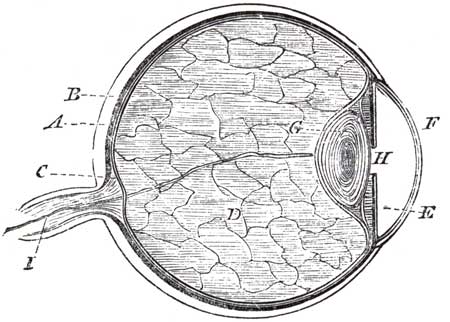
| A. Sclerotic. | D. Vitreous humour. | G. Crystalline lens. |
| B. Choroid. | E. Aqueous humour. | H. Pupil. |
| C. Retina. | F. Cornea. | I. Optic nerve. |
The eye consists of various humours of different densities enclosed in membranes (fig. 85); the human eye is spherical for the posterior four-fifths of its circumference, but the front part projects a little, being formed of part of a smaller sphere. The globe of the eye, all but this front part, is enclosed in a firm fibrous coat called the "sclerotic," within which is a [Pg 320] membrane full of blood-vessels called the "choroid," this on its inner side is covered with a black substance called the "black pigment," and within this (lining the ball) is the nervous coat or retina, it is the optic nerve so expanded as to form a lining to the membranes of the ball of the eye for the greater part of its extent. The ball of the eye is filled with a transparent fluid, somewhat glutinous, called the "vitreous humour;" stretched across the front part of the ball of the eye is a membrane having a round hole in its centre, called the "iris," coated (like the choroid) with black pigment on its back surface; this membrane (the iris) is the coloured part of the eye, and its transparency or opacity determines the colour of the eye. The pupil is the hole in its centre, it looks black because the black pigment which covers the inside of the ball of the eye (for the retina is transparent) is seen through it; behind the iris and in front of the vitreous humour, is the crystalline lens, it is just the shape of a very thick lens, but is more convex behind than in front, it is quite transparent, and of a density almost approaching to solidity. The front fifth of the ball of the eye is covered in by a dense transparent substance called the cornea, of the form of a watch-glass and quite transparent, between this and the crystalline lens there is a small space called the anterior chamber, filled with a clear watery fluid called the aqueous humour. The eye is moved by six muscles, four straight and two oblique, these turn it in every direction with the greatest accuracy; the front of the eye is defended by the eyelids, which by winking and being moistened by the tears, keep the eye always moist and free from dust.
The eyes of insects and several other classes of animals are called compound eyes, and the image they produce must resemble objects depicted in mosaic, or made up of small spots of distinct colours; they consist of hundreds of small tubes, radiating and forming part of a sphere on each side of the head, each of these tubes admits the light from objects at which they point. Some of the animals still lower in the scale have simple spots of transparent membrane with an expansion of optic nerve beneath them; in such creatures [Pg 321] the power of vision is probably limited to distinguishing light from darkness.
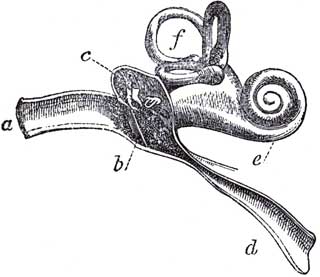
FIG. 86.—SECTION OF THE HUMAN EAR.
a, external opening; b, tympanum; c, small bones;
d, Eustachian
tube; e, cochlea; f, semicircular canals.
Hearing.—Sound is conveyed to the mind by the vibration of air, and this vibration is communicated to a membrane within the ear, called the "tympanum;" this is in connection (by means of three minute bones) with the expanded auditory nerve, which ramifies within the "vestibule," which is filled with a fluid, so that the vibrations of the air are thus communicated to the nerve of hearing (fig. 86).
Smell.—The interior of the nose is lined by a fine moist membrane, on which the olfactory nerve is distributed. The cause of odour is quite unknown; though, as most volatile substances are odorous, it is supposed to be some volatile matter which comes in contact with the olfactory nerve, or nerve of smelling. The quantity given off in some instances must be exceedingly small, for one grain of musk placed on a piece of glass will give out scent for months, and at the end of that time weigh still one grain. Some animals, as Dogs and Birds of prey, have this sense so acute that it serves them instead of almost every other; the Vulture will scent carrion miles away, and the Dog will track his master by the power of scent.
Taste.—The sense of taste resides chiefly in the tongue, [Pg 322] but to some extent in the palate or roof of the mouth; it appears to be a modified sense of smell, combined with common sensation or touch, and is much diminished by loss of smell.
Touch, next to sight, is the most important of the senses. The whole skin possesses this sense, but in some parts far more than others, the finger-ends being the most perfectly endowed with it; and in the lower animals the parts which are used as prehensile organs, are in them the most acutely sensitive to touch, as the end of the proboscis in the Elephant, and the lips of most other quadrupeds. In the Feline tribe, the smellers or hairs from the side of the face, appear to be true organs of touch, and enable them to feel their way in the dark. By the sense of touch we are informed of the amount of resistance of matter (and consequently its weight), of hardness, smoothness, roughness, and other qualities of surface, and by the amount of extension of the hand to reach them of their distance from us, and also of the form and size of things.
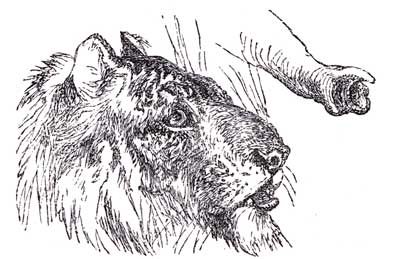
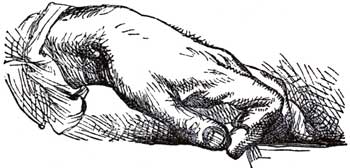
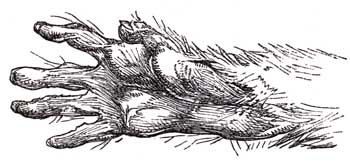
The human hand is the most perfect organ of prehension possessed by any animal, for although Monkeys have hands, yet these are so imperfect as to serve chiefly for clinging to, and climbing amongst the branches, they cannot take any small substance between the thumb and finger, while the human hand, besides enabling its possessor to grasp firmly [Pg 323] with all the fingers and thumb, each can individually be approximated to the thumb so as to hold the very smallest substance, and as Man is so constituted that he can stand firmly on his feet, his hands can be solely appropriated to the acts of prehension. It has been said that Man owes much of his superiority to the lower animals, to the possession of hands which can take, examine, and compare everything within his reach; but it seems more probable that these hands have been given him because he, only, has the faculties of examining and comparing. The Lion and Tiger would be no better off, had they Man's hands instead of their feet with claws—probably much worse.
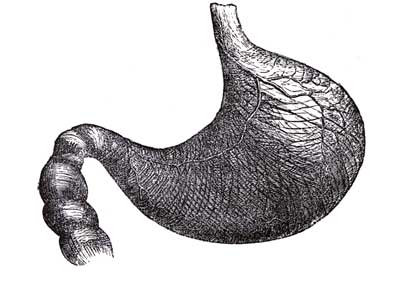
Animals do not feed upon unorganised matter, as do vegetables, but merely appropriate to their own use those organic principles which are ready formed in the vegetable or animal, such as albumen, fibrine, starch, gum, sugar, &c., and assimilate them into their substance.
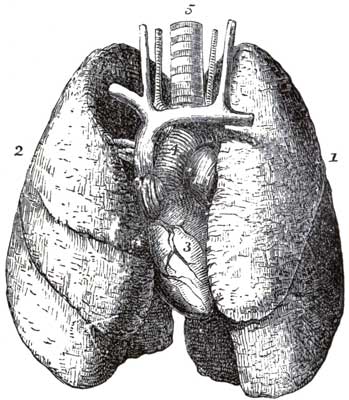
When food enters the mouth of an animal it there meets with a fluid (the saliva) which is capable of converting [Pg 324] starchy matters into sugar, thus rendering this aliment (which is presented in a state of a nature quite insoluble at the heat of the stomach) not only soluble, but nutritious. This ensalivation takes place while the food is being masticated; when in the stomach (fig. 90) it meets with the "gastric juice," a fluid capable of dissolving both fibrine and albumen (the two other chief aliments), even when coagulated; thus all kinds of food when they have been a short time in the stomach are reduced to a liquid, and so far fitted to enter the system. The stomach is a membraneous bag, communicating at the upper orifice with the mouth, and at the lower with the intestines; its internal (mucous) coat is smooth, and contains many absorbents; its outer coat is muscular, and capable of contraction, so as to roll together its contents, thus bringing every portion into contact with the gastric juice; this mass of dissolved food has received the name of "chyme." By admixture with the bile (a fluid excreted by the liver) and other juices, it separates (like curds and whey) into a liquid and partially solid matter; the liquid part is like milk, and is called "chyle," and it is taken up by absorbent vessels, by "endosmose," a peculiar power which membranes have of [Pg 325] allowing liquids to pass through them when there is a more dense liquid on the other side (as described in the experiment at page 123, "Vegetable Kingdom,"), and, passing through the vessels called "lacteals," is mixed there with the impure blood as it is about to be returned to the heart, and from thence to the lungs, where impurities are got rid of in the form of carbonic acid. The lungs (fig. 91), in performing this office, expose the blood (contained in thousands of minute blood-vessels) to the air which enters the windpipe at every inspiration or breath, the windpipe divides into two, and these each into two more (the bronchial tubes), and so on until they are no larger than a hair; at the end of each tube is a little "air-cell," on the membraneous walls of which the vessels containing the blood are distributed as a network. The blood when it enters the lungs is of a dark purple or blackish colour, and is loaded with carbonic acid; this blood is received by the heart from the great veins, which pour it into the right auricle, this contracting, sends it into the right ventricle, [Pg 326] which, in turn, sends it through the pulmonary arteries into the lungs; while there, it is exposed in the network of vessels which ramify on the walls of the air-cells; another process of endosmose takes place, and the carbonic acid passes through the walls of the vessels into the air-tubes, and escapes by the breath; at the same time that this carbonic acid is cast off, an equal bulk of oxygen is absorbed from the air, so that the air which enters the lungs, and that which passes out, are the same in bulk—plus watery vapour—although what enters is pure air, and what is expelled, is loaded with carbonic acid. The blood, having exchanged carbonic acid for oxygen, is now altered from a black to a bright scarlet colour, and is in a condition to be circulated through the system. On leaving the lungs by the "pulmonary veins," it enters the left auricle of the heart, and passes from thence to the left ventricle, which is very powerful, and forces it by compression upwards into the "aorta" (the first great artery), and thence through the other arteries, which divide, and become smaller and smaller until it arrives at every part of the body, forming a network of fine vessels which are called capillaries; so perfectly are these vessels distributed, that it is almost impossible to cut or prick any part of the body without wounding one of them, and thereby drawing blood. When these capillaries have supplied this pure blood to repair and renovate every part of the system, and received for the new material, that which is worn out or spoiled, they urge it onwards to where they unite into small veins, and, as these continue to unite, they form large trunks, and pour the blood, now black and impure, into the right auricle of the heart, together with the fresh material (chyle) derived from the food, again to be sent through the lungs and purified for fresh circulation. This description applies as well to the other Mammalia as it does to Man, for these classes do not differ from Man in their physical structure, except in form and size, and the alteration in the proportion of the various parts to adapt each to its peculiar purpose.
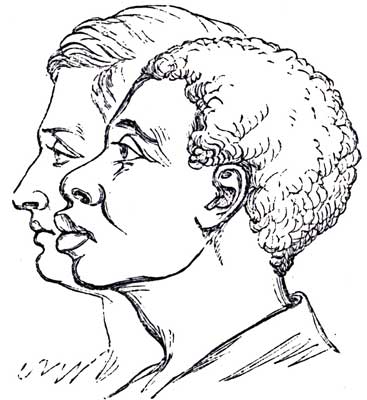
Man is, without doubt, the only animal possessed of reflective and reasoning faculties, and the possession of these has raised him immeasurably above all the rest. He has also physical capabilities suitable to a dominant being whose race is destined to people the earth in every part. Were his constitution formed like that of the Chimpanzee or the Ourang, he could only live in the very hottest of climates; but it is found that Man is healthy and happy through ranges of temperature, which would prove fatal to most other animals. In the frigid regions of the north, the Laplander enjoys many comforts which he fancies could never be obtained in any other latitude, and the Bushman of Africa, following the wild animals of that region, and needing no covering to shield him from the burning rays of the sun, deems his lot the happiest that can be. The human race are gradually increasing in number, and there is scarcely a spot capable of being inhabited at all, but they are found there; and, wherever Man comes, the wild animals of the region retire or become entirely [Pg 328] extinct, excepting those which serve him as food, such as the Ruminants.
The difference between the highest of the lower animals and Man, is so distinct, that no more need be said about it; but among men themselves, there is a great difference; between the European, and the Negro or the Hottentot, there is a vast distinction, but the most simple would at once say they are both men, and possessed of the essential qualities of men; and there can be no doubt that all men of every kind form one species. This is a point pretty well settled among all who have written on the subject; and indeed, great as the difference is among men, it is not half so great as that which exists between the Bull-dog and Italian Greyhound, and yet they are both dogs; or between the Race-horse and the Dray-horse, and yet who is there can doubt of these both being of the same species.
Blumenbach made out five varieties—namely, 1, Caucasian; 2, Mongolian; 3, American; 4, Malay; 5, Ethiopian or Negro. Pickering2 describes eleven varieties, and arranges them as follows:—
| WHITE. | BLACKISH-BROWN. | ||
| 1. | Arabian. | 6. | Papuan. |
| 2. | Abyssinian. | 7. | Negrillo. |
| 8. | Indian or Telingan. | ||
| BROWN. | 9. | Ethiopian. | |
| 3. | Mongolian. | BLACK. | |
| 4. | Hottentot. | 10. | Australian. |
| 5. | Malay. | 11. | Negro. |
2 Pickering's "Races of Man." By John Charles Hall, M.D., p. 300.
In this arrangement the "Arabian" corresponds with the "Caucasian" of Blumenbach; both names are given from the supposed country of the original members of the race; the appellation "European," used by Dr. Latham is, however, a much more appropriate one than either, both the Caucasian and Arabian being now limited to the inhabitants of the localities from which their names were derived. The Arabian, Caucasian, or European family occupy the chief part of Western Europe, the British Isles, and the United [Pg 329] States of America, and is fast spreading in other parts of the American Continent and in Australia. It is characterised by a fair complexion, arched nose, ruddy cheeks, thin lips, and the frequency of blue eyes and light hair. Its members are at this present time the highest and most civilised classes in the world, being further advanced in religion, arts, sciences, and literature; also their capacity for enterprise and speculation, and their love of novelty, is far beyond that of any other variety of the human race; anything new that offers the smallest chance of being beneficial is at once adopted by them and carried out. This is, perhaps, the great secret of their advancement, for the other most numerous variety of the human family, and which exceeds the European in numbers (the Mongolian), has but little capacity for change of any kind, in fact, appears to admire and adhere to those matters only, which have the most undoubted stamp of antiquity—such a mode of feeling especially obtains among the Chinese. Dr. Latham divides the European family into—
| 1. The Basks. | 4. The Greeks and Latins. |
| 2. The Skiptar. | 5. The Sarmatians. |
| 3. The Kelts. | 6. The Germans. |

The Basks appear to have been the original inhabitants of Spain and Portugal, which have abandoned their former habitation and now dwell in the mountains of Navarre and Gascony, just as the American Indians may be supposed to dwell at some future time in the Rocky Mountains.
The Skiptar are the inhabitants of Albania, much resembling in personal appearance the Turks and Sclavonians, but having a language derived from a different source. The following is a description of the Albanian, from the "Penny Cyclopædia:"—
"The Albanians are about five feet and a half high, muscular and straight in their persons. Their activity, and the tight girdles which they wear, render them small round the loins; they have full broad chests, long necks, long oval faces with prominent cheek bones, and flat raised foreheads, arched eyebrows, blue or hazel (rarely quite black) lively eyes, thin straight noses, thin but open nostrils, and small mouths furnished with good teeth. Their complexions are white in youth, but become tinged a dusky hue in old age."
The Kelts (or Celts) were the former inhabitants of both France and England, they are now to be found chiefly in Ireland and the Highlands of Scotland, and are called Gaelic Celts; the English are a mixture of these with Saxon and German, but still retain a good deal of the blood of the Celts; in Wales the Celts are derived from the ancient British branch. The English retain more of the Germanic language, while the Welsh retain most of the original British; the French are Celtic mixed with Roman, and have therefore a great admixture of Latin in their language. The Kelts appear to have been a race above the usual height, with red or light hair, ruddy complexion, and of a fierce and impetuous disposition.
The Greeks and Latins.—Of this stock, the inhabitants of Italy and Greece are the purest descendants, but it is extended with more or less contamination to Spain and the Danubian Principalities. Italy was probably the original seat of both races.
The Sarmatians.—This stock inhabits Russia, Poland, Bohemia, Hungary, and Servia, all speaking the Sclavonic languages.
The Germans.—This race inhabits Germany, Holland, Denmark, Sweden, and Norway, and its immediate branch the English, forming the Anglo-Saxon family, are extended [Pg 331] to America, Canada, Australia, and other parts of the world by colonisation.
Dr. Pickering calls the European race Arabian, and makes it extend through the whole of Europe, India, Arabia, and the northern parts of Africa, believing all these to have been derived from the same stock, and forming variations of the same family. The language spoken by the Europeans of all classes has been called Indo-European, hence Pickering classes with them the Hebrews, Armenians, Parsees, and many more, all derived from a stock supposed to have migrated from Asia into Europe and Africa.
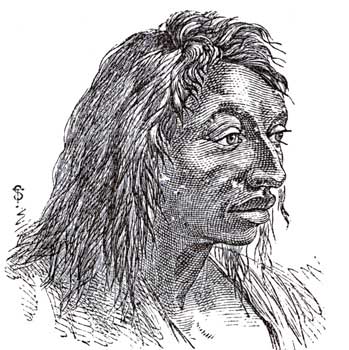
The Abyssinian.—This race inhabits the table lands of Abyssinia, and its extension into the interior. Dr. Pickering thus describes the appearance of three individuals of this race whom he met at Singapore—
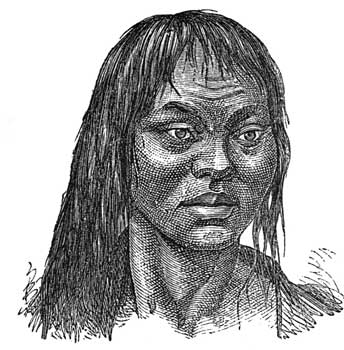
"The hair was much alike in all three, and was crisped and fine, neither coarse enough nor in sufficient quantity to form a resisting mass. The beard of one individual was in pellets absolutely like the close wool of the Negro, but the prominence of nose, greater even than usually occurs in the white race, bore sufficient testimony to his purity of descent. The second individual had the face very much elongated, but the nose was not particularly prominent. The third had a straighter beard, which was black and grey in regular stripes. The complexion was the same in all three, and though very light, was by no means of a sickly hue, and indeed these persons might readily have been passed in the streets as belonging to the white race."
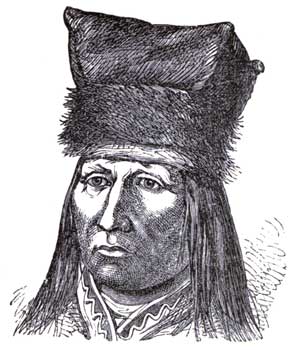
The Mongolian race, according to Pickering, includes the inhabitants of part of China and all the north-eastern parts of Asia, also the aborigines of North and South America, with the exception of a tract of land on the south-western coast, including what is now California, and part of the United States. This race is probably the most numerous in the world. The complexion of the Mongolian is decidedly yellowish brown, but rather pale withal (it is well seen in the Chinese); the head is flattened from before to behind, and expanded from side to side, so that in some well-marked cases the head is as broad as it is long, the eyes are drawn upwards at the outer angles, and appear wide apart, from the inner angle, being but little prolonged inwards, the cheek-bones are prominent; the eyes black, and the hair black and straight. The best specimens of this family are the Tartars and Chinese. The Chinese are highly skilful in most of the useful arts, especially in agriculture. Their history extends very far back, and [Pg 333] probably the longest series of recorded events in existence, being continuous for a period of about 4,000 years, during the whole of which time they have been in a state of civilisation nearly the same as they are at the present time.
The aboriginal tribes of America belong to this family. Dr. Latham derives their origin from the Esquimaux (or Eskemo), and their migration from north-eastern Asia, Kamschatka, and the Aleutian Islands, to the eastern or Pacific shores of America.
The Chinese and Tartars are of a decidedly yellow tint. The Americans are of a dark copper-coloured hue, hence their designation "Red Indians."
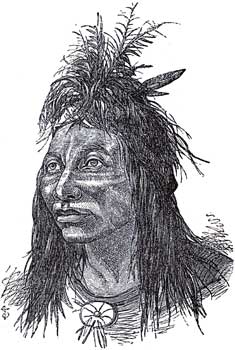
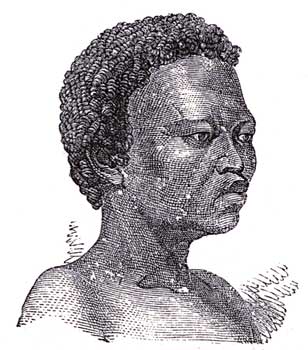
The Hottentot. This race inhabits the south of Africa, and parts extending thence into the interior; they are of a yellowish-brown complexion, small in stature, with hair consisting of small black knobs of a crisp sort of wool, separated from each other in such a way that the skin of the head may be distinctly seen between them. They are strictly nomadic, scarcely ever remaining in any fixed spot, but following the animals they hunt and kill for food, upon the flesh of which, with a few roots, they live.
Dr. Livingstone denies that they are very small in stature; speaking of the Bushmen, a tribe of the Hottentot family, he says:—"They are the only real nomads in the country, [Pg 334] they never cultivate the soil, nor rear any domestic animals, save wretched dogs; they are so intimately acquainted with the habits of the game, that they follow them in their migrations from place to place, and prey upon them, and thus prove as complete a check upon their inordinate increase as the other carnivora. The chief subsistence of the Bushmen is the flesh of game, but that is eked out by what the women collect of roots, beans, or fruits of the desert."
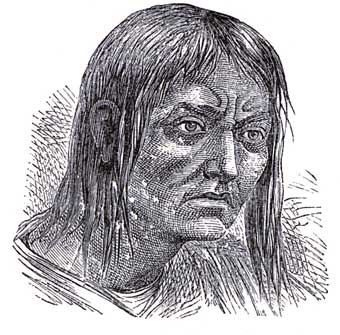
The Malay family are a coast-dwelling people, delighting in the water, and never found very far removed from it; they inhabit the southernmost coast of China, from Siam southwards, and all the adjacent islands. They are of a dark rich brown colour, with straight, coarse, black hair and scanty beard, which in some is quite wanting. Some of the members of this family are above the usual standard of height, such as the Polynesians and Tahitians. The moral character of the Malays, generally [Pg 335] speaking, is of an inferior order. They are a race differing much, in some respects, from the Negro and Red Indian, being of peculiarly active temperaments; they exhibit considerable intellectual capacity, and are an ingenious people. It is extremely probable, from the fact of their being found in islands surrounded by others in the hands of the Ethiopic race, that they have pushed out the less active variety, and, in short, annihilated them; and it is likely that they will in turn suffer extinction at the hands of a superior variety, or a variety rendered superior by civilisation.
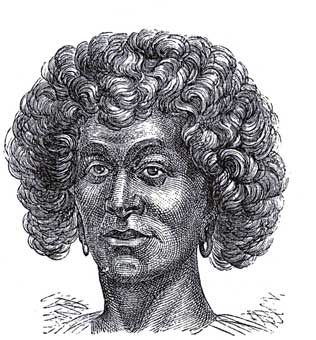
The Papuan race inhabit the Feejee Islands and the coasts of New Guinea; they are almost black, with a rough skin and thick woolly hair, which grows much longer than in the Negro, and which they wear curled up so as to form a resisting mass, and no bad protection against the blow from a club (their national weapon). Their height is above the average of Europeans. Fish and yams are their chief food.
The Negrillo are nearly black in colour, short in stature, with projecting jaws and thick woolly hair, the nose not so flat as the Negro, nor the lips so thick; they inhabit the interior of New Guinea and a few islands in its locality, of which they appear to have been the aborigines, the central parts only being occupied by them; the coasts are inhabited by the Papuan and Malay races, who have driven the Negrillo aborigines from their former abode to the central mountains.

The Indian or Telingan race inhabit the whole of Hindostan, and parts of Persia. The complexion is much the same as in the two preceding races (Negrillo and Papuan), and is so decidedly darker than in the Malayan, that by common consent it is called black, although, on comparison, the two differ widely from that of the unmixed Negro. The greater part of Hindostan is, however, inhabited by a mixed race, partly Persian, partly Arabian.
Pickering describes them as follows:—"The features approximated very closely to those of the White race, but in general the mouth appeared to be wider, the nose rather less prominent, and the lips sensibly thicker. The profile was less vertical than in the surrounding Malays, the lower part of the face projecting with a regular arch, as in the Mongolian, and there was a further correspondence with the latter race in the frequent instances of the arched nose. The beard occurred more frequently, and was more copious than in the Malay race; the hair was straight and fine, and I have never seen it any other colour than black."
The Ethiopians inhabit the central and north-east part of Africa, Nubia, and the upper districts of the Nile. They are black, but their features are not far removed from the European, except in the fulness of the lips, and they are in some cases extremely handsome. The hair is black and crisp, but not completely woolly, and grows sufficiently long to be plaited, which is the usual mode in which it is worn by the females of this race.
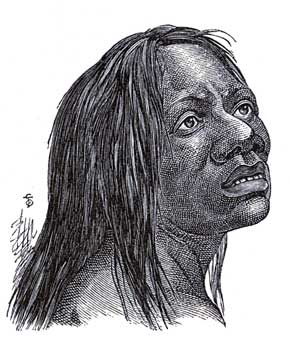
The Australians.—The natives of Australia are quite black, and have the nose and mouth very wide; the lips are thick, but not so much so as in the Negro; the hair is black and curly, but not woolly; the eyes are very small, deeply set, black, and keen; the lower part of the face does not project like that of the Negro. These make a wide distinction between the two races, although they have been confounded with each other.
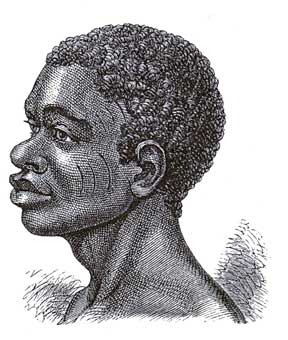
The Negro.—This race appears to differ from the European more than any other. The skin of the Negro is quite black and shining, the hair black, closely crisped into a sort of wool, and never growing to any great length; they have but little beard, the nose is flat and broad, and the lips very thick and protruding, as is also the whole lower part of the face; the front teeth also project outwards, and the whole contour of [Pg 338] the face and head is backwards, forming a gradually receding outline. They inhabit the interior and eastern parts of Africa conjointly with the Hottentot.
The preceding is a slight outline of the various races of men which inhabit the earth; their numbers are in the gross somewhere about a thousand millions, and it has been computed as follows, bearing in mind that these numbers are but a rude approximation to truth:—
| European | 350,000,000 |
| Mongolian | 400,000,000 |
| Malay | 100,000,000 |
| Telingan | 80,000,000 |
| Negro | 50,000,000 |
| Ethiopian | 10,000,000 |
| Abyssinian | 30,000,000 |
| Papuan | 3,000,000 |
| Negrillo | 3,000,000 |
| Australian | 500,000 |
| Hottentot | 500,000 |
In examining the various tribes of animated nature, there is one great fact which impresses itself irresistibly upon our minds, namely, that they all form the handiwork of one Creator, and His Autograph is stamped everywhere. His care is also shown in the way in which animals are made to feed on all kinds of organic matters, and on each other; this has been the means of economising all the nutriment which exists on the earth, for, although it may not always be apparent, yet there is not a scrap or crumb ever wasted in nature; not a decayed leaf or blade of grass, not a leg of a fly, nor the wing of a gnat, nor any part or portion of organic matter, from the smallest animalcule to the huge carcass of the dead elephant, or the trunk of the giant pine tree which the hurricane has uprooted, but forms a feast for some of the smaller tribes of animated beings there placed by Providence to eat it. Millions of these, after devouring the waste-matters of organic existence, whether embedded in the soil or elsewhere (not accessible to larger creatures), themselves form the food for creatures of larger growth, as birds, fishes, &c.; these again form the food of Man, so that
"Nothing is wasted."
THE END.
Cloth, Gilt, Price Five Shillings.
UNIFORM WITH "OUTLINES OF CREATION."
THE
BOY'S BOOK
OF
INDUSTRIAL INFORMATION.
By ELISHA NOYCE.
AUTHOR OF "OUTLINES OF CREATION."
ILLUSTRATED WITH THREE HUNDRED AND SIXTY-FIVE ENGRAVINGS, BY
THE BROTHERS DALZIEL.
OPINIONS OF THE PRESS.
Examiner, July 3. 1858.
"This book contains a brief and very clear summary of information for young readers upon the natural products used in the arts, and the arts by which they are converted to Man's use. It tells the main facts that relate to every manufacture, and describes the various kinds of apparatus and machinery—chains, cranks, valves, wheels, steam and other engines, fire-arms, stills, thermometers and barometers, ploughs, thrashing-machines, &c., as well as the more notable kinds of engineering work. To make the brief descriptions as effectual as full ones, they are very freely illustrated with good woodcuts by the Brothers Dalziel. Whatever is described is shown not only by plans and diagrams, but frequently also by little pictures that are very interesting and effective. The illustrations, we should add, are not copies of copies, but new and direct sketches from the things they represent. Among efforts to produce cheap volumes of useful information for the young, we account this one of the most successful."
Art Journal, August.
"This is just the book to place in the hands of an intelligent boy or girl—for why should the useful information it contains be limited to sex?—who desires to know something about those things from which so much of his comfort and enjoyment is derived. Every youth in Prussia, whatever be his condition—the prince and the peasant alike—is, we believe, compelled by the laws which apply in that country to education, to learn some trade or handicraft. Mr. Noyce's book will serve to initiate every boy in the United Kingdom who reads it, into the theoretical art and mystery of the material and manufacturing world. He divides his teachings into six sections, under the respective heads of Natural Products, Manufactured Products, Products of Skilled Labour, Arts and Trade Processes, Apparatus and Machinery, and Engineering Works, bringing into notice more than one hundred and fifty different subjects. The explanations and descriptions are, as they should be, simple and untechnical, as far as possible; concise, yet sufficiently demonstrative; a multum in parvo, to which Messrs. Dalziel's clear and well-executed engravings give great additional value. Such a volume is worth a hundred story-books as a present to the juveniles."
Illustrated London News, July 3.
"This work, by Elisha Noyce, with 365 illustrations by the Brothers Dalziel, is calculated to do much good. The object is not only to please, but to instruct; and, although written ostensibly for the young, it may be read with advantage by all who desire to possess a knowledge of things in everyday use. The information throughout is conveyed in a clear and understandable form; this, combined with its pictures on every page, is well calculated to make the mind familiar with many objects that as a rule have hitherto been but imperfectly realised to the young. The book is admirably adapted to assist those who are about to make choice of an occupation, and this of itself would make it a welcome addition to the numerous works written for the information and guidance of the rising generation. The book is published by Ward and Lock."
Dispatch, July 4.
There is really a great deal to recommend this book to the attention of the public as one especially adapted for the entertainment and the instruction of the young. The subjects themselves embrace the whole arcana of the material universe, the mineral and vegetable products of the earth, their properties, manufacture, and varied convertibility to the service and uses of man. Three hundred and sixty-five first-class engravings, from the pencils of the Brothers Dalziel, and most of these being illustrative of the finished machinery of Woolwich Arsenal, and drawn by permission of the authorities, add to the value of the matter incorporated in these pages, while in almost all other forms the industrial arts, with their varied apparatus and machinery, are ably and fully described. It is a true "Boy's Book," and merits the amplest circulation possible for it to attain.
Daily Telegraph, July 20.
The title of Mr. Noyce's book sufficiently explains its object, and we have only to say that it answers its purpose. It is clearly and amusingly written, and embraces a large variety of useful subjects, which it treats in a full, though, at the same time, a concise manner. The book is illustrated with three hundred and sixty-five excellent engravings by the Brothers Dalziel.
Leeds Times, July 31.
The author's object in the elegant-looking issue before us, as described by himself, is to convey to the youthful reader a knowledge of the materials, processes, and apparatus made use of in the various examples of industry and skill constantly before our eyes. No fewer than 365 wood-cuts by the Brothers Dalziel are appropriately interspersed with the letterpress, thus enabling the reader to clearly understand what otherwise would of necessity, in some cases, be almost incomprehensible. The work is clearly and ably written, and even the intelligent adult must possess a large fund of general knowledge who can truthfully affirm that he has derived no information from its pages.
Norfolk News, Aug. 7.
The title of "The Boy's Book" has been applied to more than one, two, or three subjects; but to none more appropriately than to this, which is really and truly "The Boy's Book of Useful Knowledge." The author has observed the happy medium of saying neither too little nor too much—of neither wearying the patience of his young readers by long and needless details, nor of disappointing their curiosity by unnecessarily brief and insufficient descriptions. If we are not greatly mistaken, the book will soon become a general favorite with the young, and we should strongly recommend it as a text-book of general information to Educational establishments. It is beautifully got up, and its value is considerably enhanced by the superior wood engravings of the Brothers Dalziel, which speak the language of explanation as plainly to the eye as does the letterpress to the understanding.
LONDON: WARD & LOCK, 158, FLEET STREET.
Transcriber's Notes
Variations in spelling, punctuation and hyphenation have been retained except in obvious cases of typographical errors which have been silently corrected.